Palm 710000 1900MHz GSM/GPRS PDA Communicator User Manual 1 of 2
Palm Inc 1900MHz GSM/GPRS PDA Communicator 1 of 2
Palm >
Contents
- 1. User Manual 1 of 2
- 2. User Manual 2 of 2
- 3. CRN 5889 question 1
User Manual 1 of 2

Handbook for
Palm™ Tungsten™ W
i710
Handhelds
Palm, Inc. Confidential

Copyright
© 2002 Palm, Inc. All rights reserved. HotSync, MultiMail, PalmModem, and Palm OS are registered
trademarks, and the HotSync logo, Palm, the Palm logo, Palm Powered, and VersaMail are trademarks of
Palm, Inc. Palm, Inc. uses the Bluetooth trademark under express license from Bluetooth SIG, Inc., U.S.A.
All other brand names are trademarks or registered trademarks of their respective owners.
Disclaimer and Limitation of Liability
Palm, Inc. assumes no responsibility for any damage or loss resulting from the use of this handbook.
Palm assumes no responsibility for any loss or claims by third parties which may arise through the use of
this software. Palm, Inc. assumes no responsibility for any damage or loss caused by deletion of data as a
result of malfunction, dead battery, or repairs. Be sure to make backup copies of all important data on other
media to protect against data loss.
IMPORTANT Please read the End User Software License Agreement with this product before using the
accompanying software program(s). Using any part of the software indicates that you accept the terms of the
End User Software License Agreement.
Software Download Available
Palm™ Desktop software is supplied on a CD-ROM disc. If you do not have access to a CD-ROM drive for
your computer, you can download the Palm Desktop software from www.palm.com/support/intl.
PN: 406-4534A-IE
Palm, Inc. Confidential

iii
About This Book . . . . . . . . . . . . . . . . . . . . . . . . . . . . . . . . . . . . . . . . . . . . . . . . 1
Chapter 1: Welcome . . . . . . . . . . . . . . . . . . . . . . . . . . . . . . . . . . . . . . . . . . . . . 3
System requirements . . . . . . . . . . . . . . . . . . . . . . . . . . . . . . . . . . . . . . . . . . . . . . . . 4
Minimum requirements: Windows computers . . . . . . . . . . . . . . . . . . . . . . . . 4
Minimum requirements: Mac computers . . . . . . . . . . . . . . . . . . . . . . . . . . . . . 4
Wireless service . . . . . . . . . . . . . . . . . . . . . . . . . . . . . . . . . . . . . . . . . . . . . . . . . . . . . 5
Making a call in a medical or safety emergency . . . . . . . . . . . . . . . . . . . . . . . . . . 6
Software Download Available . . . . . . . . . . . . . . . . . . . . . . . . . . . . . . . . . . . . . . . . 6
Compatibility of third-party applications . . . . . . . . . . . . . . . . . . . . . . . . . . . . . . . 6
Finding information . . . . . . . . . . . . . . . . . . . . . . . . . . . . . . . . . . . . . . . . . . . . . . . . . 7
Chapter 2: Exploring Your Handheld . . . . . . . . . . . . . . . . . . . . . . . . . . . . . . . 9
Locating handheld components . . . . . . . . . . . . . . . . . . . . . . . . . . . . . . . . . . . . . . 10
Locating front panel controls . . . . . . . . . . . . . . . . . . . . . . . . . . . . . . . . . . . . . . 10
Using the indicator light . . . . . . . . . . . . . . . . . . . . . . . . . . . . . . . . . . . . . . . . . . 12
Locating back panel components . . . . . . . . . . . . . . . . . . . . . . . . . . . . . . . . . . 13
Adding an expansion card . . . . . . . . . . . . . . . . . . . . . . . . . . . . . . . . . . . . . . . . . . . 14
Using the backlight . . . . . . . . . . . . . . . . . . . . . . . . . . . . . . . . . . . . . . . . . . . . . . . . . 15
Chapter 3: Navigating and Entering Data . . . . . . . . . . . . . . . . . . . . . . . . . . 17
Tapping . . . . . . . . . . . . . . . . . . . . . . . . . . . . . . . . . . . . . . . . . . . . . . . . . . . . . . . . . . . 17
Using the navigator . . . . . . . . . . . . . . . . . . . . . . . . . . . . . . . . . . . . . . . . . . . . . . . . . 18
Using the keyboard . . . . . . . . . . . . . . . . . . . . . . . . . . . . . . . . . . . . . . . . . . . . . . . . . 19
Typing capital letters . . . . . . . . . . . . . . . . . . . . . . . . . . . . . . . . . . . . . . . . . . . . . 20
Accessing international and special characters . . . . . . . . . . . . . . . . . . . . . . . 20
Using the Function key . . . . . . . . . . . . . . . . . . . . . . . . . . . . . . . . . . . . . . . . . . . 22
Using menu commands . . . . . . . . . . . . . . . . . . . . . . . . . . . . . . . . . . . . . . . . . . 23
Using ShortCuts . . . . . . . . . . . . . . . . . . . . . . . . . . . . . . . . . . . . . . . . . . . . . . . . . 24
Using elements of the handheld interface . . . . . . . . . . . . . . . . . . . . . . . . . . . . . . 24
Beaming data . . . . . . . . . . . . . . . . . . . . . . . . . . . . . . . . . . . . . . . . . . . . . . . . . . . . . . 26
Using your computer keyboard . . . . . . . . . . . . . . . . . . . . . . . . . . . . . . . . . . . . . . 29
Contents
Palm, Inc. Confidential

Contents
iv
Importing data . . . . . . . . . . . . . . . . . . . . . . . . . . . . . . . . . . . . . . . . . . . . . . . . . . . . . 29
Importing data from a Windows computer . . . . . . . . . . . . . . . . . . . . . . . . . . 29
Importing data from a Mac computer . . . . . . . . . . . . . . . . . . . . . . . . . . . . . . 31
Chapter 4: Working with Applications . . . . . . . . . . . . . . . . . . . . . . . . . . . . . 33
Opening applications . . . . . . . . . . . . . . . . . . . . . . . . . . . . . . . . . . . . . . . . . . . . . . . 33
Other ways to open applications . . . . . . . . . . . . . . . . . . . . . . . . . . . . . . . . . . . 34
Opening expansion card applications . . . . . . . . . . . . . . . . . . . . . . . . . . . . . . . 34
Switching between applications . . . . . . . . . . . . . . . . . . . . . . . . . . . . . . . . . . . . . . 34
Categorizing applications . . . . . . . . . . . . . . . . . . . . . . . . . . . . . . . . . . . . . . . . . . . 35
Changing the Applications Launcher display . . . . . . . . . . . . . . . . . . . . . . . . . . 36
Copying applications to or from an expansion card . . . . . . . . . . . . . . . . . . . . . 37
Selecting copy settings . . . . . . . . . . . . . . . . . . . . . . . . . . . . . . . . . . . . . . . . . . . . . . 39
Using menus . . . . . . . . . . . . . . . . . . . . . . . . . . . . . . . . . . . . . . . . . . . . . . . . . . . . . . 39
Choosing application preferences . . . . . . . . . . . . . . . . . . . . . . . . . . . . . . . . . . . . . 41
Performing common tasks . . . . . . . . . . . . . . . . . . . . . . . . . . . . . . . . . . . . . . . . . . . 41
Creating records . . . . . . . . . . . . . . . . . . . . . . . . . . . . . . . . . . . . . . . . . . . . . . . . . 41
Editing records . . . . . . . . . . . . . . . . . . . . . . . . . . . . . . . . . . . . . . . . . . . . . . . . . . 42
Deleting records . . . . . . . . . . . . . . . . . . . . . . . . . . . . . . . . . . . . . . . . . . . . . . . . . 43
Purging records . . . . . . . . . . . . . . . . . . . . . . . . . . . . . . . . . . . . . . . . . . . . . . . . . 44
Categorizing records . . . . . . . . . . . . . . . . . . . . . . . . . . . . . . . . . . . . . . . . . . . . . 45
Finding information . . . . . . . . . . . . . . . . . . . . . . . . . . . . . . . . . . . . . . . . . . . . . . 48
Sorting lists of records . . . . . . . . . . . . . . . . . . . . . . . . . . . . . . . . . . . . . . . . . . . . 53
Attaching notes . . . . . . . . . . . . . . . . . . . . . . . . . . . . . . . . . . . . . . . . . . . . . . . . . . 54
Choosing fonts . . . . . . . . . . . . . . . . . . . . . . . . . . . . . . . . . . . . . . . . . . . . . . . . . . 55
Receiving alerts . . . . . . . . . . . . . . . . . . . . . . . . . . . . . . . . . . . . . . . . . . . . . . . . . . 56
Hiding or masking private records . . . . . . . . . . . . . . . . . . . . . . . . . . . . . . . . . 57
Installing and removing applications . . . . . . . . . . . . . . . . . . . . . . . . . . . . . . . . . . 57
Installing add-on applications . . . . . . . . . . . . . . . . . . . . . . . . . . . . . . . . . . . . . 57
Removing applications . . . . . . . . . . . . . . . . . . . . . . . . . . . . . . . . . . . . . . . . . . . 61
Removing Palm Desktop software . . . . . . . . . . . . . . . . . . . . . . . . . . . . . . . . . 61
Chapter 5: Using Address Book . . . . . . . . . . . . . . . . . . . . . . . . . . . . . . . . . . 63
Creating an Address Book entry . . . . . . . . . . . . . . . . . . . . . . . . . . . . . . . . . . . . . . 64
Selecting types of phone numbers . . . . . . . . . . . . . . . . . . . . . . . . . . . . . . . . . . . . 65
Changing Address Entry details . . . . . . . . . . . . . . . . . . . . . . . . . . . . . . . . . . . . . . 66
Making connections from Address Book . . . . . . . . . . . . . . . . . . . . . . . . . . . . . . . 66
Quick Connect . . . . . . . . . . . . . . . . . . . . . . . . . . . . . . . . . . . . . . . . . . . . . . . . . . 66
Tap-to-Connect . . . . . . . . . . . . . . . . . . . . . . . . . . . . . . . . . . . . . . . . . . . . . . . . . . 68
Palm, Inc. Confidential

Contents
v
Address Book menus . . . . . . . . . . . . . . . . . . . . . . . . . . . . . . . . . . . . . . . . . . . . . . . 69
Record menus . . . . . . . . . . . . . . . . . . . . . . . . . . . . . . . . . . . . . . . . . . . . . . . . . . . 69
Options menus . . . . . . . . . . . . . . . . . . . . . . . . . . . . . . . . . . . . . . . . . . . . . . . . . . 69
Chapter 6: Using Calculator . . . . . . . . . . . . . . . . . . . . . . . . . . . . . . . . . . . . . . 71
Performing calculations . . . . . . . . . . . . . . . . . . . . . . . . . . . . . . . . . . . . . . . . . . . . . 71
Viewing recent calculations . . . . . . . . . . . . . . . . . . . . . . . . . . . . . . . . . . . . . . . . . . 72
Using Calculator menus . . . . . . . . . . . . . . . . . . . . . . . . . . . . . . . . . . . . . . . . . . . . . 73
Chapter 7: Using Card Info . . . . . . . . . . . . . . . . . . . . . . . . . . . . . . . . . . . . . . 75
Reviewing Card Information . . . . . . . . . . . . . . . . . . . . . . . . . . . . . . . . . . . . . . . . . 75
Renaming a card . . . . . . . . . . . . . . . . . . . . . . . . . . . . . . . . . . . . . . . . . . . . . . . . . . . 76
Formatting a card . . . . . . . . . . . . . . . . . . . . . . . . . . . . . . . . . . . . . . . . . . . . . . . . . . 76
Managing an expansion card . . . . . . . . . . . . . . . . . . . . . . . . . . . . . . . . . . . . . . . . . 77
Using the Card Info menu . . . . . . . . . . . . . . . . . . . . . . . . . . . . . . . . . . . . . . . . . . . 77
Chapter 8: Using Date Book . . . . . . . . . . . . . . . . . . . . . . . . . . . . . . . . . . . . . 79
Scheduling an event . . . . . . . . . . . . . . . . . . . . . . . . . . . . . . . . . . . . . . . . . . . . . . . . 80
Selecting an event . . . . . . . . . . . . . . . . . . . . . . . . . . . . . . . . . . . . . . . . . . . . . . . . . . 83
Rescheduling an event . . . . . . . . . . . . . . . . . . . . . . . . . . . . . . . . . . . . . . . . . . . . . . 83
Setting an alarm for an event . . . . . . . . . . . . . . . . . . . . . . . . . . . . . . . . . . . . . . . . . 83
Scheduling repeating or continuous events . . . . . . . . . . . . . . . . . . . . . . . . . . . . 85
Changing repeating or continuous events . . . . . . . . . . . . . . . . . . . . . . . . . . . 85
Considerations for repeating or continuous events . . . . . . . . . . . . . . . . . . . 86
Changing the Date Book view . . . . . . . . . . . . . . . . . . . . . . . . . . . . . . . . . . . . . . . . 87
Working in Week view . . . . . . . . . . . . . . . . . . . . . . . . . . . . . . . . . . . . . . . . . . . 87
Working in Month view . . . . . . . . . . . . . . . . . . . . . . . . . . . . . . . . . . . . . . . . . . 88
Working in Agenda view . . . . . . . . . . . . . . . . . . . . . . . . . . . . . . . . . . . . . . . . . 89
Spotting event conflicts . . . . . . . . . . . . . . . . . . . . . . . . . . . . . . . . . . . . . . . . . . . . . 90
Date Book menus, preferences, and display options . . . . . . . . . . . . . . . . . . . . . 90
Record menu . . . . . . . . . . . . . . . . . . . . . . . . . . . . . . . . . . . . . . . . . . . . . . . . . . . . 90
Options menu . . . . . . . . . . . . . . . . . . . . . . . . . . . . . . . . . . . . . . . . . . . . . . . . . . . 91
Chapter 9: Using Expense . . . . . . . . . . . . . . . . . . . . . . . . . . . . . . . . . . . . . . . 93
Adding expense items . . . . . . . . . . . . . . . . . . . . . . . . . . . . . . . . . . . . . . . . . . . . . . 94
Changing the date of an Expense item . . . . . . . . . . . . . . . . . . . . . . . . . . . . . . 95
Entering receipt details . . . . . . . . . . . . . . . . . . . . . . . . . . . . . . . . . . . . . . . . . . . 95
Customizing the Currency pick list . . . . . . . . . . . . . . . . . . . . . . . . . . . . . . . . . . . 96
Changing the default currency . . . . . . . . . . . . . . . . . . . . . . . . . . . . . . . . . . . . 97
Defining a custom currency symbol . . . . . . . . . . . . . . . . . . . . . . . . . . . . . . . . 97
Palm, Inc. Confidential

Contents
vi
Setting Show Options . . . . . . . . . . . . . . . . . . . . . . . . . . . . . . . . . . . . . . . . . . . . . . . 98
Working with Expense data on your computer . . . . . . . . . . . . . . . . . . . . . . . . . 99
Displaying the euro on your computer . . . . . . . . . . . . . . . . . . . . . . . . . . . . . 99
Printing the euro . . . . . . . . . . . . . . . . . . . . . . . . . . . . . . . . . . . . . . . . . . . . . . . . 99
Using Expense menus . . . . . . . . . . . . . . . . . . . . . . . . . . . . . . . . . . . . . . . . . . . . . . 100
Record menu . . . . . . . . . . . . . . . . . . . . . . . . . . . . . . . . . . . . . . . . . . . . . . . . . . . 100
Options menu . . . . . . . . . . . . . . . . . . . . . . . . . . . . . . . . . . . . . . . . . . . . . . . . . . 100
Chapter 10: Using Memo Pad . . . . . . . . . . . . . . . . . . . . . . . . . . . . . . . . . . . 101
Creating memos . . . . . . . . . . . . . . . . . . . . . . . . . . . . . . . . . . . . . . . . . . . . . . . . . . . 101
Reviewing memos . . . . . . . . . . . . . . . . . . . . . . . . . . . . . . . . . . . . . . . . . . . . . . . . . 102
Using Memo Pad menus . . . . . . . . . . . . . . . . . . . . . . . . . . . . . . . . . . . . . . . . . . . 102
Record menus . . . . . . . . . . . . . . . . . . . . . . . . . . . . . . . . . . . . . . . . . . . . . . . . . . 103
Options menus . . . . . . . . . . . . . . . . . . . . . . . . . . . . . . . . . . . . . . . . . . . . . . . . . 103
Chapter 11: Using Palm™ Mobile . . . . . . . . . . . . . . . . . . . . . . . . . . . . . . . . 105
Using your hands-free headset . . . . . . . . . . . . . . . . . . . . . . . . . . . . . . . . . . . . . . 106
Opening Palm Mobile . . . . . . . . . . . . . . . . . . . . . . . . . . . . . . . . . . . . . . . . . . . . . . 108
Answering a phone call . . . . . . . . . . . . . . . . . . . . . . . . . . . . . . . . . . . . . . . . . . . . 109
Dialing a number from the keypad . . . . . . . . . . . . . . . . . . . . . . . . . . . . . . . . . . 110
Redialing the most recently dialed number . . . . . . . . . . . . . . . . . . . . . . . . . 110
Managing a phone call . . . . . . . . . . . . . . . . . . . . . . . . . . . . . . . . . . . . . . . . . . . . . 111
Answering call waiting . . . . . . . . . . . . . . . . . . . . . . . . . . . . . . . . . . . . . . . . . . 112
Using conference calling . . . . . . . . . . . . . . . . . . . . . . . . . . . . . . . . . . . . . . . . . . . 113
Creating a conference call . . . . . . . . . . . . . . . . . . . . . . . . . . . . . . . . . . . . . . . . 113
Managing a conference call . . . . . . . . . . . . . . . . . . . . . . . . . . . . . . . . . . . . . . 114
Retrieving voicemail . . . . . . . . . . . . . . . . . . . . . . . . . . . . . . . . . . . . . . . . . . . . . . . 117
Using speed dial . . . . . . . . . . . . . . . . . . . . . . . . . . . . . . . . . . . . . . . . . . . . . . . . . . 118
Creating a speed-dial entry . . . . . . . . . . . . . . . . . . . . . . . . . . . . . . . . . . . . . . 118
Dialing a speed-dial entry . . . . . . . . . . . . . . . . . . . . . . . . . . . . . . . . . . . . . . . . 119
Editing a speed-dial entry . . . . . . . . . . . . . . . . . . . . . . . . . . . . . . . . . . . . . . . . 120
Using the Call History list . . . . . . . . . . . . . . . . . . . . . . . . . . . . . . . . . . . . . . . . . . 122
Dialing a number from the Call History list . . . . . . . . . . . . . . . . . . . . . . . . 122
Using redial reminders . . . . . . . . . . . . . . . . . . . . . . . . . . . . . . . . . . . . . . . . . . . . . 123
Creating a redial reminder . . . . . . . . . . . . . . . . . . . . . . . . . . . . . . . . . . . . . . . 123
Managing redial reminders . . . . . . . . . . . . . . . . . . . . . . . . . . . . . . . . . . . . . . 124
Managing profiles . . . . . . . . . . . . . . . . . . . . . . . . . . . . . . . . . . . . . . . . . . . . . . . . . 124
Managing ring tunes . . . . . . . . . . . . . . . . . . . . . . . . . . . . . . . . . . . . . . . . . . . . . . . 126
Using Palm Mobile menus . . . . . . . . . . . . . . . . . . . . . . . . . . . . . . . . . . . . . . . . . . 128
Palm, Inc. Confidential

Contents
vii
Mobile menu . . . . . . . . . . . . . . . . . . . . . . . . . . . . . . . . . . . . . . . . . . . . . . . . . . . 128
Options menu . . . . . . . . . . . . . . . . . . . . . . . . . . . . . . . . . . . . . . . . . . . . . . . . . . 128
Chapter 12: Using Note Pad . . . . . . . . . . . . . . . . . . . . . . . . . . . . . . . . . . . . 131
Creating a note . . . . . . . . . . . . . . . . . . . . . . . . . . . . . . . . . . . . . . . . . . . . . . . . . . . . 132
Reviewing notes . . . . . . . . . . . . . . . . . . . . . . . . . . . . . . . . . . . . . . . . . . . . . . . . . . 132
Changing Note Pad color settings . . . . . . . . . . . . . . . . . . . . . . . . . . . . . . . . . . . 133
Setting an alarm for a note . . . . . . . . . . . . . . . . . . . . . . . . . . . . . . . . . . . . . . . . . . 134
Using Note Pad menus . . . . . . . . . . . . . . . . . . . . . . . . . . . . . . . . . . . . . . . . . . . . . 135
Record menu . . . . . . . . . . . . . . . . . . . . . . . . . . . . . . . . . . . . . . . . . . . . . . . . . . . 135
Options menus . . . . . . . . . . . . . . . . . . . . . . . . . . . . . . . . . . . . . . . . . . . . . . . . . 136
Chapter 13: Using SIM Manager . . . . . . . . . . . . . . . . . . . . . . . . . . . . . . . . . 137
Adding SIM Manager items . . . . . . . . . . . . . . . . . . . . . . . . . . . . . . . . . . . . . . . . 138
Managing SIM Manager items . . . . . . . . . . . . . . . . . . . . . . . . . . . . . . . . . . . . . . 138
Using SIM Manager menus . . . . . . . . . . . . . . . . . . . . . . . . . . . . . . . . . . . . . . . . . 139
Record menu . . . . . . . . . . . . . . . . . . . . . . . . . . . . . . . . . . . . . . . . . . . . . . . . . . . 139
Options menu . . . . . . . . . . . . . . . . . . . . . . . . . . . . . . . . . . . . . . . . . . . . . . . . . . 139
Chapter 14: Using SIM Services . . . . . . . . . . . . . . . . . . . . . . . . . . . . . . . . . 141
Accessing a service . . . . . . . . . . . . . . . . . . . . . . . . . . . . . . . . . . . . . . . . . . . . . . . . 142
Using the SIM Services menu . . . . . . . . . . . . . . . . . . . . . . . . . . . . . . . . . . . . . . . 142
Options menu . . . . . . . . . . . . . . . . . . . . . . . . . . . . . . . . . . . . . . . . . . . . . . . . . . 142
Chapter 15: Using SMS . . . . . . . . . . . . . . . . . . . . . . . . . . . . . . . . . . . . . . . . 143
Creating messages . . . . . . . . . . . . . . . . . . . . . . . . . . . . . . . . . . . . . . . . . . . . . . . . . 144
Sending and receiving messages . . . . . . . . . . . . . . . . . . . . . . . . . . . . . . . . . . . . . 146
Viewing messages . . . . . . . . . . . . . . . . . . . . . . . . . . . . . . . . . . . . . . . . . . . . . . . . . 147
Working with draft messages . . . . . . . . . . . . . . . . . . . . . . . . . . . . . . . . . . . . . . . 149
Adding a signature to a message . . . . . . . . . . . . . . . . . . . . . . . . . . . . . . . . . . . . 150
Sending data from another application . . . . . . . . . . . . . . . . . . . . . . . . . . . . . . . 151
Setting preferences . . . . . . . . . . . . . . . . . . . . . . . . . . . . . . . . . . . . . . . . . . . . . . . . 152
Using SMS menus . . . . . . . . . . . . . . . . . . . . . . . . . . . . . . . . . . . . . . . . . . . . . . . . . 154
Message menu . . . . . . . . . . . . . . . . . . . . . . . . . . . . . . . . . . . . . . . . . . . . . . . . . 154
Options menu . . . . . . . . . . . . . . . . . . . . . . . . . . . . . . . . . . . . . . . . . . . . . . . . . . 154
Chapter 16: Using To Do List . . . . . . . . . . . . . . . . . . . . . . . . . . . . . . . . . . . . 155
Creating list items . . . . . . . . . . . . . . . . . . . . . . . . . . . . . . . . . . . . . . . . . . . . . . . . . 156
Setting priority . . . . . . . . . . . . . . . . . . . . . . . . . . . . . . . . . . . . . . . . . . . . . . . . . . . . 156
Checking off a To Do List item . . . . . . . . . . . . . . . . . . . . . . . . . . . . . . . . . . . . . . 157
Changing To Do List item details . . . . . . . . . . . . . . . . . . . . . . . . . . . . . . . . . . . . 158
Palm, Inc. Confidential

Contents
viii
Setting a due date . . . . . . . . . . . . . . . . . . . . . . . . . . . . . . . . . . . . . . . . . . . . . . . . . 158
Setting To Do Preferences . . . . . . . . . . . . . . . . . . . . . . . . . . . . . . . . . . . . . . . . . . 159
Using To Do List menus . . . . . . . . . . . . . . . . . . . . . . . . . . . . . . . . . . . . . . . . . . . . 160
Record menu . . . . . . . . . . . . . . . . . . . . . . . . . . . . . . . . . . . . . . . . . . . . . . . . . . . 160
Options menu . . . . . . . . . . . . . . . . . . . . . . . . . . . . . . . . . . . . . . . . . . . . . . . . . . 160
Chapter 17: Using Palm™ VersaMail™ Personal E-mail Software . . . . . 161
Getting started with the VersaMail application . . . . . . . . . . . . . . . . . . . . . . . . 162
Synchronizing an existing username . . . . . . . . . . . . . . . . . . . . . . . . . . . . . . 162
Upgrading a MultiMail database . . . . . . . . . . . . . . . . . . . . . . . . . . . . . . . . . . 162
Installing Documents To Go . . . . . . . . . . . . . . . . . . . . . . . . . . . . . . . . . . . . . 162
Setting up and managing e-mail accounts . . . . . . . . . . . . . . . . . . . . . . . . . . . . . 163
Account and connection types . . . . . . . . . . . . . . . . . . . . . . . . . . . . . . . . . . . . 163
Setting up the default account that came with your handheld . . . . . . . . . 163
Setting up a new e-mail account . . . . . . . . . . . . . . . . . . . . . . . . . . . . . . . . . . 164
Setting up a network e-mail account . . . . . . . . . . . . . . . . . . . . . . . . . . . . . . . 165
Creating a network e-mail account . . . . . . . . . . . . . . . . . . . . . . . . . . . . . . . . 166
Creating a synchronize-only account . . . . . . . . . . . . . . . . . . . . . . . . . . . . . . 171
Setting VersaMail connection preferences . . . . . . . . . . . . . . . . . . . . . . . . . . 177
Editing e-mail accounts . . . . . . . . . . . . . . . . . . . . . . . . . . . . . . . . . . . . . . . . . . 178
Deleting an e-mail account . . . . . . . . . . . . . . . . . . . . . . . . . . . . . . . . . . . . . . . 183
Selecting a different service for a given e-mail account . . . . . . . . . . . . . . . 184
Getting, sending, and managing e-mail . . . . . . . . . . . . . . . . . . . . . . . . . . . . . . . 186
Getting and reading e-mail . . . . . . . . . . . . . . . . . . . . . . . . . . . . . . . . . . . . . . . 186
Creating and sending new e-mail . . . . . . . . . . . . . . . . . . . . . . . . . . . . . . . . . 195
Working with attachments . . . . . . . . . . . . . . . . . . . . . . . . . . . . . . . . . . . . . . . 204
Deleting messages . . . . . . . . . . . . . . . . . . . . . . . . . . . . . . . . . . . . . . . . . . . . . . 211
Emptying the trash . . . . . . . . . . . . . . . . . . . . . . . . . . . . . . . . . . . . . . . . . . . . . . 214
Marking messages as read or unread . . . . . . . . . . . . . . . . . . . . . . . . . . . . . . 215
Setting preferences for getting and deleting e-mail . . . . . . . . . . . . . . . . . . 217
Adding or updating an Address Book entry directly from a message . . 218
Synchronizing e-mail between the handheld and the desktop . . . . . . . . . . . 219
Configuring an account in HotSync Manager . . . . . . . . . . . . . . . . . . . . . . . 219
Setting synchronization options and account settings . . . . . . . . . . . . . . . . 220
Converting attached files . . . . . . . . . . . . . . . . . . . . . . . . . . . . . . . . . . . . . . . . 226
Synchronizing an account . . . . . . . . . . . . . . . . . . . . . . . . . . . . . . . . . . . . . . . . 228
Going beyond the basics . . . . . . . . . . . . . . . . . . . . . . . . . . . . . . . . . . . . . . . . . . . 229
Setting server options for an IMAP account . . . . . . . . . . . . . . . . . . . . . . . . 229
Managing mail filters . . . . . . . . . . . . . . . . . . . . . . . . . . . . . . . . . . . . . . . . . . . . 230
Palm, Inc. Confidential

Contents
ix
Managing mail settings . . . . . . . . . . . . . . . . . . . . . . . . . . . . . . . . . . . . . . . . . . 234
Adding APOP to an account . . . . . . . . . . . . . . . . . . . . . . . . . . . . . . . . . . . . . 241
Adding ESMTP to an account . . . . . . . . . . . . . . . . . . . . . . . . . . . . . . . . . . . . 242
Copying text from an e-mail message for use in other applications . . . . 244
Using the command bar . . . . . . . . . . . . . . . . . . . . . . . . . . . . . . . . . . . . . . . . . 244
E-mail header details . . . . . . . . . . . . . . . . . . . . . . . . . . . . . . . . . . . . . . . . . . . . 245
Backing up mail databases . . . . . . . . . . . . . . . . . . . . . . . . . . . . . . . . . . . . . . . 246
Wireless IMAP folder synchronization . . . . . . . . . . . . . . . . . . . . . . . . . . . . . 247
Accessing corporate e-mail . . . . . . . . . . . . . . . . . . . . . . . . . . . . . . . . . . . . . . . 248
Five-way navigation in the VersaMail application . . . . . . . . . . . . . . . . . . . 248
Keyboard shortcuts in the VersaMail application . . . . . . . . . . . . . . . . . . . . 250
Chapter 18: Using Palm™ WAP Browser . . . . . . . . . . . . . . . . . . . . . . . . . . 253
Opening Palm WAP Browser . . . . . . . . . . . . . . . . . . . . . . . . . . . . . . . . . . . . . . . 253
Opening a WAP site . . . . . . . . . . . . . . . . . . . . . . . . . . . . . . . . . . . . . . . . . . . . . . . 254
Browsing a WAP site . . . . . . . . . . . . . . . . . . . . . . . . . . . . . . . . . . . . . . . . . . . . . . 255
Browsing secure WAP sites . . . . . . . . . . . . . . . . . . . . . . . . . . . . . . . . . . . . . . 256
Using bookmarks . . . . . . . . . . . . . . . . . . . . . . . . . . . . . . . . . . . . . . . . . . . . . . . . . 257
Adding a bookmark . . . . . . . . . . . . . . . . . . . . . . . . . . . . . . . . . . . . . . . . . . . . . 258
Visiting a bookmarked WAP site . . . . . . . . . . . . . . . . . . . . . . . . . . . . . . . . . . 259
Editing a bookmark . . . . . . . . . . . . . . . . . . . . . . . . . . . . . . . . . . . . . . . . . . . . . 259
Deleting a bookmark . . . . . . . . . . . . . . . . . . . . . . . . . . . . . . . . . . . . . . . . . . . . 260
Using your Push Inbox . . . . . . . . . . . . . . . . . . . . . . . . . . . . . . . . . . . . . . . . . . . . . 261
Using advanced features . . . . . . . . . . . . . . . . . . . . . . . . . . . . . . . . . . . . . . . . . . . 262
Changing gateways . . . . . . . . . . . . . . . . . . . . . . . . . . . . . . . . . . . . . . . . . . . . . . . . 262
Setting advanced options . . . . . . . . . . . . . . . . . . . . . . . . . . . . . . . . . . . . . . . . . . . 263
Using cache memory . . . . . . . . . . . . . . . . . . . . . . . . . . . . . . . . . . . . . . . . . . . . 263
Selecting an Access Point Name . . . . . . . . . . . . . . . . . . . . . . . . . . . . . . . . . . 264
Selecting Mode . . . . . . . . . . . . . . . . . . . . . . . . . . . . . . . . . . . . . . . . . . . . . . . . . 265
Using the security features . . . . . . . . . . . . . . . . . . . . . . . . . . . . . . . . . . . . . . . . . . 266
Creating password and signature key pairs . . . . . . . . . . . . . . . . . . . . . . . . 266
Changing your password or signature . . . . . . . . . . . . . . . . . . . . . . . . . . . . . 268
Viewing the public key and the signed key . . . . . . . . . . . . . . . . . . . . . . . . . 270
Storing certificates . . . . . . . . . . . . . . . . . . . . . . . . . . . . . . . . . . . . . . . . . . . . . . 271
Viewing certificates . . . . . . . . . . . . . . . . . . . . . . . . . . . . . . . . . . . . . . . . . . . . . 273
Using Palm WAP Browser menus . . . . . . . . . . . . . . . . . . . . . . . . . . . . . . . . . . . 274
Go menu . . . . . . . . . . . . . . . . . . . . . . . . . . . . . . . . . . . . . . . . . . . . . . . . . . . . . . 274
Options menu . . . . . . . . . . . . . . . . . . . . . . . . . . . . . . . . . . . . . . . . . . . . . . . . . . 274
Palm, Inc. Confidential

Contents
x
Chapter 19: Using World Clock . . . . . . . . . . . . . . . . . . . . . . . . . . . . . . . . . . 275
Setting the primary location . . . . . . . . . . . . . . . . . . . . . . . . . . . . . . . . . . . . . . . . 275
Choosing a different primary location . . . . . . . . . . . . . . . . . . . . . . . . . . . . . 277
Setting the secondary locations . . . . . . . . . . . . . . . . . . . . . . . . . . . . . . . . . . . . . . 278
Adding a location . . . . . . . . . . . . . . . . . . . . . . . . . . . . . . . . . . . . . . . . . . . . . . . . . 278
Modifying a Location . . . . . . . . . . . . . . . . . . . . . . . . . . . . . . . . . . . . . . . . . . . . . . 280
Removing a location . . . . . . . . . . . . . . . . . . . . . . . . . . . . . . . . . . . . . . . . . . . . . . . 280
Setting an alarm . . . . . . . . . . . . . . . . . . . . . . . . . . . . . . . . . . . . . . . . . . . . . . . . . . . 281
Using World Clock menus . . . . . . . . . . . . . . . . . . . . . . . . . . . . . . . . . . . . . . . . . . 282
Chapter 20: Performing HotSync® Operations . . . . . . . . . . . . . . . . . . . . . 283
Selecting HotSync setup options . . . . . . . . . . . . . . . . . . . . . . . . . . . . . . . . . . . . . 283
Customizing HotSync application settings . . . . . . . . . . . . . . . . . . . . . . . . . . . . 285
Performing cradle/cable HotSync operations . . . . . . . . . . . . . . . . . . . . . . . . . 287
Performing a cradle/cable HotSync operation: Windows computer . . . 287
Performing a direct HotSync operation: Mac computer . . . . . . . . . . . . . . 289
Conducting IR HotSync operations . . . . . . . . . . . . . . . . . . . . . . . . . . . . . . . . . . 292
Preparing your computer for infrared communication . . . . . . . . . . . . . . . 292
Performing an IR HotSync operation . . . . . . . . . . . . . . . . . . . . . . . . . . . . . . 294
Returning to cradle/cable HotSync operations . . . . . . . . . . . . . . . . . . . . . . 295
Conducting HotSync operations using an attached modem . . . . . . . . . . . . . 296
Preparing your computer for a modem HotSync operation . . . . . . . . . . . 296
Preparing your handheld for a modem HotSync operation . . . . . . . . . . . 298
Selecting the conduits for a modem HotSync operation . . . . . . . . . . . . . . 300
Performing a HotSync operation using an attached modem . . . . . . . . . . 300
Conducting network HotSync operations . . . . . . . . . . . . . . . . . . . . . . . . . . . . . 301
Connecting to your company’s dial-in server . . . . . . . . . . . . . . . . . . . . . . . 301
Performing a network HotSync operation . . . . . . . . . . . . . . . . . . . . . . . . . . 304
Using File Link . . . . . . . . . . . . . . . . . . . . . . . . . . . . . . . . . . . . . . . . . . . . . . . . . . . . 304
Creating a user profile . . . . . . . . . . . . . . . . . . . . . . . . . . . . . . . . . . . . . . . . . . . . . 305
Performing the first HotSync operation with a user profile . . . . . . . . . . . 306
Chapter 21: Setting Preferences for Your Handheld . . . . . . . . . . . . . . . . . 309
Viewing Preferences . . . . . . . . . . . . . . . . . . . . . . . . . . . . . . . . . . . . . . . . . . . . . . . 310
Buttons preferences . . . . . . . . . . . . . . . . . . . . . . . . . . . . . . . . . . . . . . . . . . . . . . . . 310
Connection preferences . . . . . . . . . . . . . . . . . . . . . . . . . . . . . . . . . . . . . . . . . . . . 311
Creating and editing GPRS connections . . . . . . . . . . . . . . . . . . . . . . . . . . . . 312
Creating and editing GSM connections . . . . . . . . . . . . . . . . . . . . . . . . . . . . 315
IR to PC connection . . . . . . . . . . . . . . . . . . . . . . . . . . . . . . . . . . . . . . . . . . . . . 316
Palm, Inc. Confidential

Contents
xi
Date and Time preferences . . . . . . . . . . . . . . . . . . . . . . . . . . . . . . . . . . . . . . . . . 317
Digitizer preferences . . . . . . . . . . . . . . . . . . . . . . . . . . . . . . . . . . . . . . . . . . . . . . . 318
Formats preferences . . . . . . . . . . . . . . . . . . . . . . . . . . . . . . . . . . . . . . . . . . . . . . . 319
Country default . . . . . . . . . . . . . . . . . . . . . . . . . . . . . . . . . . . . . . . . . . . . . . . . 319
Time, date, week start, and numbers formats . . . . . . . . . . . . . . . . . . . . . . . 319
General preferences . . . . . . . . . . . . . . . . . . . . . . . . . . . . . . . . . . . . . . . . . . . . . . . . 320
Auto-off delay . . . . . . . . . . . . . . . . . . . . . . . . . . . . . . . . . . . . . . . . . . . . . . . . . . 320
Cradle settings . . . . . . . . . . . . . . . . . . . . . . . . . . . . . . . . . . . . . . . . . . . . . . . . . 320
System, alarm, and game sounds . . . . . . . . . . . . . . . . . . . . . . . . . . . . . . . . . 321
Alarm Vibrate and indicator light settings . . . . . . . . . . . . . . . . . . . . . . . . . . 321
Beam Receive . . . . . . . . . . . . . . . . . . . . . . . . . . . . . . . . . . . . . . . . . . . . . . . . . . 321
Keyboard Preferences . . . . . . . . . . . . . . . . . . . . . . . . . . . . . . . . . . . . . . . . . . . . . . 322
Remapping keys . . . . . . . . . . . . . . . . . . . . . . . . . . . . . . . . . . . . . . . . . . . . . . . . 323
Mobile preferences . . . . . . . . . . . . . . . . . . . . . . . . . . . . . . . . . . . . . . . . . . . . . . . . 324
Turning the mobile radio on and off . . . . . . . . . . . . . . . . . . . . . . . . . . . . . . . 324
Enabling call waiting . . . . . . . . . . . . . . . . . . . . . . . . . . . . . . . . . . . . . . . . . . . . 324
Concealing your number . . . . . . . . . . . . . . . . . . . . . . . . . . . . . . . . . . . . . . . . 325
Diverting your calls . . . . . . . . . . . . . . . . . . . . . . . . . . . . . . . . . . . . . . . . . . . . . 326
Tracking your phone time . . . . . . . . . . . . . . . . . . . . . . . . . . . . . . . . . . . . . . . 330
Checking your current status . . . . . . . . . . . . . . . . . . . . . . . . . . . . . . . . . . . . . 331
Checking your GPRS network usage . . . . . . . . . . . . . . . . . . . . . . . . . . . . . . 332
Setting your network selection search mode . . . . . . . . . . . . . . . . . . . . . . . . 333
Viewing and editing your preferred networks list . . . . . . . . . . . . . . . . . . . 334
Setting PIN for mobile power on . . . . . . . . . . . . . . . . . . . . . . . . . . . . . . . . . . 337
Unlocking your SIM card . . . . . . . . . . . . . . . . . . . . . . . . . . . . . . . . . . . . . . . . 339
Setting call barring . . . . . . . . . . . . . . . . . . . . . . . . . . . . . . . . . . . . . . . . . . . . . . 340
Setting Fixed Number Dialing (FND) . . . . . . . . . . . . . . . . . . . . . . . . . . . . . . 342
Network preferences . . . . . . . . . . . . . . . . . . . . . . . . . . . . . . . . . . . . . . . . . . . . . . . 346
Modem Accessory and TCP/IP software . . . . . . . . . . . . . . . . . . . . . . . . . . . 346
Selecting a service . . . . . . . . . . . . . . . . . . . . . . . . . . . . . . . . . . . . . . . . . . . . . . 347
Entering a password . . . . . . . . . . . . . . . . . . . . . . . . . . . . . . . . . . . . . . . . . . . . 348
Selecting a connection . . . . . . . . . . . . . . . . . . . . . . . . . . . . . . . . . . . . . . . . . . . 349
Adding telephone settings . . . . . . . . . . . . . . . . . . . . . . . . . . . . . . . . . . . . . . . 349
Entering a prefix . . . . . . . . . . . . . . . . . . . . . . . . . . . . . . . . . . . . . . . . . . . . . . . . 350
Disabling call waiting . . . . . . . . . . . . . . . . . . . . . . . . . . . . . . . . . . . . . . . . . . . 350
Using a calling card . . . . . . . . . . . . . . . . . . . . . . . . . . . . . . . . . . . . . . . . . . . . . 351
Connecting to your service . . . . . . . . . . . . . . . . . . . . . . . . . . . . . . . . . . . . . . . 351
Creating additional service templates . . . . . . . . . . . . . . . . . . . . . . . . . . . . . 352
Adding detailed information to a service template . . . . . . . . . . . . . . . . . . 352
Palm, Inc. Confidential

Contents
xii
Idle timeout . . . . . . . . . . . . . . . . . . . . . . . . . . . . . . . . . . . . . . . . . . . . . . . . . . . . 353
Selecting Next Service . . . . . . . . . . . . . . . . . . . . . . . . . . . . . . . . . . . . . . . . . . . 353
Defining primary and secondary DNS . . . . . . . . . . . . . . . . . . . . . . . . . . . . . 353
IP address . . . . . . . . . . . . . . . . . . . . . . . . . . . . . . . . . . . . . . . . . . . . . . . . . . . . . 354
Login scripts . . . . . . . . . . . . . . . . . . . . . . . . . . . . . . . . . . . . . . . . . . . . . . . . . . . 355
Creating a login script on your handheld . . . . . . . . . . . . . . . . . . . . . . . . . . 356
Plug-in applications . . . . . . . . . . . . . . . . . . . . . . . . . . . . . . . . . . . . . . . . . . . . . 357
Deleting a service template . . . . . . . . . . . . . . . . . . . . . . . . . . . . . . . . . . . . . . . 357
Network preferences menu commands . . . . . . . . . . . . . . . . . . . . . . . . . . . . 358
Owner preferences . . . . . . . . . . . . . . . . . . . . . . . . . . . . . . . . . . . . . . . . . . . . . . . . 358
Security preferences . . . . . . . . . . . . . . . . . . . . . . . . . . . . . . . . . . . . . . . . . . . . . . . 359
Assigning a password . . . . . . . . . . . . . . . . . . . . . . . . . . . . . . . . . . . . . . . . . . . 360
Locking your handheld . . . . . . . . . . . . . . . . . . . . . . . . . . . . . . . . . . . . . . . . . . 361
Recovering from a forgotten password . . . . . . . . . . . . . . . . . . . . . . . . . . . . 364
Making records private . . . . . . . . . . . . . . . . . . . . . . . . . . . . . . . . . . . . . . . . . . 365
ShortCuts preferences . . . . . . . . . . . . . . . . . . . . . . . . . . . . . . . . . . . . . . . . . . . . . . 367
Appendix A: Maintaining Your Handheld . . . . . . . . . . . . . . . . . . . . . . . . . 369
Caring for your handheld . . . . . . . . . . . . . . . . . . . . . . . . . . . . . . . . . . . . . . . . . . 369
Battery considerations . . . . . . . . . . . . . . . . . . . . . . . . . . . . . . . . . . . . . . . . . . . . . 370
Resetting your handheld . . . . . . . . . . . . . . . . . . . . . . . . . . . . . . . . . . . . . . . . . . . 370
Performing a soft reset . . . . . . . . . . . . . . . . . . . . . . . . . . . . . . . . . . . . . . . . . . 371
Performing a hard reset . . . . . . . . . . . . . . . . . . . . . . . . . . . . . . . . . . . . . . . . . . 371
Installing and removing the SIM card . . . . . . . . . . . . . . . . . . . . . . . . . . . . . . . . 374
Appendix B: Frequently Asked Questions . . . . . . . . . . . . . . . . . . . . . . . . . 377
Software installation problems . . . . . . . . . . . . . . . . . . . . . . . . . . . . . . . . . . . . . . 378
Operating problems . . . . . . . . . . . . . . . . . . . . . . . . . . . . . . . . . . . . . . . . . . . . . . . 379
Tapping and writing problems . . . . . . . . . . . . . . . . . . . . . . . . . . . . . . . . . . . . . . 380
Wireless problems . . . . . . . . . . . . . . . . . . . . . . . . . . . . . . . . . . . . . . . . . . . . . . . . . 381
Palm WAP Browser problems . . . . . . . . . . . . . . . . . . . . . . . . . . . . . . . . . . . . 383
SMS problems . . . . . . . . . . . . . . . . . . . . . . . . . . . . . . . . . . . . . . . . . . . . . . . . . . 384
Palm Mobile problems . . . . . . . . . . . . . . . . . . . . . . . . . . . . . . . . . . . . . . . . . . 384
Application problems . . . . . . . . . . . . . . . . . . . . . . . . . . . . . . . . . . . . . . . . . . . . . . 384
HotSync problems . . . . . . . . . . . . . . . . . . . . . . . . . . . . . . . . . . . . . . . . . . . . . . . . . 386
Beaming problems . . . . . . . . . . . . . . . . . . . . . . . . . . . . . . . . . . . . . . . . . . . . . . . . . 391
Recharging problems . . . . . . . . . . . . . . . . . . . . . . . . . . . . . . . . . . . . . . . . . . . . . . 391
Password problems . . . . . . . . . . . . . . . . . . . . . . . . . . . . . . . . . . . . . . . . . . . . . . . . 392
Technical support . . . . . . . . . . . . . . . . . . . . . . . . . . . . . . . . . . . . . . . . . . . . . . . . . 392
Palm, Inc. Confidential

Contents
xiii
Product Regulatory and Safety Information . . . . . . . . . . . . . . . . . . . . . . . . 395
Index . . . . . . . . . . . . . . . . . . . . . . . . . . . . . . . . . . . . . . . . . . . . . . . . . . . . . . . . 399
Palm, Inc. Confidential

Contents
xiv
Palm, Inc. Confidential

1
About This Book
This handbook is designed to help you get up and running quickly on your Palm™
Tungsten™ W handheld. It describes all you need to know about how to use your
handheld and the applications that come with it. It describes:
■Enabling wireless features
■Making and receiving mobile phone calls
■Sending and receiving SMS messages
■Locating all the parts of your handheld
■Viewing and entering data
■Working with expansion cards
■Using your handheld with your computer
■Personalizing your handheld with your own preference settings
After you become familiar with the basic functionality of your handheld, you can
use the rest of this handbook as a reference for performing less common tasks, for
maintaining your handheld, and for solving problems that might arise as you
operate your handheld.
Palm, Inc. Confidential

About This Book
2
Palm, Inc. Confidential

3
CHAPTER 1
Welcome
Your new Palm™ Tungsten™ W handheld is wirelessly enabled so that you can
use it to transmit and receive information over the airwaves. Use your handheld to
do the following:
■Send SMS (Short Message Service) messages.
■Read, compose, and send e-mail on-the-go.
■Browse or search the Internet.
■Make or receive a phone call.
■Stay organized and on time by keeping your appointments, contact
information, and to-do items in one place.
■Quickly jot memos on the fly.
Before you can use these features, you must set up your handheld and install
software on your desktop computer. To use your wireless features, you must
install an activated SIM (subscriber identity module) card in your handheld.
Your handheld comes with an easy-to-follow installation guide, Getting Started,
that steps you through the process of successfully setting up your handheld. The
guide contains important information that must be followed for initial setup of the
features available on your handheld.
IMPORTANT If you are upgrading from another Palm OS® handheld, see
www.palm.com/support/tungstenw for important upgrade instructions before
beginning your Tungsten W handheld installation.
Palm, Inc. Confidential

Chapter 1 Welcome
4
System requirements
Before you install and operate Palm™ Desktop software, your computer system
must meet the following minimum requirements.
Minimum requirements: Windows computers
The minimum requirements for Windows computers are as follows:
■IBM-compatible Pentium-class computer
■One of the following operating systems:
– Windows 95 with SR2 or later and Winsock2 update (requires a serial
cradle/cable, sold separately)
– Windows NT 4.0 Workstation with SP6 or later (requires a serial
cradle/cable, sold separately, and administrator rights to install Palm
Desktop software)
–Windows 98
–Windows ME
– Windows 2000 Pro (requires administrator rights to install Palm Desktop
software)
– Windows XP Home or Pro (requires administrator rights to install Palm
Desktop software)
■Internet Explorer 4.01 with SP2 or later
■50 megabytes (MB) available hard disk space
■VGA monitor or better (16 Bit or High Color, and 800 x 600 resolution
recommended)
■CD-ROM or DVD-ROM drive (you can also download Palm Desktop software
from www.palm.com/support/intl)
■Mouse
■One available USB port or serial port (serial cradle/cable sold separately)
Minimum requirements: Mac computers
The minimum requirements for Mac computers are as follows:
■Mac computer or compatible with a PowerPC processor
■Mac OS
– Mac OS 9, version 9.0 or later
– Mac OS X, version 10.1.2 or later
■25MB available hard disk space
Palm, Inc. Confidential

Wireless service
5
■12MB available RAM
■Monitor that supports screen resolution of 800 x 600 or better
■CD-ROM or DVD-ROM drive (you can also download Palm Desktop software
from www.palm.com/support/intl)
■Mouse
■One available USB port or serial port (serial cradle/cable sold separately and
compatible with Mac OS 9 only)
Wireless service
IMPORTANT Whenever you use the wireless features of your handheld, please
observe the guidelines or prohibitions on the use of wireless devices in your current
location. For example, when you are on an airplane, do not turn on your radio at
times when government or airline regulations prohibit the use of cellular phones. You
can, of course, use all other applications of your handheld in accordance with airline
regulations for electronic devices.
Your handheld is equipped with a GSM/GPRS mobile radio, so you can transmit
and receive information over the airwaves, wirelessly, from your handheld. You
don’t need to plug a wire into a wall socket, and you don’t need a modem.
After you charge the battery in your handheld, the mobile radio is ready for use.
Follow the instructions in the Getting Started installation guide and this book to
successfully set up and use your wireless features.
IMPORTANT Read your wireless service provider’s documentation to understand the
features and options you have selected as part of your service contract with your
wireless service provider. This handbook describes a wide range of wireless features
that are usable only if the service is provided by your wireless service provider.
Palm, Inc. Confidential
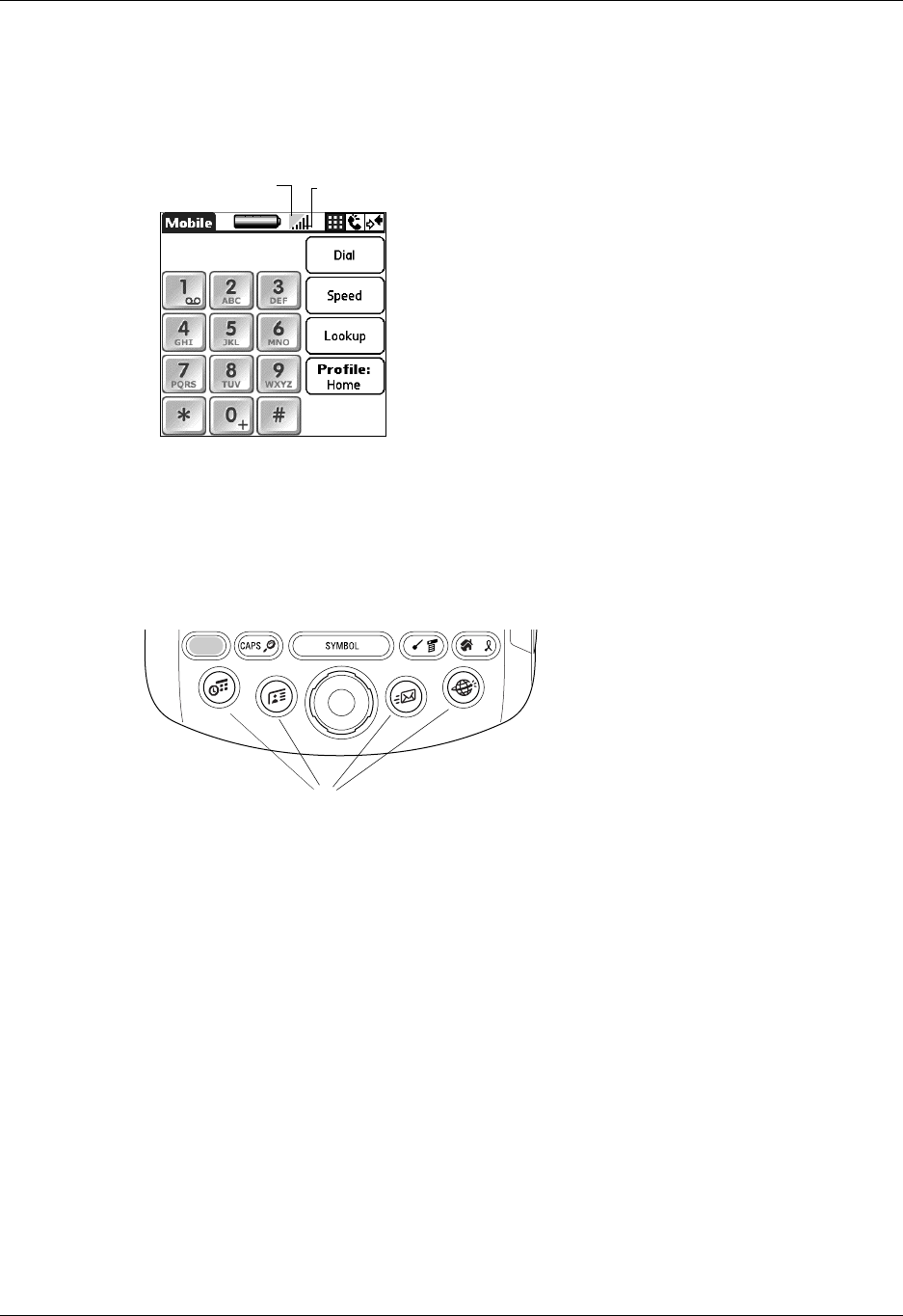
Chapter 1 Welcome
6
Your handheld has a signal strength indicator to inform you of the availability and
strength of wireless service in your immediate area. It also has an indicator
showing your GPRS coverage. If you are having problems with your wireless
coverage, see “Wireless problems” in Appendix B.
Making a call in a medical or safety emergency
To make a call for emergency service: Press all four application buttons at once.
You can make this call even without the SIM card installed, so long as your
handheld’s radio is on and you are in an area that has coverage. The call is free.
Software Download Available
Palm Desktop software is supplied on a CD-ROM disc. Check www.palm.com/
support/intl for updates and new versions of the software.
Compatibility of third-party applications
Palm works with developers of third-party add-on applications to ensure the
compatibility of these applications with your new Palm handheld. Some third-
party applications, however, may not have been upgraded to be compatible with
your new Palm handheld, or they may not have been designed to incorporate all
the features available in your handheld.
GPRS coverage Signal strength indicator
Press the four application buttons at once to make a call for emergency
Palm, Inc. Confidential

Finding information
7
If you suspect that a third-party application is adversely affecting the operation of
your handheld, contact the developer of the application. In addition, Palm has
information about some applications’ compatibility with your handheld. To find
this information, do one of the following:
■Open your web browser and go to www.palm.com/support/tungstenw. On that
page, click the link leading to information on the compatibility of third-party
applications.
■Read the readme file for your handheld. After you install Palm Desktop
software on your computer, open the Palm folder. The readme file is located in
the Helpnote folder.
Finding information
For installation information, see Getting Started that came with your Tungsten W
handheld. For comprehensive information about using your handheld, continue
reading this electronic handbook.
For support information, upgrade information, articles, and answers to questions,
see www.palm.com/support/tungstenw.
For more information about using Palm Desktop software, see the following:
■The handheld tutorial, Quick Tour. To access this tutorial, tap the Quick Tour
icon from the Applications main screen.
■The Windows tutorial for Palm Desktop software, Desktop Quick Tour. To
access this tutorial, open Palm Desktop software and select Quick Tour from the
Help menu.
■The electronic Palm Desktop software for the Macintosh User’s Guide. To access this
guide, open the Palm folder and then open the Documentation folder.
Double-click the file Palm Desktop.pdf.
■The online help for Palm Desktop software. To access the online help, open
Palm Desktop software and select the Help menu.
Palm, Inc. Confidential

Chapter 1 Welcome
8
Palm, Inc. Confidential

9
CHAPTER 2
Exploring Your Handheld
Your wirelessly enabled Palm™ Tungsten™ W handheld helps you stay in touch
with important information while you are away from your desk. You can stay
organized, on time, and up-to-date with daily tasks. Use your new handheld to do
the following:
■Compose and securely send and receive business or personal e-mail wirelessly.
NOTE Some companies restrict access to internal e-mail accounts when using
a handheld. Check your company for their policy on use of handhelds.
■Receive alerts when a new voicemail or SMS message arrives or a reminder
occurs. Rely on any or all of the three alert modes: the indicator light, vibrator,
or alarm sound. Support for the alert feature depends on your contract with
your wireless service provider.
■Access WAP content, applications, and games.
■Make phone calls using a hands-free headset.
■Set preferences for how you receive alarms: hearing a sound, seeing a blinking
indicator light, or feeling your handheld vibrate. Choose any combination.
■Access Internet information.
■Browse or search the Internet.
■Download and use web clipping applications that help you find specially
formatted Internet information quickly.
NOTE Using web clipping on the handheld requires software that is available
on the Software Essentials CD.
■Enter your schedule in Date Book.
■Keep all your contact names, addresses, and phone numbers in Address Book.
■Prioritize and assign your tasks a due date in To Do List.
■Set alarms from World Clock and Date Book to keep yourself on schedule and
remind yourself of appointments, redial reminders, and notes.
■Synchronize your data with Palm™ Desktop software on your Windows or
Mac computer so you can work with your personal information on your
computer and maintain a copy of your information.
Palm, Inc. Confidential
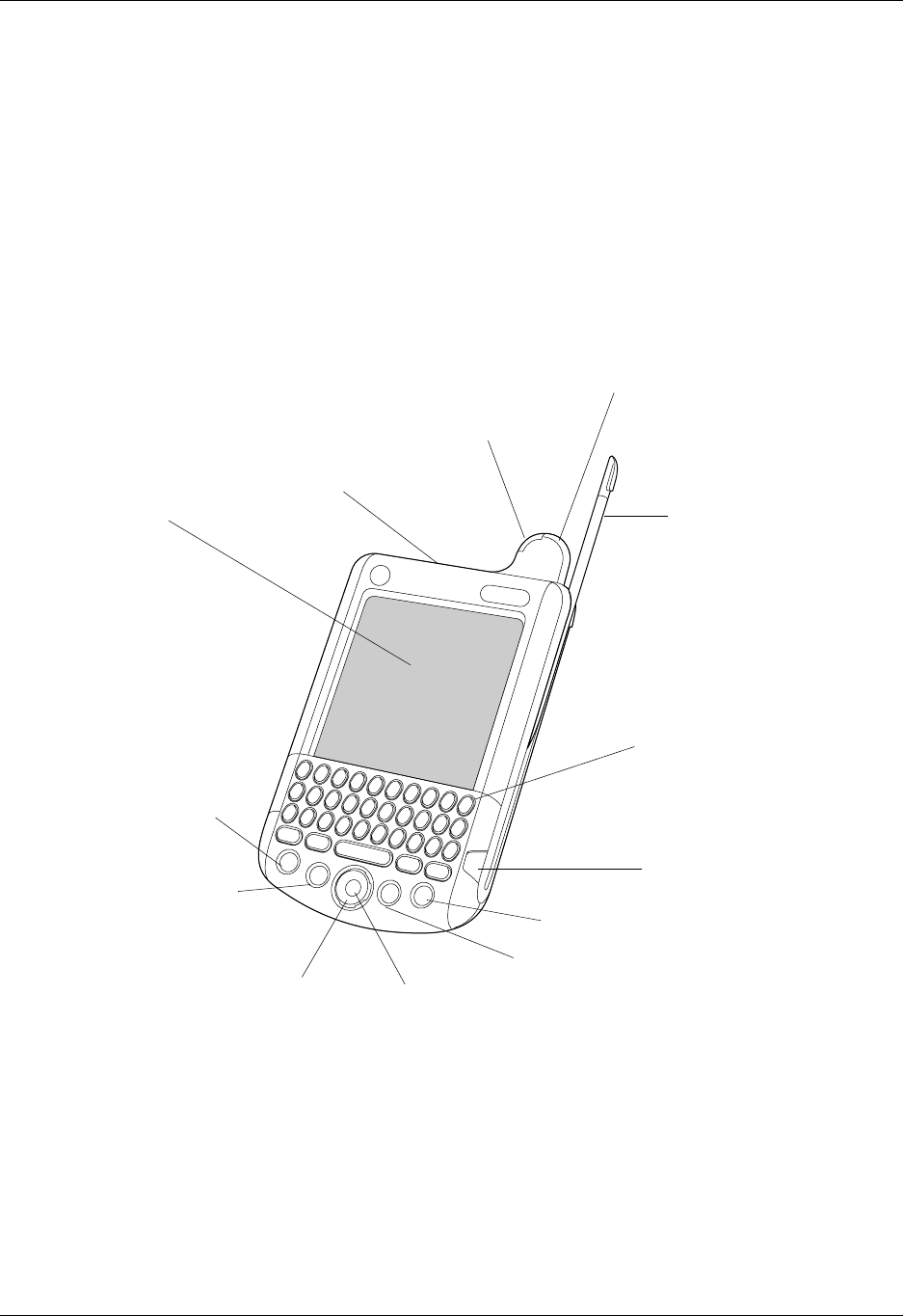
Chapter 2 Exploring Your Handheld
10
■Insert SD or MultiMediaCard expansion cards to add more software or
memory, or to back up your data.
■Beam information to another device that has an infrared (IR) port.
Locating handheld components
Take a few moments to locate the front and back panel components of your
handheld.
Locating front panel controls
Screen
Keyboard area
Navigator
Power button/
Backlight control
Red and green indicator light
Antenna cap
Stylus
IR port
Date
Book
Address
Book
Wireless
E-mail
Application
buttons
Select button Application buttons
Palm, Inc. Confidential

Locating handheld components
11
IR port Uses infrared technology to transmit data to and receive data
from other Palm OS® handhelds, and to perform HotSync®
operations. See “Using elements of the handheld interface”
in Chapter 3 and see “Conducting IR HotSync operations” in
Chapter 20 for more information.
Red and green
indicator light Indicates when you are within or out of range for wireless
transmission. It also notifies you of incoming Date Book or
World Clock alarms.
Antenna cap Houses the antenna for your mobile radio.
Stylus Slides in and out of the slot in the side channel of the
handheld. To use the stylus, remove it from the slot and hold
it as you would a pen or pencil. Unscrew the top of the stylus
to access the reset tool.
Keypad The area where you type letters and numbers, and access
special function keys. See Chapter 3 to learn how to type
characters.
Power button/
Backlight control Turns your handheld on or off and controls the backlight
feature. If your handheld is turned off, pressing the power
button turns the handheld on and returns you to the last
screen you viewed.
If your handheld is turned on, pressing the power button
turns the unit off.
Pressing the power button for about two seconds turns the
backlight on or off. For more information on the backlight,
see the next section, “Using the indicator light”.
Application buttons Activate the individual handheld applications that
correspond to the icons on the buttons: Date Book, Address
Book, E-mail, and Wireless. See “Buttons preferences” in
Chapter 21 for details on reassigning these buttons to open
any application on your handheld.
Navigator The five-way navigation button enables you to move up,
down, right, and left in pick lists and menus. You can scroll
down to view information below the viewing area, and scroll
up to view the information above the viewing area. The
navigator also has some special functions that are described
in this handbook.
Palm, Inc. Confidential

Chapter 2 Exploring Your Handheld
12
Using the indicator light
The indicator light at the top of the handheld blinks to indicate the following status
levels:
Select button The navigator center Select button enables you to select
items. The Select button also has some special functions that
are described in this handbook.
Screen Displays the applications and information stored in your
handheld. It is touch-sensitive and responds to the stylus.
No light Mobile radio is off.
Green light flashes
every five seconds Mobile radio is on and transmitter is within range.
Red light flashes every
five seconds Mobile radio is on, but transmitter is out of range. You need
to move to another area to bring the transmitter within
range.
Green light flashes at
paired intervals A notification that:
■Date Book or World Clock event alert has occurred.
■A call was missed.
■Voicemail was received.
A dialog box appears, describing the reason for
notification. Acknowledging the notification turns off the
indicator light.
Red and green indicator light
Palm, Inc. Confidential

Locating handheld components
13
Locating back panel components
Headset jack Connects the hands-free headset to your handheld, enabling
you to make or receive telephone calls.
Service test point For use by Palm, Inc., authorized service personnel only.
Reset button Under normal use, you should not have to use the reset
button. See “Resetting your handheld” in Appendix A for
information about when and how to use the reset button.
Expansion card slot Accepts SD or MultiMediaCard expansion cards, enabling
you to add more memory, applications, or Bluetooth
functionality. You can also back up data to an expansion
card.
NOTE Expansion cards are purchased separately.
Universal connector Connects your handheld to the cradle, which in turn
connects to the back of your computer and through the AC
adapter to the wall current. This allows you to recharge your
handheld as well as update the information between your
handheld and computer using HotSync technology.
The universal connector also connects peripheral hardware
devices to your handheld.
Side channel The left side channel holds the front cover, which slides in
and out.
Universal
connector
Expansion
card slot
Side
channel for
cover
Reset
button
Headset jack
Service test point
Palm, Inc. Confidential

Chapter 2 Exploring Your Handheld
14
Adding an expansion card
A tiny expansion card (sold separately) increases the variety of tasks you can do
and the amount of space you have for storing software and data on your handheld.
To insert a card:
1. Insert the card in the direction shown by the icon.
2. Push the card in with your thumb. You feel the card lock and hear the system
sound.
To rem ove a c ard:
1. Push lightly against the card with your thumb.
2. When the card is released, you hear the system sound.
For complete information about working with expansion cards, see Chapter 7.
Notched
corner
Label on card
faced down
Push
Push
Palm, Inc. Confidential

Using the backlight
15
Using the backlight
The backlight makes it easy for you to see the information on your handheld. The
backlight is on by default but can be turned off to extend battery life. You can
turned on, off, or adjust the backlight in the following ways:
■Turn off the backlight and power automatically (after a period of inactivity)
with the Auto-off feature. See “General preferences” in Chapter 21 for more
information.
■Turn the backlight on or off by pressing the power button and holding it down
for about two seconds. Release the button when the backlight turns on or off.
■Disable the backlight or adjust the backlight brightness level using the Adjust
Brightness dialog box.
To enable the backlight or adjust the backlight level:
1. Press Function + Brightness .
2. Tap the Enable Backlight check box to select it.
3. Tap to the left or right of the slider to adjust the brightness in small increments,
or drag the slider to change the brightness in large increments.
Palm, Inc. Confidential

Chapter 2 Exploring Your Handheld
16
Palm, Inc. Confidential

17
CHAPTER 3
Navigating and Entering Data
This chapter explains how to enter data into your handheld, navigate around the
interface, and use menu commands. There are several ways to enter data, to
navigate, and to use menu commands:
■Tapping
■Using the five-way navigator
■Using the handheld keyboard
■Beaming data from another device that has an infrared port
■Entering or importing data in Palm™ Desktop software and then synchronizing
with your handheld
Tapping
Like using a mouse to click elements on a computer screen, using the stylus to tap
elements on your handheld screen is the basic action that gets things done on your
handheld.
The first time you start your handheld, setup instructions appear on the screen.
These instructions include a calibration screen. Calibration aligns the internal
circuitry of your handheld with its touch-sensitive screen so that when you tap an
element on the screen, the handheld can detect exactly which task you want to
perform.
IMPORTANT Always use the point of the stylus for tapping or making strokes on the
handheld screen. Never use an actual pen, pencil, or other sharp object to write on
the handheld screen.
With your handheld turned on, you can tap the handheld screen to do many
operations, such as the following:
■Open applications
■Choose menu commands
■Select options in dialog boxes
Palm, Inc. Confidential
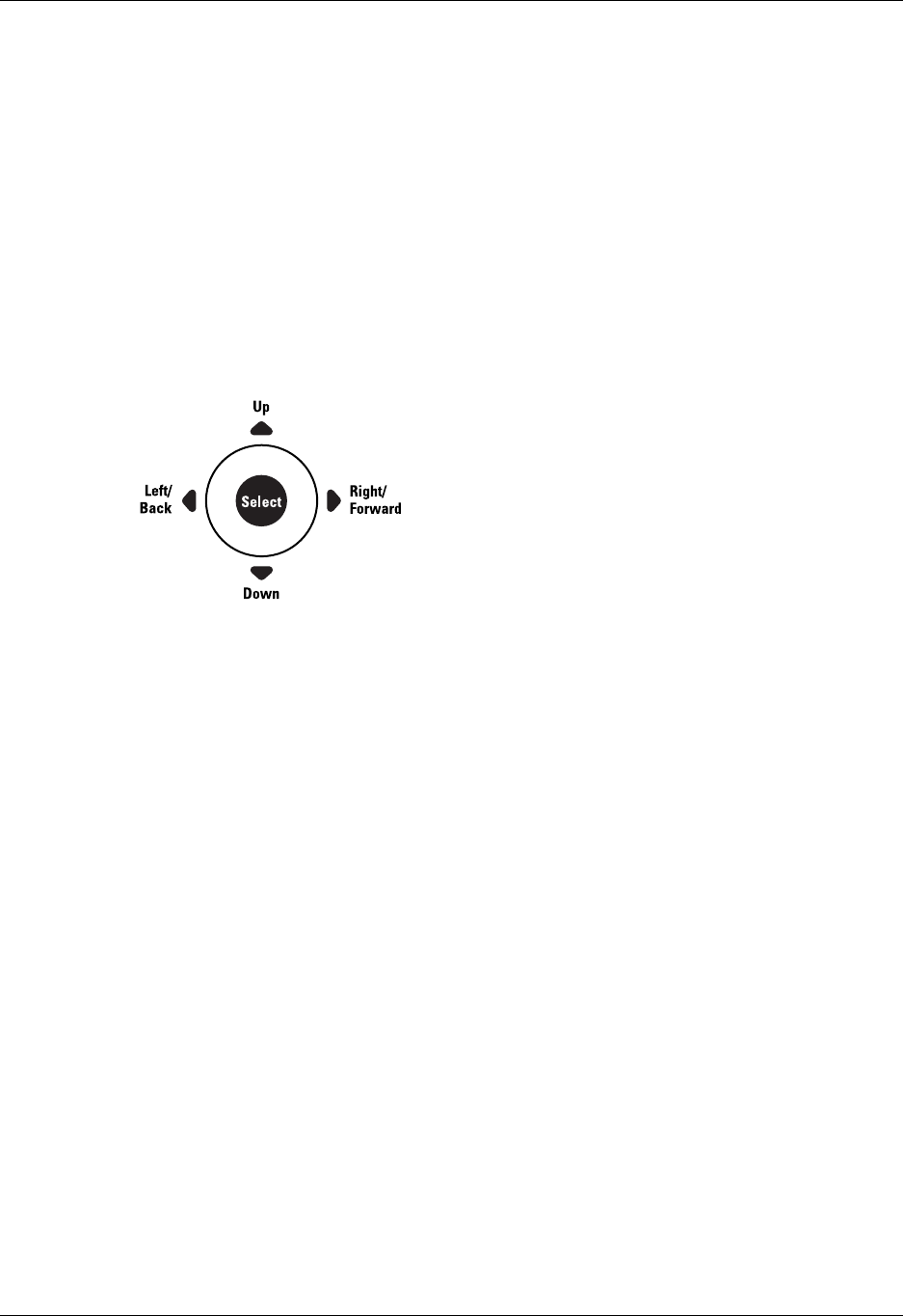
Chapter 3 Navigating and Entering Data
18
Just as you can drag the mouse to select text or move objects on your computer,
you can also drag the stylus to select text. You can also use the stylus to drag the
slider of any scroll bar.
Using the navigator
When you work with most applications, the navigator on the front panel of your
handheld makes it easy for you to navigate among and select your entries. You can
use the navigator to perform tasks without the stylus using one hand.
See Chapter 4 and Chapter 5 for additional information about using the navigator
with Address Book, and Chapter 8 for additional information on using the
navigator with Date Book.
To navigate in list screens, do any of the following:
■Press Up or Down on the navigator to scroll an entire screen of records.
■Press and hold Up or Down on the navigator to accelerate the scrolling.
■Press Select on the navigator to insert the selection highlight. When the selection
highlight is present, you can do the following:
– Press Up or Down on the navigator to scroll to the previous or next records.
– Press Select again to view the selected record.
– Press Left on the navigator to remove the selection highlight.
To navigate in record screens:
1. Press Up or Down on the navigator to scroll within the current record.
2. Press Right or Left on the navigator to scroll to the previous or next record. (This
feature is not available in Address Book.)
3. Press Select on the navigator to return to the list screen.
Palm, Inc. Confidential
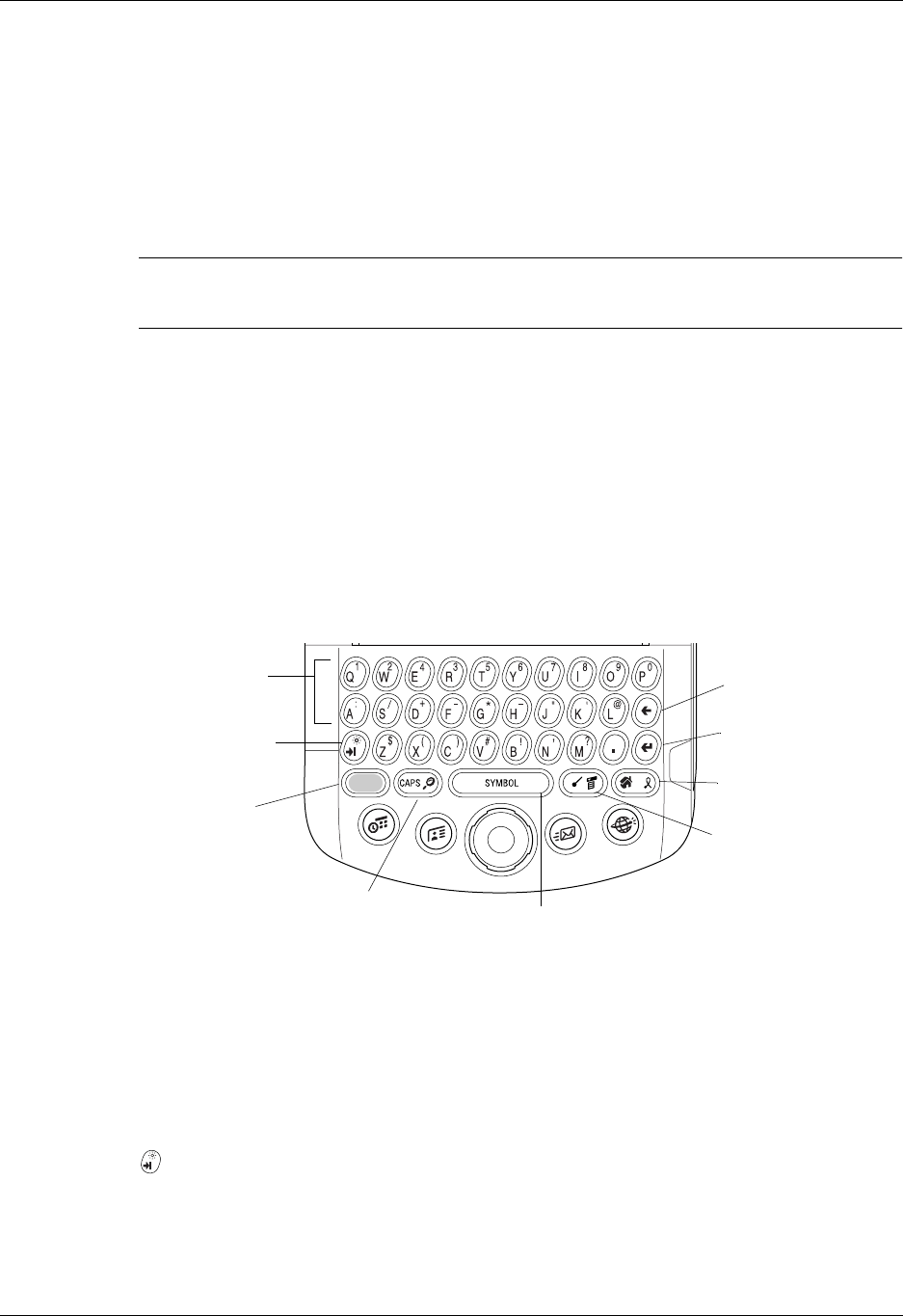
Using the keyboard
19
To navigate in dialog boxes:
■While a pick list is open, press Up or Down on the navigator to highlight an
item, and then press Select on the navigator to select the item.
■Press Select on the navigator to close a dialog. If there’s only one button,
pressing Select activates that button. If there’s multiple buttons, Select activates
affirming buttons such as OK, Yes, or Done.
IMPORTANT Read dialog boxes carefully. Sometimes, selecting OK or Yes results in
deleting data.
Using the keyboard
You can quickly and accurately enter text or numbers on your handheld using the
keyboard. The keyboard also has special function keys that enable you to access
features. Another feature is AutoCorrect, which automatically corrects some
common misspellings when entering data from the keyboard.
Below the keyboard are application buttons and the 5-way navigator that enables
you to navigate menus and pick lists quickly without using the stylus. These
features are described in Chapter 2.
Letter and number keys: Enables you to enter letters and numbers. You
can change the key response from the Keyboard preferences screen.
See “Keyboard Preferences” in Chapter 21.
You can also access international characters using the navigator control.
See “Accessing international and special characters” later in this
chapter.
Tab/Brightness key: Adds a tab or opens the Brightness dialog box. For
more information on the Brightness dialog box, see “Using the indicator
light” in Chapter 2.
Return/Enter key
Function
key
Delete key
Home/ShortCut
key
Tab/Brightness
key
Letter and
number keys
CAPS/Find key Space/Symbol key
Command/Menu
key
Palm, Inc. Confidential

Chapter 3 Navigating and Entering Data
20
Typing capital letters
The keyboard enables you to capitalize letters in two ways:
■Use the CAPS key . Press the CAPS key twice to initiate CAPS lock.
■Press and hold the key. This feature works only when the Keyboard preference
Repeat Function is set to Capital. See “Keyboard Preferences” in Chapter 21 for
more information.
Accessing international and special characters
You can access international and special characters directly from the keyboard or
from onscreen keyboards. These character sets enable you to communicate
accurately through your memos or wireless messages.
Accessing from the keyboard
You can access international characters from the keyboard by pressing and
holding a key, and then pressing Up and Down on the navigator. The character on
the screen scrolls through a sequence of related international characters. You can
scroll though the sequence either forward or backward depending on whether you
are pressing Up or Down on the navigator.
Function key: Press to access the secondary character set. See “Using the
Function key” later in this chapter.
CAPS/Find key: Capitalizes letters or opens the Find dialog box. For
more information on capitalizing letters, see the next section “Typing
capital letters”. For information on the Find dialog box, see “Finding
information” in Chapter 4.
Space/Symbol key: Adds a space to the text or opens the onscreen
keyboards. For more information about the onscreen keyboards, see
“Accessing the onscreen keyboards” later in this chapter.
Command/Menu key: Opens the Command toolbar or Menu. For
information about the Command mode, see “Menu commands” in
Chapter 4. For more information about Menus, see “Using menus” in
Chapter 4.
Home/ShortCut key: Opens the Application Launcher or enables you to
enter a text ShortCut. For more information on ShortCuts, see “Using
ShortCuts” later in this chapter.
Return/Enter key: Adds a manual return to the next line or enters the
data.
Delete/Backspace key: Deletes the previous character.
Palm, Inc. Confidential
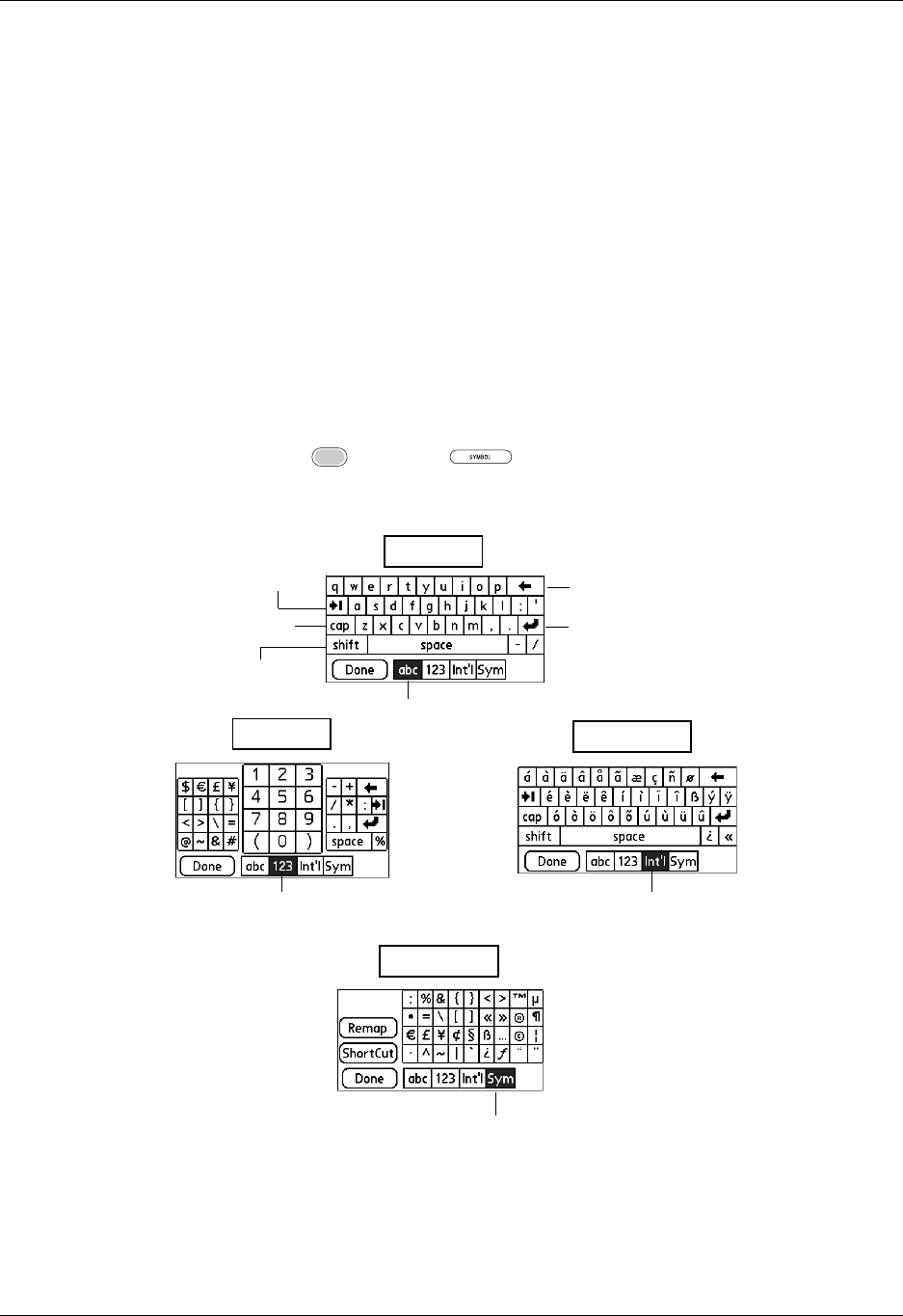
Using the keyboard
21
NOTE This feature does not work with every key or with the Function key secondary
character set.
To access international characters from the keyboard:
1. Press and hold a key.
2. Press Up or Down on the navigator.
3. Accessing the onscreen keyboards
You can open the onscreen keyboards anytime you need to enter special characters
or numbers on your handheld.
To use the onscreen keyboard:
1. Open any application (such as Memo Pad).
2. Tap any record, or tap New.
3. Press Function + Symbol .
When a keyboard is open, you can tap to open any of the other keyboards.
After you finish, tap Done to close the onscreen keyboard and place the text in
the record.
Backspace
Carriage return
Ta b
Caps lock
Caps shift
Tap here to display
alphabetic keyboard
Tap here to display
numeric keyboard
Tap here to display
international keyboard
Alpha
Numeric
Symbol
Tap here to display
symbol keyboard
International
Palm, Inc. Confidential

Chapter 3 Navigating and Entering Data
22
Using the Function key
The Function key enables you to access the secondary character or feature set
from each of the keys. The secondary character and feature set is labeled in blue in
the upper right on each available key.
When you press Function , a dot appears in the lower-right corner, indicating
that the next key pressed will use the secondary character or feature set. If you
press the Function twice, the dot changes to a “1” and the function feature
remains locked. Pressing Function again unlocks it.
Using special features
In addition to characters, the Function key accesses special features on some of the
keys. The following keys have special features:
Brightness key: Opens the Brightness dialog box. See “Using the
backlight” in Chapter 2 for more information.
Find key: Opens the Find dialog box. See “Using Find” in Chapter 4 for
more information.
Menu key: Opens the menu for the current screen. For more information,
see “Using menus” in Chapter 4 and see the next section, “Using menu
commands”.
Function key
Function active icon Function lock icon
Palm, Inc. Confidential
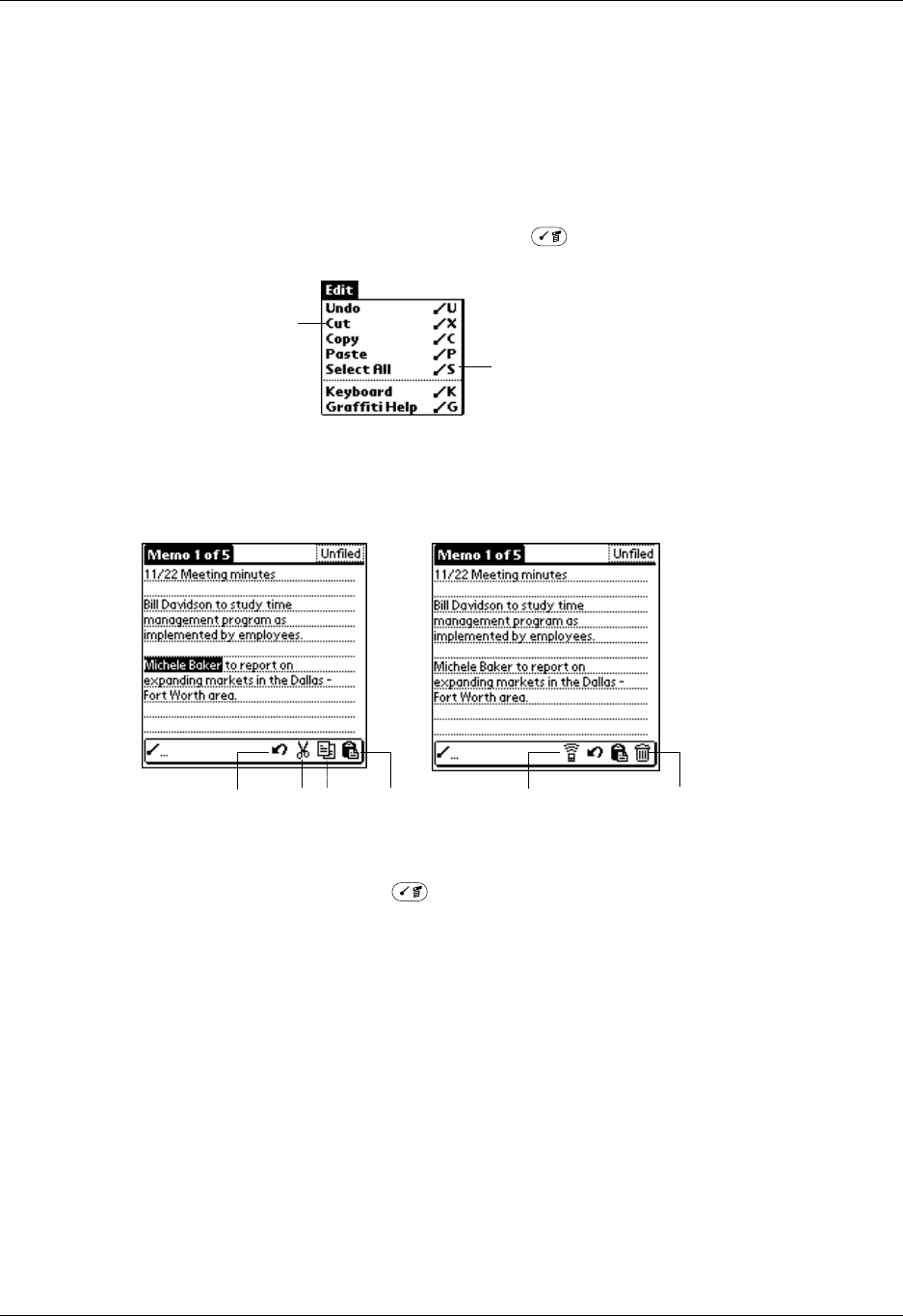
Using the keyboard
23
Using menu commands
By using the menu commands you can access many functions directly from the
keyboard without tapping.
Most menu commands have an equivalent Command stroke, which is similar to
the keyboard shortcuts used to execute commands on computers. The command
letters appear to the right of the command names. For example, to choose Select All
in the Edit menu, press Command stroke , and type the letter s.
The command toolbar displays context-sensitive menu commands for the current
screen. For example, if text is selected the menu icons displayed may be Undo, Cut,
Copy, and Paste. Tap an icon to select the command.
To use menu commands:
1. Press Command stroke .
The Command toolbar opens at the bottom of the screen. The Command toolbar
indicates that you are in Command mode.
2. Tap an icon or type the command letter immediately to choose the menu
command.
Command mode is active only for a short time.
Command letters
Menu commands
CutUndo Copy Paste Beam Delete
Palm, Inc. Confidential

Chapter 3 Navigating and Entering Data
24
Using ShortCuts
ShortCuts make entering commonly used words or phrases quick and easy.
ShortCuts are similar to the Glossary or Autotext features of some word
processors.
The handheld comes with several predefined ShortCuts, and you can also create
your own. Each ShortCut can represent up to 45 characters. For example, you
might create a ShortCut for your name or for the header of a memo. See “ShortCuts
preferences” in Chapter 21 to learn about creating your own ShortCuts.
To use a ShortCut:
1. Press Function + ShortCut .
When you press the ShortCut key, the ShortCut symbol appears at the insertion
point to show that you are in ShortCut mode.
2. Type the ShortCut characters.
Using elements of the handheld interface
Menu bar and menu
commands A set of commands that are specific to the application. Not
all applications have a menu bar.
To access the menu bar, do one of the following:
■Tap the Menu bar.
■Press Function + Menu .
To access the menu commands, do one of the following:
■Tap the menu command on the menu.
■Use Right, Left, Up, or Down on the navigator.
■Press Command Stroke + the letter. For more
information see “Using menu commands” later in this
chapter.
Scroll
bar
Previous/next
arrows
Check
box
Command
button
Pick list
Menu bar
Menu
command
Palm, Inc. Confidential

Using elements of the handheld interface
25
Check box When a checkmark appears in a check box, the
corresponding option is active.
To insert or remove a check mark:
■If a check box is empty, tapping it inserts a checkmark.
■If a check box is selected, tapping it removes the
checkmark.
Command buttons These appear in dialog boxes and at the bottom of
application screens.
To select a command button, do one of the following:
■Tap a button to perform a command.
■Press Select on the navigator to select buttons such as OK,
Yes, or Done.
■Press Function + Enter to select the OK, Done, or
Yes buttons.
■Press Function + Backspace , to select Cancel or
No buttons.
Next/previous
arrows The left and right arrows display the previous and next
record; the up and down arrows display the previous and
next page of information.
To use the arrows, do one of the following:
■Tap the arrows.
■Use Right, Left, Up, or Down on the navigator.
Pick list A list of choices that you can select from.
To use the pick list:
■Tap the arrow to display a list of choices.
■Tap an item in the list.
■Use Up or Down on the navigator to scroll through the list
and select an item.
Palm, Inc. Confidential
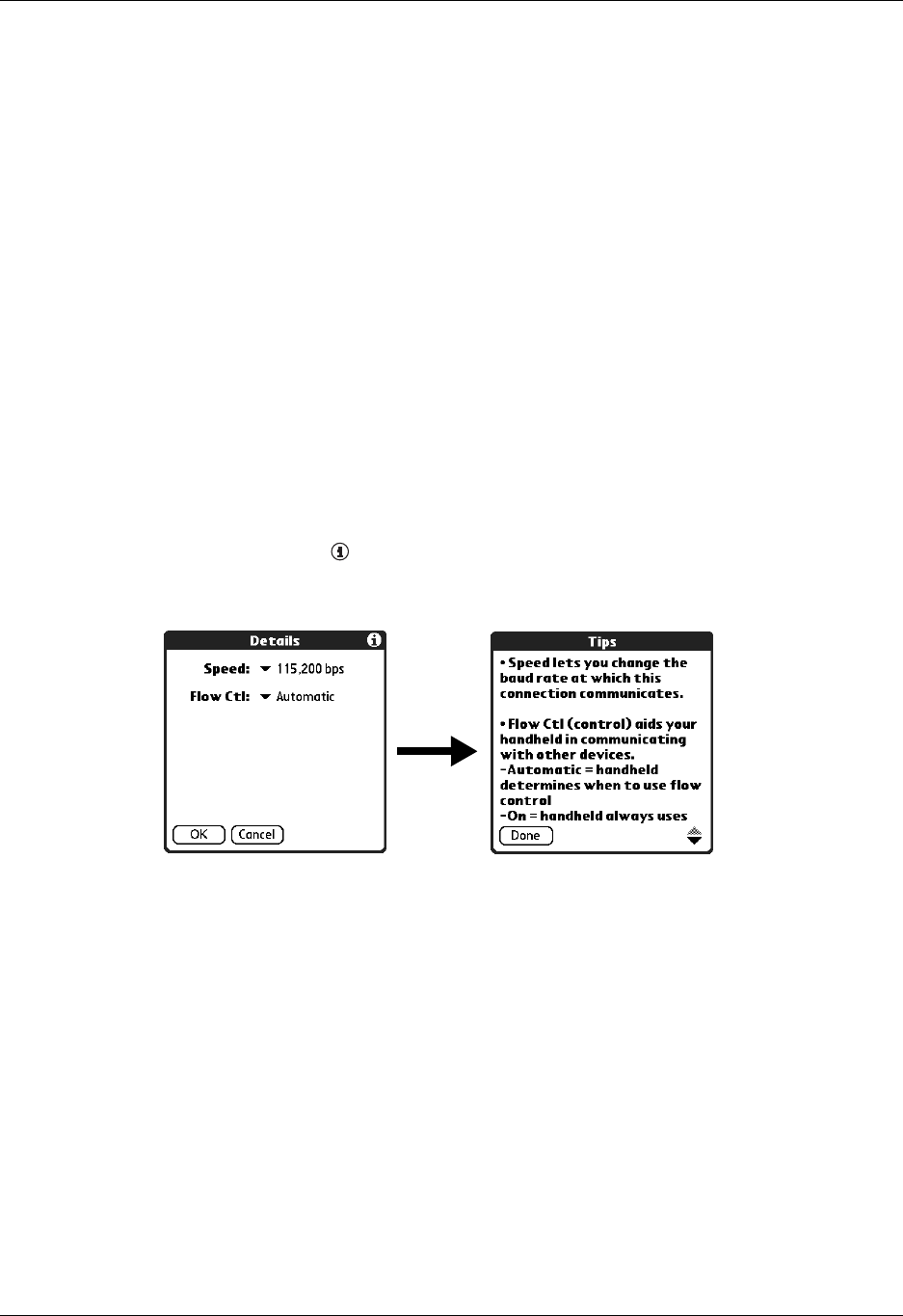
Chapter 3 Navigating and Entering Data
26
Displaying online tips
Many of the dialog boxes that appear on your handheld contain an online Tips icon
in the upper-right corner. Online tips anticipate questions you have in a dialog box,
provide shortcuts for using the dialog box, or give you other useful information.
To display an online tip:
1. Tap the Tips icon .
2. After you review the tip, tap Done.
Beaming data
Your handheld is equipped with an infrared (IR) port that is located at the top of
the handheld, behind the small dark shield. The IR port supports the IrCOMM
implementation of the standards for infrared communication established by the
Infrared Data Association (IrDA). This means that not only can you beam data to
another Palm OS® handheld that’s close by and equipped with an IR port, but you
can also beam data to a mobile phone and to any other device that supports the
IrCOMM implementation of the IrDA standards and that can read the type of data
you’re beaming.
Scroll bar A bar that enables you to scroll up and down a page.
To use the scroll bars:
■Drag the slider, or tap the top or bottom arrow, to scroll
the display one line at a time.
■To scroll to the previous page, tap the scroll bar just above
the slider. To scroll to the next page, tap the scroll bar just
below the slider.
■You can also scroll to the previous and next pages by
pressing Up and Down on the navigator.
Palm, Inc. Confidential

Beaming data
27
You can beam the following information between devices with an IR port:
■The record currently displayed in Date Book, Address Book, To Do List, or
Memo Pad
■All records of the category currently displayed in Address Book, To Do List, or
Memo Pad
■A special Address Book record that you designate as your business card,
containing information you want to exchange with business contacts
■An application installed in RAM memory
■An application installed on an expansion card that is seated in the card slot
TIP You can also perform HotSync® operations using the IR port.
See “Conducting IR HotSync operations” in Chapter 20 for details.
To select a business card:
1. Create an Address Book record that contains the information you want on your
business card.
2. Press Function + Menu .
3. Select “Select Business Card” on the Record menu.
4. Tap Yes.
To beam a record, business card, or category of records:
1. Locate the record, business card, or category you want to beam.
2. Press Function + Menu .
3. Select one of the following from the Record menu:
– The Beam command for an individual record
– In Address Book only: Beam Business Card
– Beam Category
4. When the Beam Status dialog box appears, point the IR port directly at the IR
port of the receiving handheld.
For best results, handhelds should be between 10 centimeters (approximately
4 inches) and 1 meter (approximately 39 inches) apart, and the path between the
two handhelds must be clear of obstacles. The beaming distance to other Palm
OS handhelds may be different.
Palm, Inc. Confidential
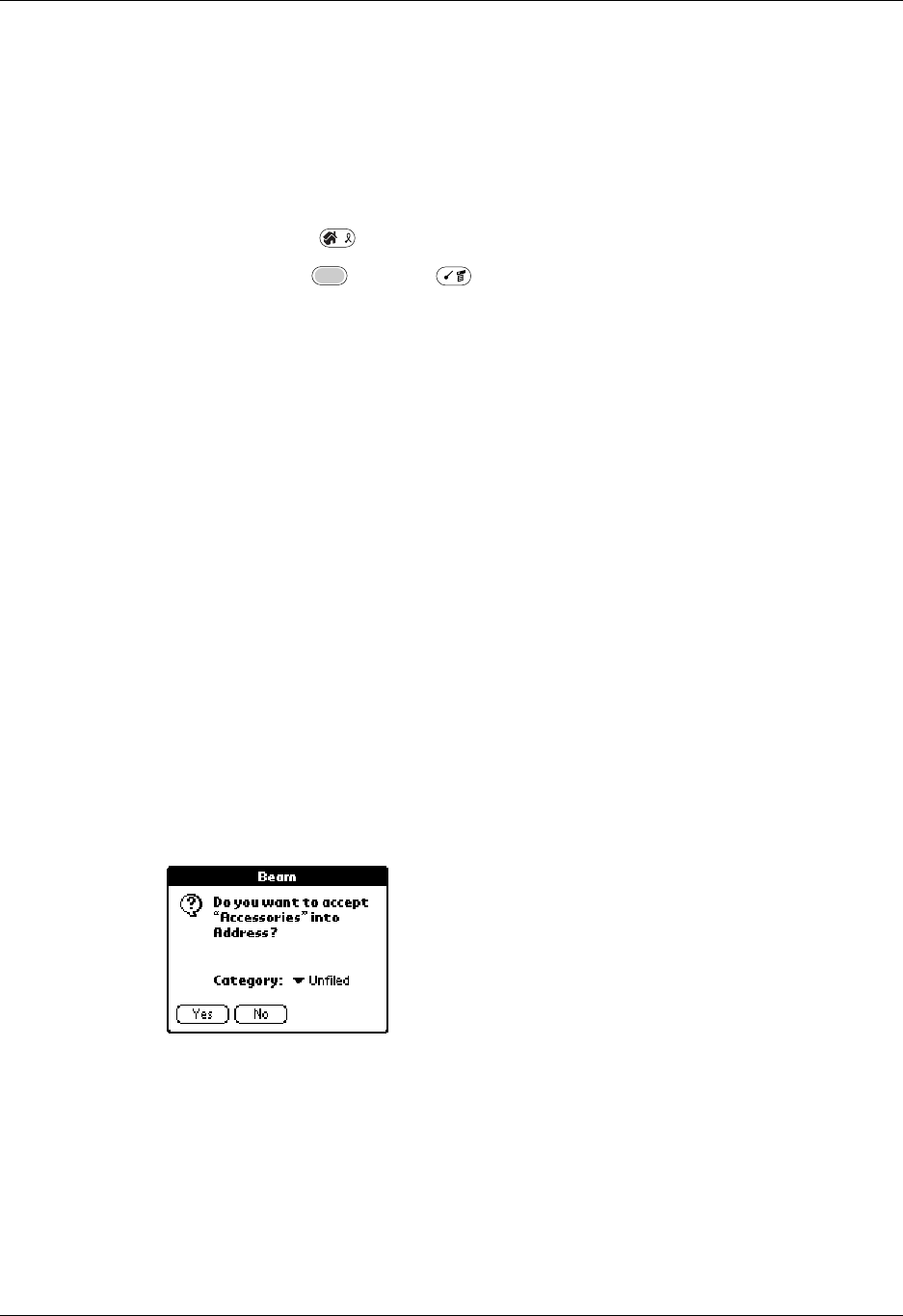
Chapter 3 Navigating and Entering Data
28
5. Wait for the Beam Status dialog box to indicate that the transfer is complete
before you continue working on your handheld.
TIP You can also press and hold the Address Book application button to instantly
beam your business card to another device with an IR port.
To beam an application:
1. Press the Home .
2. Press Function + Menu .
3. Tap App, and then select Beam.
4. Select either Handheld or Card from the Beam From pick list.
5. Tap the application you want to transfer.
Some applications are copy-protected and cannot be beamed. These are listed
with a lock icon next to them.
6. Tap Beam.
7. When the Beam Status dialog box appears, point the IR port directly at the IR
port of the receiving handheld.
8. Wait for the Beam Status dialog box to indicate that the transfer is complete
before you continue working on your handheld.
To receive beamed information:
1. Turn on your handheld.
2. Point the IR port directly at the IR port of the transmitting handheld to open the
Beam dialog box.
3. Select a category for the incoming information, create a new category, or leave
the information unfiled.
4. Tap Yes.
Palm, Inc. Confidential

Using your computer keyboard
29
Using your computer keyboard
If you have a lot of data to enter, or prefer to use the computer keyboard, you can
use Palm Desktop software or any supported personal information manager (PIM)
to enter information. You can then perform a HotSync operation to synchronize
the information on your computer with the information on your handheld. Many
of the applications that came with your handheld are also available in Palm
Desktop software and in most PIMs, so you don’t need to learn different
applications. For more information on entering data on your computer, refer to the
online Help in Palm Desktop software, the Quick Tour in Palm Desktop software
(for Windows users), and the Palm™ Desktop software Software for the Macintosh
User’s Guide on the Palm Desktop software CD-ROM.
Importing data
If you have data stored in computer applications such as spreadsheets and
databases, or if you want to import data from another handheld, you can transfer
the data to your handheld without having to enter it manually. Save the data in one
of the file formats in the following list, import it into Palm Desktop software, and
then perform a HotSync operation to transfer the data to your handheld.
Importing data from a Windows computer
Palm Desktop software can import data in the following file formats:
■Comma delimited (.csv, .txt): Address Book and Memo Pad only
■Tab delimited (.tab, .tsv, .txt): Address Book and Memo Pad only
■CSV (Lotus Organizer 2.x/97 Mapping): Address Book only
■vCal (.vcs): Date Book only
■vCard (.vcf): Address Book only
■Date Book archive (.dba)
■Address Book archive (.aba)
■To Do List archive (.tda)
■Memo Pad archive (.mpa)
Archive formats can be used only with Palm Desktop software. Use the archive file
formats to share information with other people who use a Palm OS handheld or to
create a copy of your important Palm Desktop information.
Palm, Inc. Confidential

Chapter 3 Navigating and Entering Data
30
To import data from a Windows computer:
1. Open Palm Desktop software.
2. Click the application into which you want to import data.
3. If you are importing records that contain a field with category names, do the
following:
Select All in the Category box.
Be sure that the same categories that appear in the imported file also exist in the
application. If the categories do not exist, create them now; otherwise, the
records are imported into the Unfiled category.
4. From the File menu, choose Import.
5. Select the file you want to import.
6. Click Open.
If you are importing a vCal or vCard file, skip to step 10. You do not have to
specify which fields correspond to the imported data.
7. To import data into the correct Palm Desktop fields, drag fields in the left
column so that they are opposite the corresponding imported fields on the
right.
8. If you do not want to import a field, deselect the check box for that field.
9. Click OK.
The imported data is highlighted in the application.
10. To add the imported data to your handheld, perform a HotSync operation.
See Palm Desktop online Help for more information on importing and exporting
data.
Using File Link
The File Link feature enables you to import Address Book and Memo Pad
information to your handheld from a separate external file on your Windows
computer, such as a company phone list. You can configure the File Link feature to
check for changes to the external file when you perform a HotSync operation.
HotSync Manager stores the data in a separate category in Palm Desktop software
and on your handheld.
With File Link, you can import data stored in any of the following formats:
■Comma-separated (*.csv)
■Memo Pad archive (*.mpa)
■Address Book archive (*.aba)
■Text (*.txt)
For information on how to set up a file link, see the Palm Desktop online Help.
Palm, Inc. Confidential

Importing data
31
Importing data from a Mac computer
Palm Desktop software can import data from any of the following applications
when you export the data in the appropriate file format:
■Address Book Plus (text file)
■Claris Organizer (Palm Desktop software can open these files directly).
■ClarisWorks (Save under new name as ASCII text file).
■DateBook Pro (text file)
■DayMaker (text file)
■Dynodex (text file)
■FileMaker Pro (tab separated text file)
■Meeting Maker (text file)
■Newton running OS 1.0 with Newton Connection Kit:
Names, Date Book Calendar, and Notepad (text file)
■Now Contact (text file)
■Now Up-to-Date (text file)
■QuickDex (text file)
■TouchBase Pro (text file)
Palm Desktop software can also import data in the following file formats:
■Tab delimited (.tab, .tsv, .txt)
■vCal (.vcs): Data Book only
■vCard (.vcf): Address Book only
To import data from a Mac computer:
1. Open Palm Desktop software.
2. From the File menu, choose Import.
3. Select the file you want to import.
4. Click Import.
5. If you want to change the order of the fields you’re importing, point to a field,
wait for the cursor to change to a double arrow, and then drag the field to a new
location.
6. If you do not want to import a field, click the arrow between the field names.
7. From the Fields pop-up menu, choose the appropriate field.
Palm, Inc. Confidential

Chapter 3 Navigating and Entering Data
32
8. From the Delimiters pop-up menu, choose the appropriate delimiter.
9. Click OK.
10. To add the imported data to your handheld, perform a HotSync operation.
See Palm Desktop online Help for more information on importing and exporting
data.
Palm, Inc. Confidential
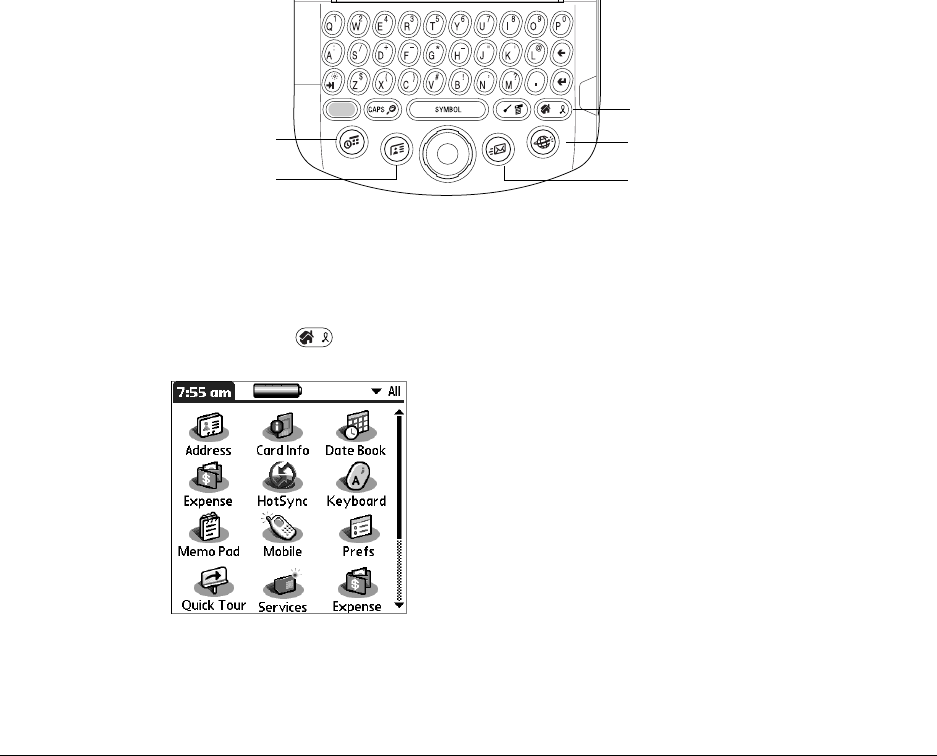
33
CHAPTER 4
Working with Applications
This chapter explains how to open and switch between applications on your
handheld, how to change application settings so they are personalized to your
work methods, and how to categorize applications so you view them in related
groups.
Opening applications
You can use the Applications Launcher to open any application installed on your
handheld or on an expansion card. You can also open Date Book and Address
Book with the application buttons on your handheld.
In addition to providing a way for you to open applications, the Applications
Launcher displays the current time, battery level, and application category.
To open an application on your handheld:
1. Press Home .
2. Tap the icon of the application that you want to open. If you have many
applications installed on your handheld, tap the scroll bar to see all your
applications.
Home key opens
Application Launcher
Address Book
Date Book
E-mail
Wireless
Palm, Inc. Confidential

Chapter 4 Working with Applications
34
Other ways to open applications
You can also open applications on your handheld in either of the following ways:
■Press and hold Select on the navigator to open the Applications Launcher. Press
Select on the navigator to insert the highlight. Press Up, Down, Right, and Left
on the navigator to highlight the icon of the application you want to open. Press
Select on the navigator to open the application.
■In the Applications Launcher, type the first letter of the application’s name. The
Applications Launcher scrolls to the first application with a name that begins
with that letter and highlights the icon. You can open the icon by pressing the
Enter key.
Opening expansion card applications
When an expansion card is properly seated in the expansion card slot, your
handheld responds based on the contents of the card and the application that is
active when you insert the card. In some cases, the application on the card opens
automatically upon insertion, or if you insert a card containing data from the
current application, the application displays the data on the card. In other cases,
the Applications Launcher switches to the card, and displays its contents, and the
pick list in the upper-right corner of the screen displays the name of the card.
To open an application on an expansion card:
■Select the icon of the application that you want to open.
Switching between applications
When working with any application, press Home or press an application
button on your handheld to switch to another application. Your handheld
automatically saves your work in the current application and displays it when you
return to that application.
When you use an expansion card, your handheld creates and displays a new
category that matches the name of the expansion card. You can easily switch
between applications installed on your handheld and on the expansion card.
Palm, Inc. Confidential

Categorizing applications
35
To switch to an expansion card:
1. Tap the pick list in the upper-right corner.
TIP When the highlight in the Applications Launcher is not active, you can also
press and hold Select on the navigator to open the category pick list.
2. Select the category item that matches the name of the expansion card.
Categorizing applications
The category feature enables you to manage the number of application icons that
appear onscreen in the Applications Launcher. You can assign an application to a
category and then display a single category or all your applications.
By default, your handheld includes system-defined categories, such as All and
Unfiled, and user-defined categories, such as Games, Main, and System.
You cannot modify the system-defined categories, but you can rename and delete
the user-defined categories. In addition, you can create your own user-defined
categories. You can have a maximum of 15 user-defined categories.
When you have an expansion card properly seated in the expansion card slot, the
last item in the category pick list becomes the name of the expansion card. You
cannot otherwise categorize applications that reside on an expansion card.
To categorize an application:
1. Press Home .
2. Press Command Stroke + Y.
Alternately, press Function + Menu , and then select Category on the
App menu.
Palm, Inc. Confidential
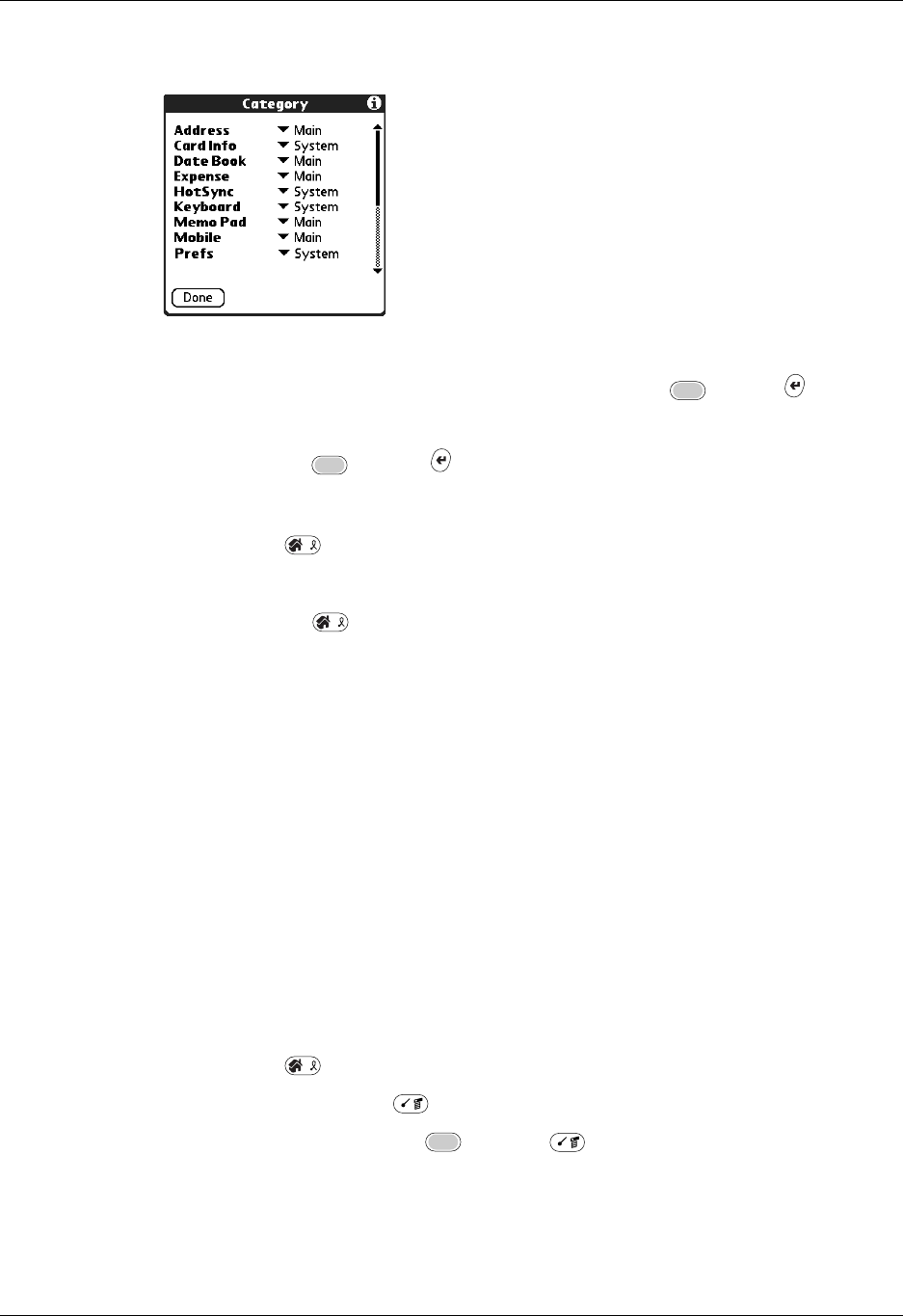
Chapter 4 Working with Applications
36
3. Tap the pick list next to each application to select a category.
TIP To create a new category, select Edit Categories from the pick list. Tap
New, enter the category name, and then press Function + Enter , or tap
OK to add the category.
4. Press Function + Enter , or tap Done.
To display applications by category:
1. Press Home .
2. Do one of the following:
– Press Home repeatedly to cycle through all your categories.
– Tap the pick list in the upper-right corner of the screen, and select the
category you want to display.
– When the highlight in the Applications Launcher is not active, press and
hold Select on the navigator to open the category list, press Up or Down on
the navigator to highlight a category, and then press Select on the navigator
to display that category.
Changing the Applications Launcher display
By default, the Applications Launcher displays each application as an icon. As an
alternative, you can choose to show a list of applications. You can also choose to
view the same category of applications each time you open the Applications
Launcher.
To change the Applications Launcher display:
1. Press Home .
2. Press Command Stroke + R.
Alternately, press Function + Menu , select Options, and then select
Preferences.
Palm, Inc. Confidential
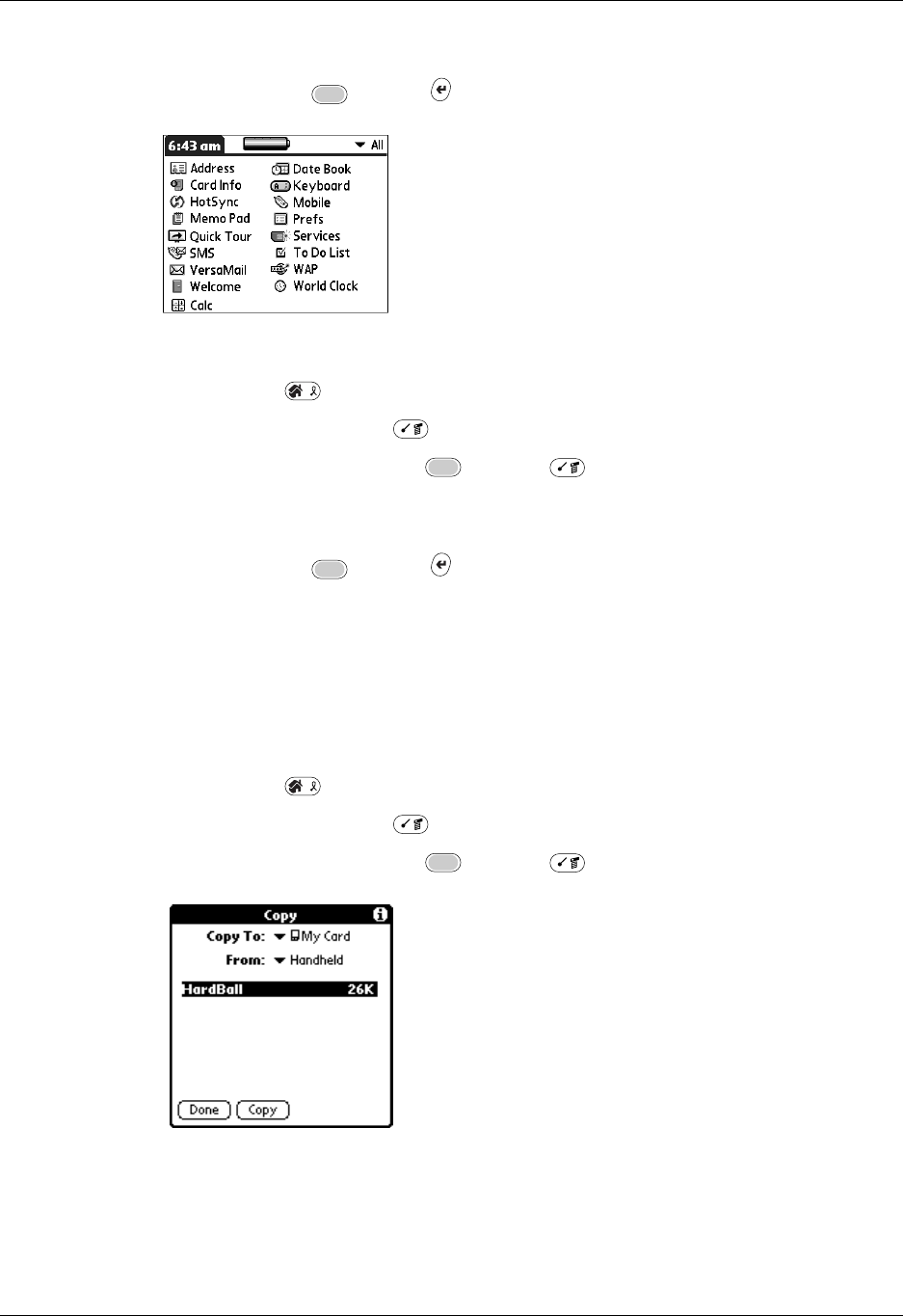
Copying applications to or from an expansion card
37
3. Tap the View By pick list and select List.
4. Press Function + Enter , or tap OK.
To open the Applications Launcher to the last opened category:
1. Press Home .
2. Press Command Stroke + R.
Alternately, press Function + Menu , select Options, and then select
Preferences.
3. Tap the Remember Last Category check box to select it.
4. Press Function + Enter , or tap OK.
Copying applications to or from an expansion card
You can copy applications from your handheld to an expansion card, or from an
expansion card to your handheld.
To copy an application to an expansion card:
1. Press Home .
2. Press Command Stroke + C.
Alternately, press Function + Menu , select Copy on the App menu.
3. Select Handheld from the Copy From pick list.
4. Select the card name from the Copy To pick list.
The Copy To pick list appears only if there are multiple cards available.
Palm, Inc. Confidential

Chapter 4 Working with Applications
38
5. Tap an application to copy.
6. Tap Copy.
7. Press Function + Enter , or tap Done.
You can install applications to a card that is seated in the expansion card slot
during a HotSync® operation; see “Installing add-on applications” later in this
chapter for details.
NOTE If you view your applications on the card using a Card Reader on your
Windows or Mac computer, the actual file names may differ from those displayed in
the Applications Launcher.
To copy an application from an expansion card:
1. Press Home .
2. Press Command Stroke + C.
Alternately, press Function + Menu , select Copy on the App menu.
3. Select the card name from the Copy From pick list.
4. Select Handheld from the Copy To pick list.
5. Tap an application to copy.
6. Tap Copy.
7. Press Function + Enter , or tap Done.
You can also beam applications from expansion cards to your handheld.
See “Using elements of the handheld interface” in Chapter 3 for details.
Palm, Inc. Confidential
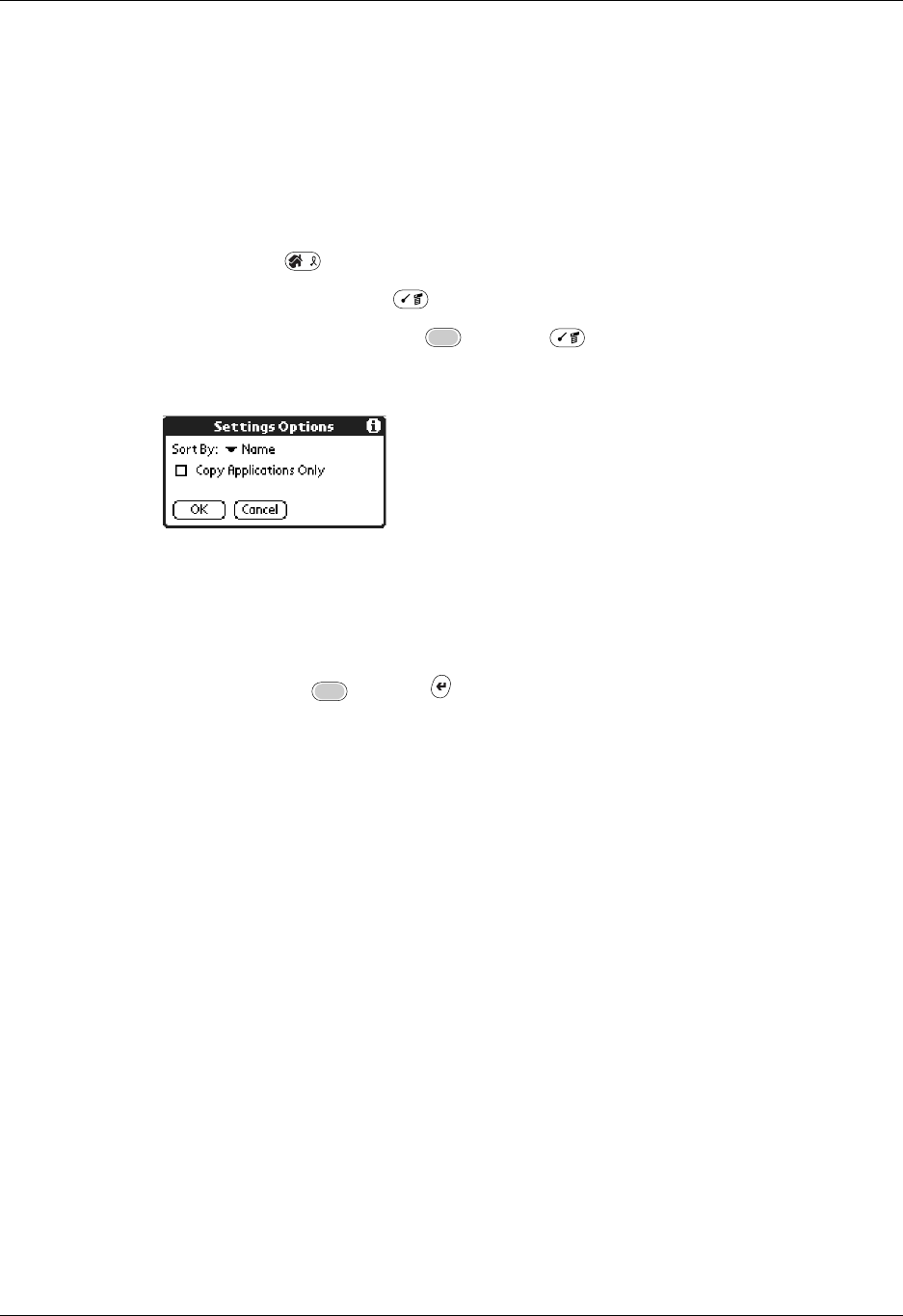
Selecting copy settings
39
Selecting copy settings
When using the copy feature, you can set the following:
■How applications are sorted and listed
■Whether to copy only the application or both the application and its data files
To select copy settings:
1. Press Home .
2. Press Command Stroke + C.
Alternately, press Function + Menu , select Copy on the App menu.
3. Tap Settings.
4. Select Name or Size from the Sort By pick list.
5. Tap the Copy Application Only check box to select it, if you want to copy only
the application files. Leave it deselected if you want to copy both the application
file and its associated data files.
6. Press Function + Enter , or tap OK.
NOTE The Sort By setting is in effect each time you use the copy feature. Each time
you want to copy an application only, you must select the Copy Applications Only
check box.
Using menus
Menus on your handheld are easy to use. Once you have mastered them in one
application, you can use them the same way in all other applications.
The menus of each application are illustrated in the chapter that discusses that
application.
Palm, Inc. Confidential

Chapter 4 Working with Applications
40
To open the menu bar:
1. Open an application (such as Memo Pad).
2. Do one of the following:
– Press Function + Menu .
– Tap the inverted title area at the top of the screen.
In this example, three menus are available: Record, Edit, and Options. The Record
menu is selected and contains the commands New Memo, Delete Memo, and Beam
Memo.
Choosing a menu
The menus and menu commands that are available depend on the application that
is currently open. Also, the menus and menu commands vary depending on which
part of the application you’re currently using. For example, in Memo Pad the
menus are different for the Memo list screen and the Memo record screen.
To select a menu command with the stylus:
1. Tap the menu bar for an application.
2. Tap the menu that contains the command you want to use.
3. Tap the command you want to use.
TIP After you open the menu bar, you can also press Right and Left on the navigator
to select a menu, press Down on the navigator to select the command you want to
use, and then press Select on the navigator to run the command.
Press
Function
Tap the title area
Press
Menu
Palm, Inc. Confidential

Choosing application preferences
41
Menu commands
Most menu commands have an equivalent Command stroke, which is similar to
the keyboard shortcuts used to execute commands on computers. For information
on using menu commands see “Displaying online tips” in Chapter 3.
Choosing application preferences
You can set options that affect an entire application in the application’s Preferences
dialog box.
To change preferences for an application:
1. Open an application.
2. Press Command Stroke + R.
– Alternately, press Function + Menu , and then select Preferences on
the Options menu.
NOTE Not all applications have a Preferences command.
3. Make changes to the settings.
4. Press Function + Enter , or tap OK.
Performing common tasks
The tasks described in this section use the term records to refer to an individual item
in any of the applications: a single Date Book event, Address Book entry, To Do
List item, Memo Pad memo, Note Pad note, or Expense item.
Creating records
You can use the following procedure to create a new record in Date Book, Address
Book, To Do List, Memo Pad, Note Pad, and Expense.
To create a record:
1. Select the application in which you want to create a record.
2. Tap New.
3. In Date Book only: Select start and end times for your appointment, and press
Function + Enter , or tap OK.
4. Enter text for the record.
5. (Optional) Tap Details to select attributes for the record. (In Note Pad the
Details command is located on the Options menu.)
6. In Address Book, Note Pad, and Memo Pad only: Press Function
+ Enter , or tap Done.
There’s no need to save the record because your handheld saves it automatically.
Palm, Inc. Confidential
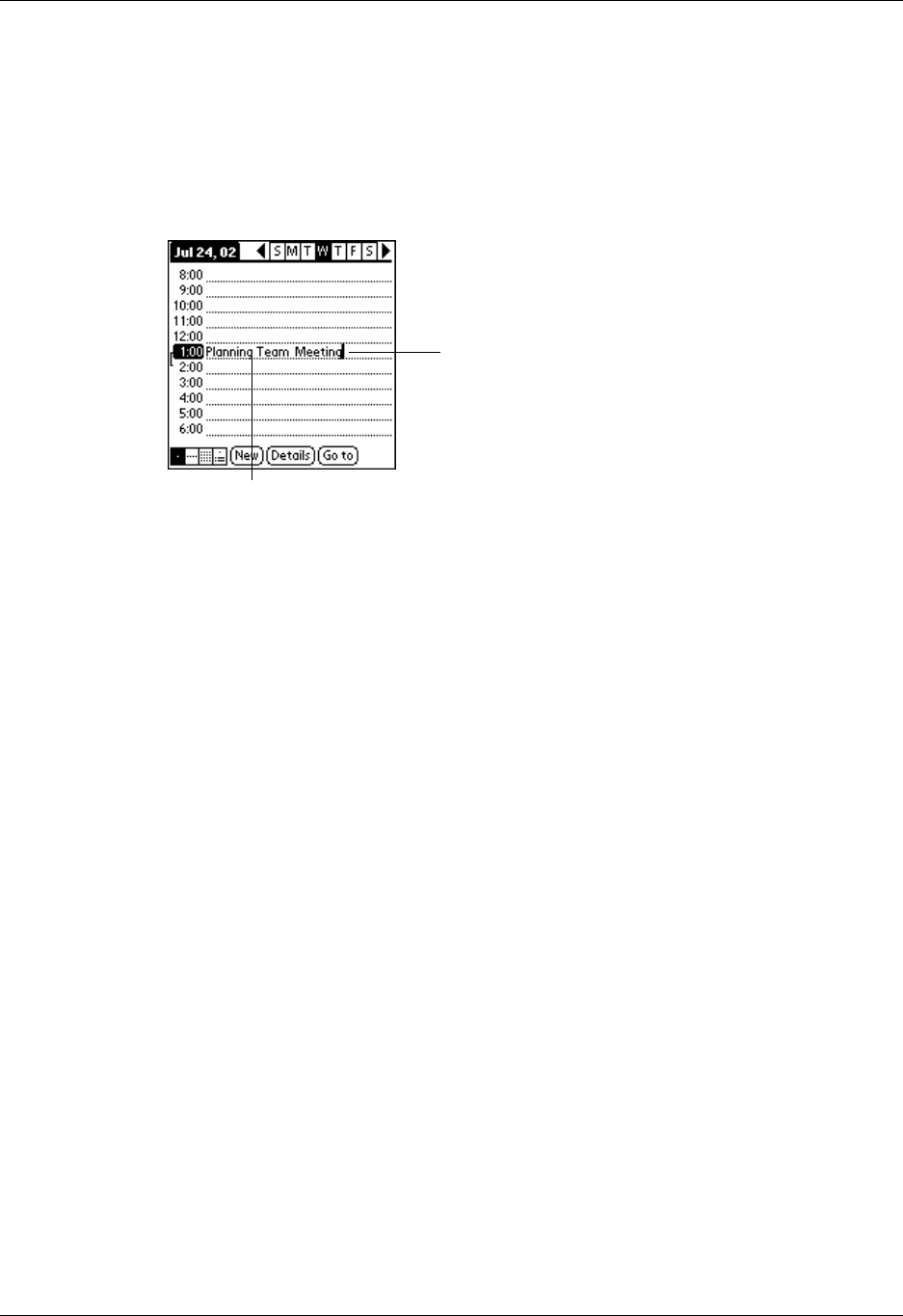
Chapter 4 Working with Applications
42
Editing records
After you create a record, you can change, delete, or enter new text at any time.
Two screen features tell you when your handheld is in editing mode:
■A blinking cursor
■One or more dotted edit lines
NOTE In Note Pad you can write anywhere on the screen. Therefore, you will
not see an edit line or blinking cursor unless the cursor is in the title line.
Entering text
For information on how to enter text using the keyboard on your handheld or the
keyboard attached to your computer, see Chapter 3. For information on entering
text in Note Pad, see Chapter 12.
Using the Edit menu
The Edit menu is available with any screen where you enter or edit text. In general,
commands available in the Edit menu apply to text that you select in an application.
To select text in an application:
1. Tap the beginning of the text that you want to select.
2. Drag the stylus over the text to highlight it (in yellow).
NOTE You can also double-tap to select a word, or triple-tap to select a line of
text. You can also drag across the text to select additional words, or drag down
to select a group of lines.
Edit line
Blinking cursor
Palm, Inc. Confidential

Performing common tasks
43
The following commands may appear in an Edit menu:
Deleting records
To delete a record using the menu command:
1. Select the record you want to delete.
2. Press Command Stroke + D.
To delete a record using the Menu:
1. Select the record you want to delete.
2. Press Function + Menu .
3. Select Record, and then select one of the following Delete commands:
Date Book: Delete Event
Address Book: Delete Address
To Do List: Delete Item
Note Pad: Delete Note
Memo Pad: Delete Memo
Expense: Delete Item
Undo Reverses the action of the last edit command. For example, if you
used Cut to remove text, Undo restores the text you removed. Undo
also reverses deletions you made using the backspace.
Cut Removes the selected text and stores it temporarily in the memory
of your handheld. You can paste the text you cut into another area
of the current application or into a different application.
Copy Copies the selected text and stores it temporarily in the memory of
your handheld. You can paste the copied text into another area of
the current application or into a different application.
Paste Inserts the cut or copied text at the selected point in a record. The
text you paste replaces any selected text. If you did not previously
cut or copy text, Paste does nothing.
Select All Selects all the text in the current record or screen. This enables you
to cut or copy all of the text and paste it elsewhere.
Keyboard Opens the onscreen keyboard. After you finish with the onscreen
keyboard, press Function + Enter , or tap Done.
Palm, Inc. Confidential

Chapter 4 Working with Applications
44
A confirmation dialog box appears. If you want to save a copy of the deleted
item to an archive file in Palm™ Desktop software, be sure that the check box is
selected. If you don’t want to save a copy, tap the check box to deselect it.
4. Press Function + Enter , or tap OK.
If you choose to save a copy of the selected item, your handheld transfers it to the
archive file on your desktop the next time you perform a HotSync operation. (The
archive option is not available in Note Pad.)
Other ways to delete records
You can also delete records in the following ways:
■Delete the text of the record.
■In Date Book, Address Book, To Do List, and Memo Pad, open the Details dialog
box for the record, tap Delete, and then press Function + Enter , or tap
OK.
NOTE When deleting a repeating event in Date Book, you can choose to delete
the current repeating event, current and future events, or all instances of that
event.
■In Note Pad, open the note you want to delete, and then tap Delete.
Purging records
Over time, as you use Date Book, To Do List, and Expense, you’ll accumulate
records that have outlived their usefulness. For example, events that occurred
months ago remain in the Date Book, and To Do List items that you marked as
completed remain in the list, as do Expense items.
All these outdated records take up memory on your handheld, so it’s a good idea
to remove them by using Purge. If you think Date Book or To Do List records might
prove useful later, you can purge them from your handheld and save them in an
archive file on your computer.
Purging is not available in Address Book, Note Pad, or Memo Pad; you must delete
outdated records manually from these applications.
To purge records:
1. Open the application.
2. Press Command Stroke + E.
Alternately, press Function + Menu , and then select Purge on the
Record menu.
A confirmation dialog box appears.
Date Book: Tap the pick list and select how old a record must be to be purged.
Purge deletes repeating events if the last of the series ends before the date that
you purge records.
Palm, Inc. Confidential

Performing common tasks
45
Date Book, To Do List: If you want to save a copy of the purged records to an
archive file on your desktop, be sure that the check box is selected. If you don’t
want to save a copy, tap the check box to deselect it.
Expense: Select the category you want to purge. All data in the selected category
will be purged and there is no archive option.
3. Press Function + Enter , or tap OK or Done.
If you chose to save a copy of the purged records, your handheld transfers them to
an archive file on your desktop the next time you perform a HotSync operation.
NOTE Purging does not happen automatically. You must select the command to
make it happen.
Categorizing records
You can categorize records in the Address Book, To Do List, Note Pad, Memo Pad,
and Expense applications so that they are grouped logically and are easy to review.
When you create a record, your handheld automatically places it in the category
that is currently displayed. If the category is All, your handheld assigns it to the
Unfiled category. You can leave an entry as Unfiled or assign it to a category at any
time.
By default, your handheld includes system-defined categories, such as All and
Unfiled, and user-defined categories, such as Business and Personal.
You cannot modify the system-defined categories, but you can rename and delete
the user-defined categories. In addition, you can create your own user-defined
categories. You can have a maximum of 15 user-defined categories in each
application.
When you have an expansion card properly seated in the expansion card slot, the
last item in the category pick list is the name of the expansion card. You cannot
otherwise categorize applications that reside on an expansion card.
Address Book contains the QuickList user-defined category, in which you can store
the names, addresses, and phone numbers you might need in emergencies (doctor,
fire department, lawyer, and so on).
Expense contains two user-defined categories, New York and Paris, to show how
you might sort your expenses according to different business trips.
The illustrations in this section come from Address Book, but you can use these
procedures in all the applications in which categories are available.
To move a record into a category:
1. Select the record you want to categorize.
2. In Address Book only: Tap Edit.
3. Tap De tail s.
Palm, Inc. Confidential
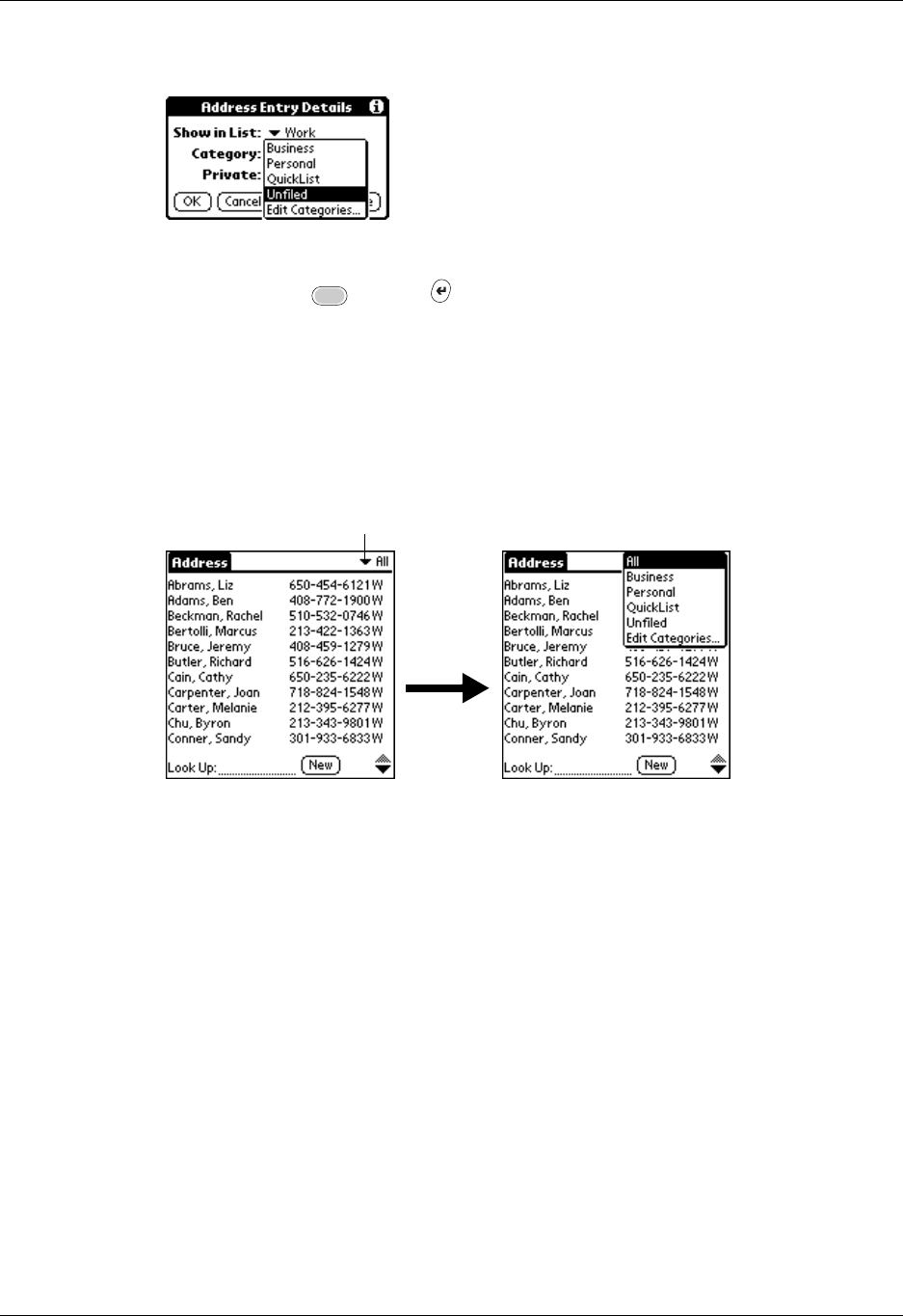
Chapter 4 Working with Applications
46
4. Tap the Category pick list to display the list of available categories.
5. Select the category for the record.
6. Press Function + Enter , or tap OK.
NOTE In Address Book, Note Pad, and Memo Pad you can select the category
name in the upper-right corner of the screen to assign the item to a different
category.
To display a category of records:
1. Tap the category pick list in the upper-right corner of the list screen.
NOTE In the Date Book Agenda view, the pick list is in the upper right of the To
Do list.
2. Select the category you want to view.
The list screen now displays only the records assigned to that category.
TIP Pressing an application button on your handheld scrolls through all the
categories of that application except for Unfiled. This feature is not available in
Date Book.
Tap here
Palm, Inc. Confidential

Performing common tasks
47
To define a new category:
1. Tap the category pick list in the upper-right corner of the screen or list.
2. Select Edit Categories.
3. Tap New.
4. Enter the name of the new category, and then press Function + Enter , or
tap OK.
5. Press Function + Enter , or tap OK.
You can assign any of your records to the new category.
Tap here
Palm, Inc. Confidential
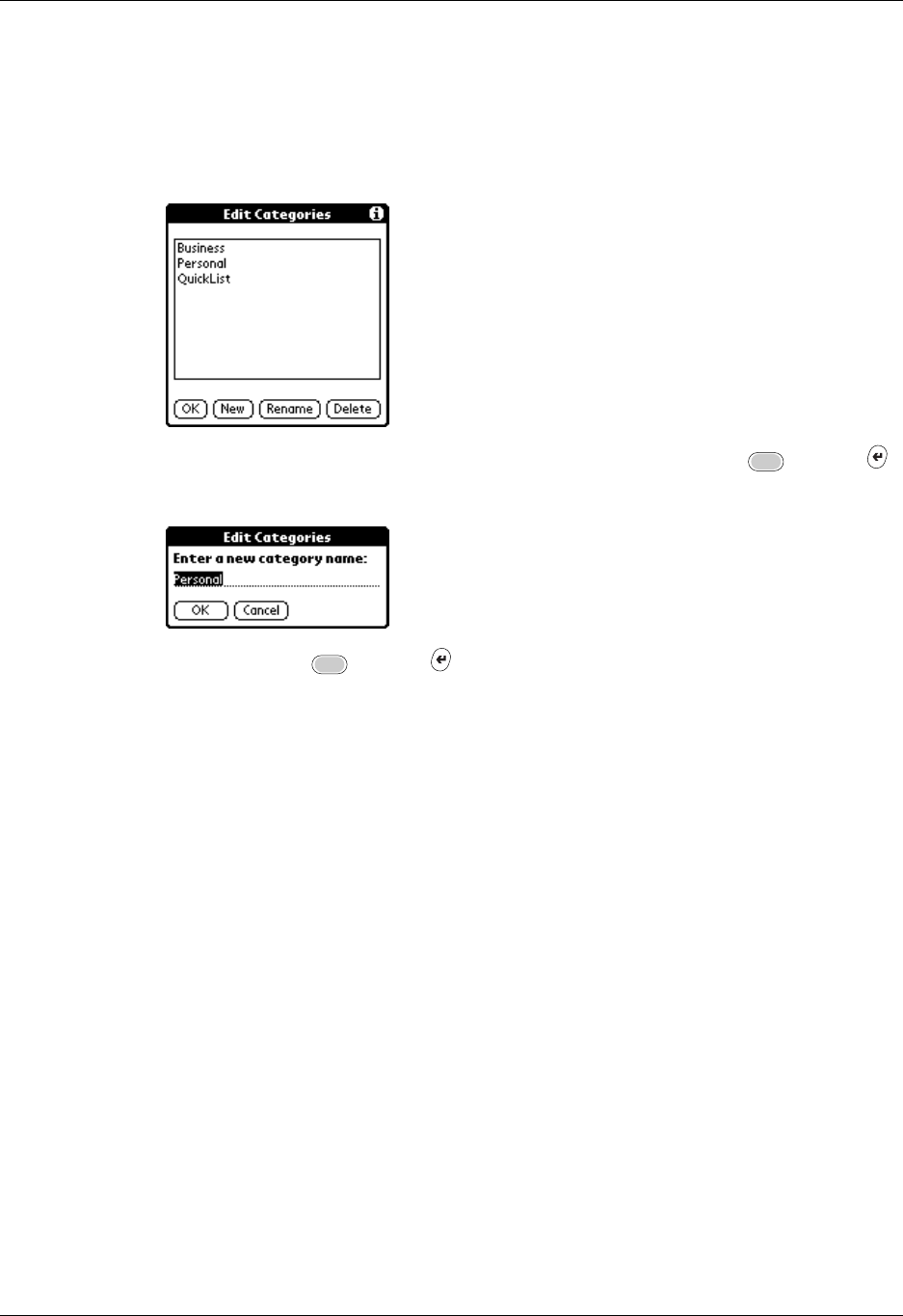
Chapter 4 Working with Applications
48
To rename a category:
1. Tap the category pick list in the upper-right corner of the screen or list.
2. Select Edit Categories.
3. Select the category that you want to rename, and then tap Rename.
4. Enter the new name for the category, and then press Function + Enter ,
or tap OK.
5. Press Function + Enter , or tap OK.
TIP You can group the records in two or more categories into one category by
giving the categories the same name. For example, if you change the name of
the Personal category to Business, all records formerly in the Personal
category appear in the Business category.
Finding information
Your handheld offers several ways to find information quickly:
■All applications that reside on your handheld: Find locates any text that you
specify, always starting with the current application. However, Find does not
search through applications on expansion cards.
■Date Book, To Do List, Memo Pad: Phone Lookup displays the Address list
screen and enables you to add to a record the information that appears in this
list.
■Address Book: The Look Up line enables you to scroll immediately to a name
when you enter the first letters of that name.
■Expense: Lookup displays the names in your Address Book that have data in the
Company field. You can add these names to a list of attendees associated with
an Expense record.
Palm, Inc. Confidential
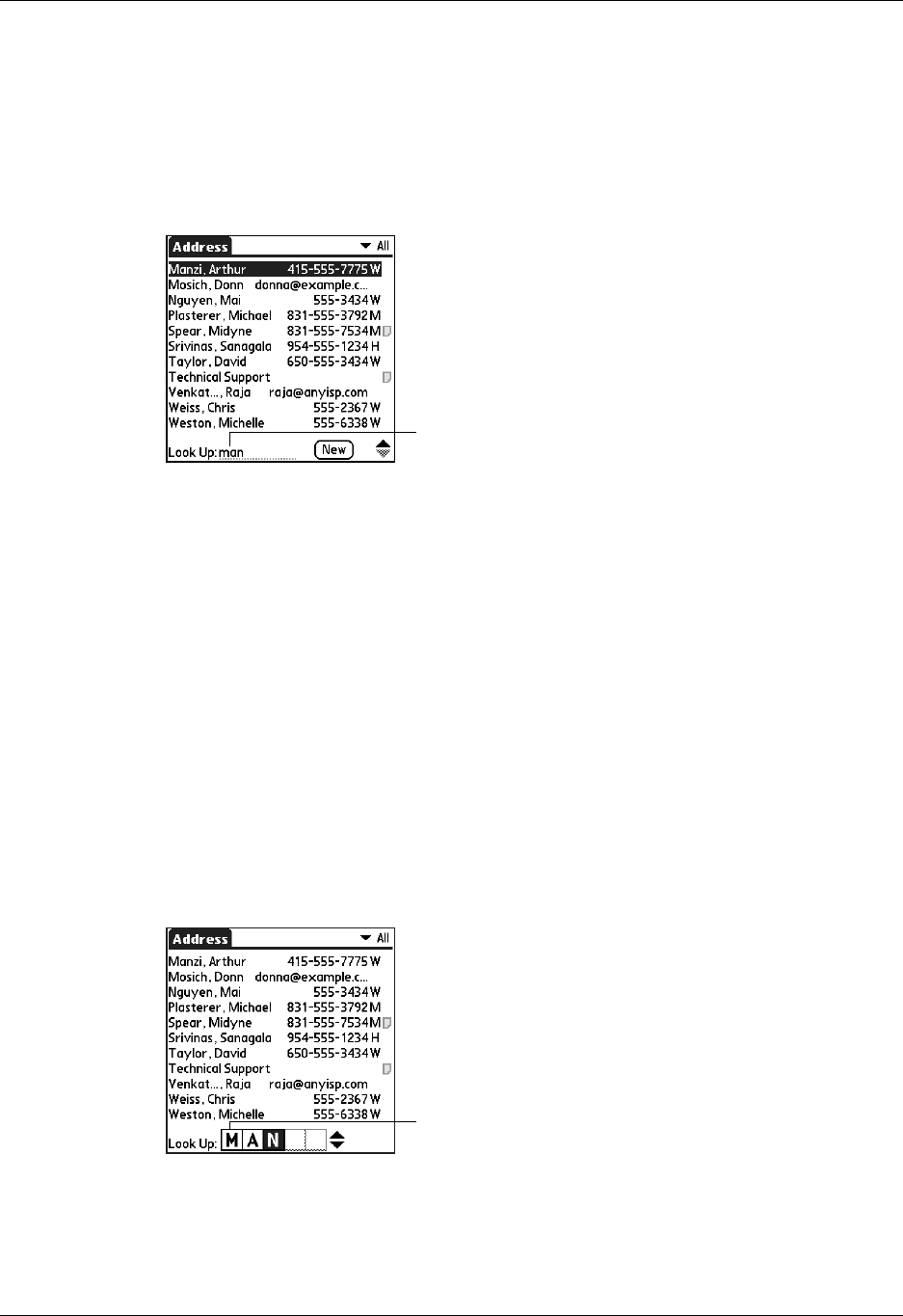
Performing common tasks
49
Looking up Address Book records
In Address Book, you can use the Look Up line with the stylus or the navigator to
look up and quickly scroll to any of your Address Book entries.
To look up an Address Book record with the stylus:
1. From the Address list screen, enter the first letter of the name you want to find.
The list scrolls to the first entry that begins with that letter. If you write another
letter, the list scrolls to the first entry that starts with those two letters. For
example, writing an s scrolls to “Sands,” and writing sm scrolls further to
“Smith.” If you sort the list by company name, the Look Up feature scrolls to the
first letter of the company name.
2. Tap the record to view its contents.
To look up an Address Book record with the navigator:
1. From the Address List screen, press Right on the navigator to display the
navigator Quick Look Up line.
2. Press Up or Down on the navigator to select the first letter of the name you want
to find.
The list scrolls to the first entry that begins with that letter.
3. Press Right on the navigator to move to the next letter box.
The Quick Look Up line displays only letters that are a possible match for that
position.
Look Up line
Quick Look Up line
Palm, Inc. Confidential

Chapter 4 Working with Applications
50
If only one match is possible for a particular position, the highlight jumps to the
next position.
4. Press Up or Down on the navigator to select the next letter of the name you want
to find.
The list then scrolls to the first entry that starts with those two letters. For
example, selecting s scrolls to “Sands,” and selecting sm scrolls further to
“Smith.” If you sort the list by company name, the Quick Look Up feature
scrolls to the matches for the company name.
5. Repeat steps 3 and 4 until the entry you want appears in the list.
6. Press Select on the navigator to highlight the record you want.
7. Press Select on the navigator to view the contents of the selected record.
TIP If only one match is possible for the letters you selected, the contents of
the record displays automatically.
Using Find
You can use Find to locate any text that you specify, in any application that resides
on your handheld. Find does not search applications that reside on an expansion
card.
To use Find:
1. Press Function + Find .
TIP If you select text in an application before you tap Find, the selected text
automatically appears in the Find dialog box.
2. Enter the text that you want to find.
Find is not case-sensitive. For example, searching for the name “davidson” also
finds “Davidson.”
Find locates any words that begin with the text you enter. For example,
searching for “plane” finds “planet” but not “airplane.”
3. Press Function + Enter , or tap OK.
Find searches for the text in all records and all notes.
Palm, Inc. Confidential
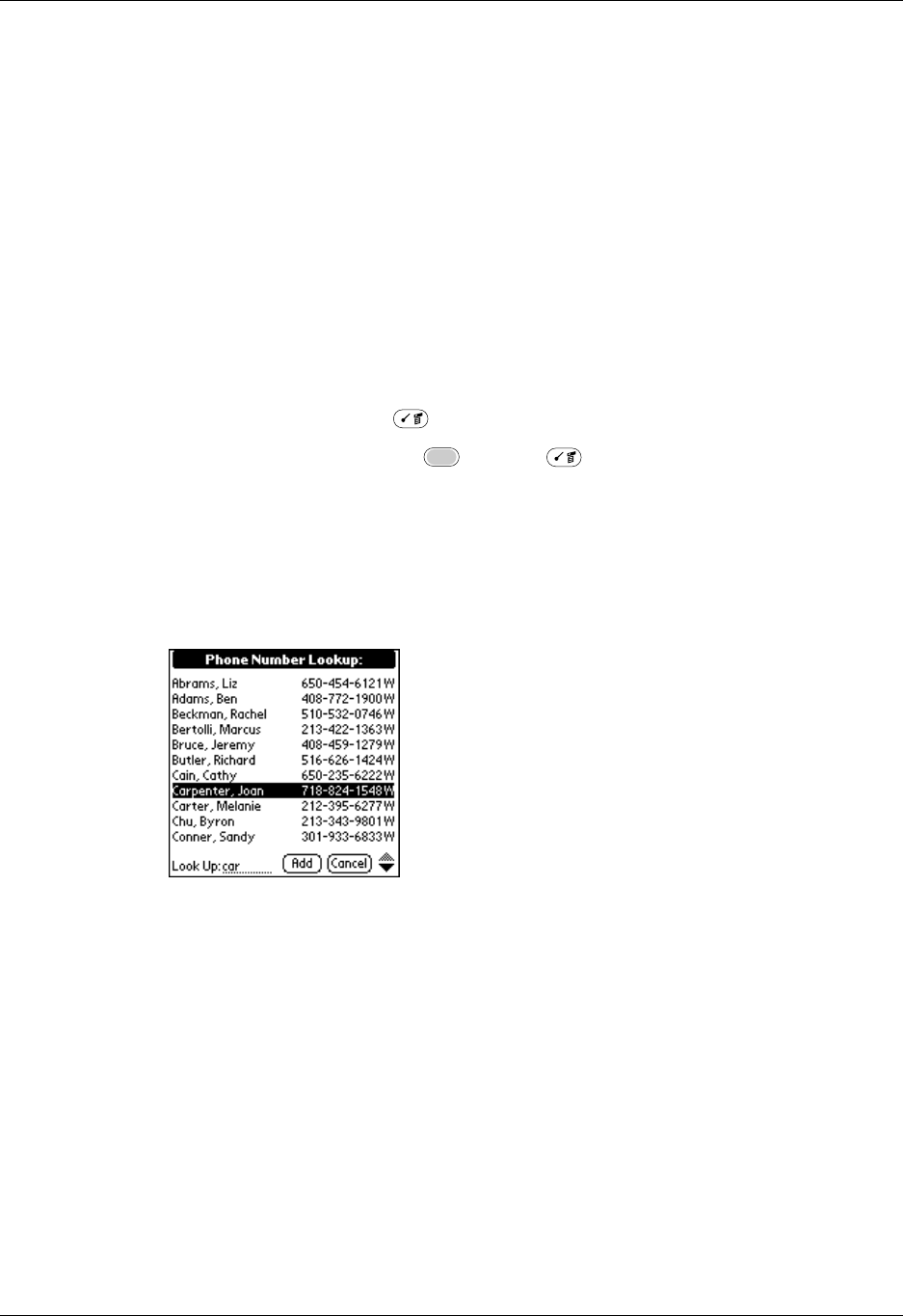
Performing common tasks
51
As your handheld searches for the text, you can tap Stop at any time. You may
want to do this if the entry you want appears before your handheld finishes the
search. To continue the search after you tap Stop, tap Find More.
4. Tap the text that you want to review.
Using Phone Lookup
Phone Lookup displays the Address list screen and enables you to add the
information that appears in this list to a record.
To use Phone Lookup:
1. Display the record in which you want to insert a phone number. The record can
be in Date Book, To Do List, Memo Pad, or any other application that takes
advantage of this feature.
2. Press Command Stroke + L.
Alternately, press Function + Menu and then select Phone Lookup on
the Options menu.
3. Begin to spell the last name of the name you want to find.
The list scrolls to the first record in the list that starts with the first letter you
enter. Continue to spell the name you’re looking for, or when you see the name,
tap it.
4. Tap Add.
The name you selected, along with the other information associated with it, is
pasted into the record you selected in step 1.
Palm, Inc. Confidential
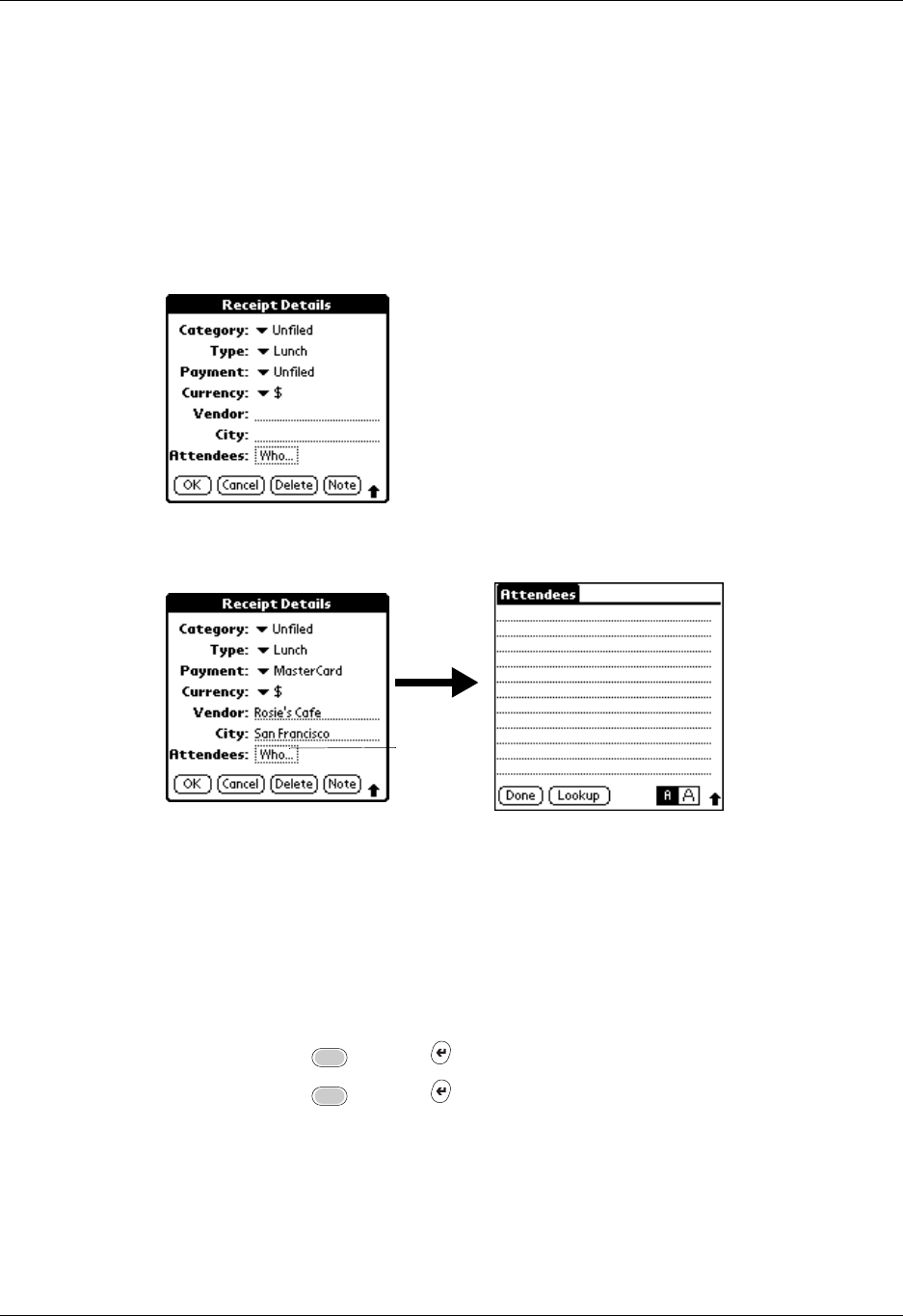
Chapter 4 Working with Applications
52
Looking up names to add to Expense records
In Expense, Lookup displays the names in your Address Book that have data in the
Company field. You can add these names to a list of attendees associated with an
Expense record.
To add names to an Expense record:
1. Tap the Expense record to which you want to add names.
2. Tap De tail s.
3. Tap Who.
4. Tap Lookup.
The Attendees Lookup screen displays all the names in your Address Book that
have data in the Company field.
5. Select the name you want to add, and then tap Add.
The name appears in the Attendees screen.
6. Repeat steps 4 and 5 to add more names.
7. Press Function + Enter , or tap Done.
8. Press Function + Enter , or tap OK.
Tap here
Palm, Inc. Confidential

Performing common tasks
53
Sorting lists of records
You can sort lists of records in various ways, depending on the application. Sorting
is available in applications that have list screens: Address Book, Note Pad, To Do
List, Memo Pad, and Expense.
NOTE You can also assign records to categories. See “Categorizing records” earlier
in this chapter.
To sort records in Address Book, Note Pad, and Memo Pad:
1. Open the application to display the list screen.
2. Press Command Stroke + R.
Alternately, press Function + Menu , and then select Preferences on the
Options menu.
3. Do one of the following:
Address Book: Tap the setting you want.
Note Pad: Tap the Sort by pick list and select Alphabetic, Date, or Manual.
Memo Pad: Tap the Sort by pick list and select Alphabetic or Manual.
4. Press Function + Enter , or tap OK.
To sort the Note Pad and Memo list manually, tap and drag a note or memo to
a new location in the list.
To make the list appear in Palm Desktop software as you manually sorted it on
your handheld, open the application in Palm Desktop software and click Sort
by. Then select Order on Handheld.
Address Book
Note Pad
Memo Pad
Palm, Inc. Confidential

Chapter 4 Working with Applications
54
To sort records in To Do List and Expense:
1. Open the application to display the list screen.
2. Tap Show.
3. Tap the Sort by pick list and select an option.
4. Press Function + Enter , or tap OK.
Attaching notes
In Address Book, Date Book, To Do List, and Expense, you can attach a note to a
record. A note can be up to several thousand characters long. For example, for an
appointment in Date Book, you can attach a note with directions to the location.
To attach a note to a record:
1. Display the entry to which you want to add a note.
To display an entry, tap it or press Up or Down on the navigator to highlight it,
and then press Select on the navigator.
2. In Address Book only: Tap Edit.
3. Tap De tail s.
4. Tap Note.
5. Enter your note.
6. Press Function + Enter , or tap Done.
A small note icon appears at the right side of any item that has a note.
To review or edit a note:
■Tap the Note icon .
TIP In Date Book, you can also select the event that contains the note, press Select
on the navigator to open the note, and then press Select on the navigator again to
close the note.
To delete a note:
1. Tap the Note icon .
2. Tap Delete.
3. Press Function + Enter , or tap Yes.
Note icon
Palm, Inc. Confidential

Performing common tasks
55
Choosing fonts
In many applications, you can change the font style to make text easier to read. You
can choose small, small bold, large, or large bold fonts in each application that
enables you to change font style.
To change the font style:
1. Open an application.
2. Press Command Stroke + F.
Alternately, press Function + Menu , and then select Font on the
Options menu.
3. Tap the font style you want to use.
4. Press Function + Enter , or tap OK.
Small font
Large font
Small bold font
Large bold font
Tap here for
small font
Tap here for small bold font
Tap here for large bold font
Tap here for large font
Palm, Inc. Confidential
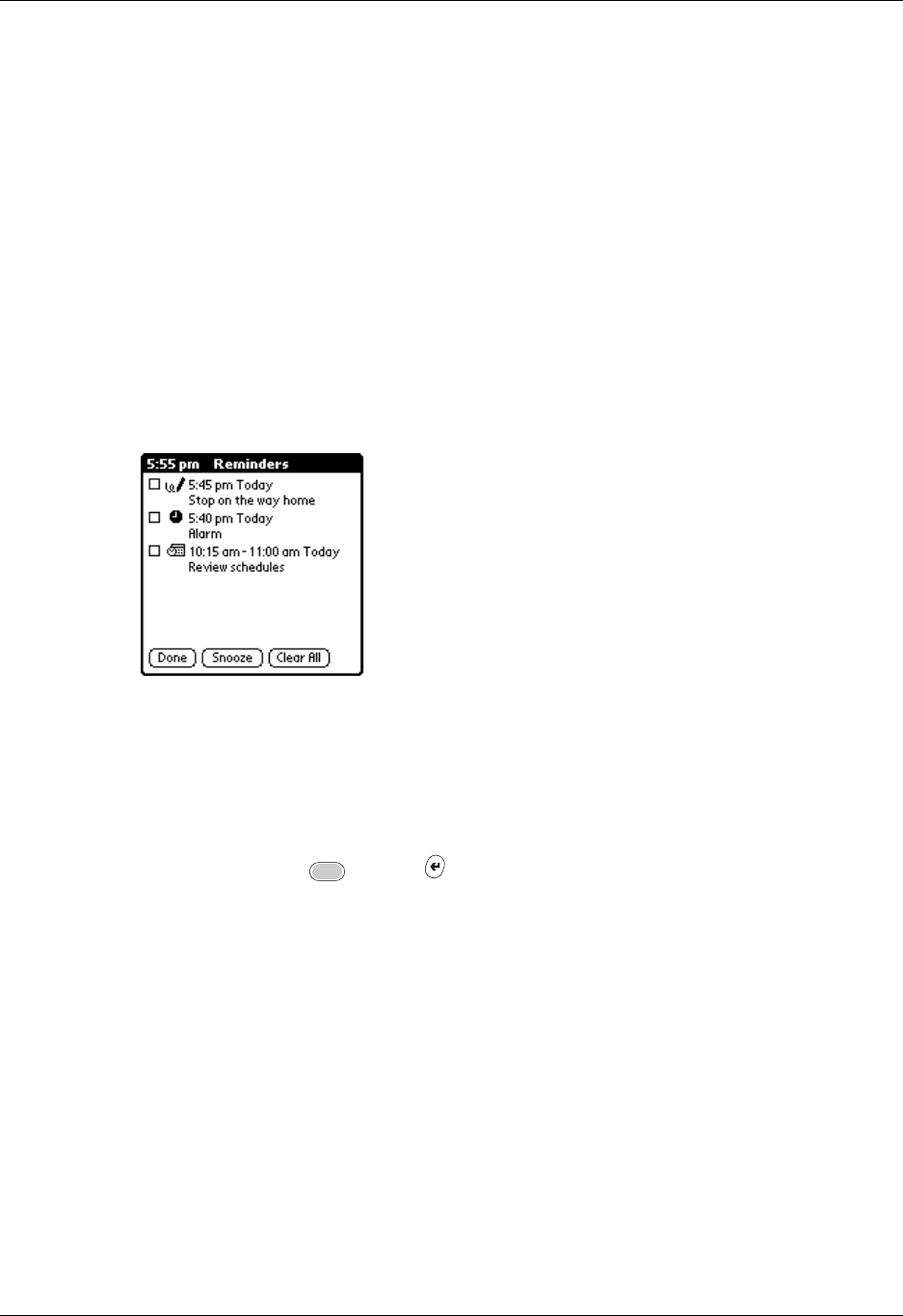
Chapter 4 Working with Applications
56
Receiving alerts
You can receive alerts on your handheld and in Palm Desktop software.
Receiving alerts on your handheld
When you use certain application settings, your handheld can alert you to any of
the following:
■An appointment set in Date Book
■A note created in Note Pad
■An alarm set in World Clock
When an alert occurs, your handheld displays a reminder message. If you tap
Snooze in response to an alert message, your handheld reminds you of the item
again in five minutes. The Reminder screen displays alerts that await attention.
To respond to alerts, do one of the following:
■Select an item’s check box to clear the item.
■Tap an item (either the icon or the text description) to open the application
where the alarm was set. The application opens to the entry associated with the
alarm.
■Press Function + Enter , or tap Done to close the reminder list and return
to the current screen. An attention indicator blinks in the upper-left corner of
the screen; tap it to view the alert list again.
■Tap Snooze to see the list again in five minutes.
If you tap Done or Snooze and view the reminder list later, the current time is
displayed in the Reminder bar and the original alert time is displayed with each
list item.
■Tap Clear All to dismiss all alerts in the list.
Palm, Inc. Confidential

Installing and removing applications
57
Receiving alerts from Palm Desktop software
You can also set an option to receive Date Book event alerts from Palm Desktop
software. The feature is disabled by default, so you must enable it within Palm
Desktop software.
To enable an event alert from Palm Desktop software:
1. Double-click the Palm Desktop icon.
2. From the Tools menu, select Options, and then select Alarms.
3. Set Alarm Configuration options, either Always Available or Available only
when the Palm Desktop is running.
4. (Optional) To hear an alert sound as well as receive an alert message, select the
check box Play audible notification with alarm dialog.
5. Click OK.
Hiding or masking private records
You can use the Security preferences to set a password and select whether to mask
your private records or hide them completely. See “Security preferences” in
Chapter 21 for details.
Installing and removing applications
This section explains how to install and remove applications on your handheld or
on an expansion card, and how to remove Palm Desktop software from your
computer.
Installing add-on applications
Your handheld comes with applications installed and ready to use, but you can
also install additional applications, such as games and other software, on your
handheld or on a card that is seated in the expansion card slot. Applications or
games that you install on your handheld reside in RAM memory, and you can
delete them at any time.
The Install Tool makes it easy to install software during a HotSync operation. There
are a variety of third-party applications available for your handheld. To learn more
about these applications, go to the web site: www.palm.com/support/intl.
To install add-on software on your handheld using a Windows computer:
1. On your computer, copy or download the application you want to install into
the add-on folder in your Palm Desktop directory on your computer.
2. Double-click the Palm Desktop icon on your desktop.
3. Click Install.
Palm, Inc. Confidential

Chapter 4 Working with Applications
58
TIP You can also access the Install Tool dialog by selecting Install Tool from
the Palm Desktop program group or by double-clicking any file with a PRC,
PDB, PQA, PNC, or SCP file extension.
4. In the User drop-down list, select the name that corresponds to your handheld.
5. Click Add.
6. Select the applications that you want to install.
7. Click Open.
8. If you need to change the destination of the application you are installing, click
Change Destination in the Install Tool window, and then use the arrows to
move applications between your handheld and an expansion card.
Palm, Inc. Confidential

Installing and removing applications
59
9. Click OK to close the Change Destination window.
10. Click Done to close the Install Tool window.
11. Perform a HotSync operation to install the selected applications.
See “Performing a cradle/cable HotSync operation: Windows computer” in
Chapter 20 for details.
NOTE Files that remain in the list after you perform a HotSync operation were
not installed. This can happen if the file type was not recognized during the
HotSync operation. Expansion cards may hold applications that use files other
than the PalmTM application files. For your handheld to recognize such a file,
you must launch the application at least once.
To install add-on software on your handheld using a Mac computer:
1. On your Mac computer, copy or download the application you want to install
into the Add-on folder in your Palm folder.
2. Double-click the HotSync Manager icon in the Palm folder.
3. From the HotSync menu, select Install Handheld Files.
4. From the User pop-up menu, select the name that corresponds to your
handheld.
5. Click Add To List.
Palm, Inc. Confidential
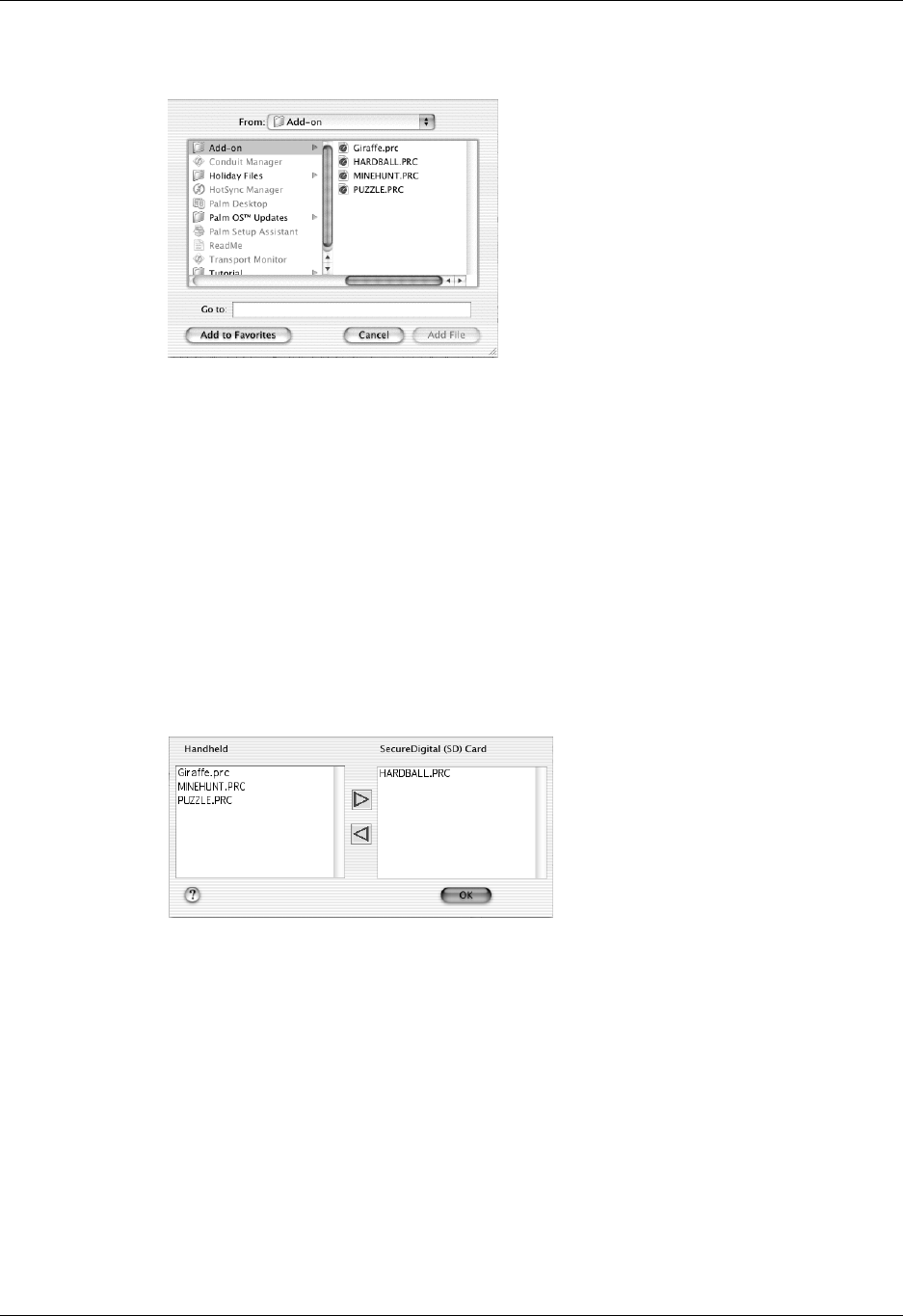
Chapter 4 Working with Applications
60
6. Select the Add-on folder.
If the file you want to install is not listed in the dialog box, go to the folder to
which you copied the file. Most Palm application files have the extension PRC,
PDB, PQA, or SCP.
7. Select the applications you want to install.
8. Click Add File to add the selected application to the Install Handheld Files list.
TIP You can also drag files or folders of files to the list in the Install Handheld
Files dialog box. The files are copied to the Files To Install folder.
9. If you need to change the destination of the application you are installing, click
Change Destination the Install Handheld Files window, and then use the
arrows to move applications between your handheld and an expansion card.
10. Click OK to close the Change Destination window.
11. Close the Install Handheld Files window.
12. Perform a HotSync operation to install the selected applications on your
handheld. See “Performing cradle/cable HotSync operations” in Chapter 20 for
details.
NOTE Files that remain in the list after you perform a HotSync operation were
not installed. This can happen if the file type was not recognized during the
HotSync operation. Expansion cards may hold applications that use files other
than the Palm application files. In order for your handheld to recognize such a
file, you must launch the application at least once.
Palm, Inc. Confidential
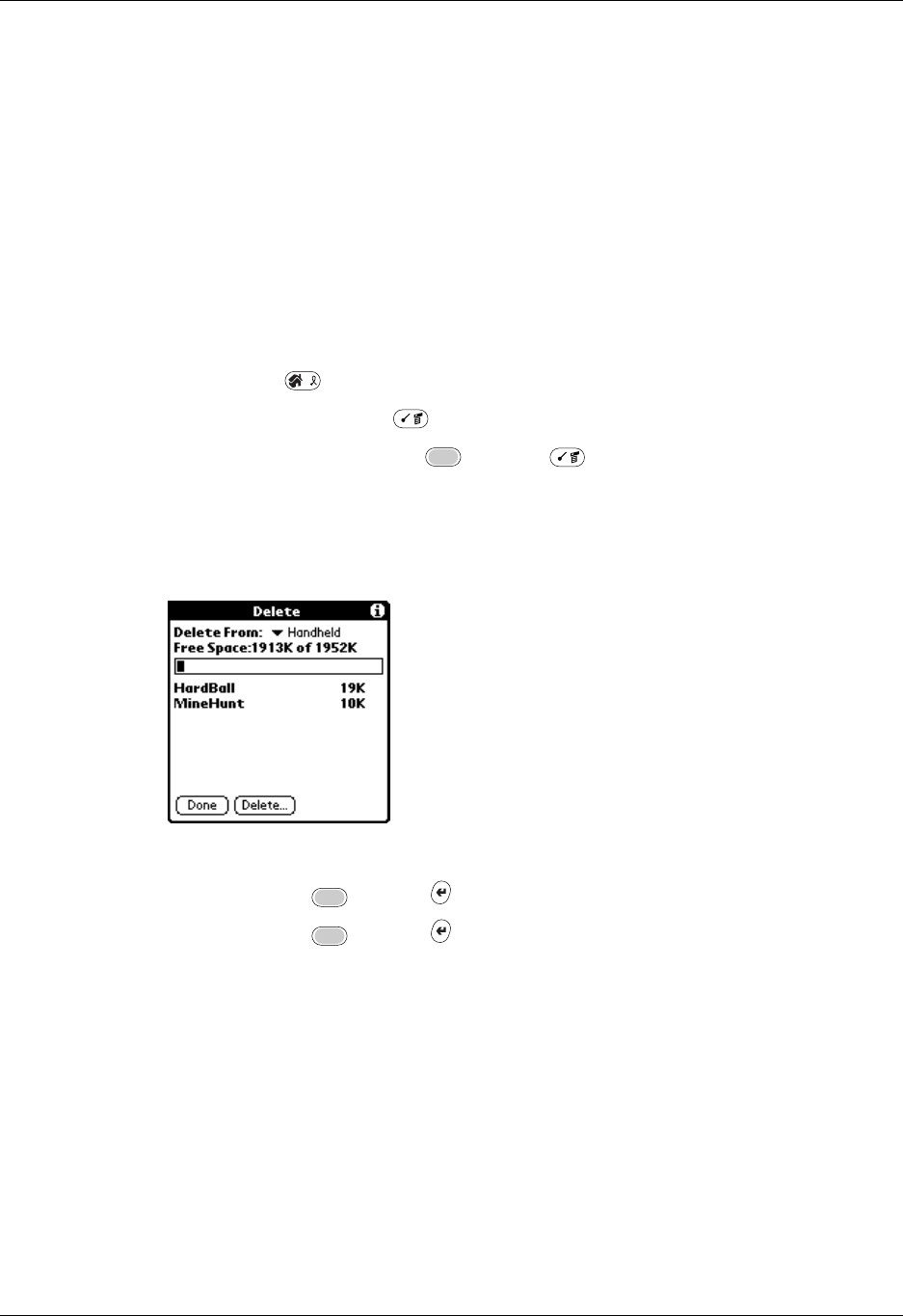
Installing and removing applications
61
Removing applications
If you run out of memory or decide that you no longer need an application you
installed, you can remove applications from your handheld or from an expansion
card. From your handheld, you can remove only add-on applications, patches, and
extensions that you install; you cannot remove the applications that reside in the
ROM portion of your handheld.
NOTE If you have backed up your applications during a HotSync operation, you also
need to delete them from your computer. Otherwise, they are reinstalled at the next
HotSync operation.
To remove an add-on application:
1. Press Home .
2. Press Command Stroke + D.
Alternately, press Function + Menu , select Delete on the App menu.
3. Tap the Delete From pick list and select either Handheld or Card. To delete
applications from a card, the card must be seated in the expansion card slot.
4. Tap the application that you want to remove.
5. Tap Delete.
6. Press Function + Enter , or tap Yes.
7. Press Function + Enter , or tap Done.
Removing Palm Desktop software
If you no longer want to use Palm Desktop software, you can remove it from your
computer.
To remove Palm Desktop software from a Windows computer:
1. From the Windows Start menu, select Settings and then Control Panel.
2. Double-click the Add/Remove Programs icon.
3. Click the Change or Remove Programs button.
4. Select Palm Desktop.
Palm, Inc. Confidential

Chapter 4 Working with Applications
62
5. Click Change/Remove.
6. Click Yes in the Confirm File Deletion box.
7. Click OK.
8. Click Close.
NOTE You need to install the HotSync Manager from the installation CD if you want
to synchronize data with another PIM.
To remove Palm Desktop software from a Mac computer:
1. Locate the Palm Desktop Installer icon and double-click.
The Palm Desktop Installer icon is on the Palm Desktop CD or in the installer
that you downloaded.
2. Select Uninstall from the pop-up menu.
3. Select the software you want to remove.
4. Click Uninstall.
5. Select the folder that contains your Palm Desktop software files.
6. Click Remove.
NOTE This process removes only the application files. The data in your Users
folder remains untouched.
7. Restart your computer.
Palm, Inc. Confidential
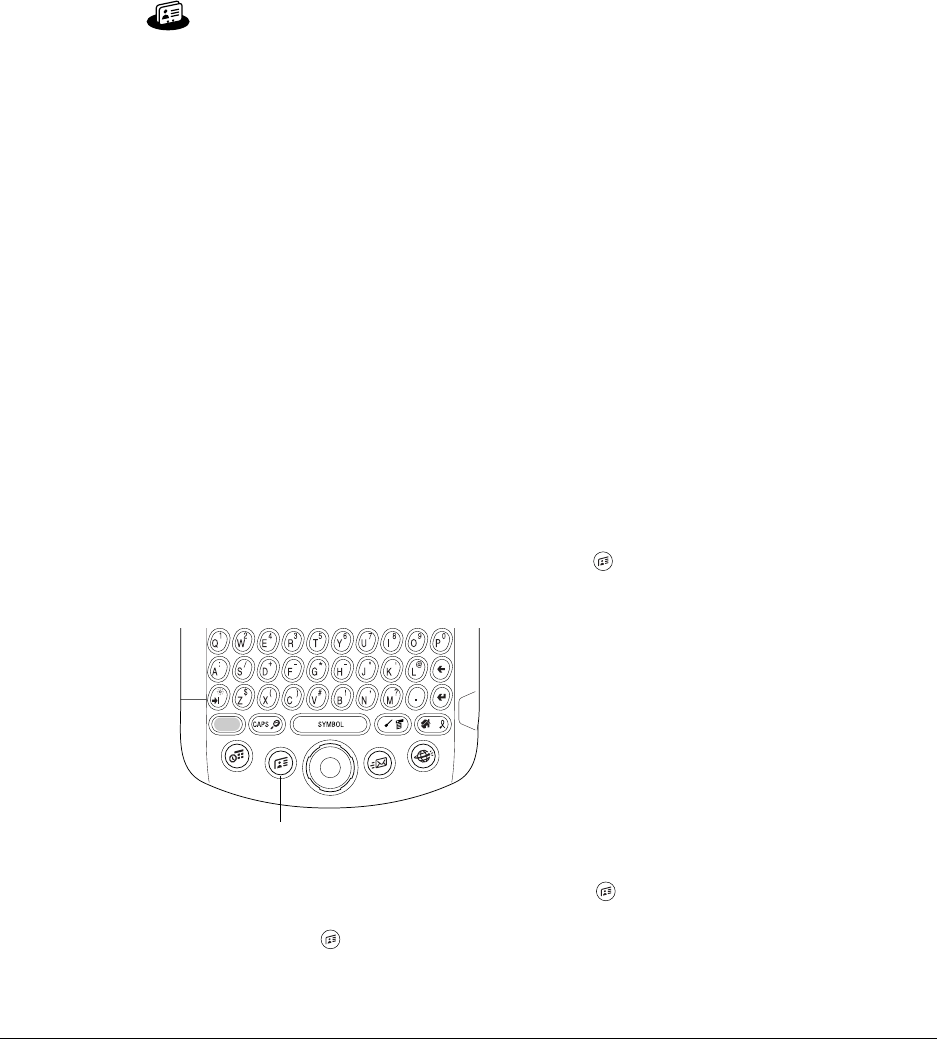
63
CHAPTER 5
Using Address Book
Address Book enables you to keep names, addresses, phone numbers, and
other information about your personal or business contacts. Use Address
Book to do the following:
■Quickly look up or enter names, addresses, phone numbers, and other
information.
■Enter up to five phone numbers (home, work, fax, mobile, and so on) or e-mail
addresses for each name.
■Define which phone number appears in the Address list for each Address Book
entry.
■Attach a note to each Address Book entry, in which you can enter additional
information about the entry.
■Assign Address Book entries to categories so that you can organize and view
them in logical groups.
■Create your own digital business card that you can beam using SMS or e-mail
to other devices with an infrared (IR) port and an application that can read the
data.
To open Address Book:
■Press the Address Book application button on the front panel of your
handheld. Address Book opens to display the list of all your records.
TIP Press the Address Book application button repeatedly to cycle through the
categories in which you have records. You can also press and hold the Address Book
application button to instantly beam your business card to another device with an
IR port. The receiving device must also have an application that can read the Address
Book data.
Address Book button
Palm, Inc. Confidential
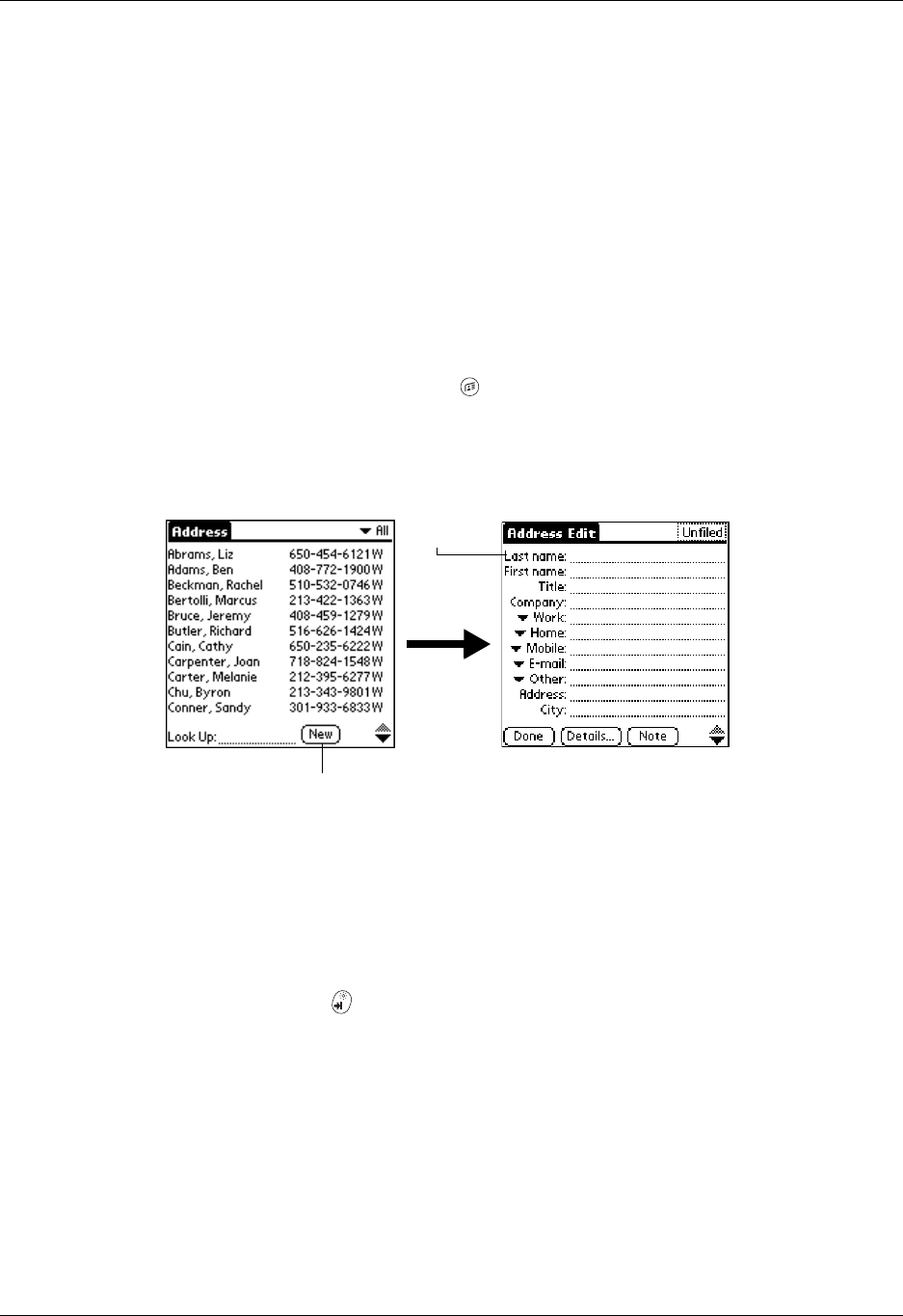
Chapter 5 Using Address Book
64
Creating an Address Book entry
A record in Address Book is called an entry. You can create entries on your
handheld, or you can use Palm™ Desktop software to create entries on your
computer and then transfer the entries to your handheld with your next HotSync®
operation.
Palm Desktop software also has data import capabilities so that you can load
database files into Address Book on your handheld.
See “Importing data” in Chapter 3 and Palm Desktop online Help for more
information.
To create a new Address Book entry:
1. Press the Address Book button on the front of your handheld to display the
Address list.
2. Tap New.
3. Enter the last name of the person you want to add to your Address Book.
The handheld automatically capitalizes the first letter of each field (except
numeric and e-mail fields). You do not have to use the CAPS key to capitalize
the first letter of the name.
4. Tap the First Name field.
TIP Pressing Tab moves the cursor to the next field.
5. Enter the first name of the person in the First Name field.
6. Enter the other information that you want to include in this entry.
As you enter letters in the Title, Company, City, and State fields, text appears for
the first logical match that exists in your Address Book. As you enter more
letters, a closer match appears. For example, you may already have Sacramento
and San Francisco in your Address Book. As you enter S, Sacramento appears,
and as you continue entering a and n San Francisco replaces Sacramento. As
soon as the word you want appears, tap the next field to accept the word.
Ta p N e w
Cursor
at Last
name
Palm, Inc. Confidential
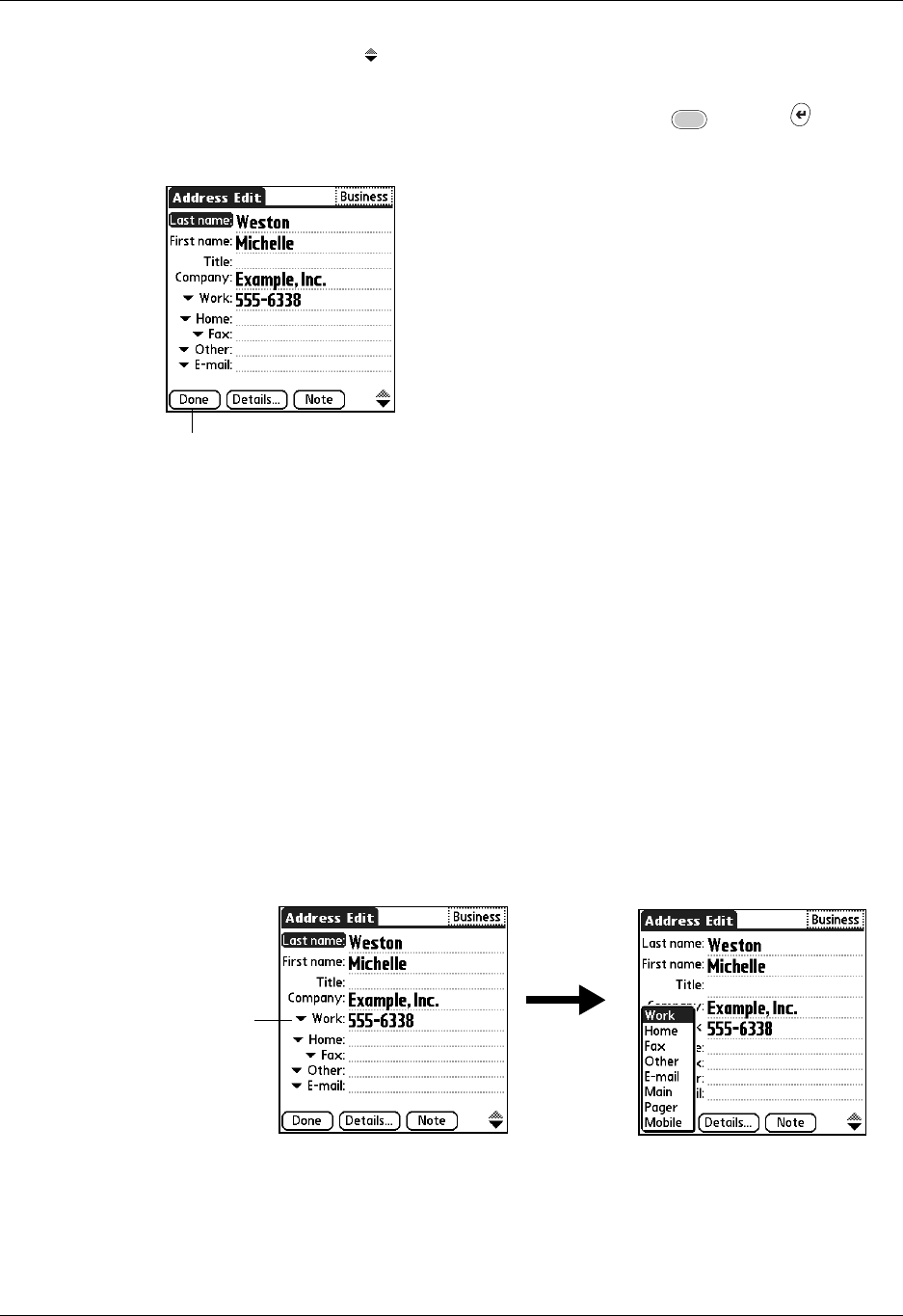
Selecting types of phone numbers
65
7. Tap the scroll arrows or press Up/Down on the navigator to move to the next
page of information.
8. After you finish entering information, Press Function + Enter , or tap
Done.
TIP To create an entry that always appears at the top of the Address list, begin the
Last name or Company field with a symbol, as in *If Found Call*. This entry can
contain contact information in case you lose your handheld.
Selecting types of phone numbers
You can select the types of phone numbers or e-mail addresses that you associate
with an Address Book entry. Any changes you make apply only to the current
entry.
To select other types of phone numbers in an entry:
1. Tap the entry that you want to change.
2. Tap Edit.
3. Tap the pick list next to the label you want to change.
4. Select a new label.
Tap Done
Ta p
triangle
Palm, Inc. Confidential

Chapter 5 Using Address Book
66
Changing Address Entry details
The Address Entry Details dialog box provides a variety of options that you can
associate with an entry.
To open the Address Entry Details dialog box:
1. Tap the entry whose details you want to change.
2. Tap Edit.
3. Tap De tail s.
4. Select any of the following settings:
Making connections from Address Book
You can use the entries in your Address Book to launch applications that perform
tasks such as dialing a phone number or creating an e-mail or SMS message. Some
of the applications you can launch are included with your handheld, and others
may be available from third-party developers and are sold separately.
Quick Connect
You can use Quick Connect to select an entry and initiate a related task with one
hand using the navigator. You can also configure which application opens when
you choose a specific Address record field, and whether to add a prefix to all phone
numbers.
Show in List Select which type of phone or other information appears in
the Address list screen. Your options are Work, Home, Fax,
Other, E-mail, Main, Pager, and Mobile. The identifying
letters W, H, F, O, M, or P appear next to the record in the
Address list, depending on which information is displayed.
If you select E-mail, no identifying letter is displayed.
Category Assign the entry to a category.
Private Hide this entry when Security is turned on.
Palm, Inc. Confidential

Making connections from Address Book
67
To make a connection with Quick Connect:
1. Open the Address entry to which you want to connect.
2. Press Right on the navigator to open the Quick Connect dialog box.
TIP You can also tap the Quick Connect icon in the title bar of the Address
record.
3. Select the method you want to use to connect.
Quick Connect opens and initiates the related task. For example, if you tap a
phone number, Quick Connect sends the selected phone number to your mobile
phone.
To configure Quick Connect settings:
1. From the Quick Connect dialog box, tap Settings.
2. (Optional) Tap the Number Prefix check box and enter a prefix.
For example, to dial 1 before all phone numbers, select this check box and enter
a “1” in this field. The prefix is not added to a number that begins with the “+”
character.
3. Tap each of the pick lists and select the application you want to associate with
that task.
4. Press Function + Enter , or tap OK.
Palm, Inc. Confidential
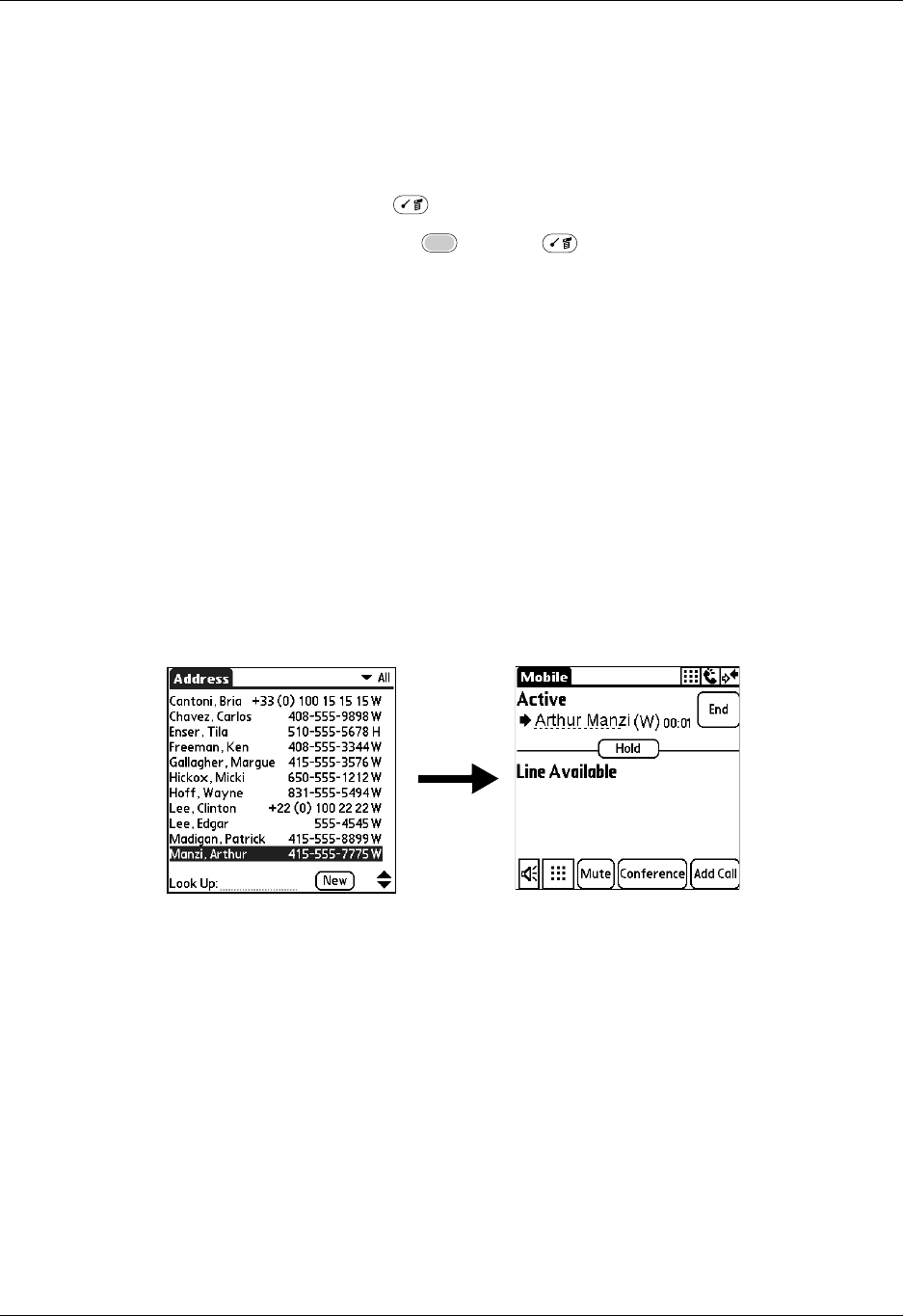
Chapter 5 Using Address Book
68
Tap-to-Connect
Tap-to-Connect enables you to select an entry and initiate a related task by tapping
it with the stylus. By default, Tap-to-Connect is enabled.
To enable Tap-to-Connect:
1. Press Command Stroke + R.
Alternately, press Function + Menu , and then select Preferences on the
Options menu.
2. Tap Enable Tap-to-Connect.
3. Tap OK .
TIP You can also configure which application opens when you tap a specific Address
record field, and whether to add a prefix to all phone numbers. See “Quick Connect”
earlier in this chapter to learn how to configure these settings.
To make a connection with Tap-to-Connect:
1. From the Address list, tap the entry to which you want to connect.
2. Tap the item you want to launch in Mobile.
For example, to dial a phone number, tap the number you want to dial. To
address an e-mail message, tap an e-mail address.
Palm, Inc. Confidential
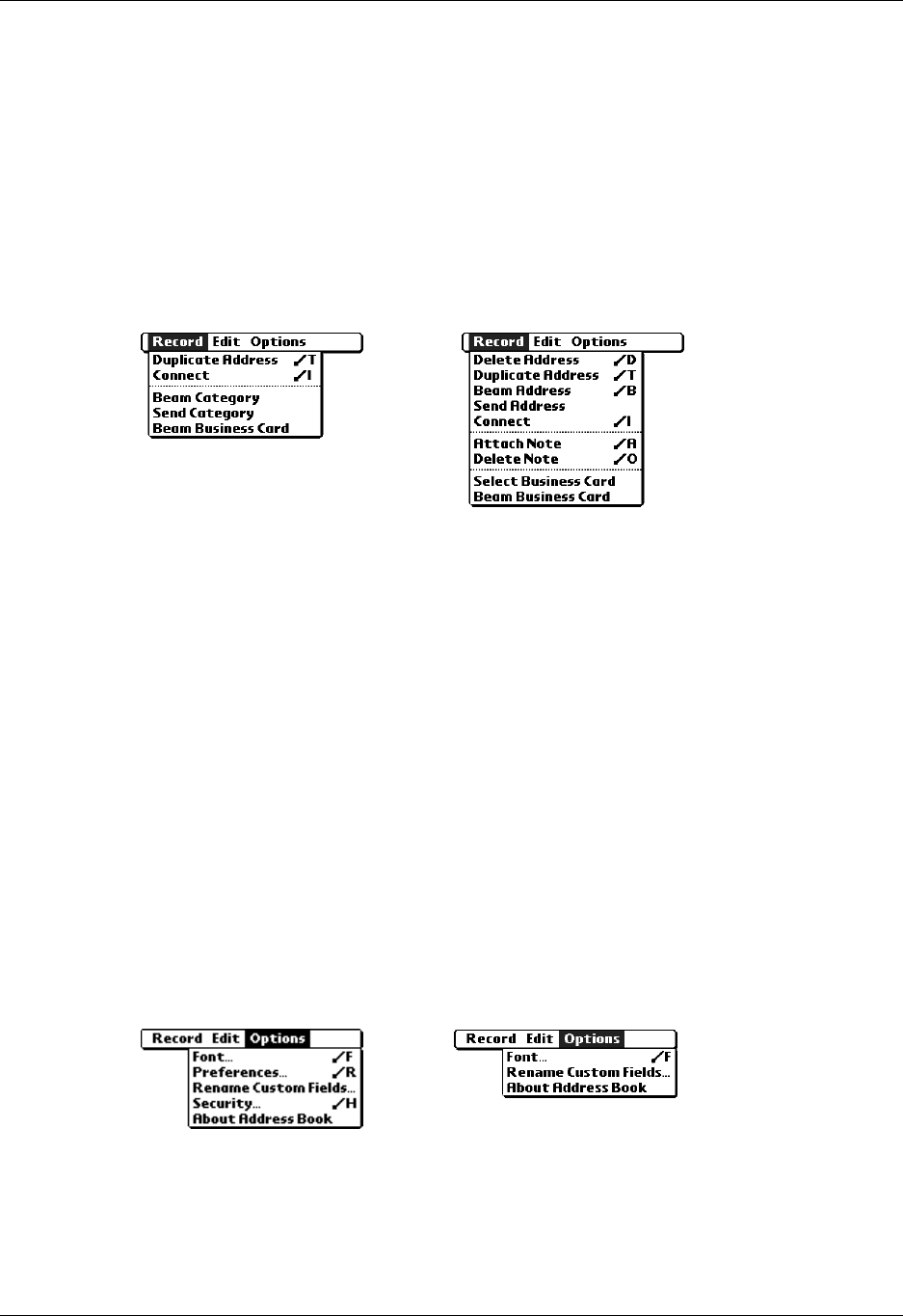
Address Book menus
69
Address Book menus
Address Book menus are shown here for your reference, and Address Book
features that are not explained elsewhere in this book are described here.
See “Using menus” in Chapter 4 for information about selecting menu commands.
The Record and Options menus may differ, depending on whether you’re
displaying the Address list screen or the Address view screen.
Record menus
Options menus
Duplicate
Address Makes a copy of the current record and displays the copy in
Address Edit so you can make changes to the copied record. The
copy has the same category and attached notes as the original
record.
Connect Opens the Quick Connect dialog box where you can select which
application to use to make the connection.
Send Category Opens a dialog box where you can select how to send all records
in the selected category to another device. The options available
depend on the software installed on your handheld.
Send Address Opens a dialog box where you can select how to send the
selected entry to another device. The options available depend
on the software installed on your handheld.
Address list
Address view
Address list
Address view
Palm, Inc. Confidential
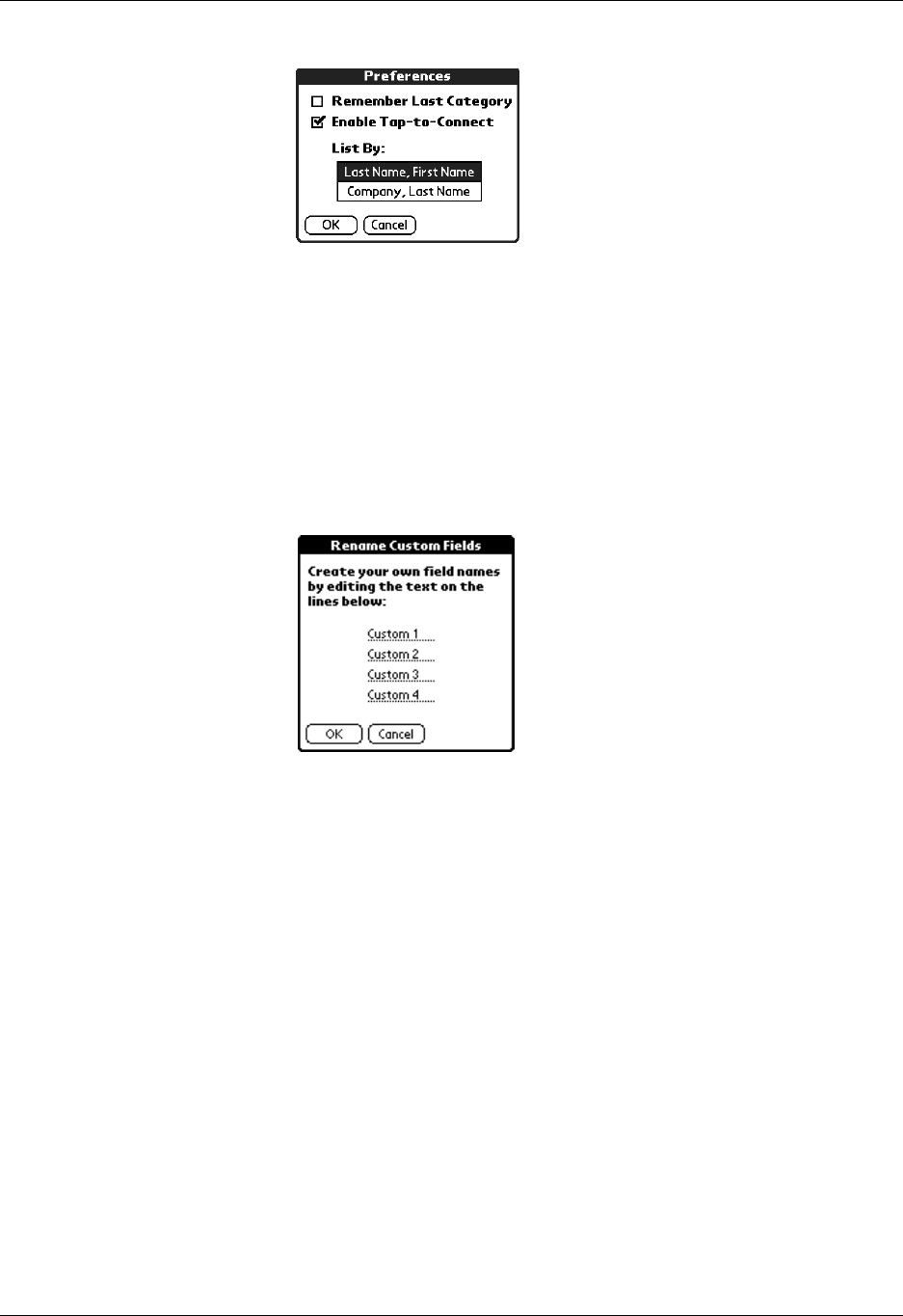
Chapter 5 Using Address Book
70
Preferences
Remember last category: Determines how Address Book
appears when you return to it from another application. If
you select this check box, Address Book shows the last
category you selected. If you clear it, Address Book
displays the All category.
Rename Custom
Fields Fields that appear at the end of the Address Edit screen.
Rename them to identify the kind of information you enter
in them. The names you give the custom fields appear in
all entries.
About Address
Book Shows version information for Address Book.
Palm, Inc. Confidential
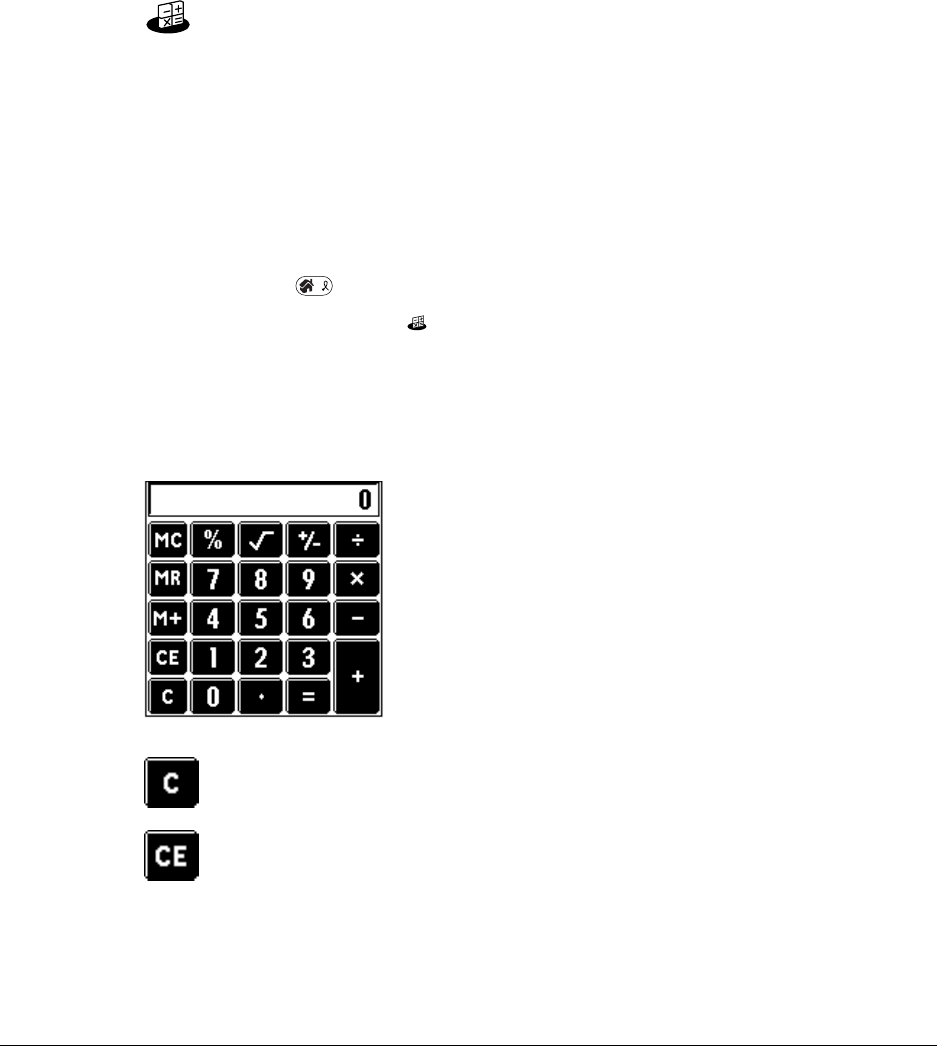
71
CHAPTER 6
Using Calculator
Calculator enables you to perform basic calculations. Use Calculator to do
the following:
■Perform addition, subtraction, multiplication, division, and square root
operations.
■Store and retrieve values.
■Display the last series of calculations, which is useful for confirming a series of
“chain” calculations.
To open Calculator:
1. Press Home .
2. Tap the Calculator icon .
Performing calculations
The Calculator includes several buttons to help you perform calculations.
Clears the entire calculation so that you can begin a fresh
calculation.
Clears the last number you entered. If you make a mistake while
entering a number in the middle of a calculation, you can use this
button to reenter the number without starting the calculation over.
Palm, Inc. Confidential

Chapter 6 Using Calculator
72
Viewing recent calculations
The Recent Calculations command enables you to review the last series of
calculations and is particularly useful for confirming a series of “chain”
calculations.
To display recent calculations:
1. Press Command Stroke + l.
Alternately, press Function + Menu , and then select Recent
Calculations on the Options menu.
2. After you finish reviewing the calculations, press Function + Enter , or
tap OK.
Toggles the current number between a negative and positive value.
If you want to enter a negative number, enter the number first and
then press the +/- button.
Places the current number in memory. Each new number you enter
with the M+ button is added to the total already stored in memory.
The number that you add can be either a calculated value or any
number you enter by pressing the number buttons. Pressing this
button has no effect on the current calculation (or series of
calculations); it merely places the value into memory until it is
recalled.
Recalls the stored value from memory and inserts it into the current
calculation.
Clears any value that is stored in the Calculator memory.
Calculates the square root of a number. Enter the number, and then
tap the square root button.
Palm, Inc. Confidential

Using Calculator menus
73
Using Calculator menus
The Calculator menu shown here is for your reference, and the Calculator feature
described here is not explained elsewhere in this book.
See “Using menus” in Chapter 4 for information about choosing menu commands.
Options menu
About Calculator Shows version information for Calculator.
Palm, Inc. Confidential

Chapter 6 Using Calculator
74
Palm, Inc. Confidential
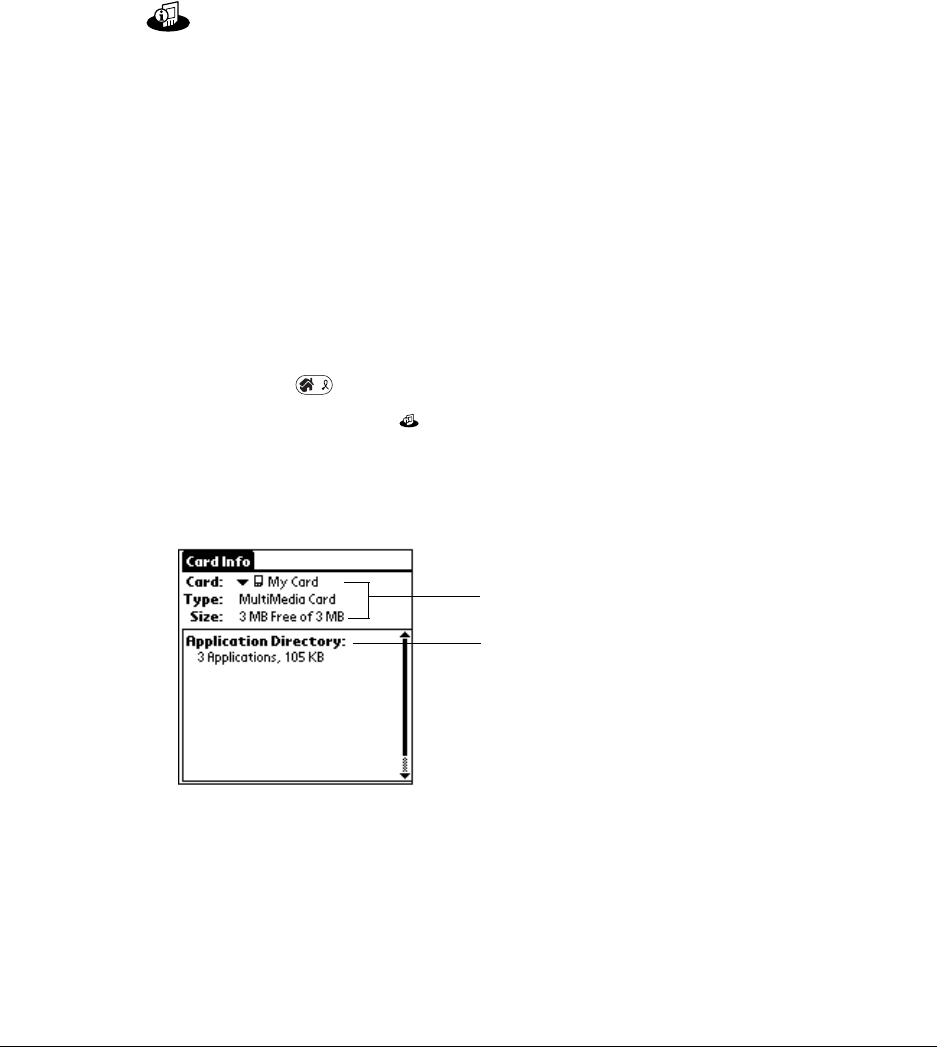
75
CHAPTER 7
Using Card Info
Card Info enables you to review general information about an expansion
card. Use Card Info to do the following:
■Review card contents.
■Rename a card.
■Format a card.
Reviewing Card Information
You can view the card name, type, available storage space, and a summary of its
contents.
To review Card Information:
1. Press Home .
2. Tap the Card Info icon .
3. Review Card name, Type, and Size.
4. Review card contents summarized by directory.
Review card information
Review summarized
card contents
Palm, Inc. Confidential

Chapter 7 Using Card Info
76
Renaming a card
Renaming a card enables you to give an easy to recognize name to the card.
To rename a card:
1. Press Home .
2. Tap the Card Info icon .
3. Press Command Stroke + R.
Alternately, press Function + Menu , and then select Rename Card on
the Card menu.
4. Enter the new name for the card.
5. Tap Rename .
Formatting a card
Formatting a card destroys all its data and prepares it to accept new applications
and data.
To format a card:
1. Press Home .
2. Tap the Card Info icon .
3. Press Command Stroke + F.
Alternately, press Function + Menu , and then select Format Card on
the Card menu.
4. Press Function + Enter , or tap OK.
Palm, Inc. Confidential
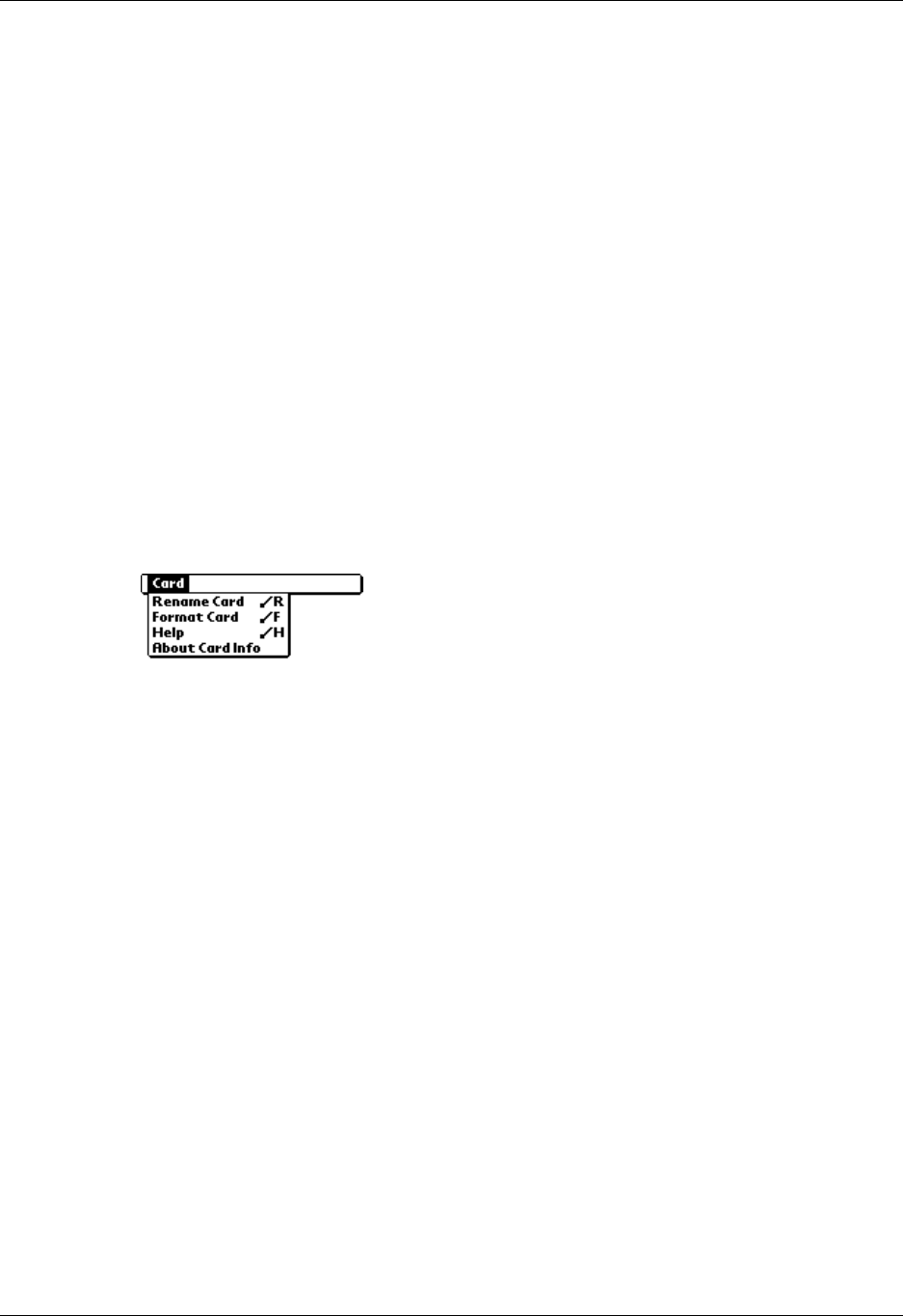
Managing an expansion card
77
Managing an expansion card
■When writing data to an expansion card, wait for your handheld to complete
the operation before removing the card from the slot. This prevents data
corruption or accidental damage to the expansion card.
■You can install applications to an expansion card after performing an initial
HotSync® operation. See “Installing add-on applications” in Chapter 4 for
information. For optimal performance, we recommend that you do not install
more than fifty applications to a single expansion card.
■When your handheld’s battery level becomes very low, access to the expansion
card may be disabled to protect your data. If this occurs, recharge your
handheld as soon as possible.
Using the Card Info menu
The Card Info menu is shown here for your reference, and the Card Info features
that are not explained elsewhere in this book are described here.
See “Using menus” in Chapter 4 for information about choosing menu commands.
Help Provides help text.
About Card Info Shows version information for Card Info.
Palm, Inc. Confidential

Chapter 7 Using Card Info
78
Palm, Inc. Confidential
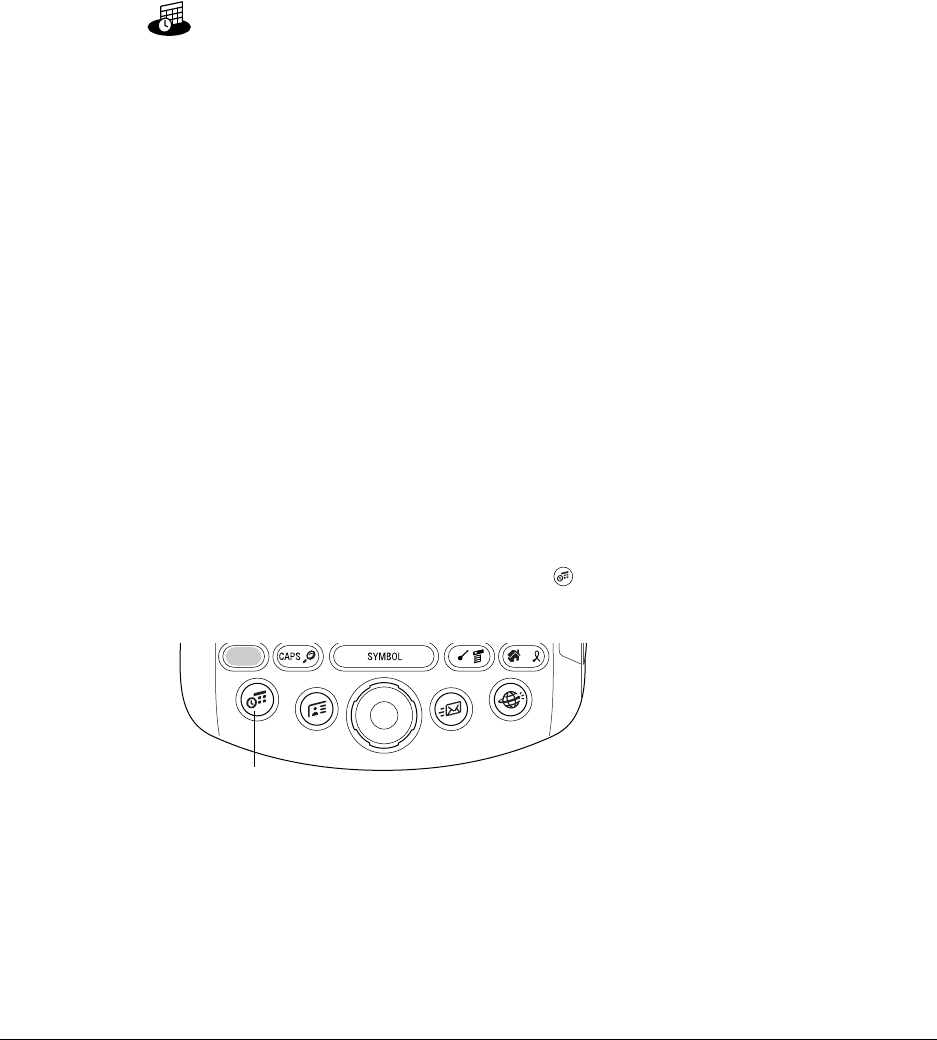
79
CHAPTER 8
Using Date Book
Date Book enables you to quickly and easily schedule appointments or any
kind of activity associated with a time and date. Use Date Book to do the
following:
■Enter a description of your appointment and assign it to a specific time and
date.
■Display a chart of your appointments for an entire week. The Week view makes
it easy to spot available times and potential scheduling overlaps or conflicts.
■Display a monthly calendar to quickly spot days where you have morning,
lunch, or afternoon appointments.
■Display an agenda showing appointments, untimed events, and your To Do
items for the day.
■Set an alarm to notify you of the scheduled activity.
■Create reminders for events that are based on a particular date, rather than time
of day. Birthdays and anniversaries are easy to track with your handheld.
■Attach notes to individual events for a description or clarification of the entry
in your Date Book.
To open Date Book:
■Press the Date Book application button on the front panel of your handheld.
Date Book opens to today’s schedule.
TIP Press the Date Book application button repeatedly to cycle through the
Day, Week, Month, and Agenda views.
When you open Date Book, the screen shows the current date and a list of times for
a normal business day.
Date Book button
Palm, Inc. Confidential

Chapter 8 Using Date Book
80
Scheduling an event
A record in Date Book is called an “event.” An event can be any kind of activity
that you associate with a day. You can enter a new event on any of the available
time lines.
When you schedule an event, its description appears on the time line, and its
duration is automatically set to one hour. You can easily change the start time and
duration for any event.
It’s possible to schedule events that overlap, but Date Book makes it easy to find
such conflicts. See “Spotting event conflicts” later in this chapter.
You can also schedule events in your Date Book that occur on a particular date but
have no specific start or end times, such as birthdays, holidays, and anniversaries.
These are referred to as “untimed events.” Untimed events appear at the top of the
list of times, marked with a diamond. You can have more than one untimed event
on a particular date.
You can also schedule a repeating event, such as a weekly meeting, and continuous
events, such as a three-day conference or a vacation.
To schedule an event for the current day:
1. Tap the time line that corresponds to the beginning of the event.
2. Enter a description of the event. You can enter up to 255 characters.
3. If the event is one hour long, skip to step 5. If the event is longer or shorter than
an hour, tap the time of the event to open the Set Time dialog box.
Ta p a
time line
Enter event
Time bar
shows
duration
Ta p t h e
time of an
event
Palm, Inc. Confidential

Scheduling an event
81
4. Do one of the following:
– Tap the time columns on the right side of the Set Time dialog to set the Start
Time, and then tap the End Time box and tap the time columns to set the End
Time.
– Tap All Day to automatically insert the start and end time of the event as
defined in your Date Book preferences.
5. Press Function + Enter , or tap OK.
6. Tap a blank area of the screen to deselect the event. A vertical line appears next
to the time, indicating the duration of the event.
If an event has the same start and end time, the time is displayed only once.
To schedule an event for another day:
1. Select the date you want for the event by doing one of the following:
– Tap the day of the week that you want in the date bar at the top of the screen.
If necessary, tap the Previous week or Next week scroll arrows to move to
another week.
– Press Right or Left on the navigator to scroll to the next or previous day.
Start Time
highlighted
Tap to scroll to
earlier hours
Tap to scroll to
later hours
Tap to change
hours
Tap to change
minutes
Tap to automatically
fill the start and end
times
Previous
week
Next
week
Tap to select a day of
the current week
Palm, Inc. Confidential

Chapter 8 Using Date Book
82
– Press Up or Down on the navigator to scroll within the current day.
– Tap Go To at the bottom of the screen to open the Go to Date dialog box.
Select a date by tapping a year, month, and day in the calendar.
2. After you locate the date, follow the steps for scheduling an event for the
current day.
To schedule an untimed event:
1. Select the date that you want for the event.
2. Tap New.
3. Tap No Time, so that no start or end times are defined for the new event.
4. Enter a description of the event.
5. Tap a blank area on the screen to deselect the untimed event.
Previous year Next year
Tap to select
current date
Tap to select a
month
Tap to select a
day
No time
selected
New
untimed
event
Palm, Inc. Confidential

Selecting an event
83
If you create an event and decide later that there is no particular start or end time,
you can easily change it to an untimed event. Tap the time of the event in the Date
Book screen, tap No Time, and then press Function + Enter , or tap OK.
Selecting an event
After you create an event, you can select an event to view its contents, reschedule
it, make it a repeating event, and add alarms or notes.
To select an event:
1. Go to the day on which the event is scheduled.
2. Tap the event.
TIP You can also press Select on the navigator to insert the highlight on the
next event in the current day or on the first event of another day. To scroll
through the events in the selected day, press Up and Down on the navigator.
Rescheduling an event
You can easily make changes to your schedule with your handheld.
To reschedule an event:
1. Select the event you want to reschedule.
2. Tap De tail s.
3. To change the time, tap the Time box and select a new time.
4. To change the date, tap the Date box and select a new date.
5. Press Function + Enter , or tap OK.
Setting an alarm for an event
The Alarm setting enables you to set an alarm for events in your Date Book. You
can set an alarm to notify you minutes, hours, or days before an event. The default
Alarm setting is five minutes before the time of the event, but you can change the
Alarm to any number of minutes, hours, or days.
When you set an alarm, this icon appears to the far right of the event with the
alarm. When the alarm occurs, a reminder message also appears onscreen.
To set an alarm for an event:
1. Select the event to which you want to assign an alarm.
2. Tap De tail s.
3. Tap the Alarm check box to select it.
The default setting, 5 Minutes, appears.
Palm, Inc. Confidential
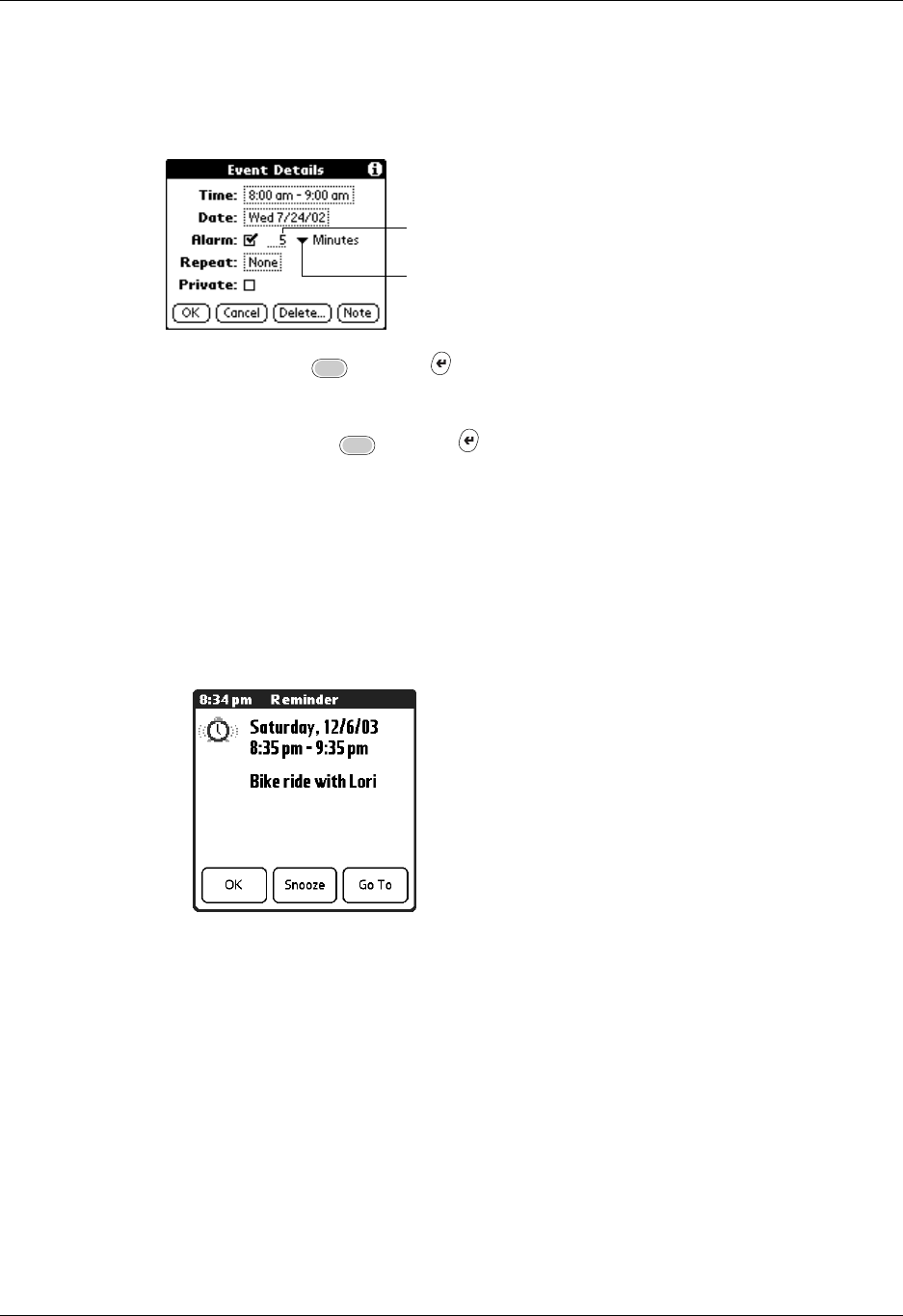
Chapter 8 Using Date Book
84
4. Tap the pick list to select Minutes, Hours, or Days.
5. Select the 5 and enter any number from 0 to 99 (inclusive) as the number of time
units.
6. Press Function + Enter , or tap OK.
7. When the reminder message appears on screen, do one of the following:
– Press Function + Enter , or tap OK, to permanently dismiss the
reminder and return to the current screen.
– Tap Snooze to dismiss the reminder and return to the current screen. The
reminder message appears again five minutes after you tap Snooze, and
meanwhile an attention indicator blinks in the upper-left corner of the screen
to remind you of the pending alarm.
– Tap Go To to open Date Book. Date Book opens and displays the event
associated with the alarm.
Alarm for untimed events: You can set a silent alarm for an untimed event. In this
case, the alarm triggers at the specified period of minutes, hours, or days before
midnight (beginning) of the day of the untimed event. When the alarm triggers, the
reminder list displays the alarm message until you clear it. See “Receiving alerts”
in Chapter 4 for details.
For example, you might set an alarm for an untimed event that occurs on
February 4. If the alarm is set for five minutes, the reminder message appears at
11:55 PM on the night of February 3. The reminder remains in the reminder list
until you turn on your handheld and dismiss it.
Tap here to
select unit of time
Enter number of
time units here
Palm, Inc. Confidential

Scheduling repeating or continuous events
85
Scheduling repeating or continuous events
The Repeat function lets you schedule events that recur at regular intervals or
extend over a period of consecutive days.
A birthday is a good example of an event that repeats annually. Another example
is a weekly guitar lesson that falls on the same day of the week and the same time
of day.
A business trip or a vacation is an example of a continuous event.
To schedule a repeating or continuous event:
1. Select the event.
2. Tap De tail s.
3. Tap the Repeat box to open the Change Repeat dialog box.
4. Tap Day, Week, Month, or Year to set how often the event repeats.
For a continuous event, tap Day.
5. On the Every line, enter a number that corresponds to how often you want the
event to repeat.
For example, if you select Month and enter the number 2, the event repeats
every other month.
6. To specify an end date for the repeating or continuous event, tap the End on
pick list and tap Choose Date. Use the date picker to select an end date.
7. Press Function + Enter , or tap OK.
After you schedule a repeating or continuous event, the Repeat icon appears to
the far right of the event.
Changing repeating or continuous events
When you make changes to a repeating or continuous event, such as deleting or
adding notes or changing the time of an event, you can decide which of the events
you want to change—all events in the series, just the current event, or the current
and future events.
Ta p t h e
Repeat
box
Palm, Inc. Confidential
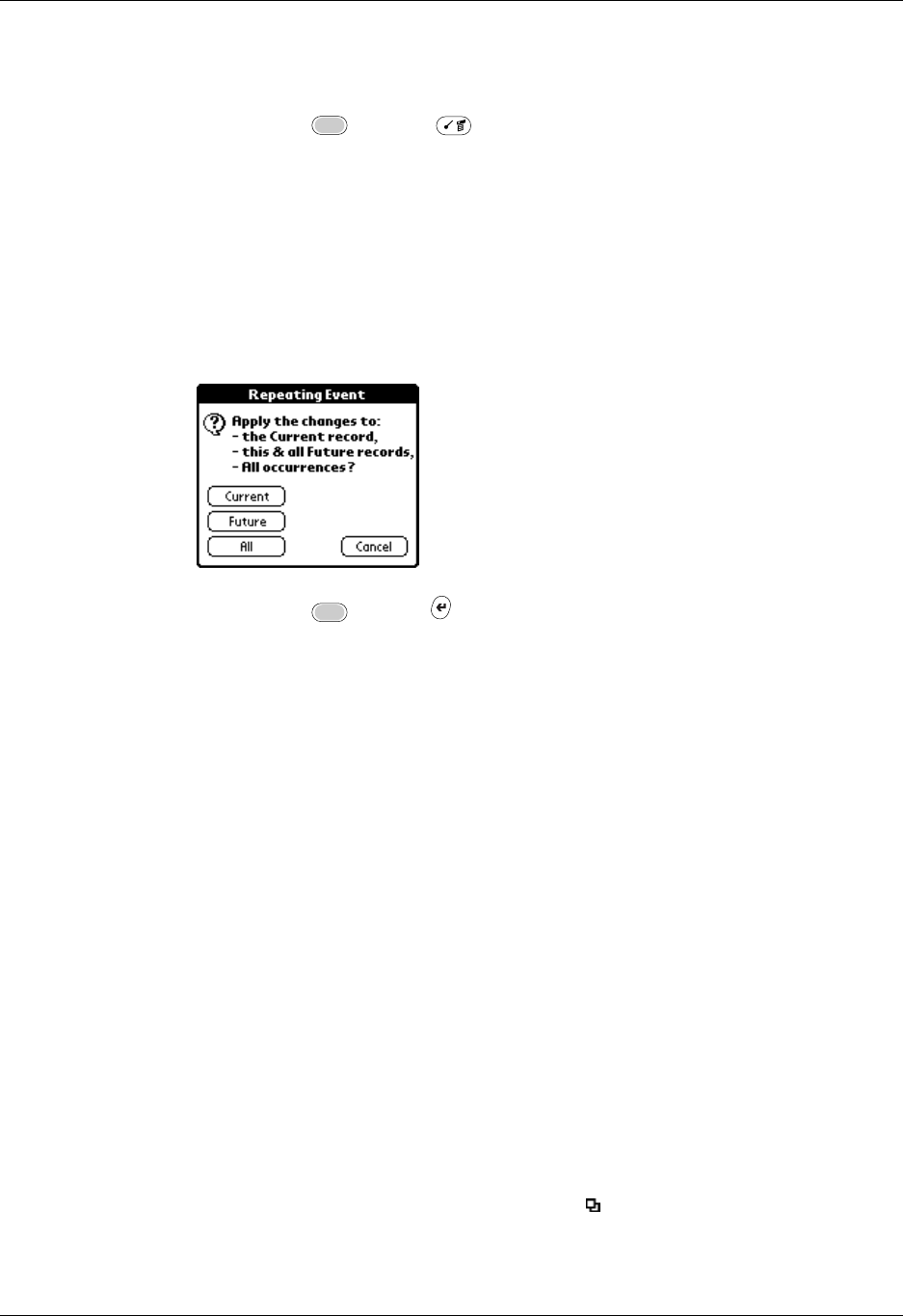
Chapter 8 Using Date Book
86
To delete repeating events:
1. Select the record you want to delete.
2. Press Function + Menu
3. Select Record, and then select Delete Event.
4. Do one of the following:
– Tap Current to delete only the current event item.
– Tap Future to delete the current and all future event items and reset the end
date of the repeating event to the last shown date.
– Tap All to delete all occurrences of the repeating event.
5. Press Function + Enter , or tap OK.
Considerations for repeating or continuous events
Keep the following points in mind:
■If you change the start date of a repeating event, your handheld calculates the
number of days you moved the event. Your handheld then automatically
changes the end date to maintain the duration of the repeating event.
■If you change the repeat interval (e.g., daily to weekly) of a repeating event, past
occurrences (prior to the day on which you change the setting) are not changed,
and your handheld creates a new repeating event.
■If you change the date of an occurrence of a repeating event (e.g., from January
14th to January 15th) and apply the change to all occurrences, the new date
becomes the start date of the repeating event. Your handheld adjusts the end
date to maintain the duration of the event. If you apply the change to current
and future occurrences, past occurrences are not changed.
■If you change other repeat settings (e.g., time, alarm, private) of a repeating
event and apply the change to all occurrences, your handheld creates a new
event. The start date of this new event is the day on which the setting is
changed.
■If you apply a change to a single occurrence of a repeating event (e.g., time), that
occurrence no longer shows the Repeat icon .
Palm, Inc. Confidential

Changing the Date Book view
87
Changing the Date Book view
In addition to displaying the time list for a specific day, you can also display a
whole week, a month, an agenda, and the current time.
To cycle through Day, Week, Month, and Agenda views:
■Press the Date Book application button repeatedly to display the next view.
■Tap the appropriate view icon in the lower-left corner of Date Book.
Working in Week view
Week view shows the calendar of your events for an entire week. This view lets
you quickly review your appointments and available time slots. In addition, the
graphical display helps you spot overlaps and conflicts in your schedule.
To display the Week view:
1. Tap the Week view icon.
2. Tap the navigation controls to move forward or backward a week at a time, or
tap on a column to display details of an event.
The Week view also shows untimed events and events that are before and after
the range of times shown. Untimed repeating events appear in green.
Week view
Previous
week
Next wee
k
Tap for that day
Bar indicates earlier event
Bar indicates later event
Diamond indicates untimed event
Dashed line indicates repeating event
Palm, Inc. Confidential

Chapter 8 Using Date Book
88
3. Tap an event to show a description of the event.
Tips for using Week view
Keep the following points in mind:
■To reschedule an event, tap and drag the event to a different time or day.
■Tap a blank time on any day to move to that day and have the time selected for
a new event.
■Tap any day or date that appears at the top of the Week view to move directly
to that day without selecting an event.
■Press Right and Left on the navigator to scroll to the next or previous week.
■Press Select on the navigator to insert the highlight, and then press Right and
Left to select a day within the selected week. To view the events on the selected
day, press Select on the navigator again.
■The Week view shows the time span defined by the Start Time and End Time in
the Date Book Preferences settings. If you have an event before or after this time
span, a bar appears at the top or bottom of that day’s column. Use the onscreen
scroll arrows to scroll to the event, or press Up and Down on the navigator to
scroll to earlier and later time slots within the selected week.
Working in Month view
The Month view screen shows which days have events scheduled. Dots and lines
in the Month view indicate events, repeating events, and untimed events.
You can control the dots and lines that appear in the Month view. See “Display
Options” later in this chapter.
Event details
Tap to show event details
Previous/next month
Dashes on right side indicate events
Dashed line below date indicates continuous event
Diamond below date indicates untimed event
Month view button
Palm, Inc. Confidential
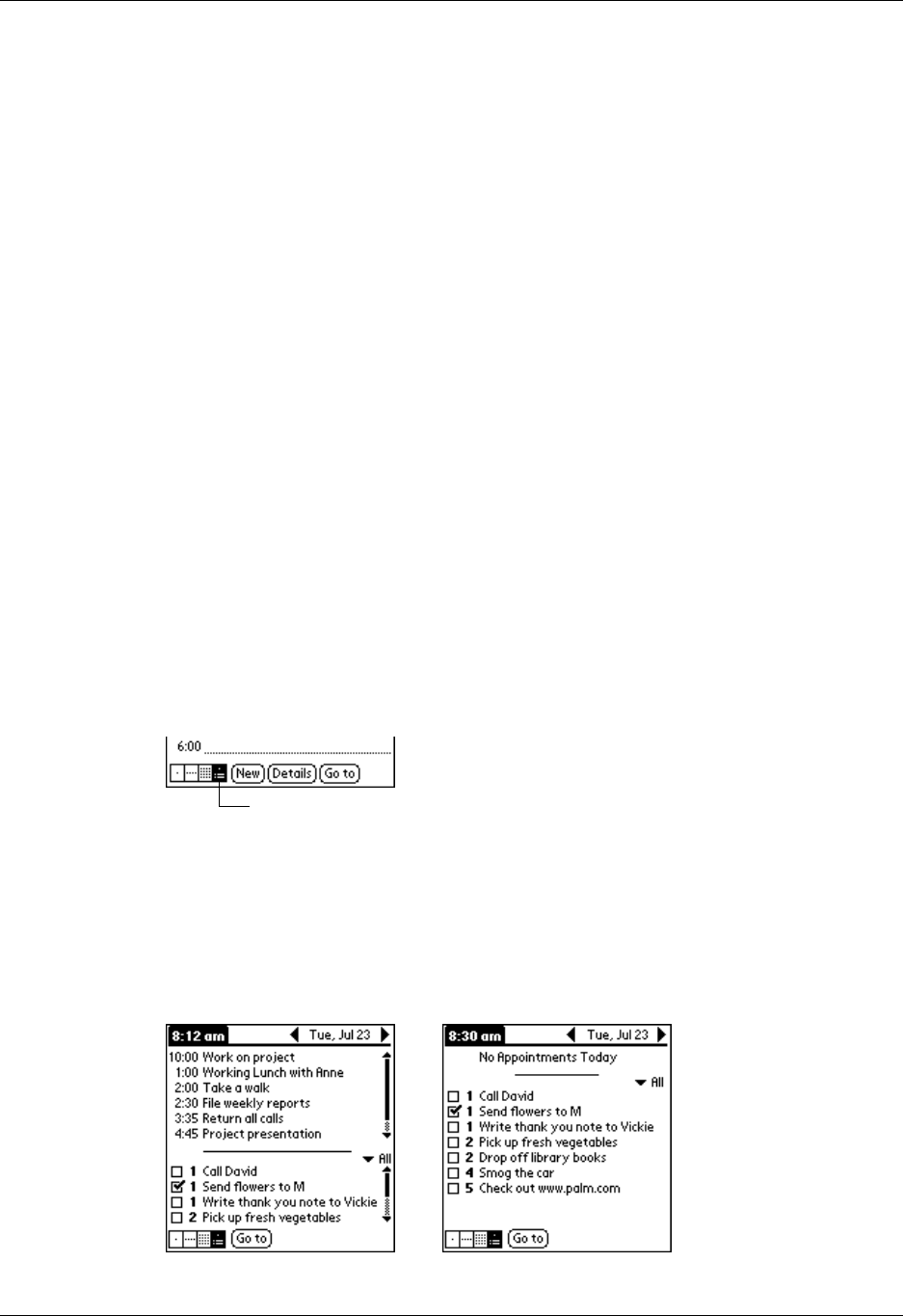
Changing the Date Book view
89
Tips for using Month view
Keep the following points in mind:
■Tap a day in the Month view to display that day in the Day view.
■Tap the scroll arrows in the upper-right corner, or press Left and Right on the
navigator, to move forward or backward a month.
■Press Select on the navigator to insert the highlight, and then press Left and
Right on the navigator to scroll to a specific day. Press Select on the navigator
to display that day in the Day view.
■Untimed repeating events appear in green.
Working in Agenda view
The Agenda view shows you your untimed events, appointments, and To Do
items in one screen. When you tap an untimed event or appointment in the
Agenda view, the Day view appears so you can see more detailed information
about the event. You can tap the check box next to a To Do item to mark it as
completed. When you tap on a To Do item, your To Do list appears.
NOTE The To Do items that appear and how you can change them depends on the
settings in your To Do preferences. See “Setting To Do Preferences” in Chapter 16 for
more information.
To display the Agenda view:
1. Tap the Agenda view icon.
2. Tap the navigation controls to move forward or backward a day at a time, or to
display more events and To Do items.
TIP You can also press Up and Down on the navigator to scroll through the
events on the selected day, or press Right and Left on the navigator to scroll to
the next or previous day.
Agenda view
Palm, Inc. Confidential
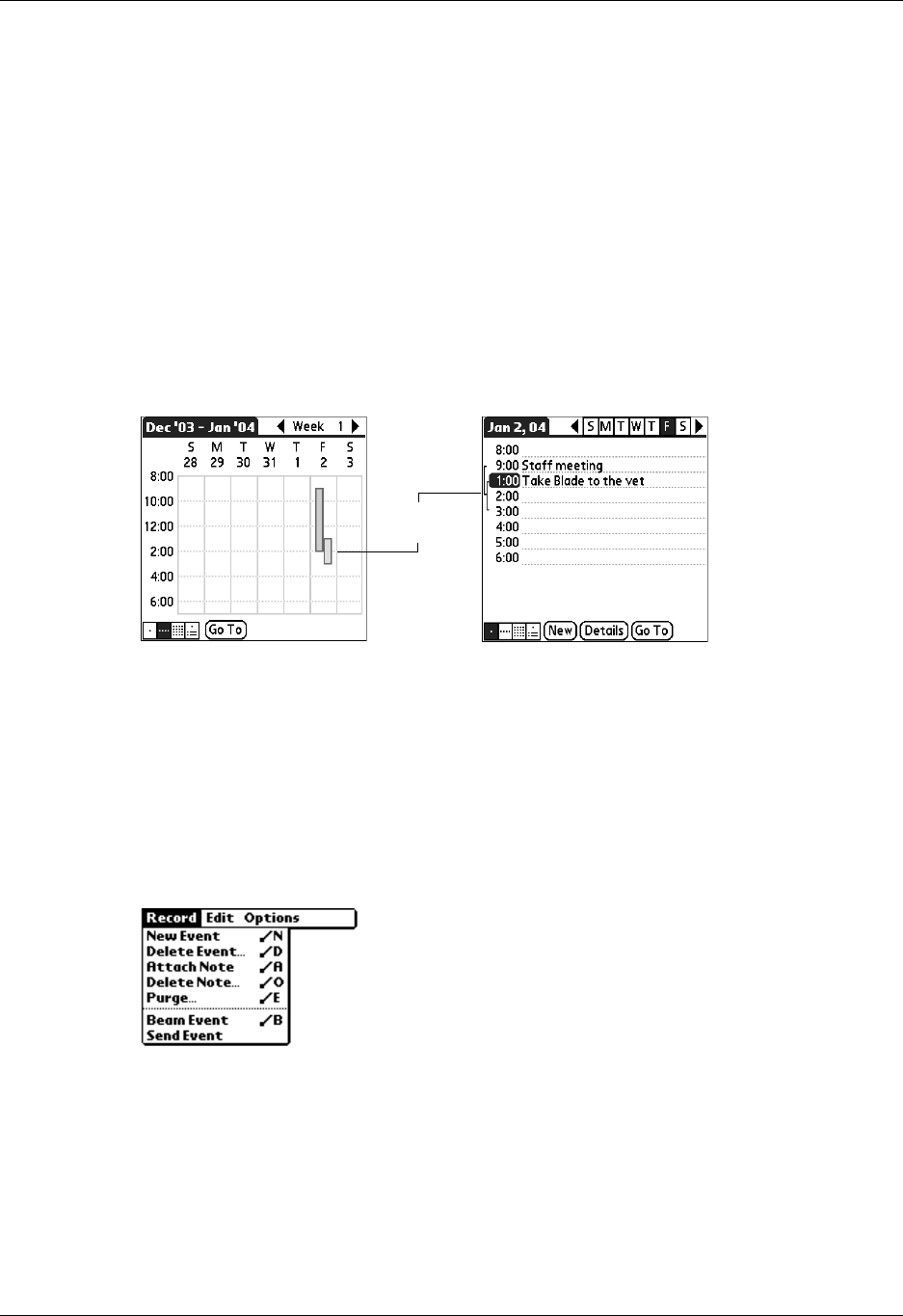
Chapter 8 Using Date Book
90
NOTE You can also change the category of To Do items shown. Tap on the
pick list to choose another category. See Chapter 16 for more information on
working with To Do items.
Spotting event conflicts
With the ability to define specific start and end times for any event, it’s possible to
schedule events that overlap (an event that starts before a previous event finishes).
An event conflict (time overlap) appears in the Week View as overlapping bars.
The first event created appears as a gray bar, and any subsequent conflicting
events appear as a single red bar. The Day View displays overlapping red brackets
to the left of the conflicting times. The Month View displays conflicting
appointments in red.
Date Book menus, preferences, and display options
Date Book menus are shown here for your reference, and Date Book features that
are not explained elsewhere in this book are described here.
See “Using menus” in Chapter 4 for information about choosing menu commands.
Record menu
Event
conflicts
Send Event Opens a dialog box where you can choose how you want to
send the selected event to another device. The options available
depend on the software installed on your handheld.
Palm, Inc. Confidential

Date Book menus, preferences, and display options
91
Options menu
Display Options
Allows you to change Date Book’s appearance and which events are displayed.
Show Time Bars Activates the time bars that appear in the Day view. The
time bars show the duration of an event and illustrate
event conflicts.
Compress Day view Controls how times appear in the Day view. When
Compress Day view is off, all time slots are displayed.
When it is on, start and end times are displayed for each
event, but blank time slots toward the bottom of the screen
disappear to minimize scrolling.
Month view settings These check boxes apply to the Month view of the Date
Book. You can deactivate any or all of these settings to hide
Timed, Untimed, or Daily Repeating events in the Month
view only.
Palm, Inc. Confidential
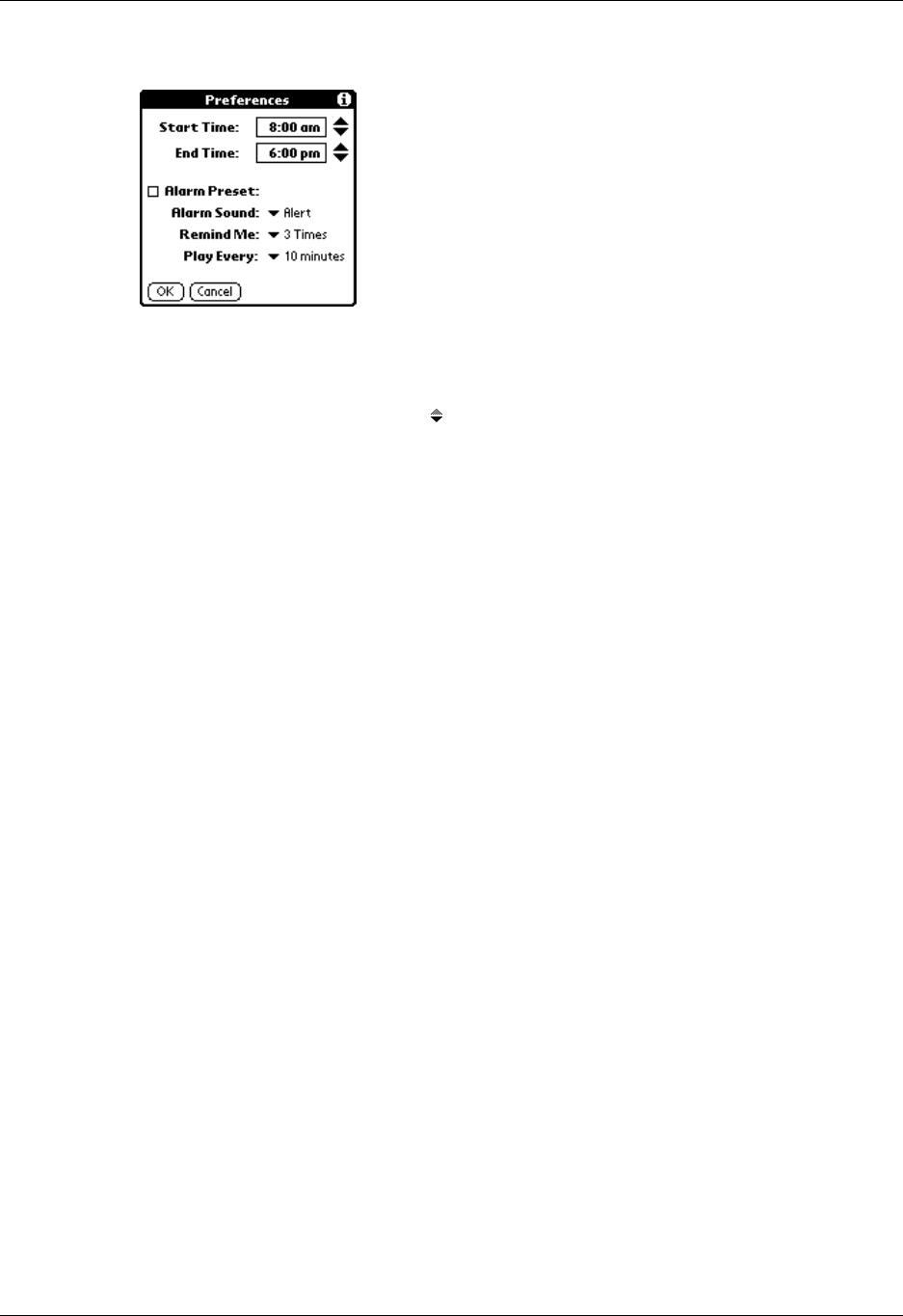
Chapter 8 Using Date Book
92
Preferences
About Date Book
Shows version information for Date Book.
Start/End Time Defines the start and end times for Date Book screens. If the
time slots you select do not fit on one screen, you can tap the
scroll arrows to scroll up and down.
Alarm Preset Automatically sets an alarm for each new event. The silent
alarm for untimed events is defined by minutes, days, or hours
before midnight at the end of the date of the event.
Alarm Sound Sets the tone of the alarm.
Remind Me Defines how many times the alarm occurs after the initial
occurrence. The choices are Once, Twice, 3 Times, 5 Times, and
10 Times.
Play Every Defines how often the alarm sounds. The choices are Minute,
5 minutes, 10 minutes, and 30 minutes.
Palm, Inc. Confidential
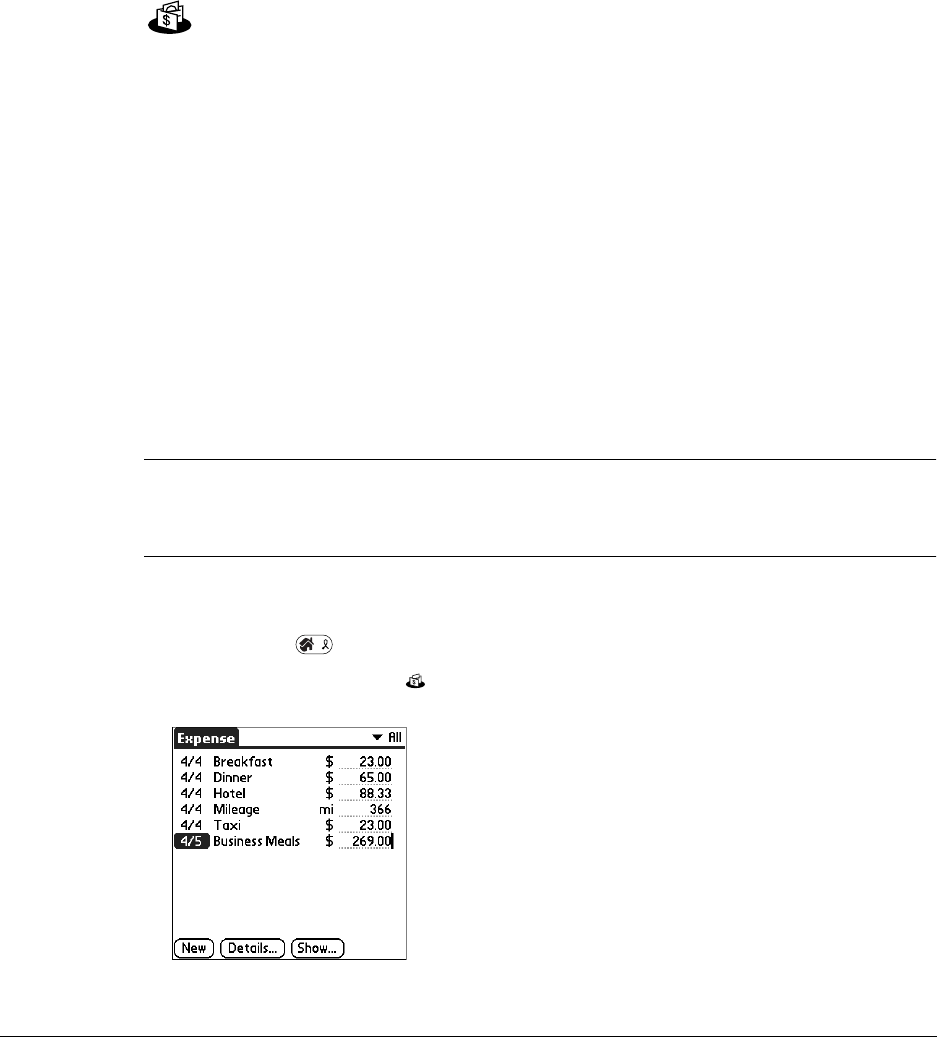
93
CHAPTER 9
Using Expense
Expense enables you to keep track of your expenses and then transfer the
information to a spreadsheet on your computer. In Expense you can do the
following:
■Record dates, types of expenses, amount spent, payment method, and other
details associated with any money that you spend.
■Assign expense items to categories so that you can organize and view them in
logical groups.
■Keep track of vendors (companies) and people involved with each expense.
■Log miles traveled for a particular date or expense category.
■Sort your expenses by date or expense type.
■Send or export your expense information to popular computer applications,
such as Microsoft Excel or Microsoft Word, using Palm™ Desktop software and
HotSync® technology on a Windows computer.
IMPORTANT To access Expense, you must first perform a HotSync operation with
your handheld. Expense is automatically loaded onto your handheld during the first
HotSync operation.
To open Expense:
1. Press Home .
2. Select the Expense icon .
Palm, Inc. Confidential
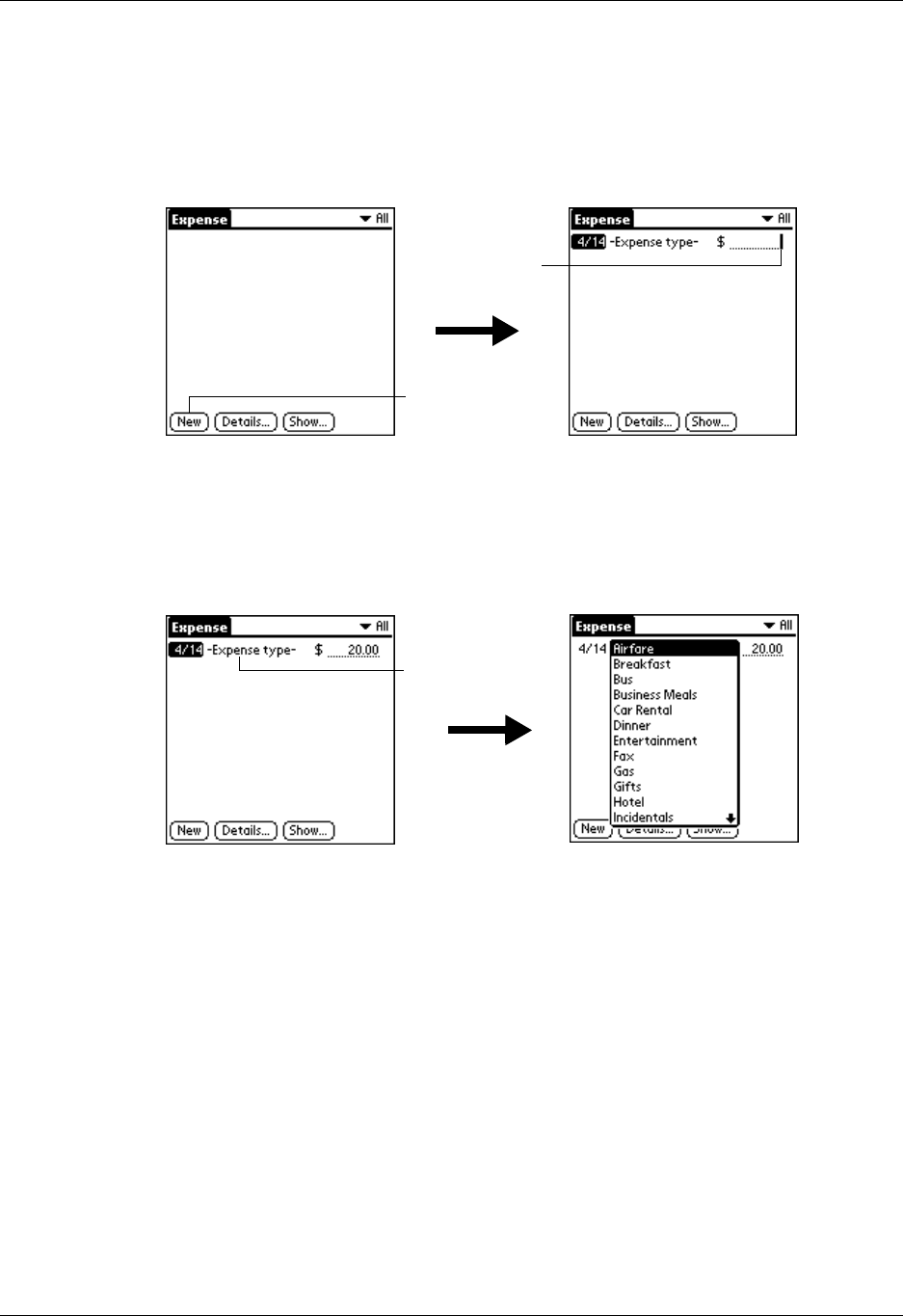
Chapter 9 Using Expense
94
Adding expense items
A record in Expense is called an item. You can sort your Expense items into
categories or add other information that you want to associate with the item.
1. Tap New.
2. Enter the amount of the expense.
3. Tap the Expense type pick list and select a type from the list.
As soon as you select an expense type, your handheld saves your entry. If you
do not select an expense type, it does not save the entry.
TIP Another quick way to create a new Expense item is to make sure that no
Expense item is selected in the Expense list, type the first letter(s) of the
expense type, and then type the numerical amount of the Expense item. This
technique takes advantage of the automatic fill feature. See “Options menu”
later in this chapter for details.
Ta p N e w
Cursor of
new item
Tap here
Palm, Inc. Confidential
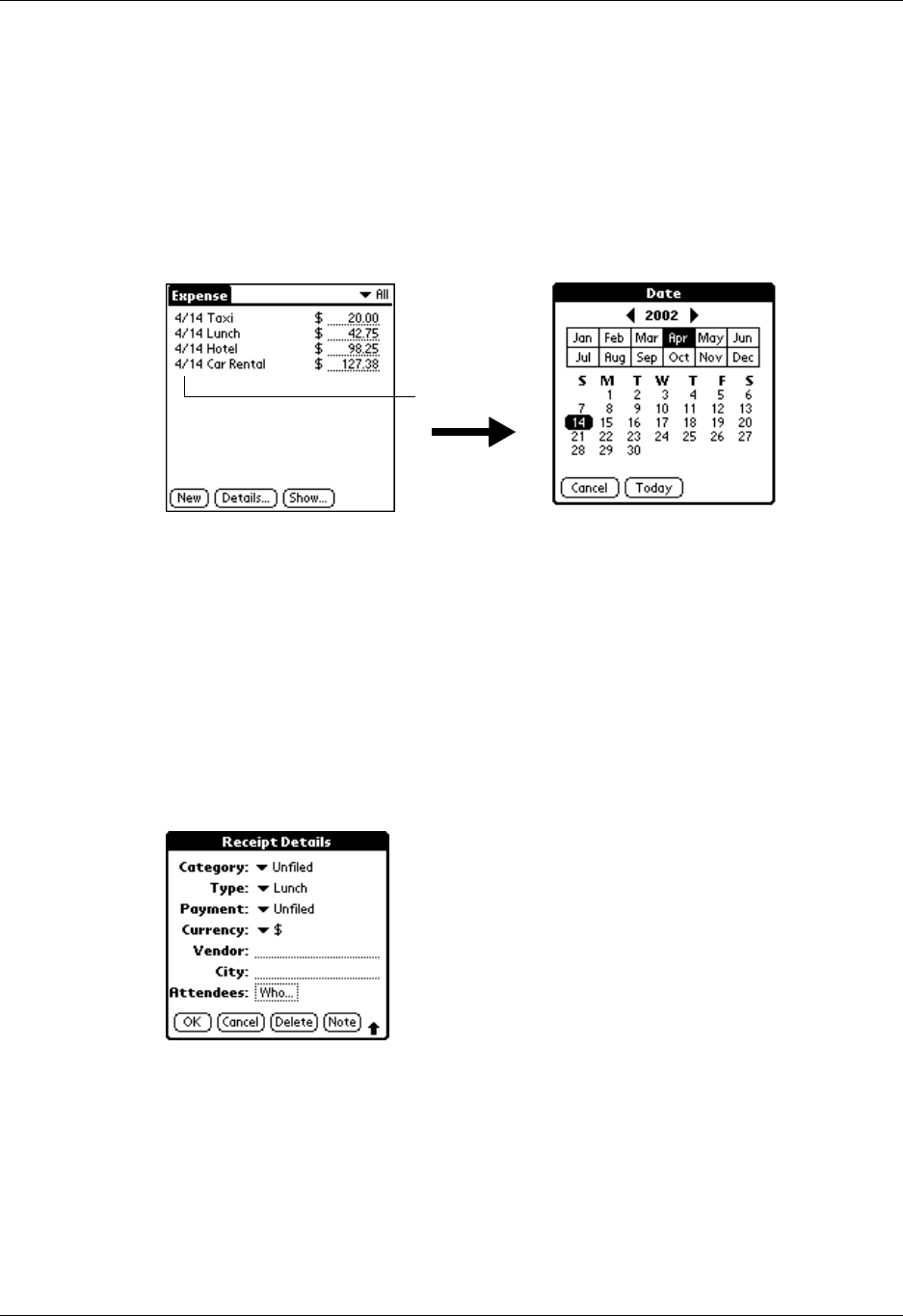
Adding expense items
95
Changing the date of an Expense item
Initially, Expense items appear with the date on which you enter them. You can
change the date associated with any Expense item.
To change the date of an Expense item:
1. Tap the Expense item you want to change.
2. Tap the date of the selected item.
3. Tap the new date.
Entering receipt details
Expense provides a variety of options that you can associate with an item. These
options appear in the Receipt Details dialog box.
To open the Receipt Details dialog box:
1. Tap the Expense item to which you want to assign details.
2. Tap De tail s.
3. Select any of the following options:
Ta p d a t e
Category Opens a pick list of system and user-defined categories.
See “Categorizing records” in Chapter 4 for more information.
Ty p e Opens a pick list of expense types.
Palm, Inc. Confidential
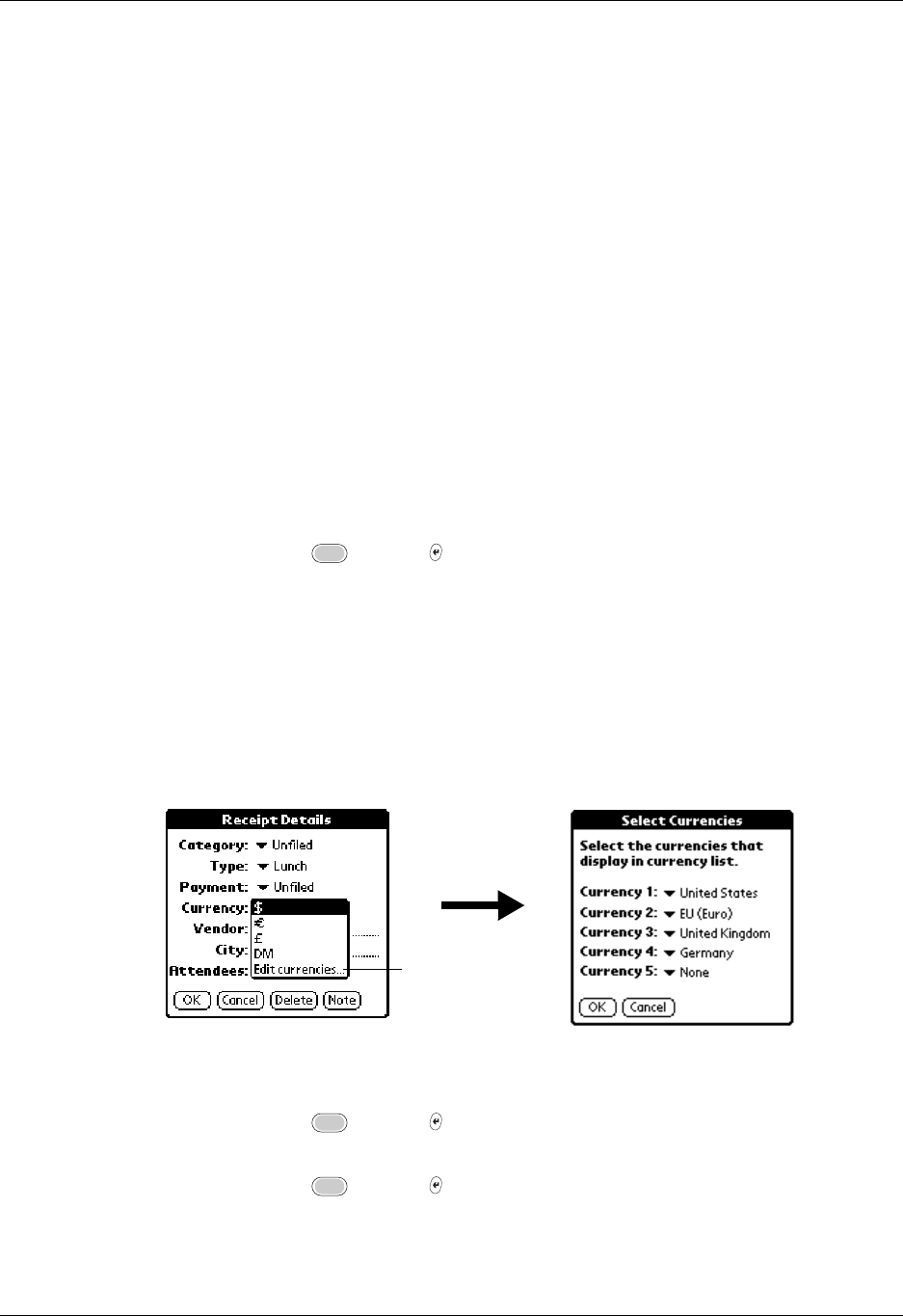
Chapter 9 Using Expense
96
4. Press Function + Enter or tap OK.
Customizing the Currency pick list
You can select the currencies and symbols that appear in the Currency pick list.
To customize the Currency pick list:
1. Tap the Currency pick list in the Receipt Details dialog box, and then select Edit
currencies.
2. Tap each Currency pick list and select the country whose currency you want to
display on that line.
3. Press Function + Enter or tap OK to close the Select Currencies dialog
box.
4. Press Function + Enter or tap OK.
Payment Enables you to choose the payment method used to pay the
Expense item. If the item is prepaid (such as airline tickets
supplied by your company), you can choose Prepaid to place your
expense in the appropriate company-paid cell of your printed
expense report.
Currency Enables you to choose the type of currency used to pay the
Expense item. The default currency unit is defined in the
Preferences dialog box. You can also display up to four other
common types of currency. See “Customizing the Currency pick
list” later in this chapter for more information.
Vendor and
City Enables you to record the name of the vendor (usually a company)
associated with the expense and the city where the expense was
incurred. For example, a business lunch might be at Rosie’s Cafe
(Vendor) in San Francisco (City).
Attendees See “Looking up names to add to Expense records” in Chapter 4
for more information.
Tap Edit
currencies
Palm, Inc. Confidential
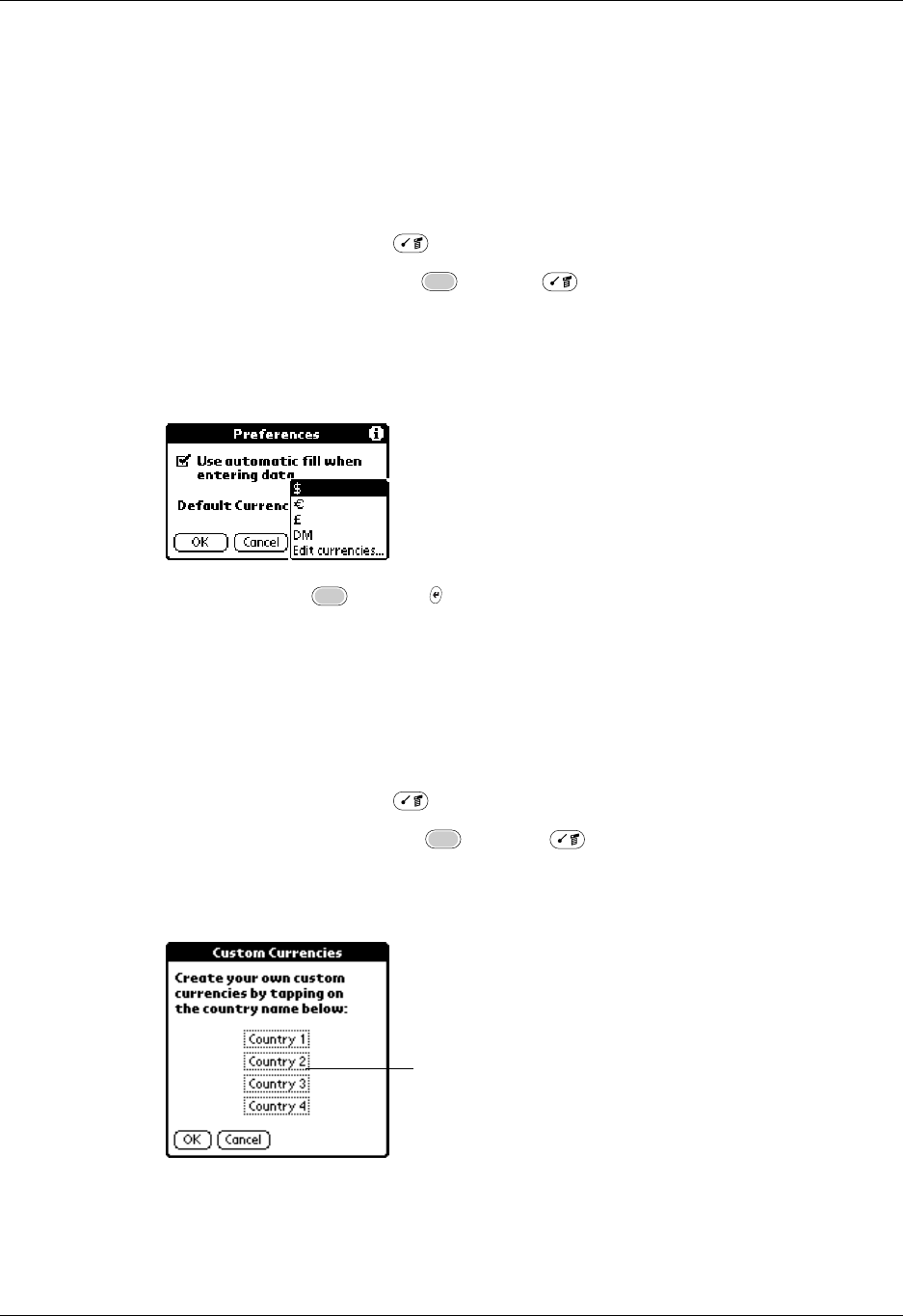
Customizing the Currency pick list
97
Changing the default currency
You can select which currency appears by default when you’re entering Expense
items. You can override this setting when entering individual expense items.
To change your default currency:
1. Open Expense.
2. Press Command Stroke + R.
Alternately, press Function + Menu , and then select Preferences on the
Options menu.
3. Tap the Default Currency pick list.
4. Select the currency symbol that you want to appear in Expense.
5. Press Function + Enter or tap OK.
Defining a custom currency symbol
If the currency you want to use is not in the list of countries, you can create your
own custom country and currency symbol.
To define a custom currency symbol:
1. Press Command Stroke + Y.
Alternately, press Function + Menu , and then select Custom
Currencies on the Options menu.
2. Tap one of the four Country boxes.
Tap a Country
box
Palm, Inc. Confidential
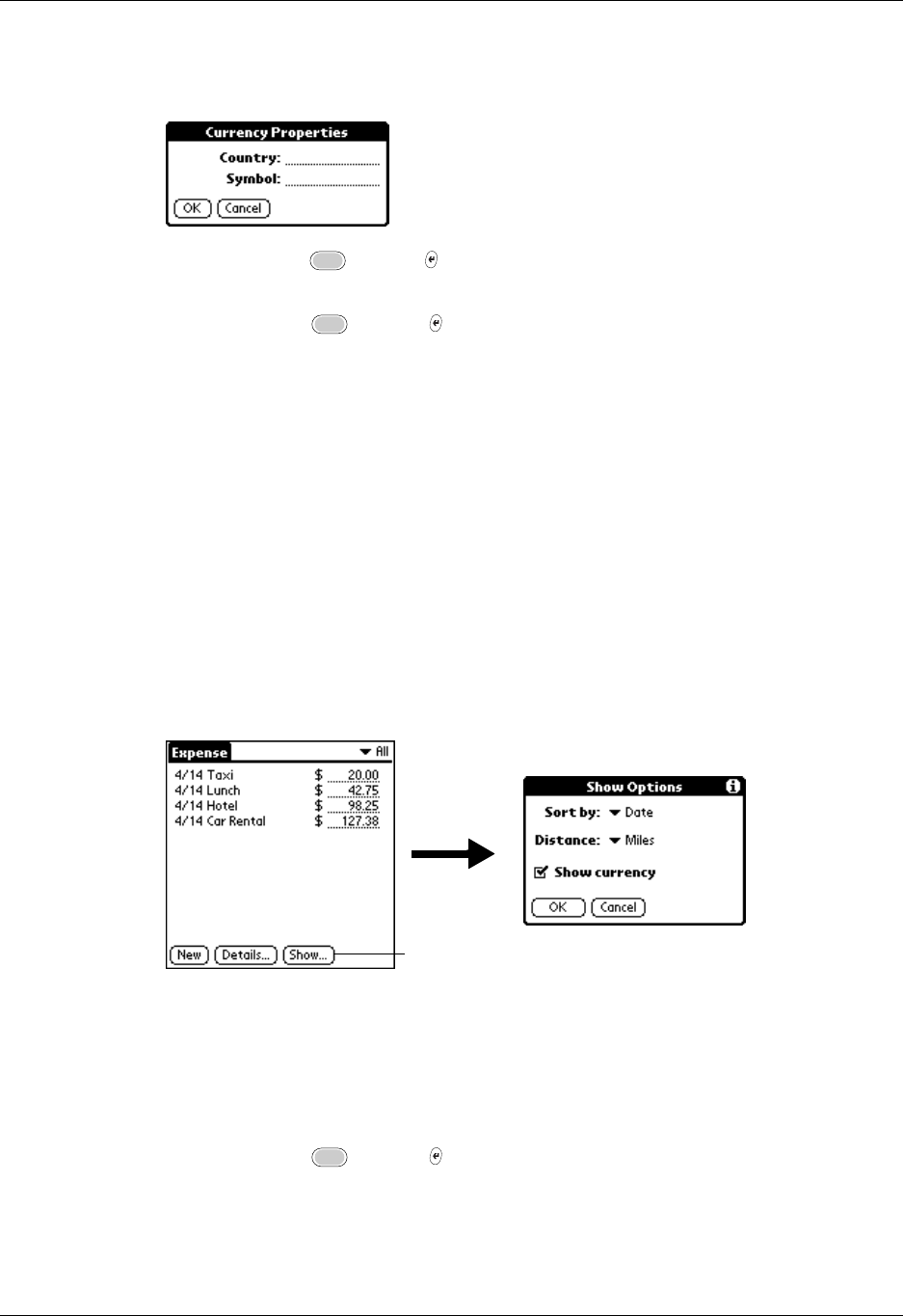
Chapter 9 Using Expense
98
3. Enter the name of the country and the symbol that you want to appear in
Expense.
4. Press Function + Enter or tap OK to close the Currency Properties dialog
box.
5. Press Function + Enter or tap OK.
NOTE If you want to use your custom currency symbol as the default for all Expense
items, select the symbol in the Preferences dialog box. If you want to use your
custom currency symbol only for a particular Expense item, select the symbol in the
Receipt Details dialog box associated with that item.
Setting Show Options
Show Options defines the sort order and other settings that relate to your Expense
items.
To open the Show Options dialog box:
1. In the Expense list, tap Show.
2. Select any of the options.
3. Press Function + Enter or tap OK.
Sort by Enables you to sort expense items by date or type.
Distance Enables you to display Mileage entries in miles or kilometers.
Show currency Shows or hides the currency symbol in the Expense list.
Tap Show
Palm, Inc. Confidential

Working with Expense data on your computer
99
Working with Expense data on your computer
After you enter your expenses into the Expense application on your handheld and
perform a HotSync operation, Palm Desktop software enables you to do any of the
following on your computer. See the Palm Desktop software online help for
details. This feature is not avaialble on Mac computers.
■Add, modify, and delete your Expense data.
■Organize your Expense data by category, amount, date, type, or notes.
■View Expense data in various formats: List, Large Icons, or Small Icons.
■Record individual expenses in various currencies and display the total in one
selected currency type.
■Print Expense reports.
■Transfer Expense data to other applications, such as Microsoft Excel, using the
Send command or Export command, and import data in popular file formats.
Displaying the euro on your computer
When you perform a HotSync operation, the euro symbol is transferred to Palm
Desktop software like any other piece of data on your handheld. The symbol
appears in Palm Desktop software, however, only if you are using fonts that
support the euro symbol.
These fonts are part of the operating system on your computer. They do not reside
with your Desktop application, and they are not produced by Palm, Inc. For more
information refer to the documentation that accompanies your desktop
computer’s operating system.
Printing the euro
Even with operating system support, problems may arise when you print
documents that contain the euro. When a font is present on both the printer and
the computer, the printer font is used by default to increase printing speed. If the
printer font does not include the euro, a box is printed instead of the euro symbol.
These fonts are part of the operating system on your computer. They do not reside
with your Desktop application, and they are not produced by Palm, Inc. For more
information, refer to the documentation that accompanies your desktop
computer’s operating system.
Palm, Inc. Confidential
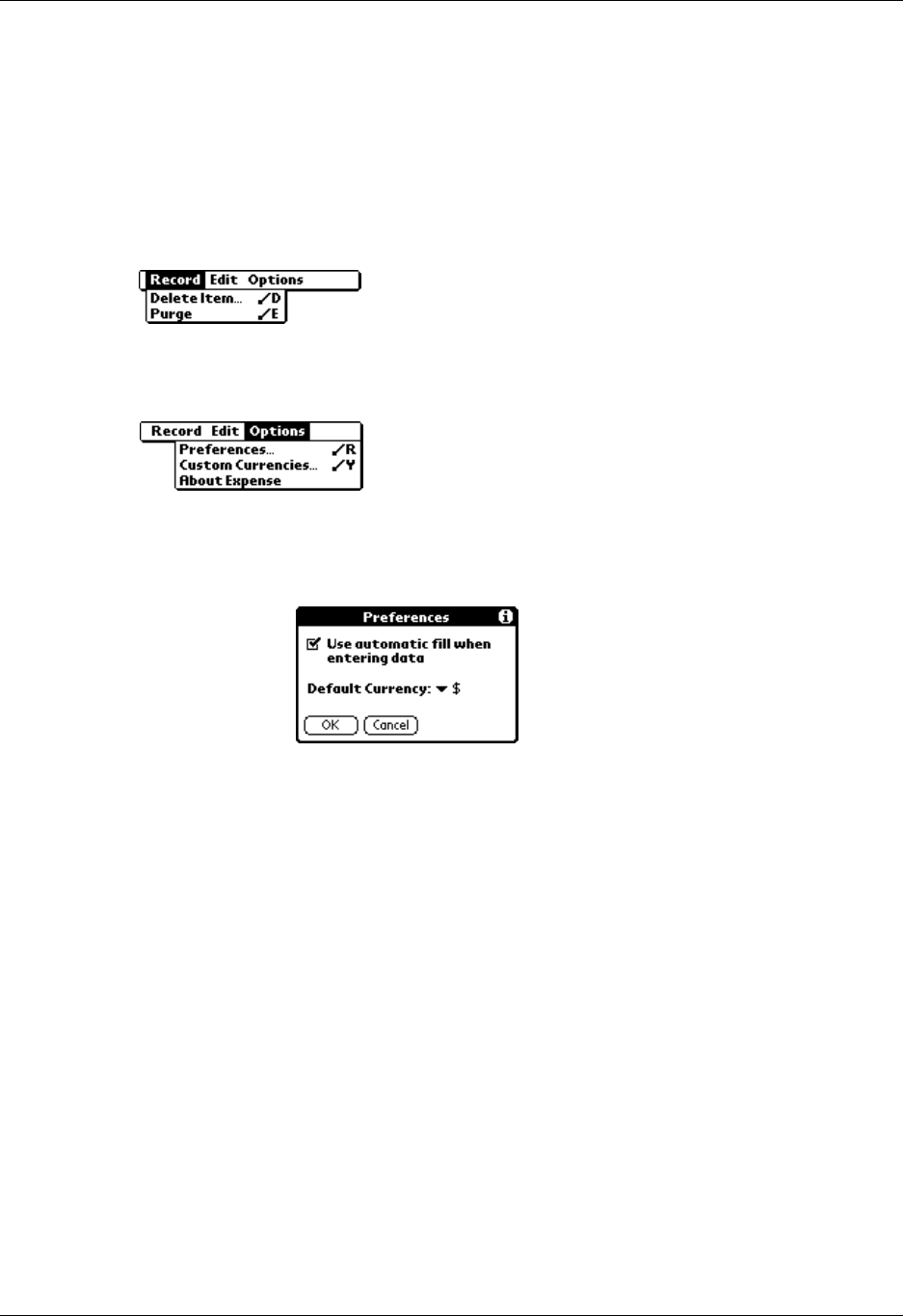
Chapter 9 Using Expense
100
Using Expense menus
Expense menus are shown here for your reference, and Expense features that are
not explained elsewhere in this book are described here.
See “Using menus” in Chapter 4 for information about choosing menu commands.
Record menu
Options menu
Preferences Opens the Preferences dialog box where you can select
automatic fill and default currency options.
Use automatic fill. Enables you to select an expense type by
typing the first letter of an expense type. For example, if you
type the letter T, it enters the “Taxi” expense type. Typing T and
then E enters Te l e ph o n e , which is the first expense type beginning
with the letters TE.
About Expense Shows version information for Expense.
Palm, Inc. Confidential
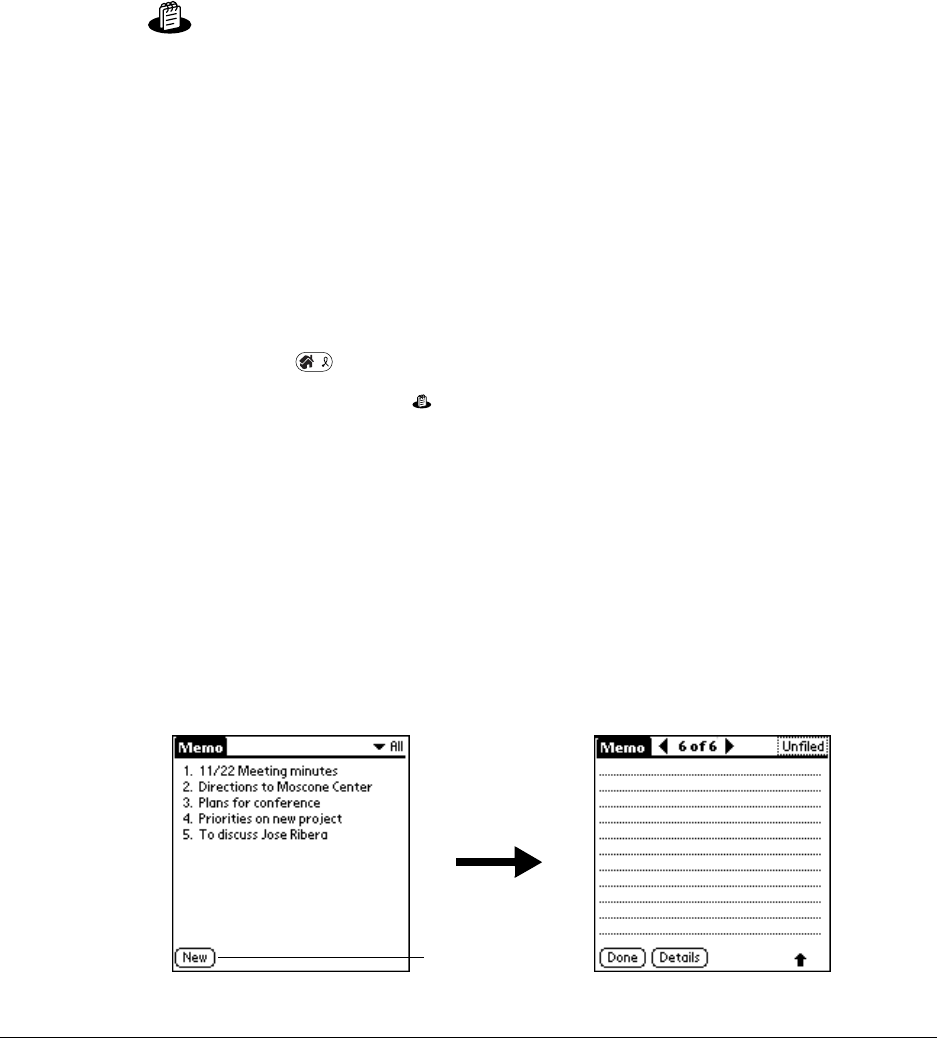
101
CHAPTER 10
Using Memo Pad
Memo Pad provides a place to take notes that are not associated with
records in Date Book, Address Book, or To Do List. The number of memos
you can store is dependent only on the memory available on your handheld.
Use Memo Pad to do the following:
■Send memos to popular computer applications like Microsoft Word when you
synchronize using Palm™ Desktop software and HotSync® technology.
■Assign memos to categories so that you can organize and view them in logical
groups.
■Write down phone numbers and other types of information that you can later
copy and paste into other applications.
To open Memo Pad:
1. Press Home .
2. Tap the Memo Pad icon .
Creating memos
A record in Memo Pad is called a memo. You can assign memos to categories and
mark them private as described in Chapter 4. This section covers how to create a
memo.
To create a new memo:
1. Open Memo Pad.
2. Tap New.
Ta p N e w
Palm, Inc. Confidential

Chapter 10 Using Memo Pad
102
TIP In the Memo list screen, you can also begin typing to create a new memo.
The first letter is automatically capitalized and begins your new memo. If you
have a memo open, you can press Command Stroke + N.
3. Enter the text that you want to appear in the memo.
4. Press Function + Enter , or tap Done.
Reviewing memos
The first line of a memo appears in the Memo list. This makes it easy to locate and
review your memos.
To rev i ew a memo:
1. In the Memo list, select the text of the memo.
TIP You can also select, review, and move between memos with the navigator.
See “Using the navigator” in Chapter 3 for details.
2. Review or edit the text in the memo.
3. Press Function + Enter , or tap Done.
Using Memo Pad menus
Memo Pad menus are shown here for your reference, and Memo Pad features that
are not explained elsewhere in this book are described here.
See “Using menus” in Chapter 4 for information about choosing menu commands.
The Record and Options menus differ depending on whether you’re displaying
the Memo list or an individual memo.
Select a memo
to review
Palm, Inc. Confidential

Using Memo Pad menus
103
Record menus
Options menus
Send Category Opens a dialog box where you can choose how to send all
records in the selected category to another device. The options
available depend on the software installed on your handheld.
Send Memo Opens a dialog box where you can choose how to send the
selected memo to another device. The options available depend
on the software installed on your handheld.
Memo list
Memo screen
Preferences Displays the Memo Preferences dialog box, where you define
the sort order for memos.
About Memo Pad Shows version information for Memo Pad.
Memo list Memo screen
Palm, Inc. Confidential

Chapter 10 Using Memo Pad
104
Palm, Inc. Confidential

105
CHAPTER 11
Using Palm™ Mobile
Palm™ Mobile is a fast and simple way to use your handheld to make and
receive calls. The Mobile features differ depending on your wireless service
provider. Use Palm Mobile to do the following:
■Dial a number in a multitude of ways, such as from the keypad, or by using
speed dial, call history, or your Address Book.
■Answer a second call while automatically placing the current caller on hold.
■Retrieve voicemail.
■Make and manage a conference call.
■Retrieve Caller ID information from your Address Book.
■View a history list of your last 20 missed, incoming, and received calls.
■Create call reminders to help you follow up on calls.
■Quickly access a list of frequently called numbers.
■Attach notes to the Address Book entry of the person you are speaking with.
NOTE The Mobile features available on your handheld depend on your contract with
your wireless service provider.
IMPORTANT Whenever you use the wireless features of your handheld, please
observe the guidelines or prohibitions on the use of wireless devices in your current
location. For example, when you are on an airplane, do not turn on your radio at
times when government or airline regulations prohibit the use of cellular phones. You
can, of course, use all other applications of your handheld in accordance with airline
regulations for electronic devices.
Palm, Inc. Confidential

Chapter 11 Using Palm™ Mobile
106
Using your hands-free headset
Your handheld functions as a mobile phone using a hands-free headset. The
headset enables you to answer and end calls.
The headset cable connects to the jack at the upper-left of the handheld. Once the
jack is connected and the earpiece speaker is placed in your ear, you can answer
and end calls by using the button on the headset microphone.
The button on the headset microphone changes function according to the call
status:
To use the hands-free headset:
1. Insert the headset connector into the voice jack.
Mobile radio off
or
Mobile radio on-–
no calls
Short press: Opens Palm Mobile and cycles through screens.
Long press: Continuous cycling through Palm Mobile screens.
Mobile radio on-–
phone ringing
Short press: Answers call.
Long press: Ignores the call and sends the call to voicemail.
Mobile radio on-–
active call in
session
Short press: If you are currently in another application, returns
you to Palm Mobile Active Call screen. If you are in Palm
Mobile, cycles to the next application screen.
Long press: Ends currently active call.
Mobile radio on-–
active call in
session and
phone is ringing
Short press: If you are currently in another application, returns
you to Palm Mobile Active Call screen. If you are in Palm
Mobile, cycles to the next application screen.
Long press: Ignores the call and sends the call to voicemail.
Button
Headset jack
Microphone
Earpiece speaker
Palm, Inc. Confidential
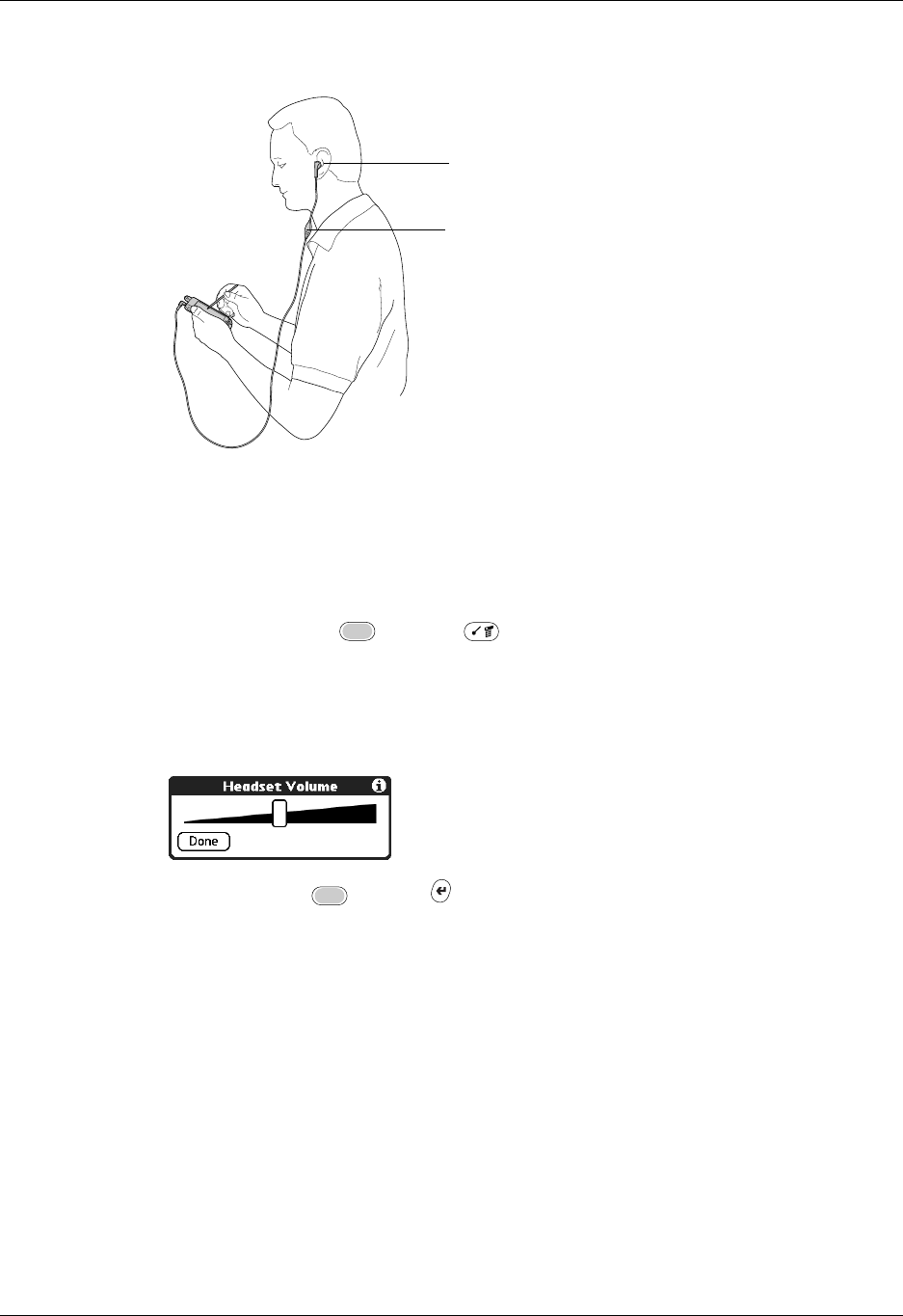
Using your hands-free headset
107
2. Place the earpiece speaker comfortably in your ear.
When you have an active call, you can adjust the speaker volume on your headset
using the Volume dialog box.
To adjust the volume during an active call:
1. Perform one of the following:
– Press Function + Menu , and then select Volume.
– When a call is active, press Up or Down on the navigator.
2. When the Headset Volume screen appears, adjust the volume using the slider
or navigator.
3. Press Function + Enter , or tap Done.
Microphone
Earpiece speaker
Palm, Inc. Confidential

Chapter 11 Using Palm™ Mobile
108
Opening Palm Mobile
You can open Palm Mobile from the Applications Launcher or from the headset.
NOTE The Mobile features available on your handheld depend on your contract with
your wireless service provider. Some wireless service providers require a PIN to turn
on the mobile radio. Check with your wireless service provider for more information.
To open Palm Mobile from the Mobile icon in Applications Launcher:
1. Press the Home .
2. Tap the Palm Mobile icon .
To open Palm Mobile from the headset:
■If the headset is not plugged in, insert the headset plug into the headset jack on
your handheld.
The Palm Mobile application automatically opens. If the mobile radio is not on,
the mobile radio automatically turns on.
■If the headset is already plugged in, press the button on the headset.
See “Using your hands-free headset” earlier in this chapter for more
information on using the headset button.
Numeric display
Screen icons
Mobile main screen
Active Call screen
Call History screen
Name of currently active
profile
Icon area
Call being forwarded
Vibrate on
Ringer off
Voicemail message
Roaming
GPRS coverage Signal strength indicator
Palm, Inc. Confidential

Answering a phone call
109
Answering a phone call
When you receive a call, a notification message is displayed with any caller
information that is available.
To answer a phone call:
1. Do one of the following:
– If your headset is not plugged in, insert the headset plug into the voice jack
on your handheld and place the speaker in your ear. Palm Mobile
automatically opens and answers the phone call.
– If your headset is plugged in when the call notification arrives, tap Answer.
2. Begin communicating.
Tap Ignore to send the call directly to your
voicemail
Tap Answer to answer the call
Tap anywhere onscreen to silence the ringer
Tap End to end call
Tap name to go to Call Action screen
Palm, Inc. Confidential
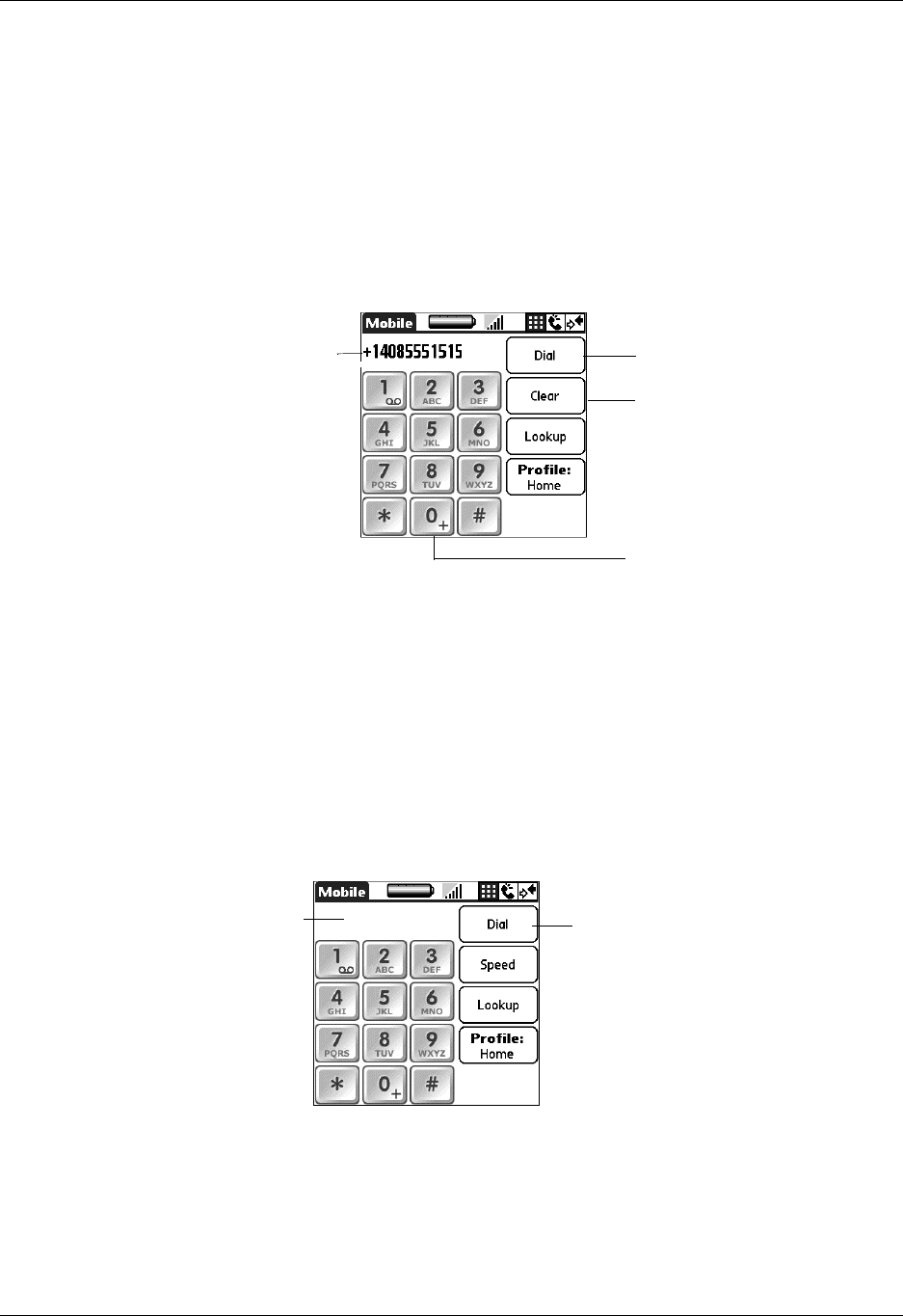
Chapter 11 Using Palm™ Mobile
110
Dialing a number from the keypad
You can dial a number using the keypad the same as you would using a mobile
phone.
To dial a number from the keypad:
1. Tap the telephone number on the keypad.
TIP You can also enter the telephone number using your keyboard.
2. Tap Dial.
The number is dialed and added to the Call History list. You are ready to
communicate.
Redialing the most recently dialed number
You can quickly redial the most recently dialed number.
To redial the most recently dialed number:
1. Tap Dial when the numeric display has no digits.
2. Tap Dial.
Tap and hold the 0 key to add
a + (plus) to the number
sequence.
Digits are displayed
in the numeric
display.
Enter phone number
and Tap Dial.
Tap Clear to delete digit from
numeric display. Tap and hold
to clear entire numeric
display.
Ta p D ia l
Numeric display
has no digits
Palm, Inc. Confidential
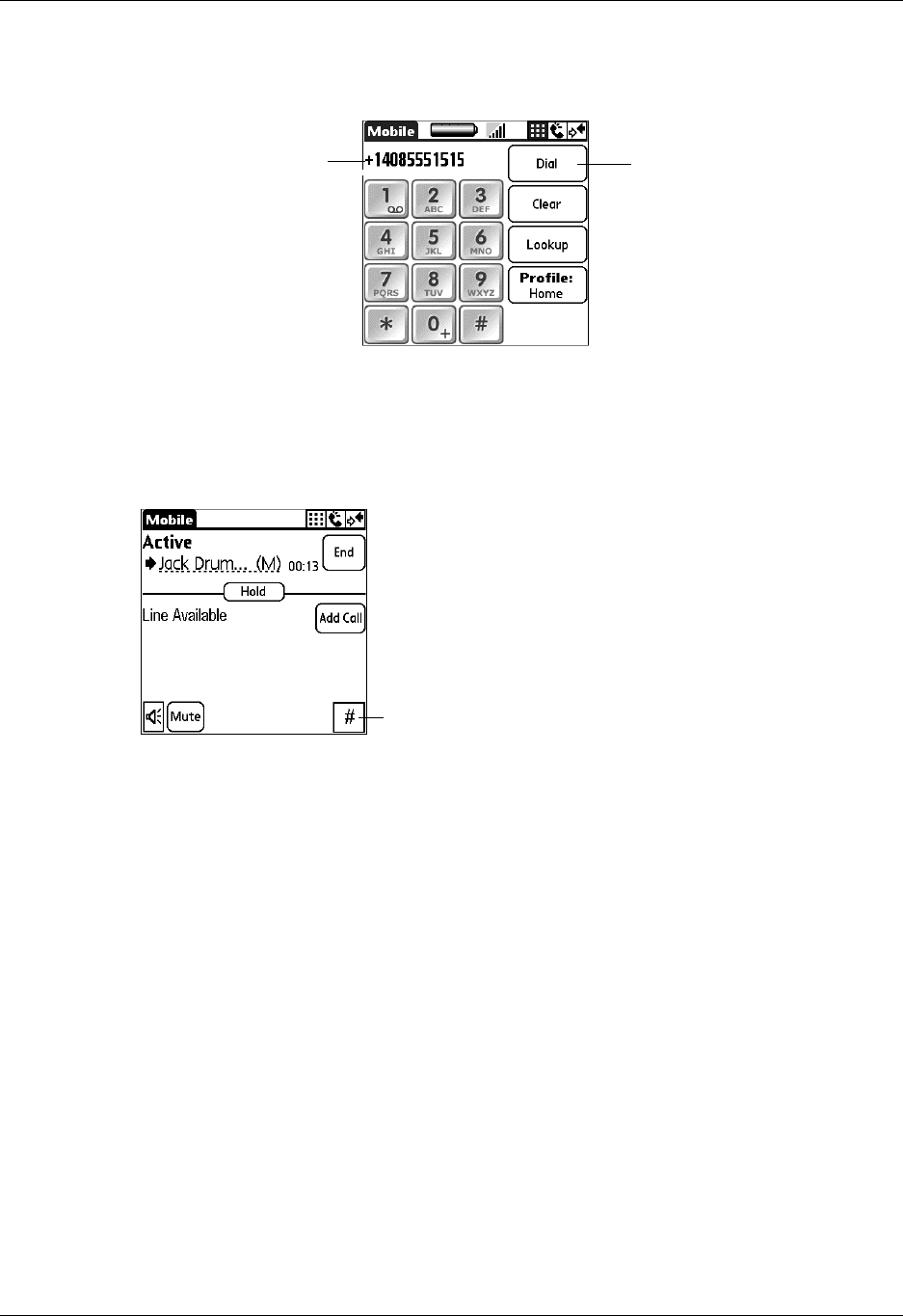
Managing a phone call
111
The number is dialed and added to the Call History list. You are now ready to
communicate.
TIP If you need to enter digits during the phone call to access voicemail or an
automated phone-answering system, press the Keypad icon and use the on-screen
keypad to enter the digits. Also, you can enter the numbers or characters from the
keyboard.
Managing a phone call
When the phone call is answered or when you place a call, the Active Call screen
is displayed. If you select the name or number, you go to the Call Action screen
where you can do the following:
■Save the number to the Address Book.
■Add an Address Book note.
■Set a redial reminder.
■Disconnect the call.
Ta p D i al
The most recently
dialed number is
displayed
Tap to access keypad
Palm, Inc. Confidential

Chapter 11 Using Palm™ Mobile
11 2
To manage a phone call:
1. Tap th e name.
2. Tap the appropriate button.
You can use any of the following features:
Answering call waiting
If you receive a call while you are on the line with another caller, you can place the
current caller on hold and answer the other call. You can also ignore the call and
allow it to go to voicemail.
To answer call waiting:
■Tap Answer.
The original caller is put on hold, and the new caller becomes the active caller.
Disconnect call Disconnects only the current selected call, not the calls on hold.
Save to Address
Book Opens the Save to Address Book screen. The Save to Address
Book button changes to Create Note if the number was found in
your Address Book when the call was received or placed.
Create note Attaches a note to the Address Book entry.
Set Redial
Reminder Opens the Set Redial Reminder dialog box. See “Creating a
redial reminder” later in this chapter.
Number not found in Address Book Number in Address Book
Ta p A n sw e r
Tap Swap to
change the active
callers
Palm, Inc. Confidential

Using conference calling
113
Using conference calling
Conference calling enables you to have from two to five active callers conversing
together.
NOTE The Mobile features available on your handheld depend on your contract with
your wireless service provider.
Creating a conference call
You can create a conference call by conferencing the current callers, or you can dial
and add callers.
To create a conference call with an active caller and callers on hold:
■Tap Conference.
To place a conference call:
1. Tap Add Call.
2. Enter the number and tap Dial.
Ta p
Conference
Tap Add Call to add more callers
Ta p D i a l
Enter number
Palm, Inc. Confidential
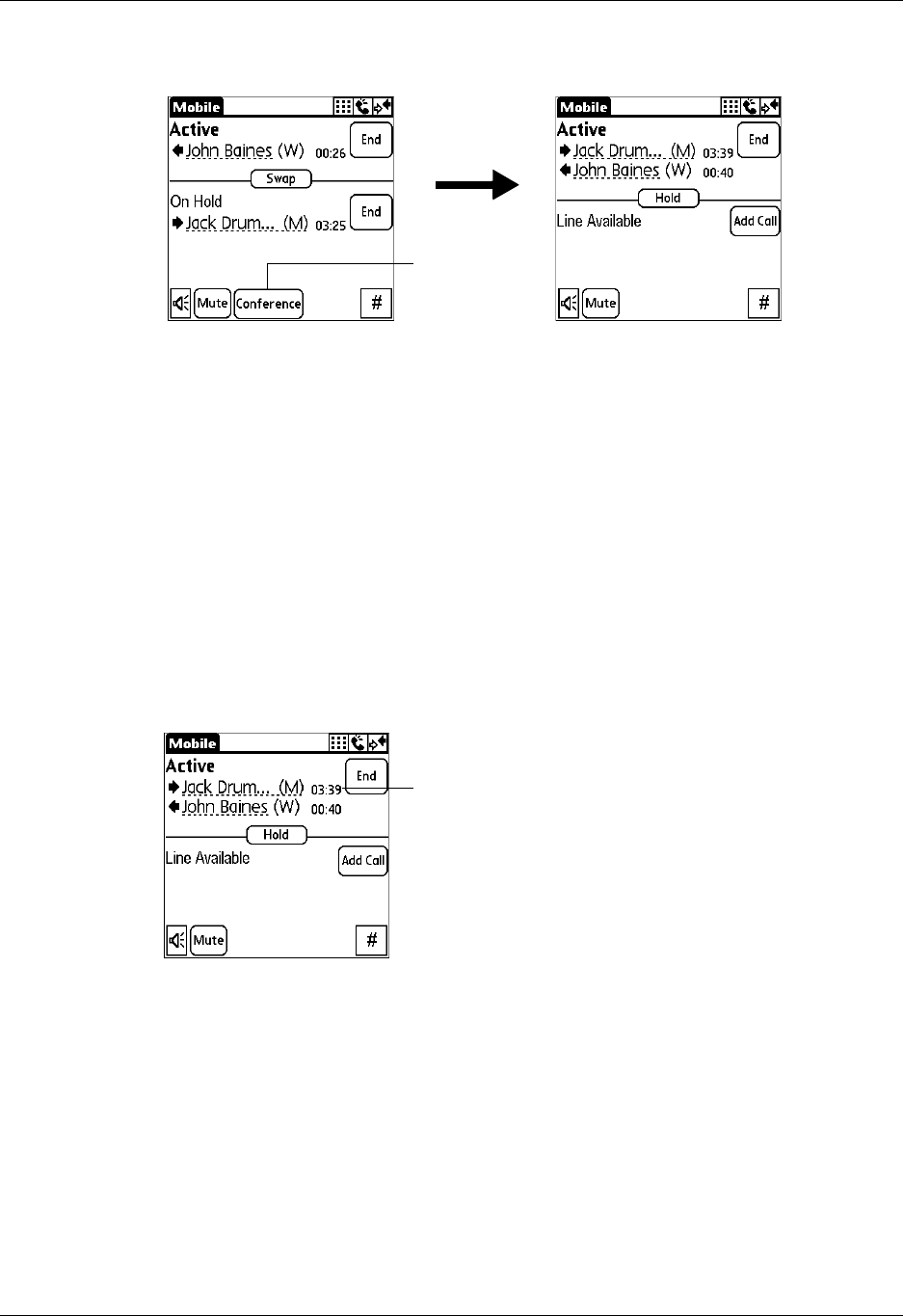
Chapter 11 Using Palm™ Mobile
11 4
3. Once the number appears as the Active caller, tap Conference.
Managing a conference call
Palm Mobile enables you to manage all parts of a conference call. You can do the
following:
■Have a private conversation with one of the callers while the other callers are
put on hold
■Mute the microphone on your earbud cable
■Disconnect one participant from the conference call
■Disconnect all participants from the conference call
To have a private conversation with one caller:
1. Tap name.
Ta p
Conference
Ta p n a m e
Palm, Inc. Confidential

Using conference calling
115
2. Tap Private Conversation.
3. Tap Conference to end the private conversation and return to the conference
call.
To disconnect one caller:
1. Tap name.
2. Tap Disconnect Call.
Ta p Pr i v a t e
Conversation
Ta p n a m e
Tap Disconnect
Call
Palm, Inc. Confidential

Chapter 11 Using Palm™ Mobile
11 6
To add a caller to a current conference call:
1. Tap Add Call.
2. Enter the number and tap Dial.
3. Once the number appears as the Active caller, tap Conference to add callers on
hold.
To end the conference call:
■Tap End.
To mute the conference call:
■Tap Mu te.
Tap Add Call to add caller
Tap End
Ta p M u te
Palm, Inc. Confidential
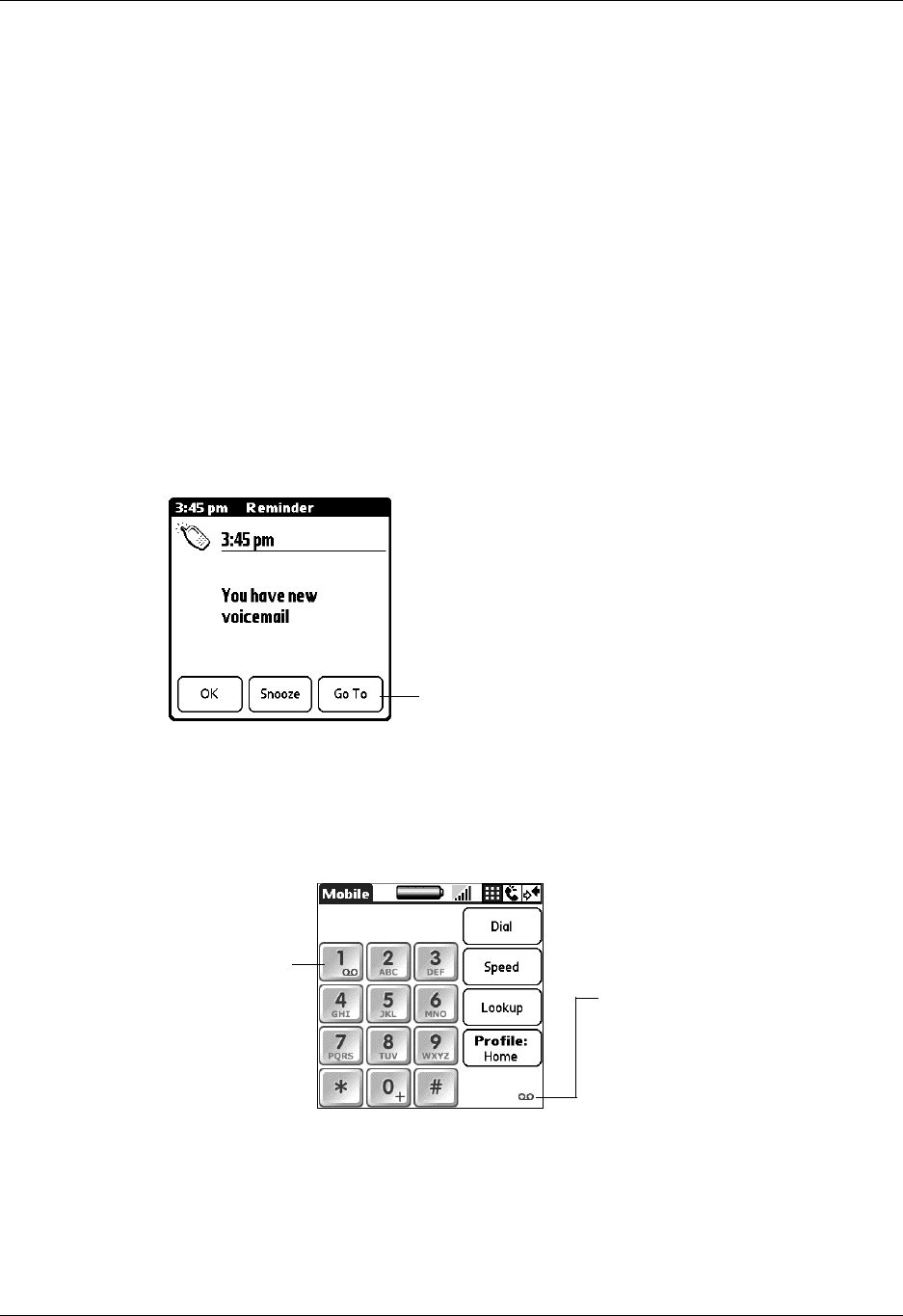
Retrieving voicemail
117
Retrieving voicemail
NOTE Your wireless service provider determines your voicemail properties, such as
mailbox size, the number of rings before diverting a call to voicemail, and how to
record your voicemail message. Contact your wireless service provider for
information on setting up your voicemail.
When a voicemail message is waiting, a notification message is displayed. You can
retrieve your voicemail messages directly from the notification message or from
the Palm Mobile application. Your voicemail access number is configured in the
Mobile preferences screen. See “Keyboard Preferences” in Chapter 21 for more
information.
To retrieve voicemail from a notification message:
■Tap Go To.
Your voicemail number is dialed.
To retrieve voicemail message from Palm Mobile:
■Press and hold the 1 key.
Your voicemail number is dialed.
Tap Go To to dial voicemail number
Voicemail icon indicates
voicemail message
available
Press and
hold the 1 key
to retrieve
voicemail
Palm, Inc. Confidential
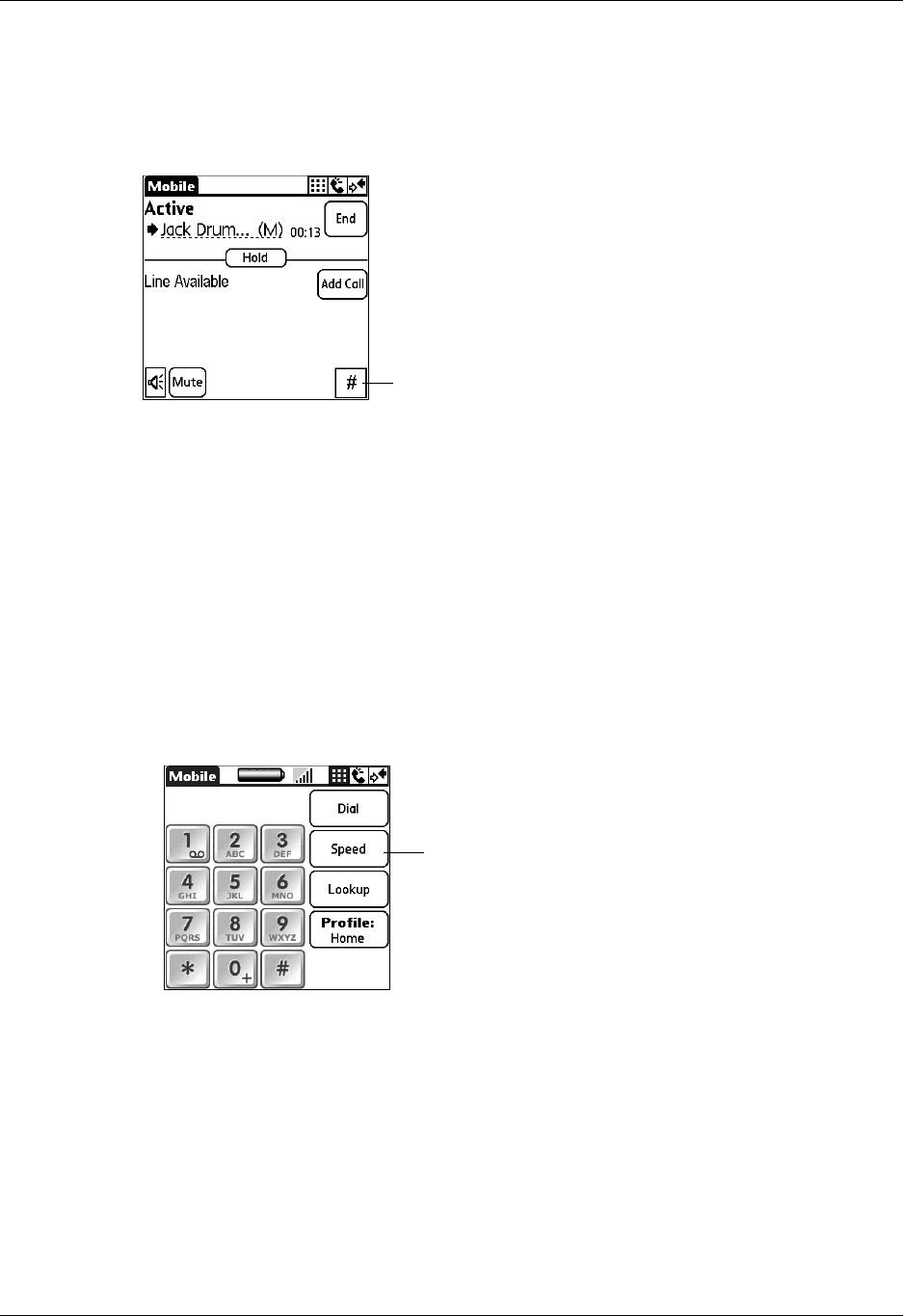
Chapter 11 Using Palm™ Mobile
118
TIP If you need to enter digits during the phone call to access voicemail or an
automated phone answering system, press the Keypad icon and use the on-screen
keypad to enter the digits. Also, you can enter the numbers or characters from the
keyboard.
Using speed dial
Speed-dialing enables you to quickly dial your most commonly used numbers.
The three speed-dial categories enable you to save 24 numbers.
Creating a speed-dial entry
You can use your Address Book to create a speed-dial entry.
To create a speed dial entry:
1. Tap Speed.
Tap to access keypad
Tap Speed
Palm, Inc. Confidential
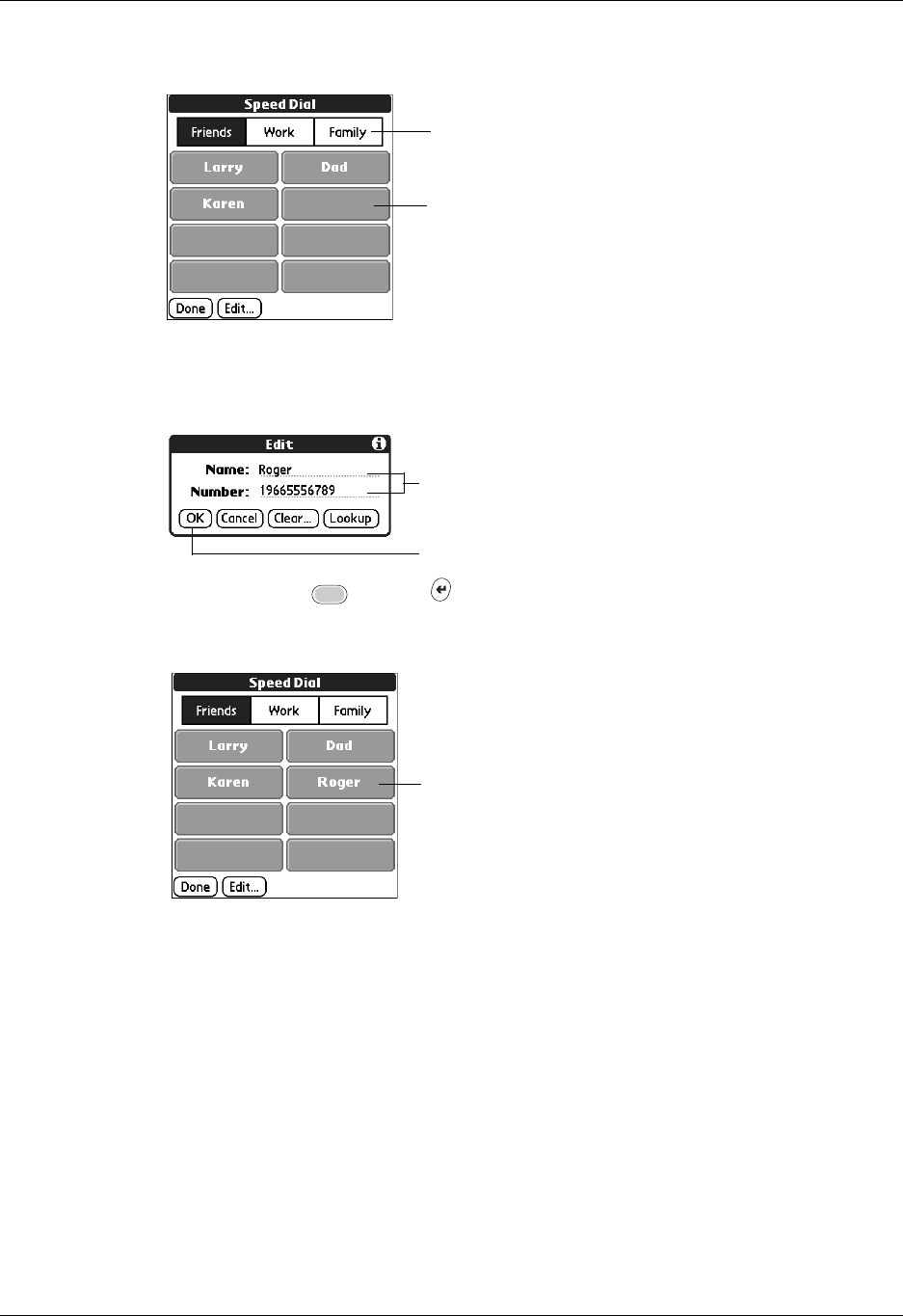
Using speed dial
119
2. Tap a category and then tap an empty speed-dial button.
3. Enter a name and telephone number.
You can type the letter “p” or a comma (,) to add a two second pause.
4. Press Function + Enter , or tap OK.
The name appears on the speed-dial button.
5. Tap Do n e.
Dialing a speed-dial entry
Before you can dial speed-dial entries, you must create them. For information on
creating speed-dial entries, see “Creating a speed-dial entry” earlier in this
chapter.
Tap empty speed-dial button
Tap category
Enter name and number
Tap OK to add entry
Entry added to speed-dial list
Palm, Inc. Confidential
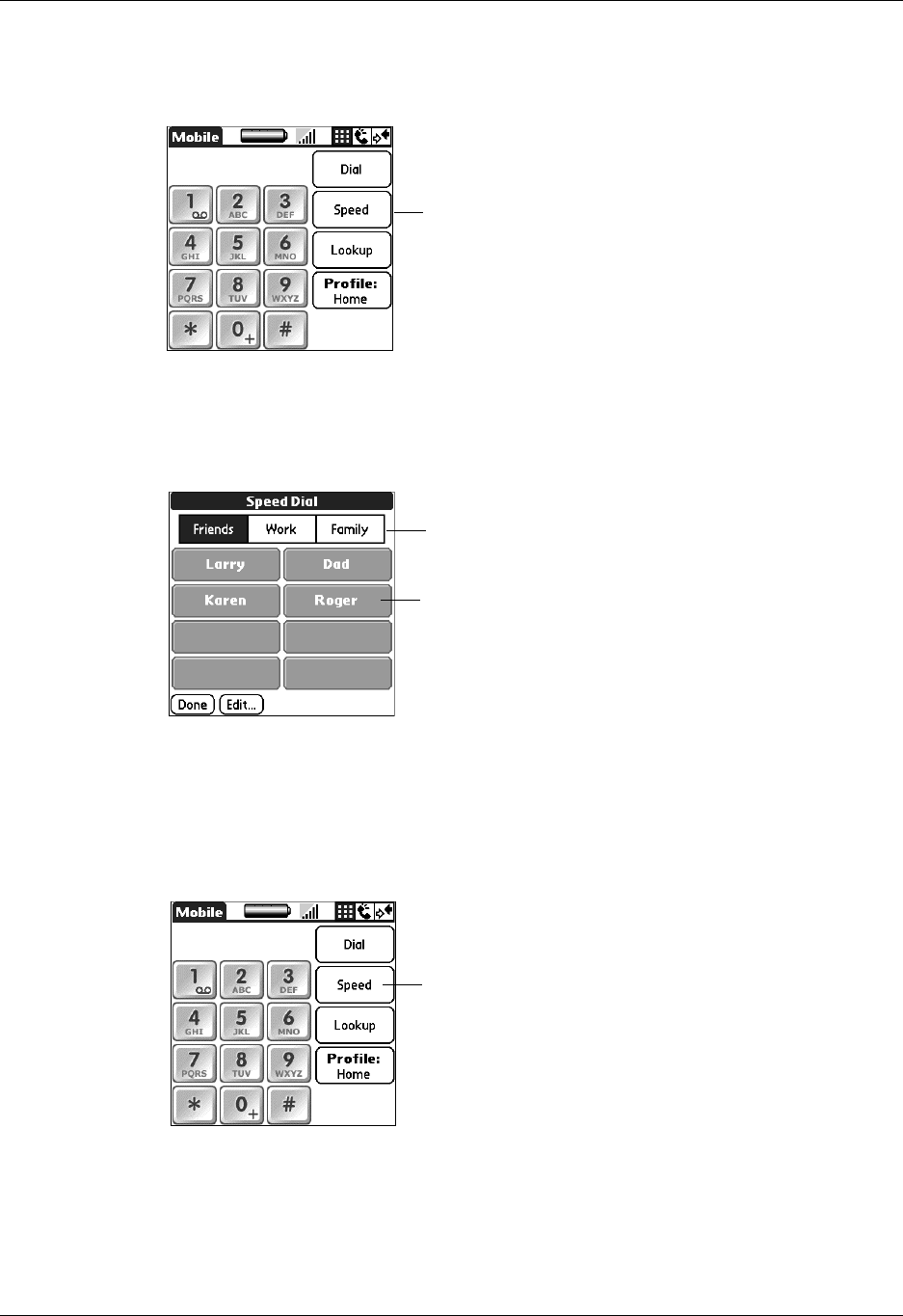
Chapter 11 Using Palm™ Mobile
120
To dial a speed-dial entry:
1. Tap Speed.
2. Tap a category and then tap one of the speed-dial buttons.
The number is dialed and added to the Call History list. You are now ready to
communicate.
Editing a speed-dial entry
To edit a speed-dial entry:
1. Tap Speed.
Tap Speed
Tap a speed-dial button to dial the number
Tap a category for other speed-dial lists
Tap Speed
Palm, Inc. Confidential
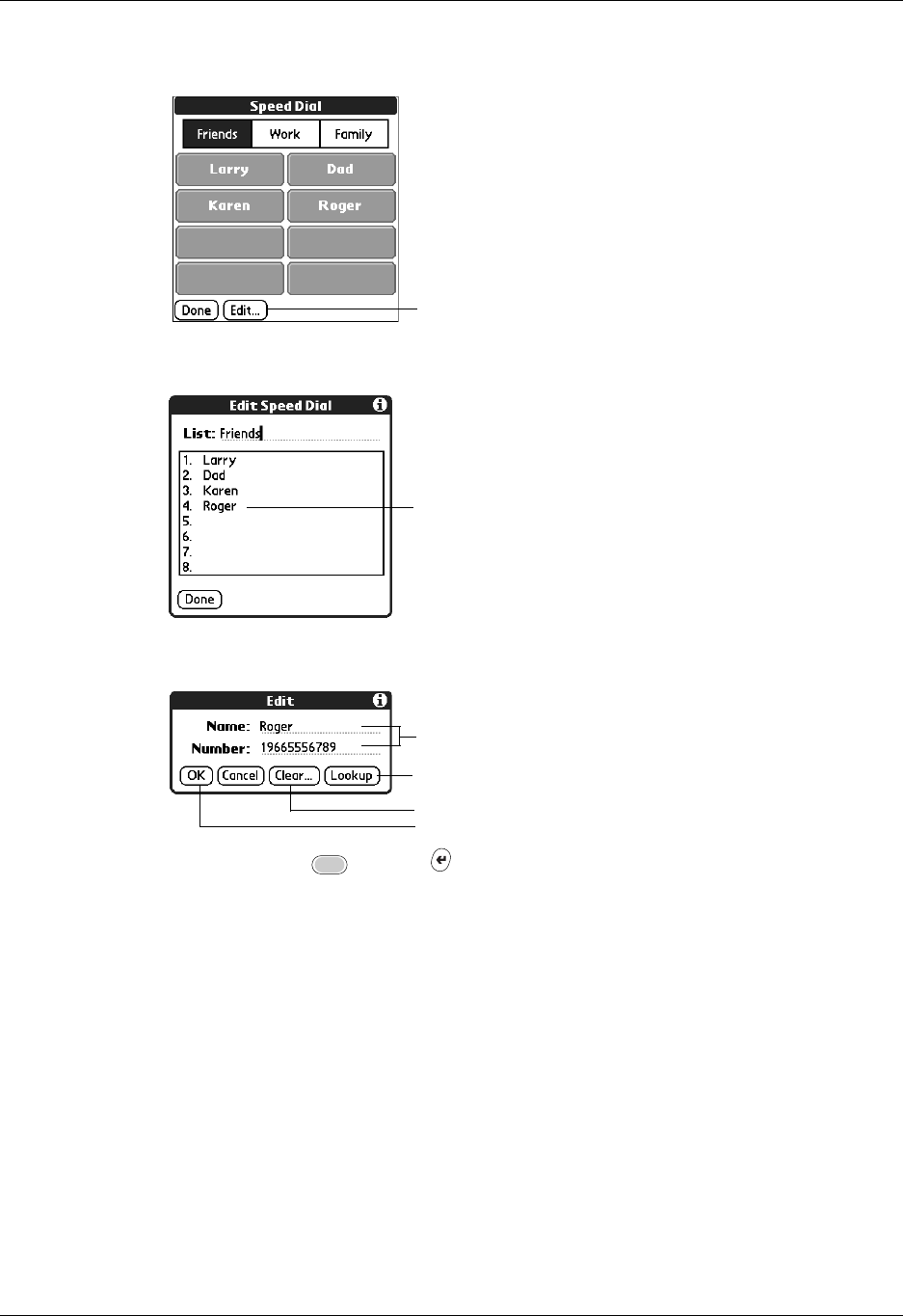
Using speed dial
121
2. Tap Edit.
3. Tap an entry.
4. Edit the entry.
5. Press Function + Enter , or tap OK.
Tap Edit
Tap an entry
Edit name and number
Tap Clear to delete current entry
Tap OK to change entry
Tap Lookup to go to the lookup option
Palm, Inc. Confidential
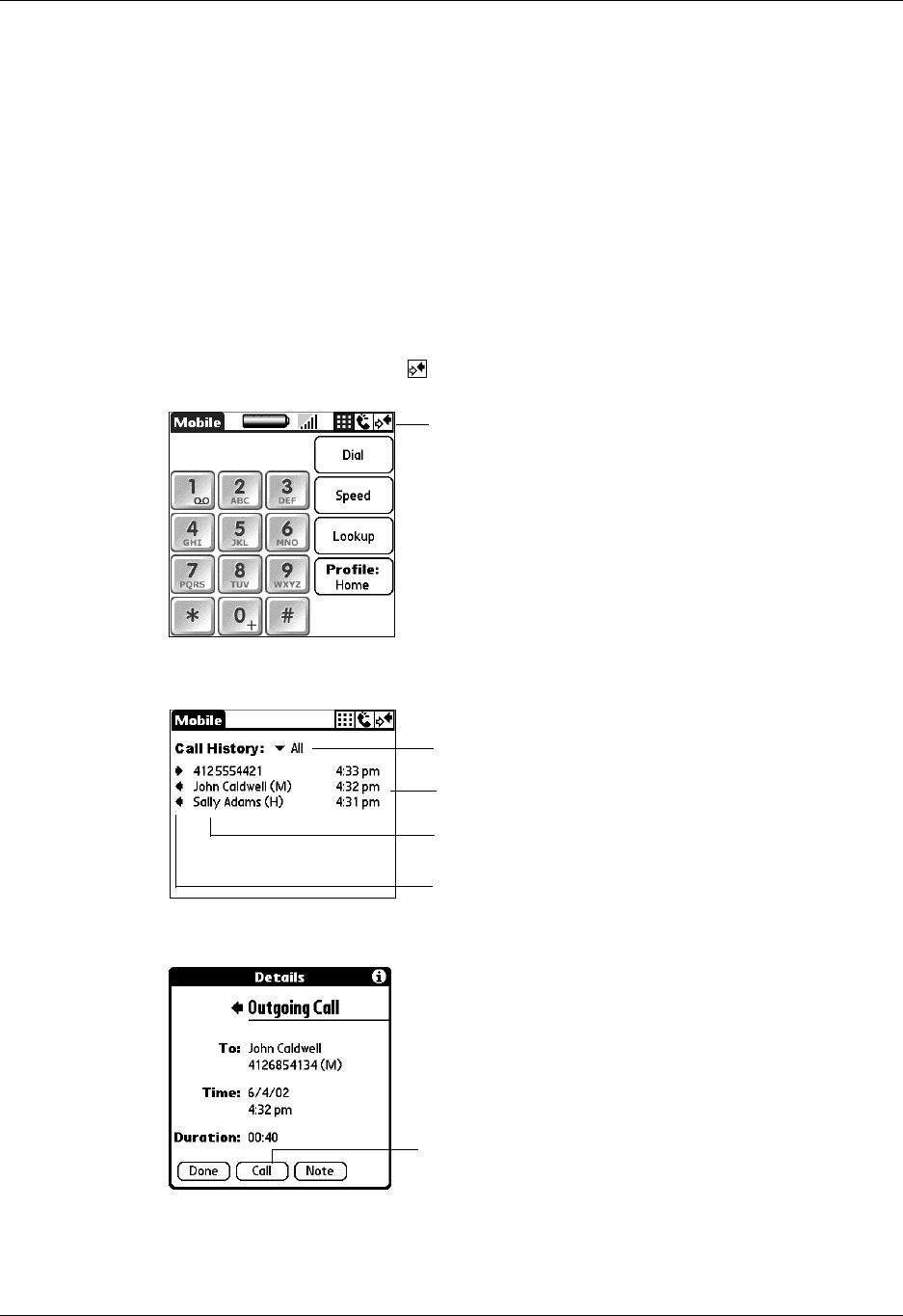
Chapter 11 Using Palm™ Mobile
122
Using the Call History list
Your handheld keeps a list of 20 of the most recently dialed numbers. If the number
is an Address Book entry, the name from the Address Book entry appears in the
Call History list.
You can also add an entry from Call History to your Address Book.
Dialing a number from the Call History list
You can dial a number using the Call History list.
To dial a number from the Call History list:
1. Tap the Call History icon .
2. Tap an entry from the list.
3. Tap Call.
Tap Call History icon
Number or name if number is an Address Book entry
Tap entry
Tap Show pick list to specify list
Indicates incoming or outgoing call
Tap Call
Palm, Inc. Confidential

Using redial reminders
123
Using redial reminders
A redial reminder notifies you of an appointment you set to make a call. The
reminder gives you the standard option to make the call, snooze, or go to the
Reminders menu.
Creating a redial reminder
You can create a redial reminder from the Call Actions screen and from the Mobile
dialog box.
To create a redial reminder:
1. Tap Set Reminder or Set Redial Reminder.
2. Set the date, time, and alarm.
3. Press Function + Enter , or tap OK.
Palm, Inc. Confidential
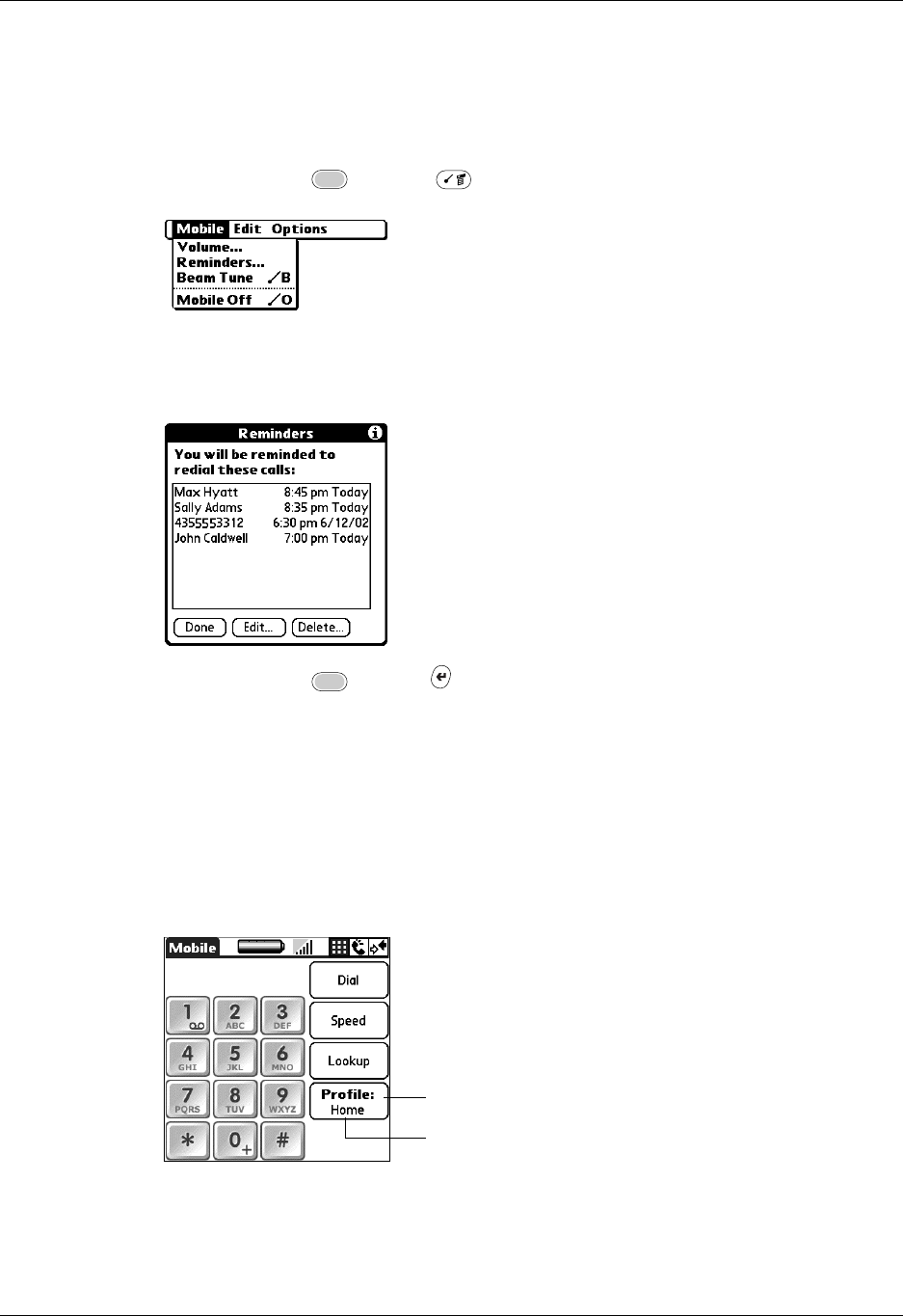
Chapter 11 Using Palm™ Mobile
124
Managing redial reminders
You can view and edit your redial reminders.
To view and edit the redial reminder list:
1. Press Function + Menu .
2. Select Reminders.
3. Edit your redial reminders.
4. Press Function + Enter , or tap Done.
Managing profiles
The phone profiles store settings for call diverting and the ringer. You can set up
to six profiles.
To change your currently active call profile:
1. Tap Profile.
Name of currently active profile
Tap Profile
Palm, Inc. Confidential

Managing profiles
125
2. Tap one of the profiles.
To edit your call profiles:
1. Tap Profile.
2. Tap Edit Profiles.
3. Tap a profile.
Ta p
Profile
Vibrate on
Ringer off
Vibrate on
Ringer off
Call forwarding on
Palm, Inc. Confidential

Chapter 11 Using Palm™ Mobile
126
4. Edit the profile.
You can edit the following settings:
5. Press Function + Enter , or tap OK.
6. Press Function + Enter , or tap Done.
Managing ring tunes
You can choose a ringer tune from a tune list for each of your profiles (see
“Managing profiles” earlier in this chapter). You can manage the list of available
tunes from the Select Tune screen by deleting tunes and beaming tunes to other
devices. You can also receive tunes beamed from other devices. For more
information on receiving beamed information, see “Using elements of the
handheld interface” in Chapter 3.
Name The name of your profile. Car and Cradle profile names cannot
be changed.
Volume Adjusts the volume level or turns off the ringer.
Tune Sets the tune of the ringer. There are multiple tunes and ring
styles to choose from. When you make a selection, the tune
plays.
Vibrate Sets the vibrator option to on, off, or vibrate then ring.
Forward to Sets the call forwarding option to off, forward to voicemail, or
other. If you select other, a field appears where you can enter the
phone number you want to forward the call to.
Activate in
Cradle Car and Cradle profiles only: Auto-activates the profile when the
handheld is placed in the cradle. When the handheld is removed
from the cradle, the original profile is restored.
Default Changes the options to the default settings in each list.
All other profiles
Car and Cradle profile
Palm, Inc. Confidential
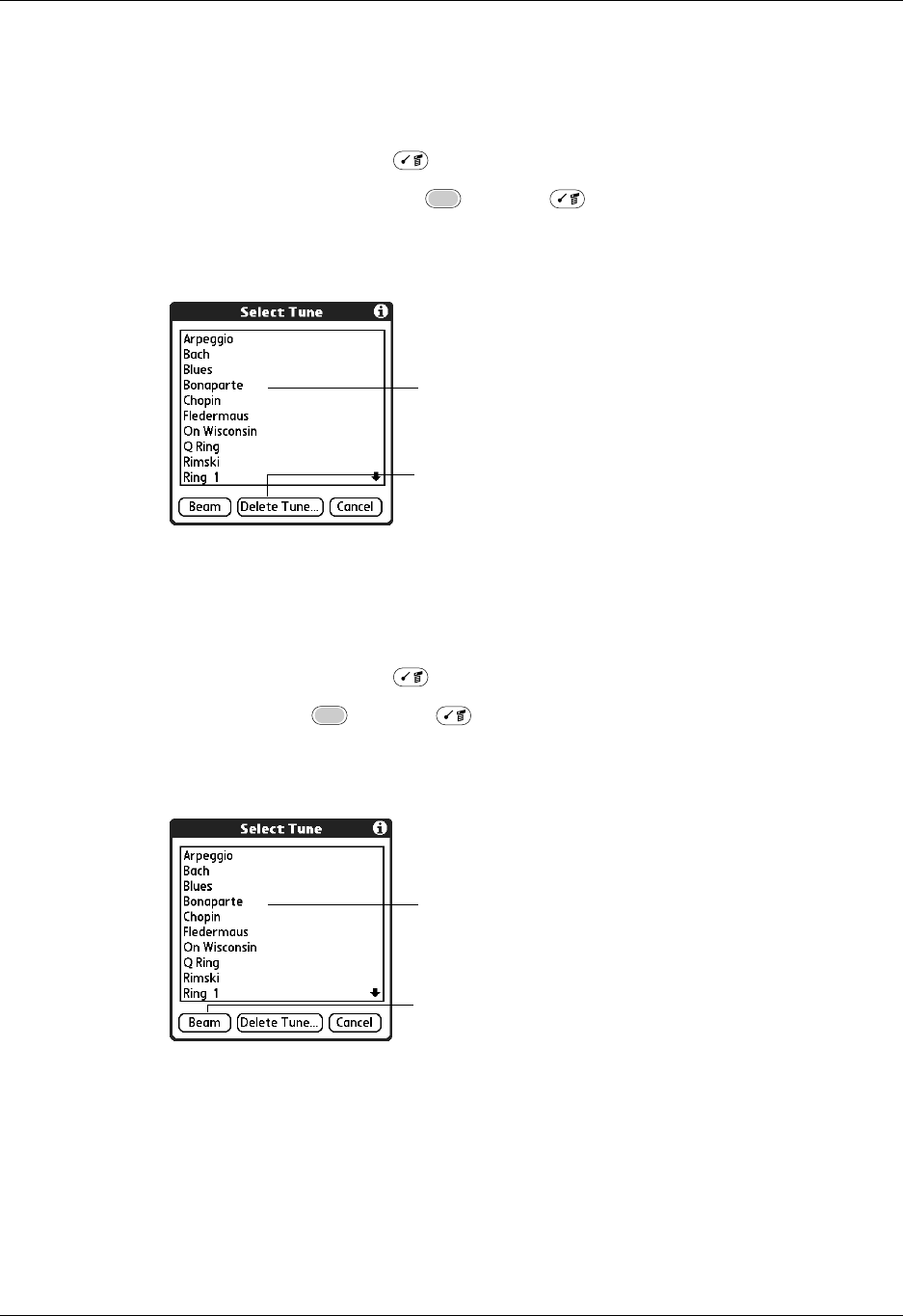
Managing ring tunes
127
NOTE You can receive Nokia ring tunes, but you cannot send them to another
device.
To delete a ring tone:
1. Press Command Stroke + B.
Alternately, press Function + Menu , and then select Beam Tune from
the Mobile list.
2. Tap a ring tune.
3. Tap Delete Tune.
4. Tap Delete.
To beam a ring tune:
1. Press Command Stroke + B.
Press Function + Menu , and then select Beam Tune from the Mobile
list.
2. Tap a ring tune.
3. Tap Beam.
Tap to select ring tune
Tap Delete Tune
Ta p B e a m
Tap to select ring tune
Palm, Inc. Confidential
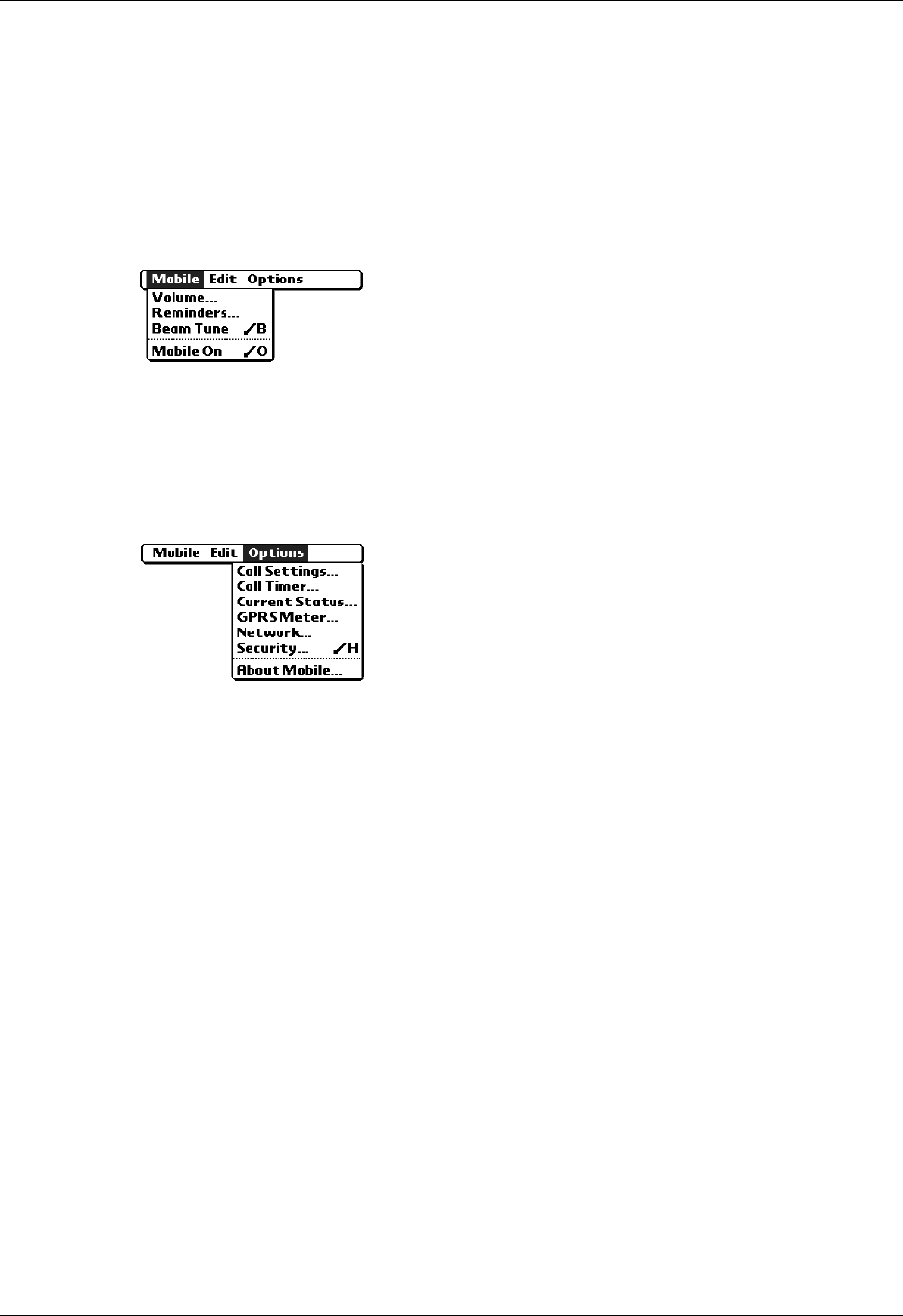
Chapter 11 Using Palm™ Mobile
128
Using Palm Mobile menus
The Palm Mobile menus are shown here for your reference, and menu features that
are not explained elsewhere in this book are described here.
See “Using menus” in Chapter 4 for information about choosing menu commands.
Mobile menu
Options menu
Mobile On
Mobile Off Turns the mobile radio on or off.
Call Settings Opens the Call Settings preferences screen where you can do
the following:
■Set call waiting. See “Enabling call waiting” in Chapter 21.
■Conceal your number. See “Concealing your number” in
Chapter 21.
■Divert your calls. See “Diverting your calls” in Chapter 21.
Call Timer Opens the Call Timer preferences screen where you can
track your phone time. See “Tracking your phone time” in
Chapter 21.
Current Status Opens the Current Status preferences screen where you can
check the status of your connection. See “Checking your
current status” in Chapter 21.
GPRS Meter Opens the GPRS preferences screen where you can check the
status of your connection. See “Checking your GPRS network
usage” in Chapter 21.
Palm, Inc. Confidential

Using Palm Mobile menus
129
Network Opens the Network preferences screen where you can do the
following:
■Customize your list of network carriers. See “Setting your
network selection search mode” in Chapter 21.
■View and customize your preferred network list.
See “Viewing and editing your preferred networks list” in
Chapter 21.
Security Opens the Security preferences screen where you can do the
following:
■Lock your mobile radio until a valid PIN code is entered.
See “Setting PIN for mobile power on” in Chapter 21.
■Bar or block different classes of incoming and outgoing calls.
See “Setting call barring” in Chapter 21.
■Set Fixed Number Dialing (FND) so that only pre-
programmed phone numbers in the FND phone book can be
dialed. See “Setting Fixed Number Dialing (FND)” in
Chapter 21.
About Mobile Shows version information for Palm Mobile.
Palm, Inc. Confidential

Chapter 11 Using Palm™ Mobile
130
Palm, Inc. Confidential
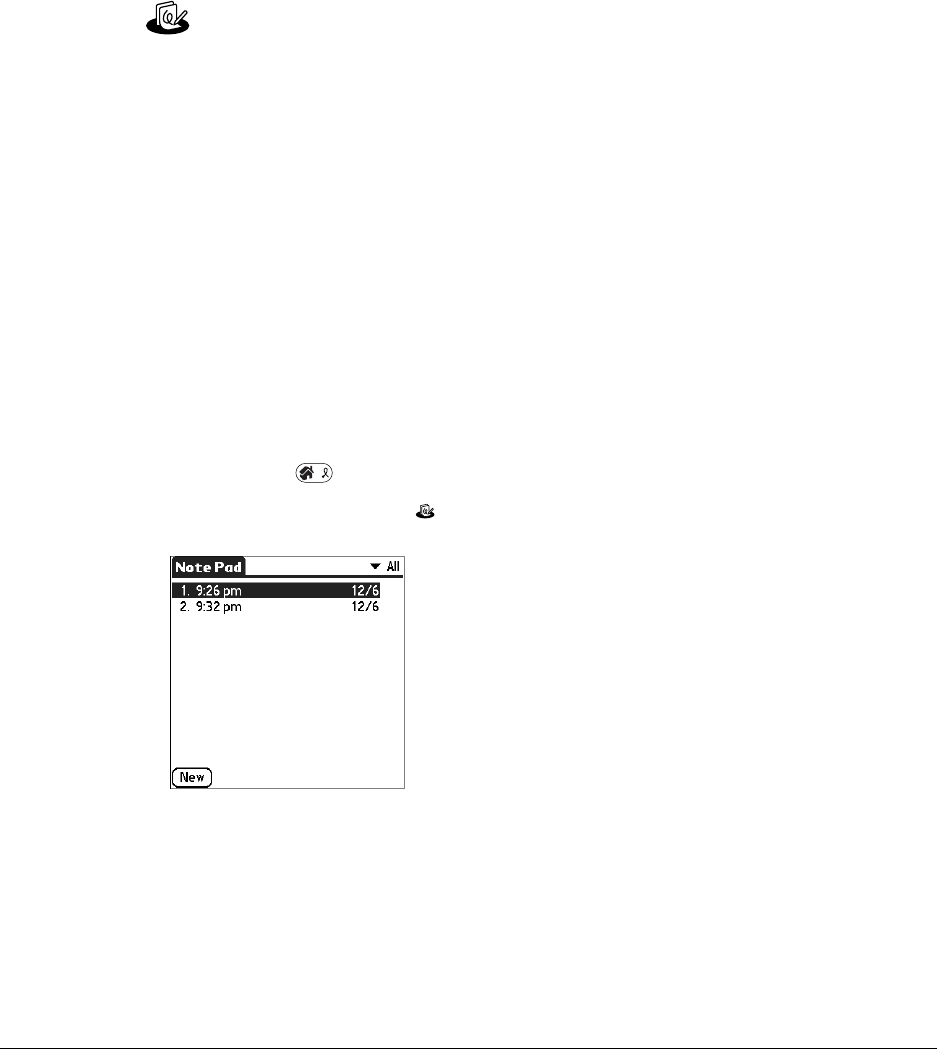
131
CHAPTER 12
Using Note Pad
Note Pad provides a place to take notes in your own handwriting. You can
use Note Pad to do everything you might do with a piece of paper and a
pencil. Use Note Pad to do the following:
■Take notes, draw a sketch, or write any kind of message directly on your
handheld screen. Later, you can enter this information into other applications.
■Set an alarm to use your notes as reminder messages.
■Assign notes to categories so that you can organize and view them in logical
groups.
■Exchange notes with other devices that have Note Pad 2.0 installed and that use
SMS.
■Use Palm™ Desktop software and HotSync® technology to copy and paste
notes into popular computer applications like Microsoft Word, or to send notes
as e-mail attachments.
To open Note Pad:
1. Press Home .
2. Select the Note Pad icon .
Palm, Inc. Confidential
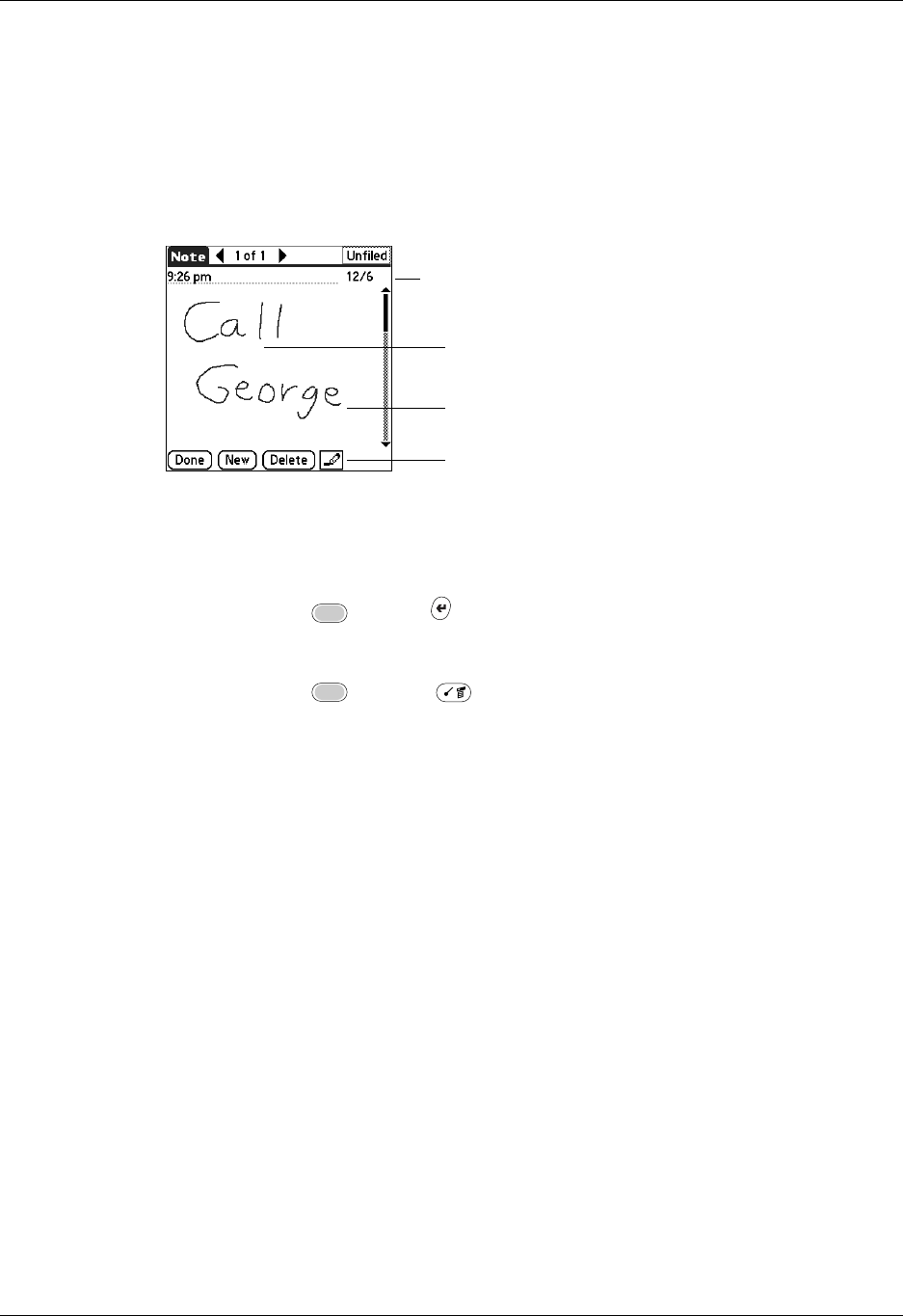
Chapter 12 Using Note Pad
132
Creating a note
A record in Note Pad is called a note. You can assign notes to categories and mark
them private as described in Chapter 4. This section covers how to create a note.
To create a new note:
1. Tap New.
2. Write the information directly on the handheld screen.
Tap the pen selector to select a different pen width, or select the eraser to
remove unwanted strokes.
3. Press Function + Enter , or tap Done.
To clear the screen:
1. Press Function + Menu .
2. Select Edit, and then select Clear Note.
Reviewing notes
The note title and the date you created the note appear in the Note Pad list. If you
did not assign a title to your note, the time you created the note appears as the note
title. This makes it easy to locate and review your notes.
Pen selector
Write
information
here
Enter title here
Eraser
Palm, Inc. Confidential
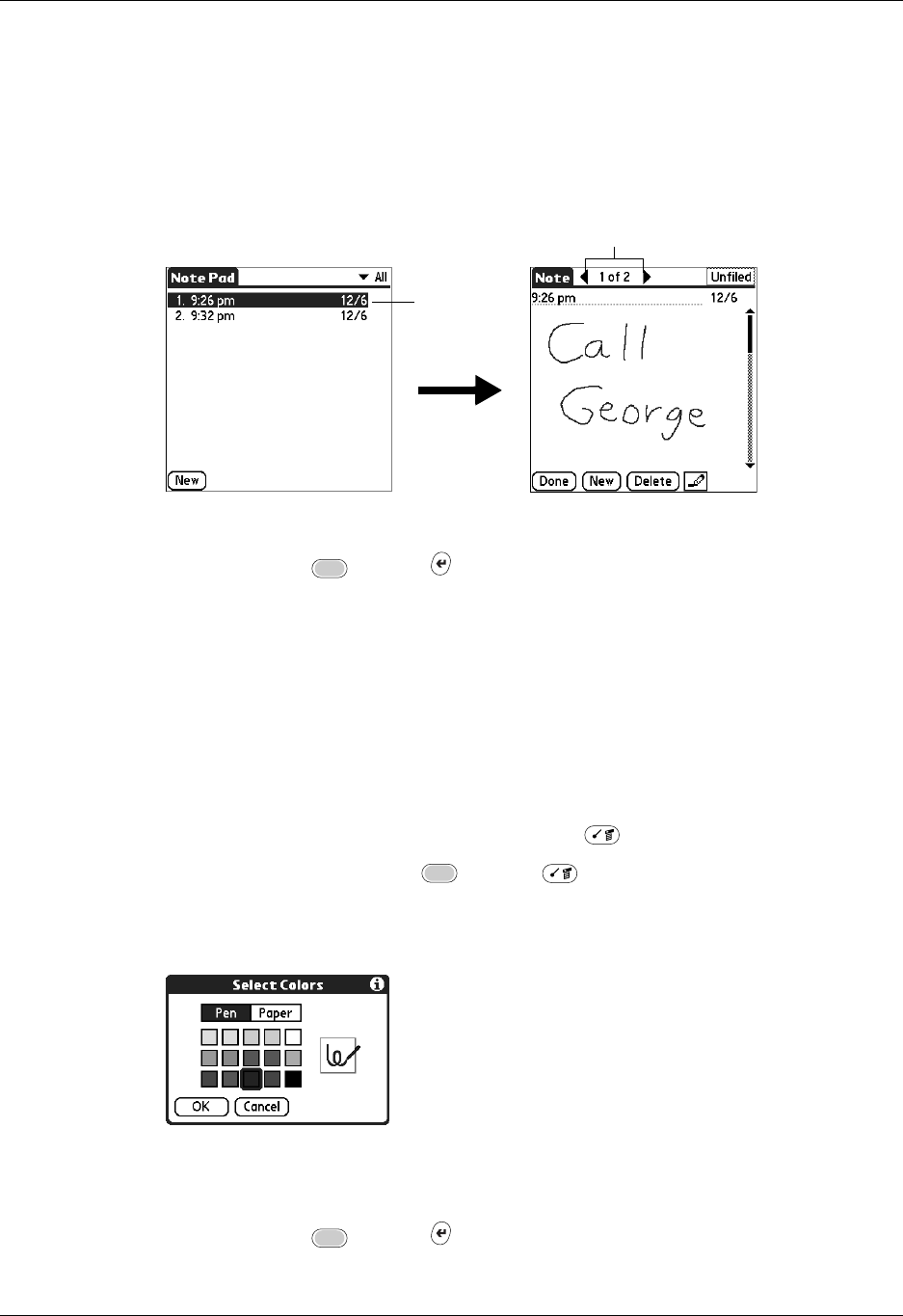
Changing Note Pad color settings
133
To review a note:
1. In the Note Pad list, select the note title.
TIP You can also select, review, and move between notes with the navigator.
See “Using the navigator” in Chapter 3 for details.
2. Review or edit the contents of the note.
3. Press Function + Enter , or tap Done.
Changing Note Pad color settings
By default, your notes appear with a white “paper” background, and the ink from
the pen is blue. You can change the color of both the paper and the ink from the
pen. Your color selections apply to all your notes. You cannot change the color
settings for individual notes.
To set the colors:
1. In the Note Pad list, press Command Stroke + R.
Alternately, press Function + Menu , and then select Preferences on the
Options menu.
2. Tap Co lor.
3. Tap Pen, and then tap the color of ink you want to use.
4. Tap Paper, and then tap the color of paper you want to use.
5. Press Function + Enter , or tap OK.
T
ap arrows to scro
ll
to
next and previous notes
Select a
note to view
Palm, Inc. Confidential
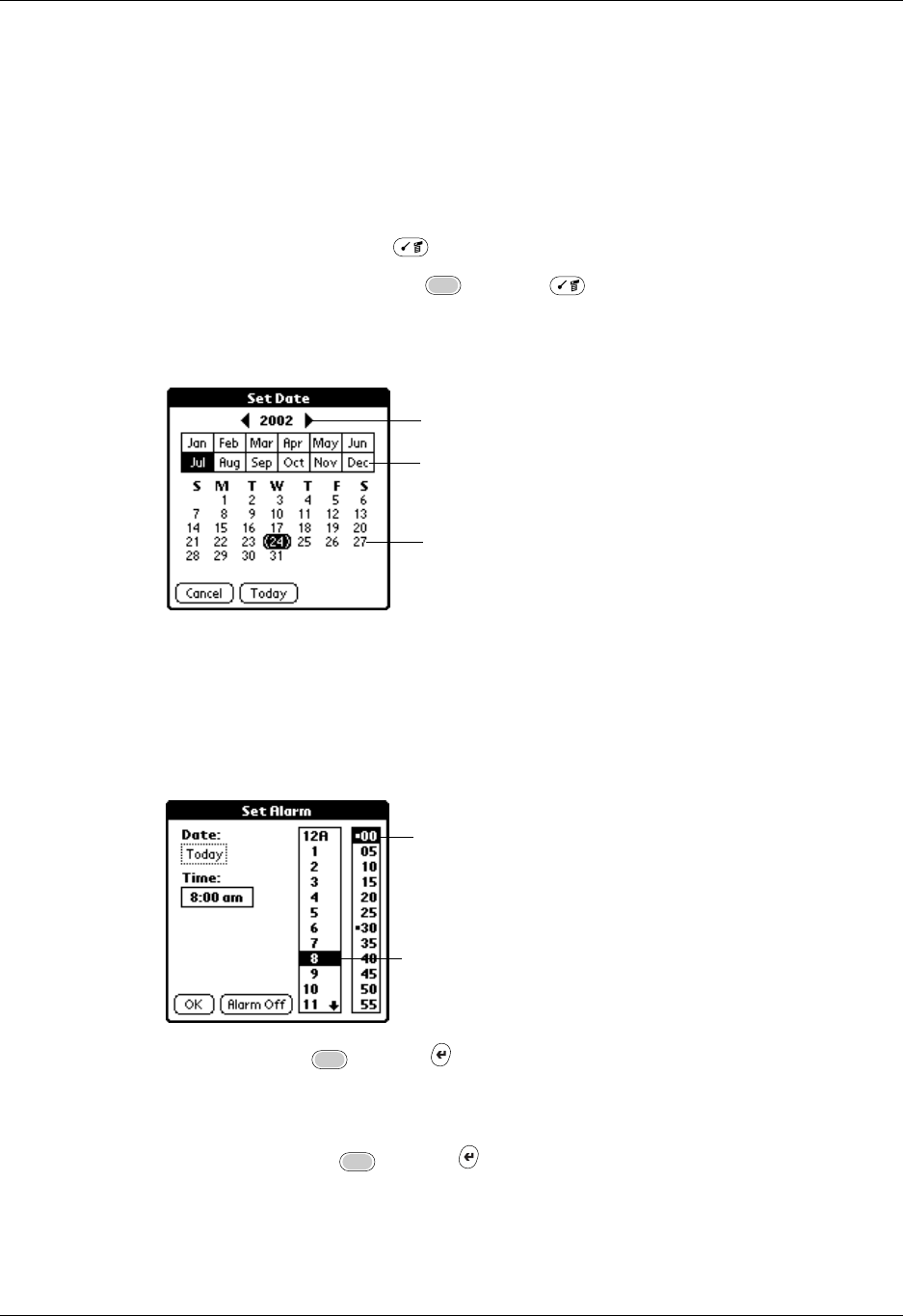
Chapter 12 Using Note Pad
134
Setting an alarm for a note
You can set an alarm for a specific time and date to remind you to follow up on
anote.
To set an alarm for a note:
1. Tap the note to which you want to assign an alarm.
2. Press Command Stroke + A.
Alternately, press Function + Menu , and then select Alarm on the
Options menu.
3. Tap the Date box.
4. Tap the year, month, and date you want the alarm to sound.
After you tap the date, the Set Alarm dialog box reappears.
5. Tap the Time box.
6. Tap the hour and minute columns to select the time you want the alarm to occur.
7. Press Function + Enter , or tap OK.
8. When the alarm goes off and the reminder message appears onscreen, do one of
the following:
– Press Function + Enter , or tap OK to permanently dismiss the
reminder and return to the current screen.
– Tap Snooze to dismiss the reminder and return to the current screen. An
attention indicator blinks in the upper-left corner of the screen to remind
Tap here to select month
Tap here to select year
Tap here to select date
Tap here to
select minutes
Tap here to
select hour
Palm, Inc. Confidential
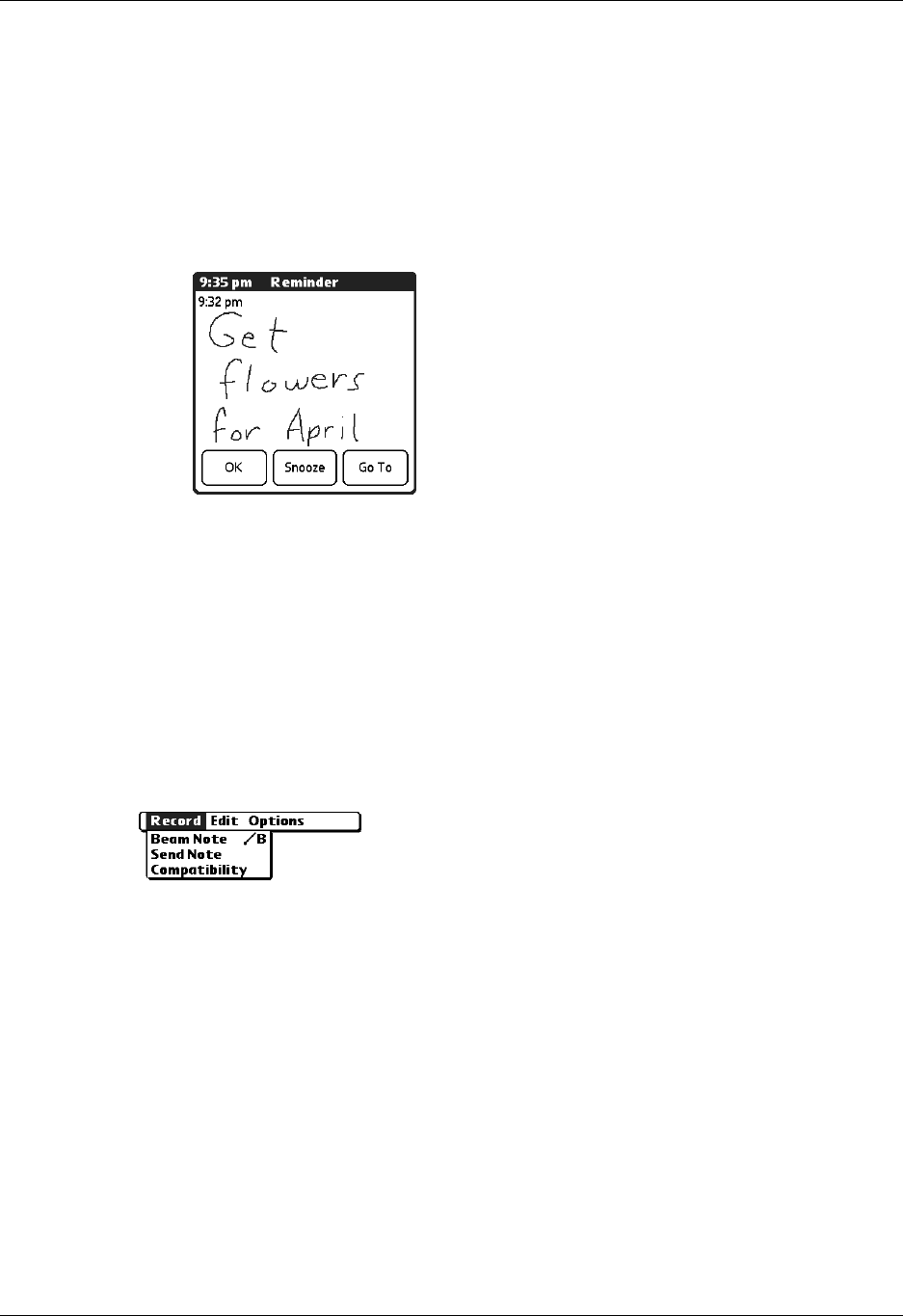
Using Note Pad menus
135
you of the pending alarm, and the reminder message appears again in
five minutes. When the reminder message reappears, the current time
appears in the Reminder bar and the note title appears on the screen.
– If you did not title the note, the time the note was created appears on the
screen.
– Tap Go To to open Note Pad. Note Pad will open and display the note
associated with the alarm.
Using Note Pad menus
Note Pad menus are shown here for your reference, and Note Pad features that are
not explained elsewhere in this book are described here.
The Record menu is the same when you’re viewing the Note Pad list and an
individual note. The Options menu differs depending on whether you’re viewing
the Note Pad list or an individual note.
Record menu
Send Category Opens a dialog box where you can choose how you want to
send all records in the selected category to another device. The
options available depend on the software installed on your
handheld.
Send Note Opens a dialog box where you can choose how you want to
send the selected note to another device. The options available
depend on the software installed on your handheld.
Compatibility Displays the Compatibility dialog box, where you can choose to
beam notes to a previous version of Note Pad.
Palm, Inc. Confidential

Chapter 12 Using Note Pad
136
Options menus
Preferences Displays the Note Pad Preferences dialog box, where you
define the pen and paper color, the sort order for notes, and the
alarm sound.
Details Displays the Note Details dialog box, where you assign a
category and privacy option for a note.
About Note Pad Shows version information for Note Pad.
Note Pad list Note screen
Palm, Inc. Confidential
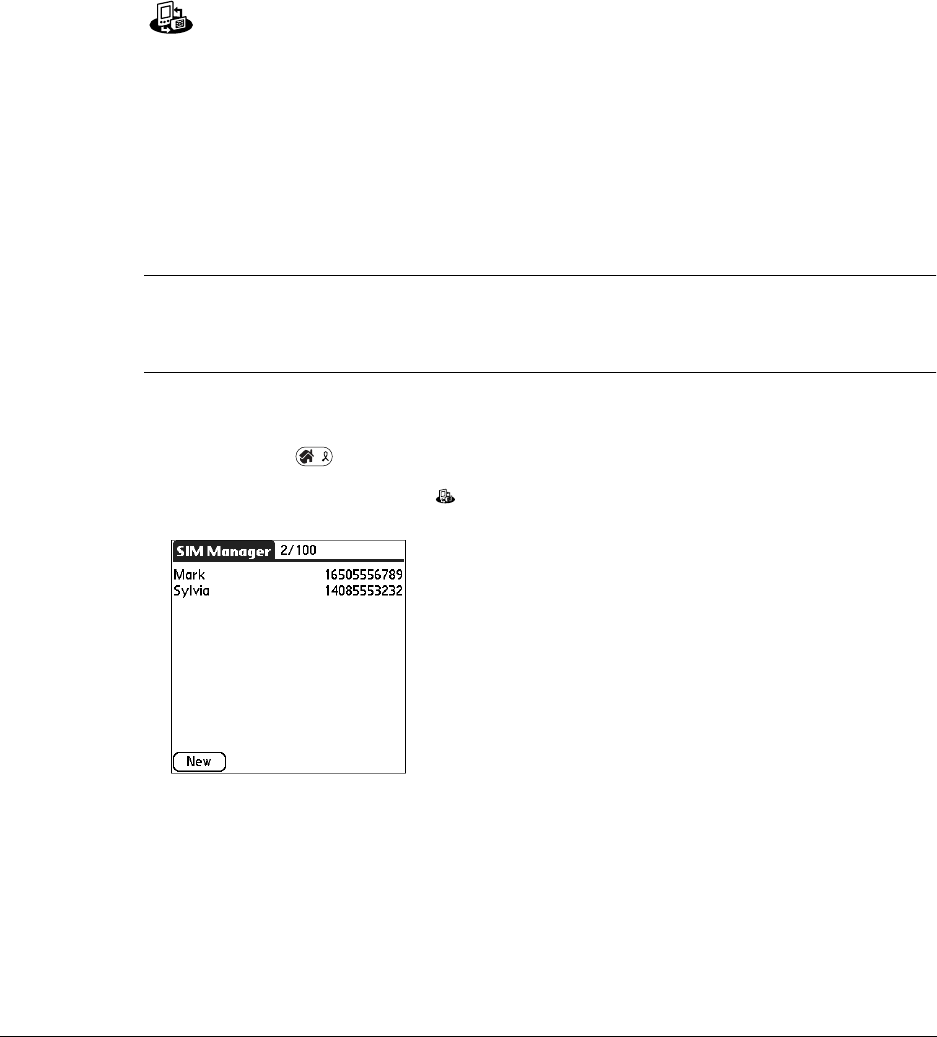
137
CHAPTER 13
Using SIM Manager
SIM Manager enables you to access the names and numbers residing on
your SIM card and then transfer the information to your Address Book. In
SIM Manager, you can do the following:
■View the names and numbers on your SIM card.
■Copy the information to your Address Book.
■Edit the record information.
■Copy Address Book information to SIM Manager.
IMPORTANT To access SIM Manager, you must first perform a HotSync® operation
with your handheld. SIM Manager is automatically loaded onto your handheld
during the first HotSync operation.
To open SIM Manger:
1. Press Home .
2. Tap the SIM Manager icon .
Palm, Inc. Confidential
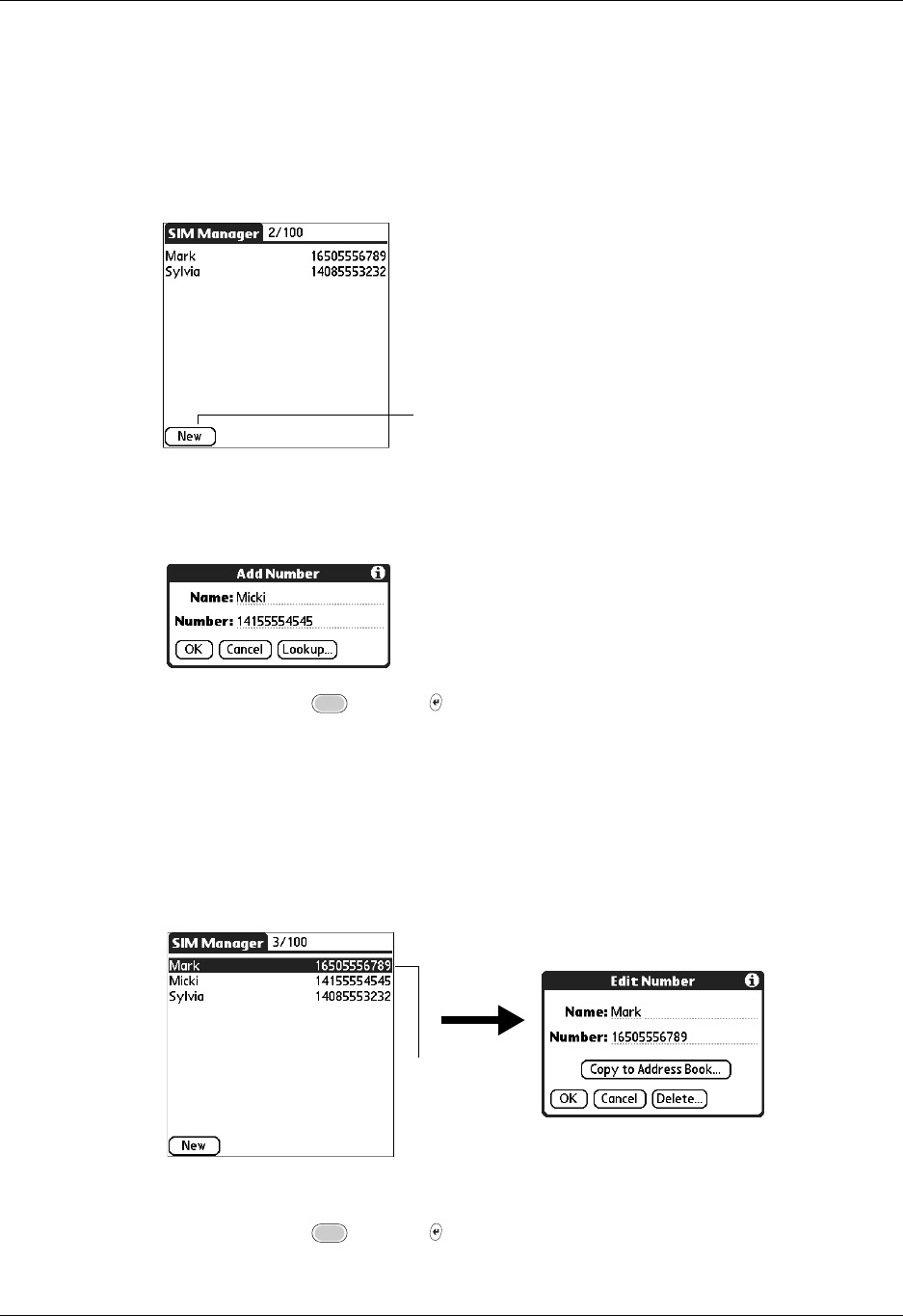
Chapter 13 Using SIM Manager
138
Adding SIM Manager items
A record in SIM Manager is called an item.
To add a a SIM Manager item:
1. Tap New.
2. Enter the name and number.
You can use the Lookup function to access numbers from your Address Book.
3. Press Function + Enter or tap OK.
Managing SIM Manager items
You can edit and delete items and copy items to the Address Book.
To edit or delete a SIM Manager item:
1. Tap an item.
2. Edit the information or delete the item.
3. Press Function + Enter or tap OK.
Ta p N e w
Tap item
Palm, Inc. Confidential

Using SIM Manager menus
139
To copy a SIM Manager item to the Address Book:
1. Tap an item.
2. Tap Copy to Address Book.
3. Do one of the following:
– Press Function + Enter or tap OK to add the item to the Address Book
and go back to the SIM Manager main screen.
– Tap Copy & Go to open the Address Book where you can enter all the
Address Book entry details.
Using SIM Manager menus
SIM Manager menus are shown here for your reference, and SIM Manager features
that are not explained elsewhere in this book are described here.
See “Using menus” in Chapter 4 for information about choosing menu commands.
Record menu
Options menu
Copy All to
Address Book Copies all items to the Address Book.
About SIM
Manager Shows version information for SIM Manager.
Palm, Inc. Confidential

Chapter 13 Using SIM Manager
140
Palm, Inc. Confidential

141
CHAPTER 14
Using SIM Services
SIM Services enables you to access applications stored on the SIM card.
These applications are provided by your wireless service provider. The
types of applications differ depending on your wireless service provider.
The following are examples of the kinds of applications that can be
provided:
■Access your bank account balance.
■Remind you of your number.
■Manage your network preferences, like prepaid account and Multi-SIM
settings.
■Request information, such as local traffic information, weather forecast, current
exchange rates, and stock values.
■Play games.
■Receive notification when a friend is in the vicinity.
■Manage your electronic purse and buy wirelessly.
■Find the nearest movie theater.
IMPORTANT Contact your wireless service provider for information on which
services are available.
Palm, Inc. Confidential

Chapter 14 Using SIM Services
142
Accessing a service
You can access the services provided by your wireless service provider.
IMPORTANT Instructions on how to use a service is provided by your wireless service
provider.
To access a service:
1. Press Home .
2. Tap the Services icon .
3. Tap a service and tap Launch.
Using the SIM Services menu
The SIM Services menu is shown here for your reference, and the SIM Services
feature that are not explained elsewhere in this book are described here.
See “Using menus” in Chapter 4 for information about choosing menu commands.
Options menu
About SIM
Services Shows version information for SIM Services.
Palm, Inc. Confidential

143
CHAPTER 15
Using SMS
The SMS application enables you to send and receive short text messages
using your handheld. The messages are sent to a mobile phone, using the
phone number as an address.
Most GSM mobile phone service providers have supported Short Message Service
technology for quite a while, and billions of SMS messages are exchanged each
month. Use SMS to do the following:
■Send messages to mobile phones.
■Review SMS messages.
■Use the keyboard on your handheld to quickly create SMS messages.
■Receive records associated with your other handheld applications. For
example, your boss can send you a Date Book event for a meeting you need to
attend. When you receive the message, you can choose to add it to your Date
Book or view the raw data as a text message.
IMPORTANT Whenever you use the wireless features of your handheld, please
observe the guidelines or prohibitions on the use of wireless devices in your current
location. For example, when you are on an airplane, do not turn on your radio at
times when government or airline regulations prohibit the use of cellular phones.
You can, of course, use all other applications of your handheld in accordance with
airline regulations for electronic devices.
Palm, Inc. Confidential

Chapter 15 Using SMS
144
To open SMS:
1. Press Home .
2. Tap the SMS icon .
Creating messages
When you create a message, the title bar indicates the number of characters the
message contains. If a message exceeds 160 characters, it is split into multiple
messages. When the recipient receives those messages, they may be reassembled
into a single message (provided the recipient’s SMS software supports assembling
multi-part messages). Otherwise, they will appear as two messages.
To create a message:
1. From any SMS list view, tap New.
2. Tap To.
Ta p N e w
Ta p To
Palm, Inc. Confidential

Creating messages
145
3. Tap the recipient’s name, and then tap Add.
TIP To send a message to someone who isn’t listed in your Address Book,
enter their mobile phone number on the To line. The mobile phone number
must be on a compatible SMS network–for example, a GSM network.
4. Enter the message text.
5. Tap Send or press Command Stroke + E to send the message now, or tap
Outbox to send the message later.
NOTE Tapping Send does not send any of the other messages in your Outbox.
It sends only the current message.
Ta p Se n d Ta p O u tb ox
Palm, Inc. Confidential

Chapter 15 Using SMS
146
Sending and receiving messages
You can send all the messages in your Outbox and retrieve all the new messages
at the same time.
To send and receive messages at the same time:
■Do one of the following:
– From any SMS list view, tap Send & Check.
– If you have assigned one of the application buttons to open SMS, press and
hold the SMS application button for two seconds. See “Buttons preferences”
in Chapter 21 for more information on assigning application buttons.
After the transmission finishes, a message appears, indicating the number of new
messages you received.
To send all messages in your Outbox:
■Do one of the following:
– From message view, press Command Stroke + E.
– From list view, press Command Stroke + S.
– From any view, press Function + Menu , and then select Send on the
Message menu.
To download all messages:
■From the list view, do one of the following:
– Press Command Stroke + H.
– From any view, press Function + Menu , and then select Check on
the Message menu.
Tap Send & Check
Palm, Inc. Confidential

Viewing messages
147
Viewing messages
SMS stores your messages in five separate categories:
In the Inbox and Outbox, icons appear next to the message to indicate whether it
has been read or sent. In the Inbox, additional icons indicate whether the message
is incomplete and whether it contains data other than text that requires another
application to read it.
TIP If you have assigned one of the application buttons to open SMS, you can press
the SMS application button to cycle through the categories. See “Buttons
preferences” in Chapter 21 for more information on assigning application buttons.
To view text messages in your Inbox:
1. Tap the category pick list in the upper-right corner.
2. Select Inbox.
Inbox Stores downloaded messages.
Outbox Stores messages waiting to be sent.
Tr a s h Stores messages you deleted. You can restore deleted messages to
their original category.
Archive Files messages you want to keep.
Draft Stores messages you want to change or review before you send
them.
Message contains data
from another application
Incomplete
message
Unread
message
Read
message
Palm, Inc. Confidential
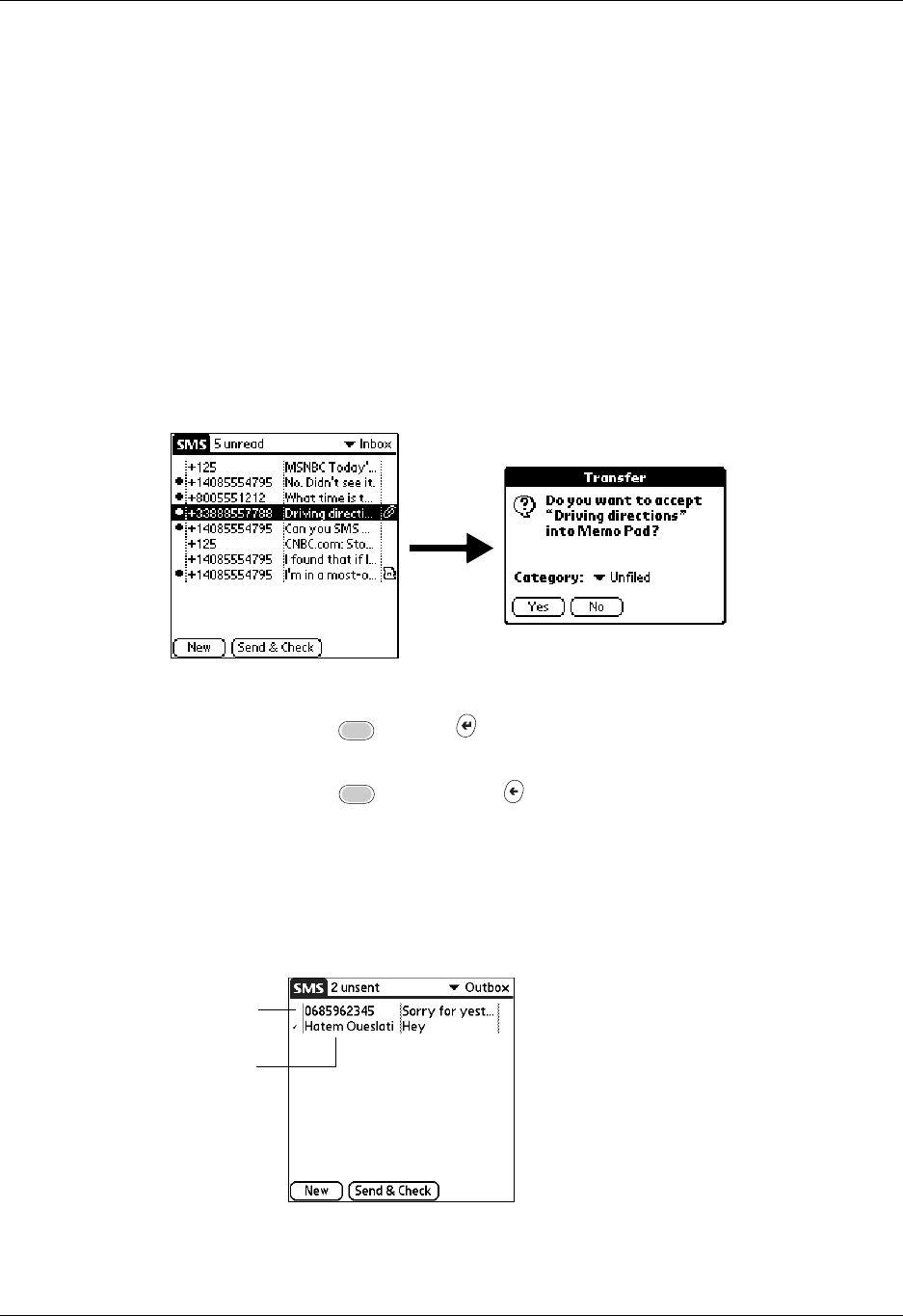
Chapter 15 Using SMS
148
3. Tap the message you want to view.
4. Tap one of the following:
Done: Returns to the list view.
Reply: Creates a message to the sender and copies any selected text into the new
message.
Delete: Moves the message to the Trash category.
To view data messages in your Inbox:
1. Tap the category pick list in the upper-right corner.
2. Select Inbox.
3. Tap the message you want to view.
4. Do one of the following:
– Press Function + Enter , or tap Yes to add the data to the appropriate
application.
– Press Function + Backspace or tap No to view the raw data as a text
message.
To view messages in your Outbox or Archive categories:
1. Tap the category pick list in the upper-right corner.
2. Select either Outbox or Archive.
3. Tap the message you want to view.
Unsent
message
Sent
message
Palm, Inc. Confidential
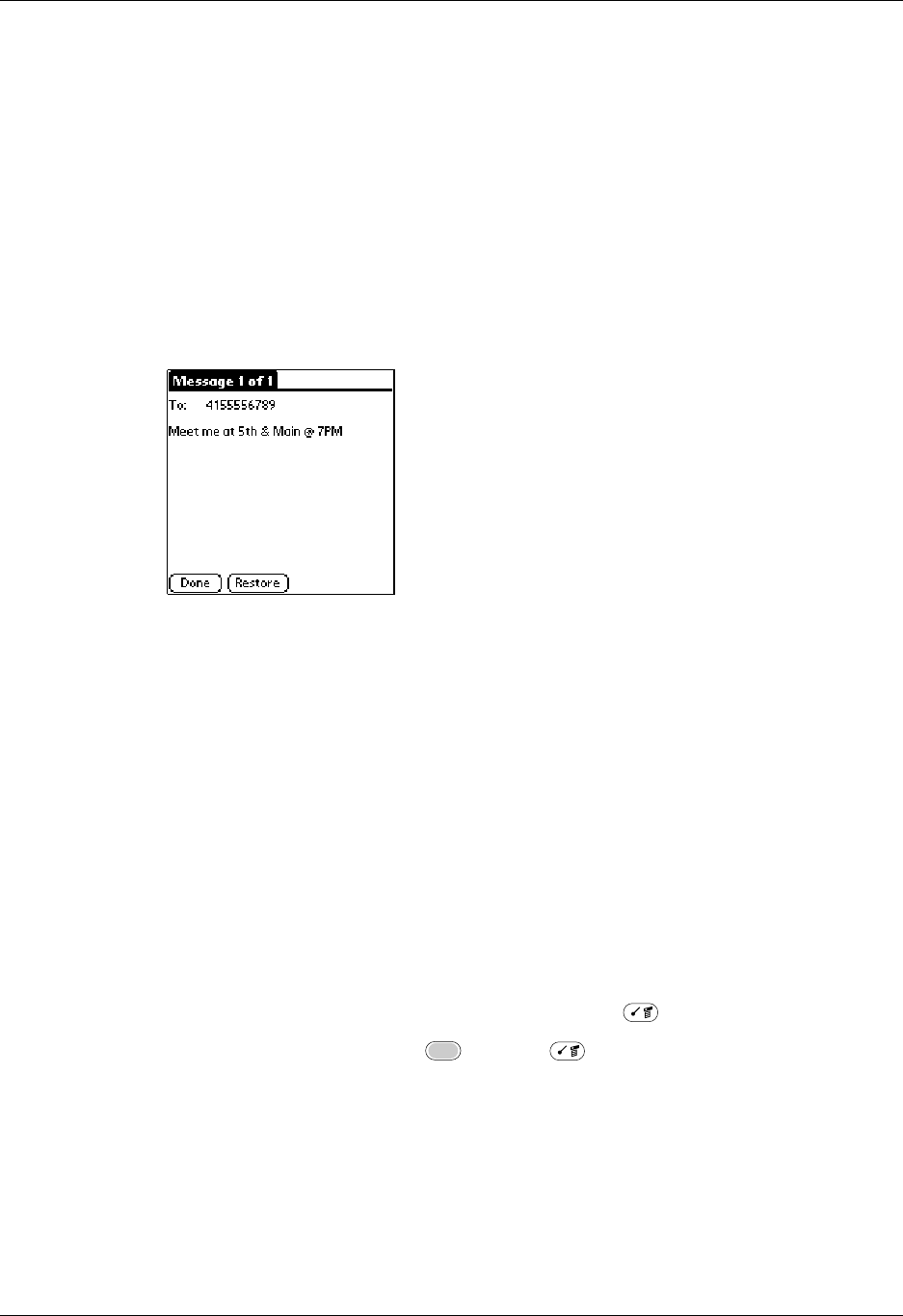
Working with draft messages
149
4. Tap one of the following:
Done: Returns to the list view.
Edit: Opens the message so you can modify the contents.
Delete: Moves the message to the Trash category.
To view messages in your Trash:
1. Tap the category pick list in the upper-right corner.
2. Select Trash.
3. Tap the message you want to view.
4. Tap one of the following:
Done: Returns to the list view.
Restore: Moves the message back to the category it was in when you deleted it.
Working with draft messages
When you create a message, you can save it as a draft message. SMS does not send
draft messages when you transmit the messages in your Outbox. You can store
draft messages for as long as you like and review and edit them before you send
them.
To place a message in the Draft category:
1. Create or open the message you want to store in the Draft category.
2. From the Message view, press Command Stroke + D.
Alternately, press Function + Menu , and then select Draft on the
Message menu.
To view or edit draft messages:
1. Tap the category pick list in the upper-right corner.
2. Select Draft.
3. Tap the message you want to edit.
Palm, Inc. Confidential
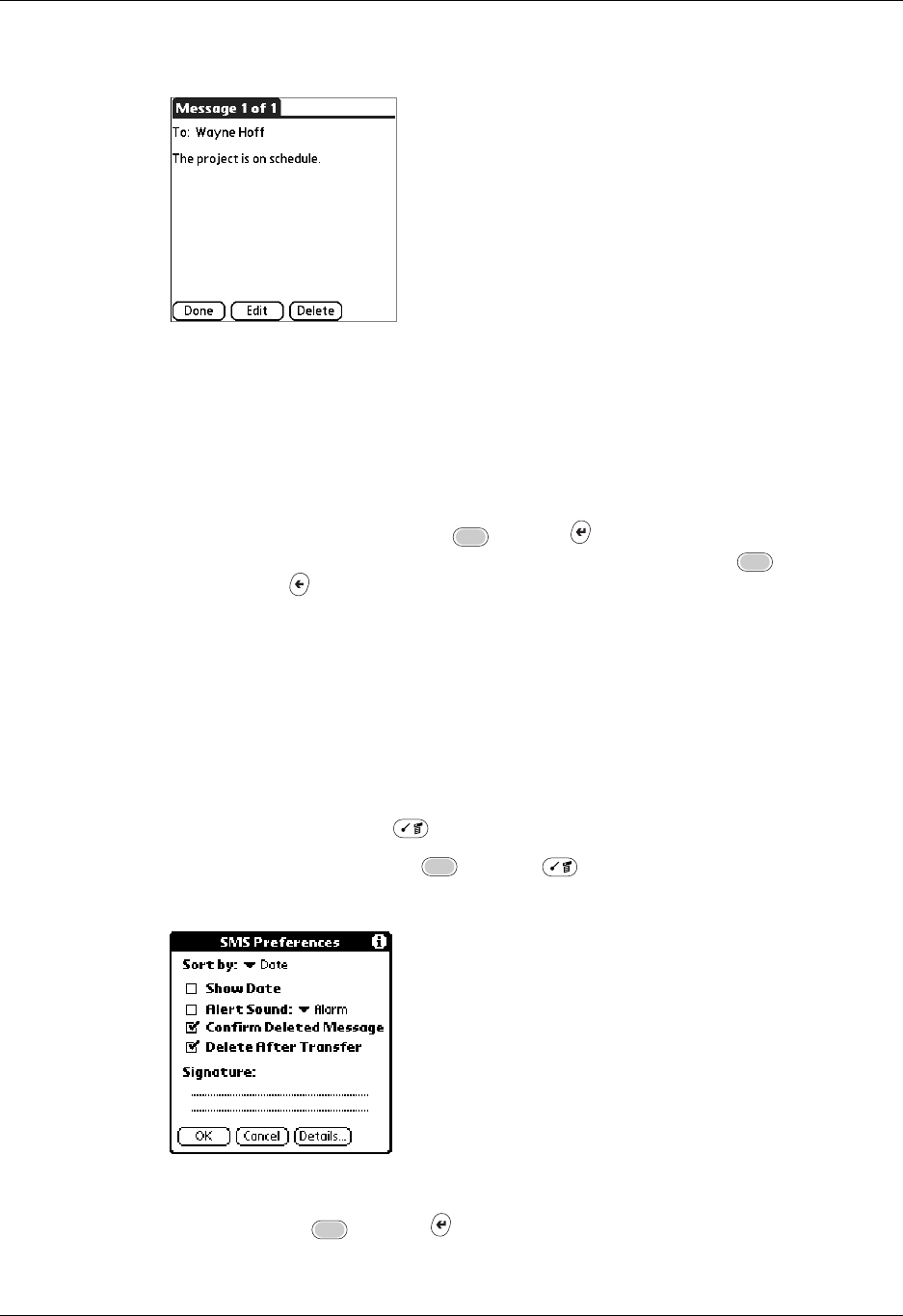
Chapter 15 Using SMS
150
4. In the message view, tap Edit.
5. Edit the message.
6. Tap one of the following:
Send: Sends the message now.
Outbox: Moves the message to the Outbox to be sent later.
7. Cancel: Opens a dialog box that asks if you want to save the message in the
Draft category. Press Function + Enter , or tap Yes to keep your changes
and return the message to the Draft category. Press Function
+ Backspace or tap No to delete the message.
Adding a signature to a message
A signature is standard text that appears at the end of a message. You can define
your own personal signature and then add it to a message by using menu
commands.
To define a signature:
1. Press Command Stroke + R.
Alternately, press Function + Menu , and then select Preferences on the
Options menu.
2. Enter your signature.
3. Press Function + Enter , or tap OK.
Palm, Inc. Confidential

Sending data from another application
151
To add your signature to a message:
1. Create or edit the message where you want to add your signature.
2. From the message view, press Command Stroke + Z.
Alternately, press Function + Menu , and then select Add signature on
the Options menu.
Sending data from another application
In addition to creating text messages, you can create a message that contains data
from an application on your handheld. For example, you can send a Date Book
event to someone to remind them to add a meeting to their calendar. If the
recipient receives the message on a handheld, they can transfer the message
directly to the appropriate application. If the recipient receives the message on
another device, the data appears as text.
To send data from another application:
1. Open the record you want to send.
2. Press Function + Menu .
3. Tap Record, and then tap Send Event, Send Address, Send Item, Send Note, or
Send Memo (based on the application).
4. Tap the To pick list to select from a list of recent recipients, or tap Lookup to
select a number from your Address Book.
5. Tap Send.
Palm, Inc. Confidential

Chapter 15 Using SMS
152
Setting preferences
The SMS Preferences screen enables you to customize several of the settings in the
SMS application.
To view or change SMS Preferences:
1. Press Command Stroke + R.
Alternately, press Function + Menu , and then select Preferences on the
Options menu.
2. Change any of the following options:
Sort by Determines how messages in the list views are sorted. Tap the
pick list to select from the following options: Alphabetic, Date,
Phone Number, and Status.
Show Date Indicates whether dates appear in the list view. To display dates,
select this check box.
Alert Sound Indicates whether a new messages triggers an alert and which
alert it triggers. To trigger a new message alert, select this check
box. Tap the pick list to select one of the following sounds:
Alarm, Alert, Bird, Concerto, Phone, Sci-fi, or Wake up.
Confirm
Deleted
Message
Indicates whether a confirmation message appears each time
you delete a message. To display confirmation messages, select
this check box.
Delete After
Transfer Indicates whether data messages are deleted after you accept the
data in the appropriate application. To keep data messages after
you transfer them to the application, deselect this check box.
Signature Enables you to enter a personal signature that you can add to
your messages.
Palm, Inc. Confidential

Setting preferences
153
3. Tap De tail s.
4. Change any of the following options:
TIP To restore all of these options to the original settings, tap Default.
Leave
Messages on
SIM
Determines whether the current messages remain on the SIM
card after they are downloaded to the SMS application. This
option affects only the messages currently residing on the SIM
card and not newly received messages.
Force GSM
text Determines whether to send 7-bit data or 8-bit data. Seven-bit
data is the most compatible with phones. When the check box is
selected, only 7-bit data is sent.
Services Tap the pick list to select from the following options: Force
GPRS, Force GSM, Pref. GPRS, Pref. GSM. When a service is
forced, only that service is used. When a service is preferred, that
service is used first and, if necessary, is switched to the other
service.
Return
Receipt Determines whether you receive receipt confirmation notices.
Tap the pick list to select from the following options: None and
Requested.
Warn Over Determines whether you receive a warning when multi-part
messages exceed more than the specified number of parts. Tap
the pick list to select from the following options: 1 part, 3 parts,
5 parts, 10 parts, 50 parts, and Never warn.
Expires Indicates how long the server keeps attempting delivery of a
message. Tap the pick list to select from the following options:
4 Hours, 1 Day, 1 Week, 2 Weeks, 1 Month, and Max. Time.
Message
Center Indicates whether your handheld obtains your mobile phone
service provider’s Message Center number directly from the SIM
card, or whether you need to enter the number manually. Tap
the pick list to select either Auto or Custom.
Palm, Inc. Confidential

Chapter 15 Using SMS
154
5. Press Function + Enter , or tap OK to close the Message Details dialog
box.
6. Press Function + Enter , or tap OK.
Using SMS menus
SMS menus are shown here for your reference, and application features that are
not explained elsewhere are described here. For information about Edit
commands, see Chapter 4.
See “Using menus” in Chapter 4 for information about choosing menu commands.
Message menu
Options menu
Archive Moves the current message to the Archive category.
Draft Moves the current message to the Draft category.
Send Sends all messages in the Outbox.
Check Retrieves all messages.
Empty Trash Prompts you to confirm that you want to permanently remove all
messages in the Trash category from your handheld.
Message view List view
Phone Lookup Opens the Phone Lookup dialog box, where you can select a
mobile phone number where you want to send a message.
Font Opens the Font dialog box, where you can choose various fonts for
the list and message views.
About SMS Shows version information for the SMS application.
New Message view
List view
Palm, Inc. Confidential
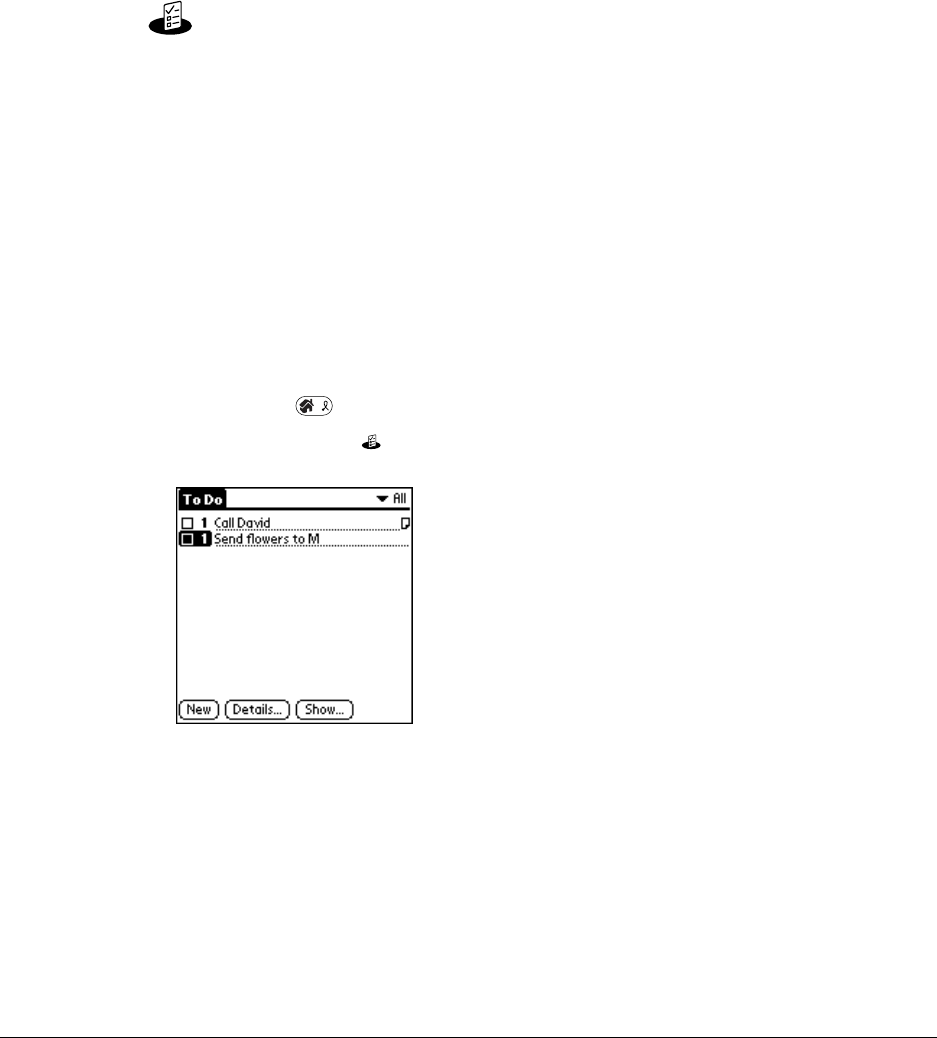
155
CHAPTER 16
Using To Do List
To Do List is a convenient place to create reminders and prioritize the things
that you have to do. Use To Do List for the following:
■Make a quick and convenient list of things to do.
■Assign a priority level to each task.
■Assign a due date for any or all of your To Do List items.
■Assign To Do List items to categories so that you can organize and view them
in logical groups.
■Sort your To Do List items by due date, priority level, or category.
■Attach notes to individual To Do List items for a description or clarification of
the task.
To open To Do List:
1. Press Home .
2. Tap the To Do icon .
Palm, Inc. Confidential

Chapter 16 Using To Do List
156
Creating list items
A To Do List item is a reminder of some task that you have to complete. A record
in To Do List is called an item.
To create a To Do List item:
1. Do one of the following:
–Tap New.
– If no To Do List item is currently selected, begin typing.
2. Enter the text of the To Do List item. The text can be longer than one line.
3. Tap anywhere onscreen to deselect the To Do List item.
Setting priority
You can use priority setting for items to arrange the tasks in your To Do List
according to their importance or urgency. The default setting for the To Do List is
to arrange items by priority and due date, with priority 1 items at the top. If you
have a number of items in your list, changing an item’s priority setting may move
its position in the list.
When you create a new To Do List item, its priority is automatically set to level 1,
the highest (most important) level. If you select another item first, however, the
item you create appears beneath the selected item and is given the same priority as
the selected item.
Ta p N e w
New To Do
item
Palm, Inc. Confidential
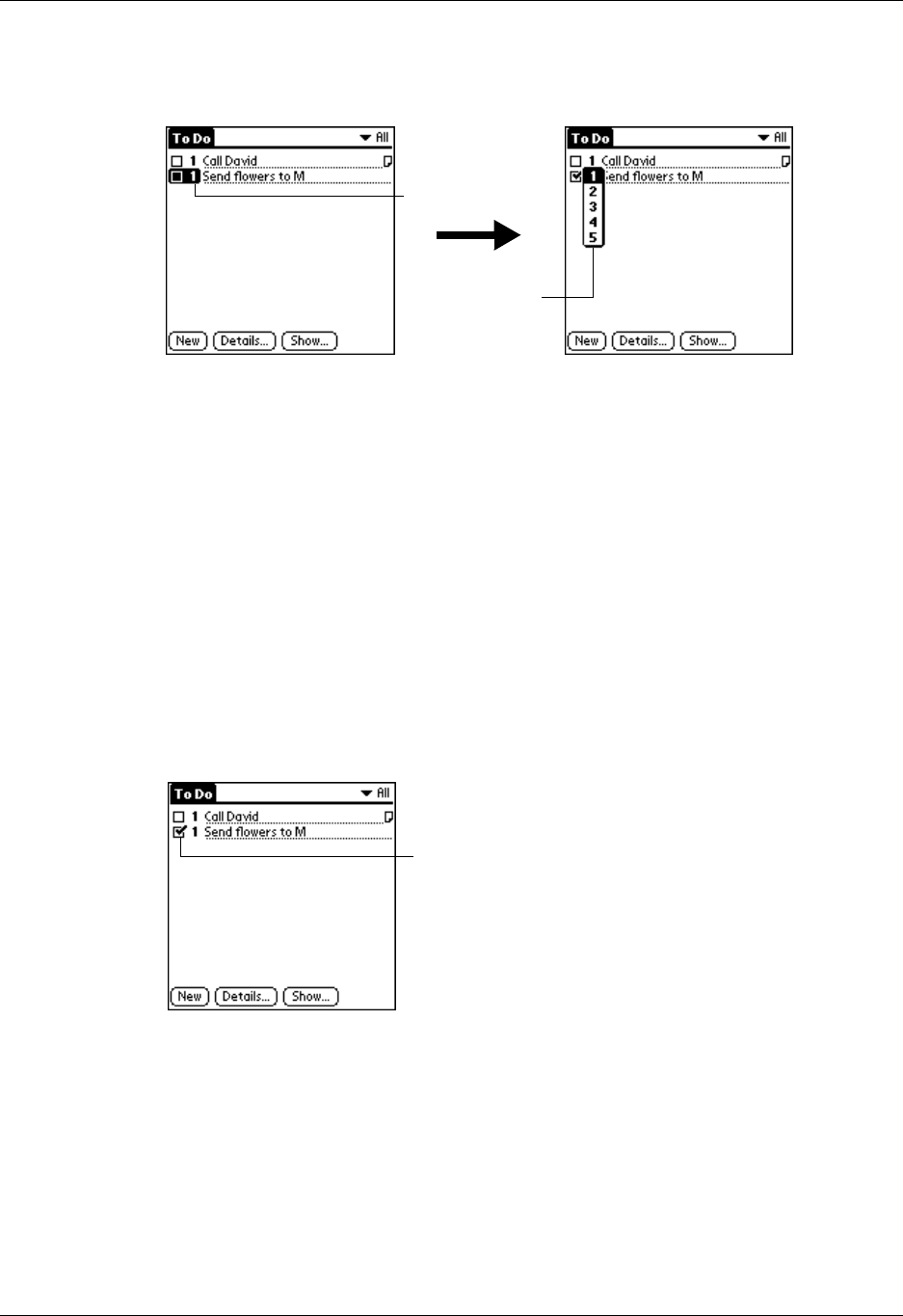
Checking off a To Do List item
157
To set the priority of a To Do List item:
1. Tap the Priority number on the left side of the To Do List item.
2. Select the Priority number that you want to set (1 is most important).
Checking off a To Do List item
You can check off a To Do List item to indicate that you’ve completed it. You can
set the To Do List to record the date that you complete the To Do item, and you can
choose to show or hide completed items. See “Setting To Do Preferences” later in
this chapter.
To check off a To Do List item:
■Tap the check box on the left side of the item.
TIP You can also highlight the item you want to check off, and then press
Select on the navigator.
Select
priority
Tap here
Completed
To D o i t e m
Palm, Inc. Confidential
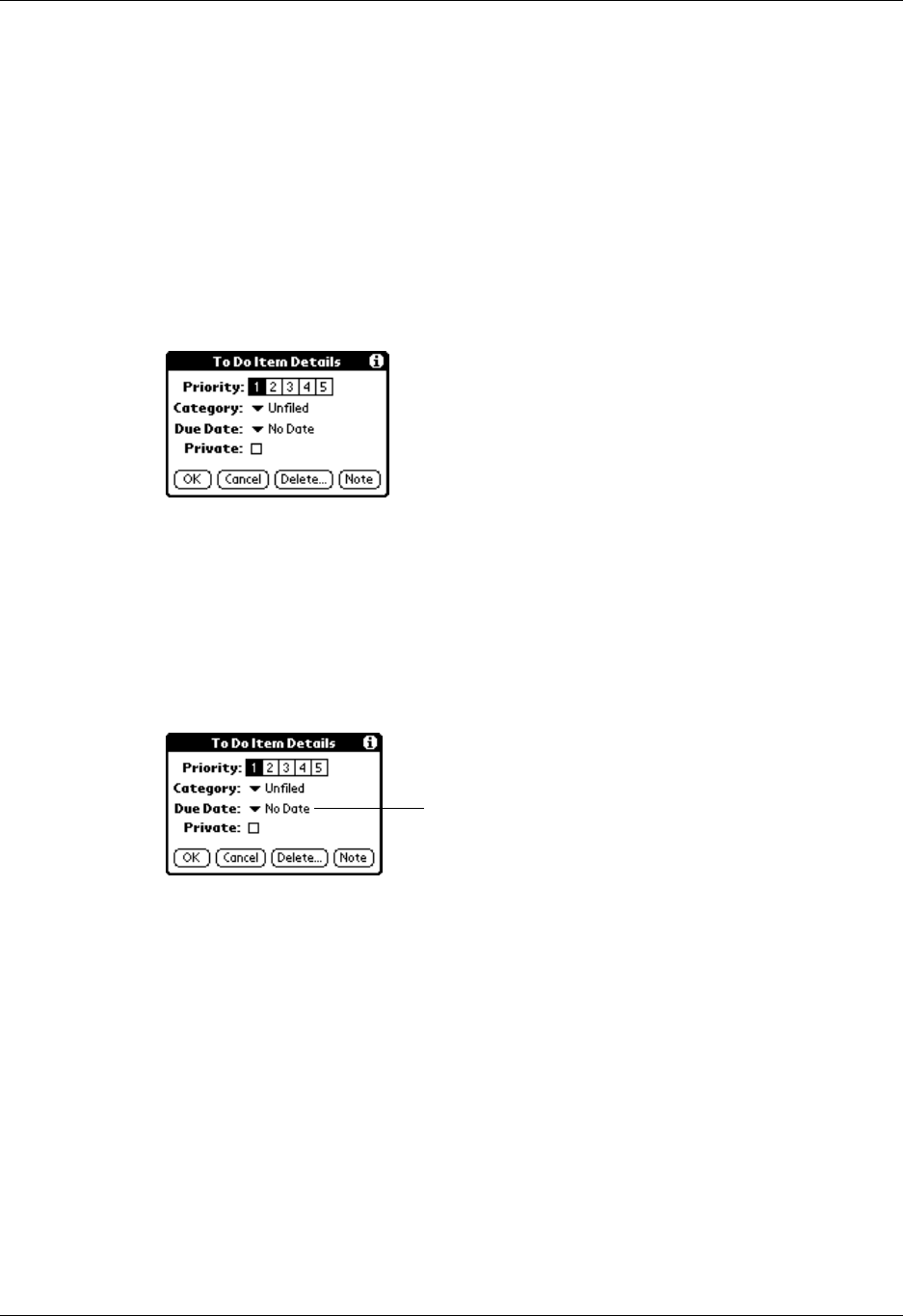
Chapter 16 Using To Do List
158
Changing To Do List item details
The To Do Item Details dialog box enables you to change settings for individual
items.
To display the To Do Item Details dialog box:
1. Tap the text of the item whose details you want to change.
TIP You can also select an item with the navigator.
2. Tap De tail s.
Setting a due date
You can associate a due date with any To Do List item. You can also sort the items
that appear in the list based on their due dates.
To set a due date for a To Do List item:
1. In the Details dialog box, tap No Date to open the Due Date pick list.
2. Tap the date that you want to assign the item:
3. Tap OK .
Today Assigns the current date.
To m o r r o w Assigns tomorrow’s date.
One week later Assigns the date exactly one week from the current date.
No Date Removes the due date from the item.
Choose date Opens the date selector, where you can choose any date
that you want for the item.
Ta p h e r e
Palm, Inc. Confidential

Setting To Do Preferences
159
TIP If you turn on the Show Due Dates option in the To Do Show options
dialog box, you can tap directly on the due date in the To Do List to open the
pick list shown in step 2.
Setting To Do Preferences
The To Do Preferences dialog box enables you to control the appearance of To Do
List and of To Do items in the Date Book Agenda view.
To change the Preferences settings:
1. In To Do List, tap Show.
2. Select any of the following settings:
3. Tap OK .
Show Completed
Items Displays your completed items in the To Do List. If you turn
off this setting, your To Do items disappear from the list when
you complete (check) them.
Items that no longer appear on the list because you turn off
this setting have not been deleted. They are still in the
memory of your handheld. Purge completed items to remove
them from memory.
Show Only Due
Items Shows only the items that are currently due, are past due, or
have no due date specified. When this setting is active, items
that are not yet due do not appear in the list until their due
dates.
Record
Completion Date Replaces the due date with the actual date when you
complete (check) the item. If you do not assign a due date to
an item, the completion date still records when you complete
the item.
Show Due Dates Displays the due dates associated with items in the To Do List
and displays an exclamation mark next to items that remain
incomplete after the due date passes.
Show Priorities Shows the priority setting for each item.
Show Categories Shows the category for each item.
Palm, Inc. Confidential
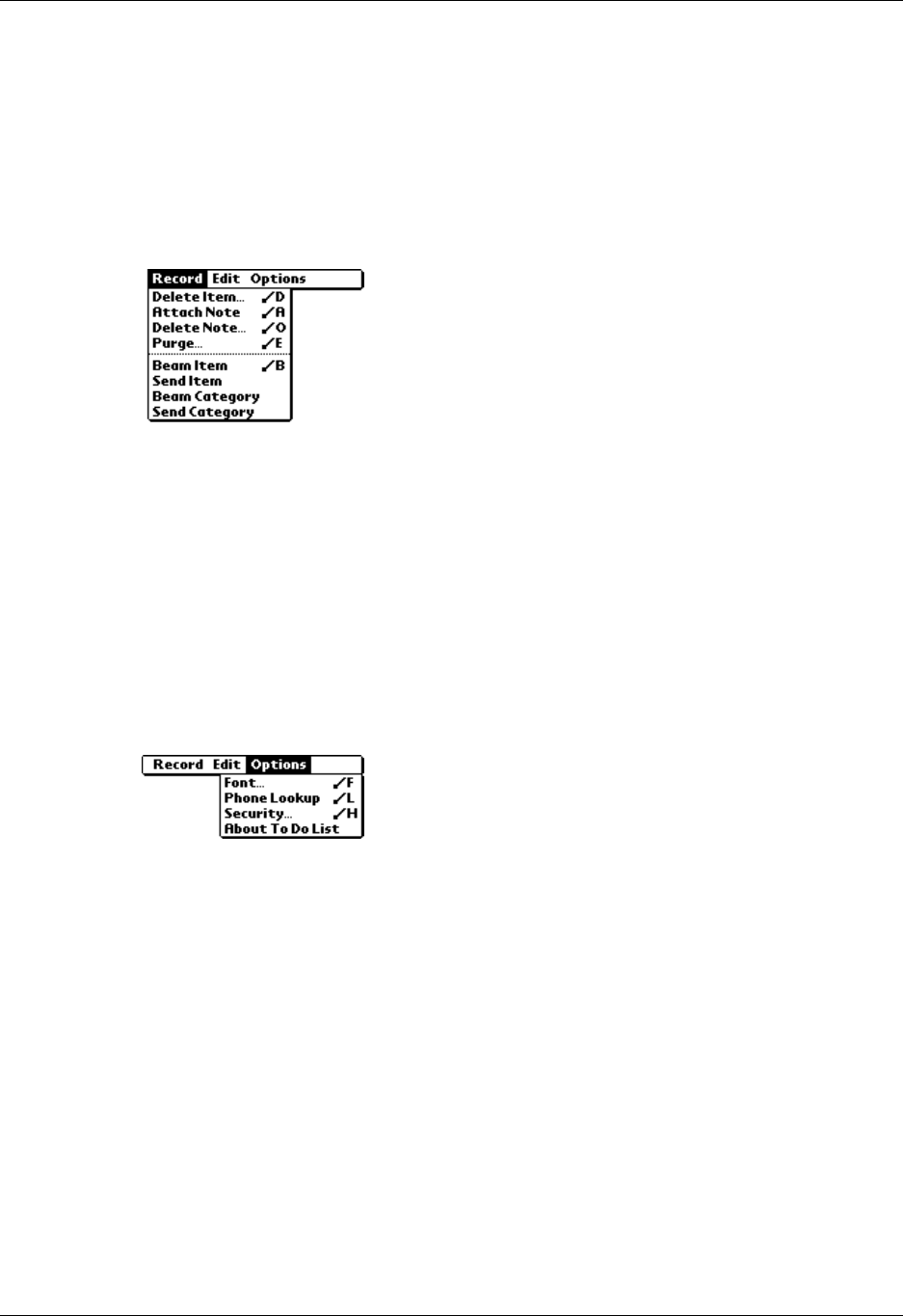
Chapter 16 Using To Do List
160
Using To Do List menus
To Do List menus are shown here for your reference, and To Do List features that
are not explained elsewhere in this book are described here.
See “Using menus” in Chapter 4 for information about choosing menu commands.
Record menu
Options menu
Send Item Opens a dialog box where you can choose how you want to
send the selected item to another device. The options available
depend on the software installed on your handheld.
Send Category Opens a dialog box where you can choose how you want to
send all records in the selected category to another device. The
options available depend on the software installed on your
handheld.
About To Do List Shows version information for To Do List.
Palm, Inc. Confidential

161
CHAPTER 17
Using Palm™ VersaMail™
Personal E-mail Software
IMPORTANT Depending on where you purchased your Palm™ Tungsten™ W
handheld, you may have Palm™ VersaMail™ personal e-mail software installed on
your handheld, or you may have a third-party e-mail application installed. If you have
the VersaMail application installed on your handheld, read this chapter. If you have a
third-party e-mail application installed, refer to the e-mail application documentation
that came with your handheld for information.
With the VersaMail application, you can send, receive, and manage e-mail on your
handheld. This chapter describes how to set up different types of e-mail accounts
and explains how to use the many e-mail features in the VersaMail application.
The VersaMail application is the newest offering in the line of Palm personal e-mail
software applications. Formerly known as MultiMail® software, the VersaMail
application contains new features that make sending and receiving e-mail
messages and managing e-mail accounts easier than ever.
Key features of the VersaMail 2.0 application include the following:
■Support for both the Tungsten W navigator and keyboard, simplifying data
entry and navigation
■Support for both the built-in GSM (dial-up) and GPRS (high-speed) radio in
your handheld, enabling wireless e-mail connectivity
NOTE If you want to use the built-in GPRS or GSM radio in your handheld to
make a network connection, you must set up service with a GPRS or GSM
provider.
Palm, Inc. Confidential
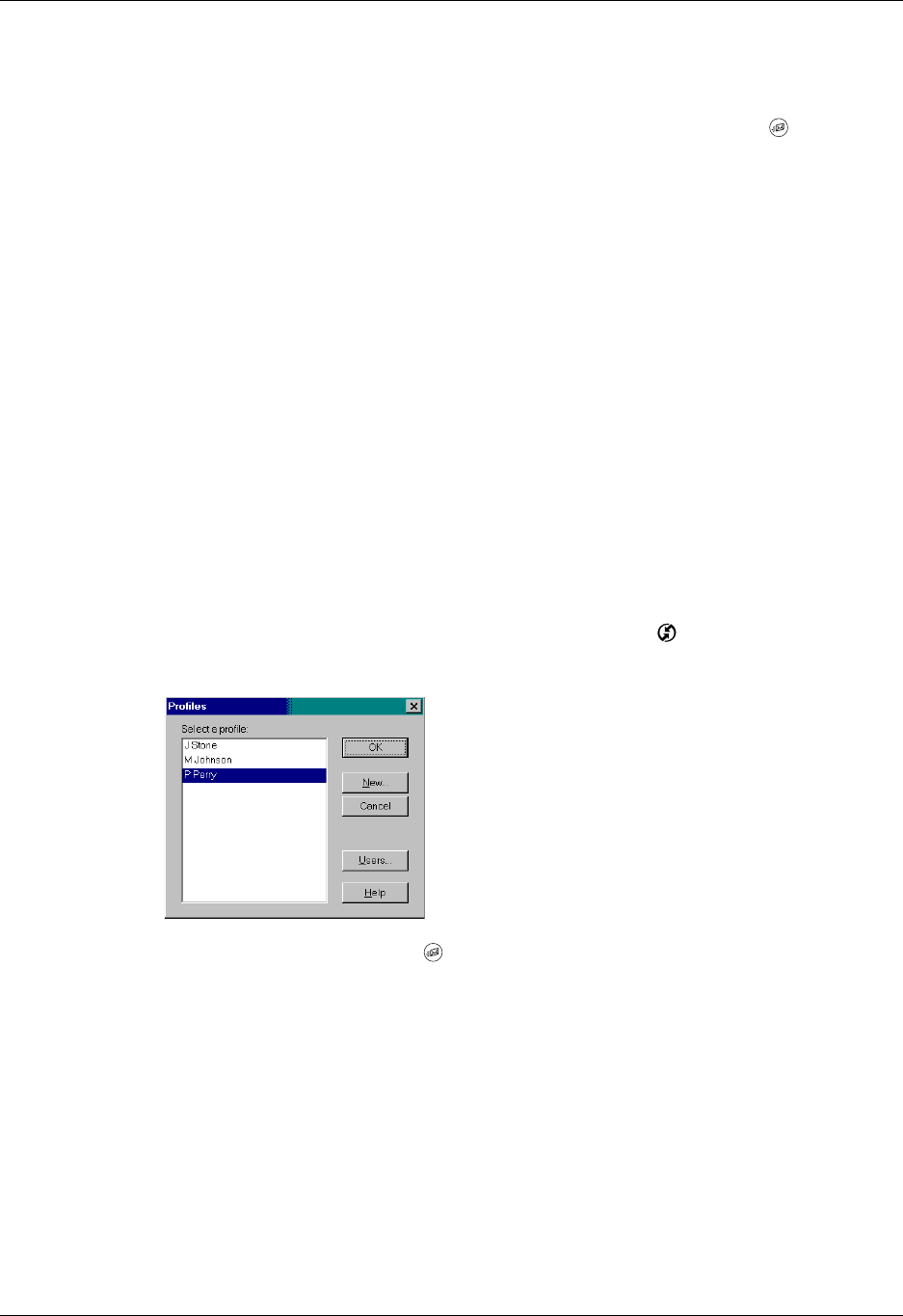
Chapter 17 Using Palm™ VersaMail™ Personal E-mail Software
162
Getting started with the VersaMail application
The VersaMail application is built into your handheld and does not need to be
installed. To start using the application, press the VersaMail button on your
handheld. The following sections describe some optional procedures before you
begin using the VersaMail application.
Synchronizing an existing username
If you plan to synchronize your Tungsten W handheld with an existing username
by performing a HotSync® operation, you must do so before you enter your e-mail
account information in the VersaMail application. If you enter the e-mail account
information first and then synchronize your handheld to an existing username, the
username information overwrites the e-mail account information you entered.
Upgrading a MultiMail database
If you have previously used a Palm personal e-mail application such as MultiMail
SE or MultiMail Deluxe, you can upgrade your e-mail database for use with the
VersaMail application.
To upgrade an existing e-mail database for use with the VersaMail application:
1. Perform a HotSync operation with a user profile that contains the existing
e-mail database. To do so, press the HotSync button ™, and then select a
profile that contains an e-mail database from the displayed list of users.
2. Press the VersaMail button on your handheld.
3. Tap Yes to accept the upgrade.
Installing Documents To Go
Documents To Go enables you to convert attachments using HotSync operations.
With Documents To Go, you can view Word, Excel, and PowerPoint attachments
on your handheld. DataViz Documents To Go attachment conversion plug-ins are
automatically configured to work with the VersaMail application.
Version 5 of Documents To Go is included on the Software Essentials CD-ROM
that came with your Tungsten W handheld. See the Documents To Go Getting Started
Manual for more information.
Palm, Inc. Confidential

Setting up and managing e-mail accounts
163
Setting up and managing e-mail accounts
With the VersaMail application, you can access e-mail accounts from
providers such as Earthlink or Yahoo. Some companies may also allow access to
corporate e-mail with the appropriate mail server configuration. See “Accessing
corporate e-mail” later in this chapter for more information.
You can add up to eight e-mail accounts on your handheld by setting up a
connection to a network provider or synchronizing to a desktop e-mail application.
For example, if you have a Yahoo e-mail account with POP access, you can create
a new account in the VersaMail application and name that new account Yahoo, so
that you can send and receive e-mail on your handheld using your Yahoo account.
Account and connection types
Two types of e-mail accounts are supported:
■Network: You can send and receive e-mail directly to and from your handheld
by connecting with a network provider.
■Synchronize Only: You can download, view, and manage e-mail between the
handheld and a desktop e-mail application, such as Microsoft Outlook, by
performing a HotSync operation using the cradle/cable. You can’t send and
receive messages wirelessly or with a modem for an account of this type.
Using a network account, you can set up or access an e-mail account using any of
the following connection methods:
■Built-in GPRS (high-speed) and GSM (dial-up) radio on your handheld
■Palm™ Bluetooth Card (sold separately) attached through the expansion card
slot connecting to a mobile phone or local access point that is enabled with
Bluetooth technology
■PalmModem® accessory (sold separately)
■External modem sled (for example, 802.11 sled)
■Infrared (IR) port on the handheld to infrared port on a mobile phone
■Direct connection to a mobile phone by means of a physical cable
■Handheld cradle connected to your desktop (Windows users only)
Setting up the default account that came with your handheld
Depending on where you purchased your handheld, you may have a default
e-mail account preconfigured by a carrier. This is either a high-speed GPRS
account or a dial-up GSM account. If your wireless carrier preconfigured your
e-mail account, you need to enter username and password information before you
can use the account.
Palm, Inc. Confidential

Chapter 17 Using Palm™ VersaMail™ Personal E-mail Software
164
To determine if you have a preconfigured e-mail account on your handheld:
■The first time you use the VersaMail application, press the VersaMail button .
If a screen prompting you to enter your username and password appears
immediately, you have a preconfigured carrier e-mail account. If any other
account setup screen appears, you do not have a preconfigured carrier e-mail
account.
TIP Check with your wireless carrier to determine whether your handheld comes
with a preconfigured e-mail account.
To set up the default account that came with your handheld:
1. Press the VersaMail button .
2. Enter a username, and then tap the Password field. The username is supplied
by your wireless carrier.
3. Enter a password when prompted, then tap OK. The password is supplied by
your wireless carrier.
4. Tap Next, and then tap Next again.
5. Tap Do n e.
You are now ready to use your default e-mail account.
Setting up a new e-mail account
If your handheld did not come with a preconfigured carrier e-mail account, or if
you want to set up a different account, you must set up a new e-mail account.
Palm, Inc. Confidential

Setting up and managing e-mail accounts
165
Setting up a network e-mail account
Before you can set up a network e-mail account, you must do the following:
■Establish the e-mail account with a network provider. Common network
providers include Internet service providers (ISPs) such as Earthlink and
Prodigy. A provider can also be a wireless GSM or GPRS carrier such as
VoiceStream, Cingular, or VodaFone.
■Configure the service connection settings for this account on your handheld
using your handheld’s Network Preferences and Connection Preferences
screens. See Chapter 21 for more information.
You must also have the appropriate prerequisite for the type of connection you
want to make, as follows.
Using a GPRS/GSM carrier
If you want to use the built-in GPRS or GSM radio on your handheld to make a
network connection, you must have (or you must set up) service with a GPRS or
GSM provider. Many providers give you an e-mail account with your monthly
data service subscription.
Connection Type Prerequisite
High-speed GPRS Active GPRS service ordered from your
wireless carrier.
GSM dial-up Active wireless service with a GSM carrier.
If you are using GPRS, the same carrier
generally provides both GSM and GPRS
service.
Note that some GSM carriers require you to
order a special data service (separate from
voice service) to make a network
connection.
Palm Bluetooth Card attached through
SD slot
Palm Bluetooth Card and mobile phone or
LAN access point enabled with Bluetooth
technology.
PalmModem accessory PalmModem accessory.
External modem sled (for example,
802.11)
Wireless modem accessory.
IR to IR phone IR-enabled mobile phone.
Direct connection to a phone by means
of a physical cable
Connector cable and mobile phone.
Handheld cradle connected to desktop Handheld cradle and cable (Windows users
only).
Palm, Inc. Confidential

Chapter 17 Using Palm™ VersaMail™ Personal E-mail Software
166
Using an ISP
In addition to or instead of using a carrier-provided e-mail account (for example,
an e-mail account from VoiceStream), you may want to access other e-mail
accounts (for example, a Yahoo or Earthlink e-mail account) that send and receive
messages using your GPRS or GSM connection.
If you are setting up a new e-mail account and have a well-known ISP such as
Earthlink or Mindspring, many of the required settings during the account setup
are automatically configured.
For other ISPs, you need the following information:
■The protocol used for incoming mail, such as POP or IMAP
■The name of the incoming mail server
■The name of the outgoing mail (SMTP) server
■Whether your e-mail account requires any encryption, such as APOP or ESMTP
■Your e-mail address and password
■The login script (if any) that you need for connecting to your ISP or mail server
NOTE Information about your e-mail account is available from the e-mail provider.
Depending on the type of e-mail service you have, you may be able to access this
information by going to the e-mail provider’s web site or by contacting the provider’s
customer support.
Creating a network e-mail account
You create a new account in Account Setup, which guides you through the process.
To create a network e-mail account:
1. Press Function + Menu , select Accounts, and select Account Setup.
2. Tap New.
Palm, Inc. Confidential
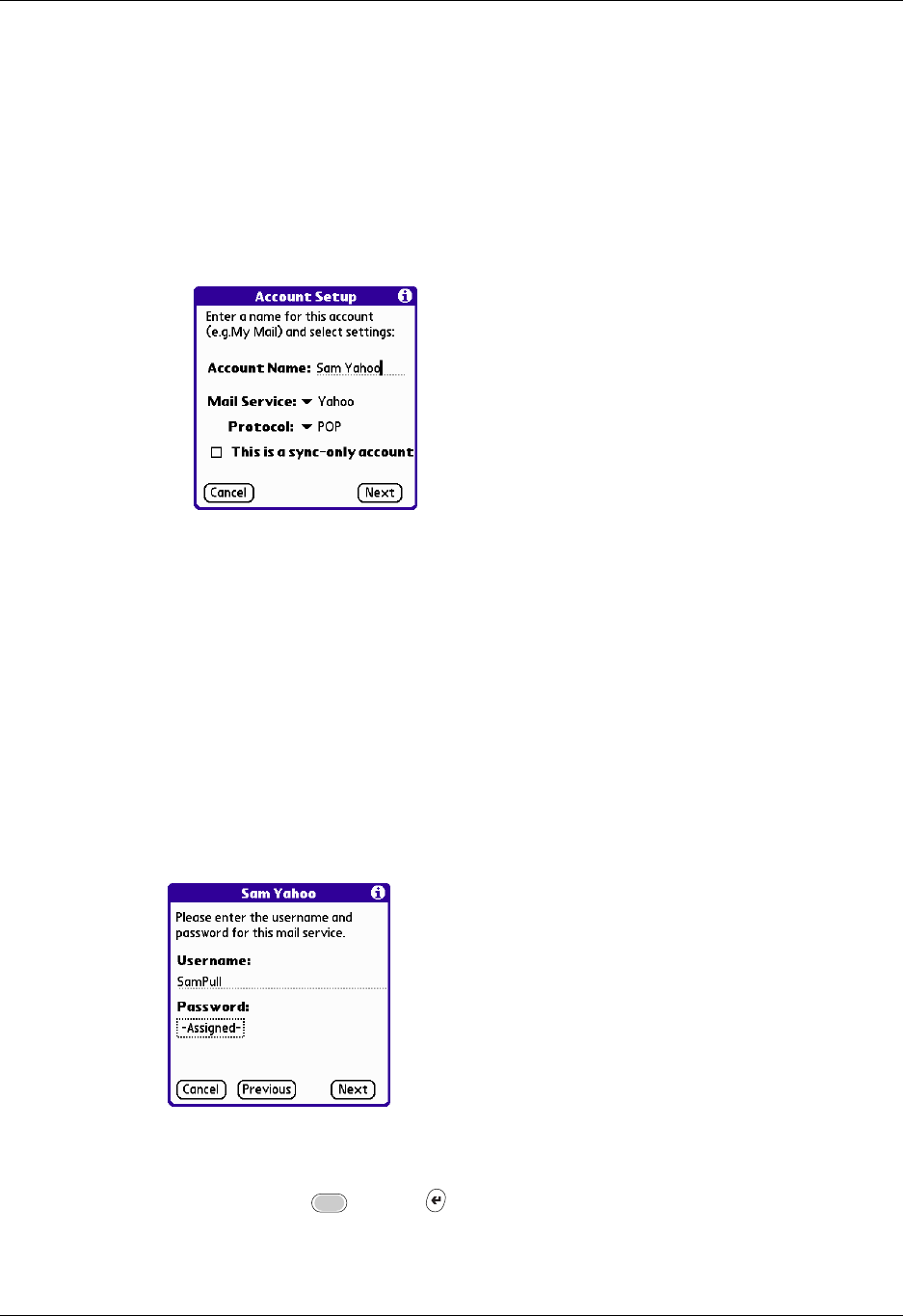
Setting up and managing e-mail accounts
167
3. Enter the following:
–Account Name: Enter a descriptive name for the account, such as “My
Yahoo.”
–Mail Service: Tap the Mail Service pick list and select the provider to which
you are connecting. Select Other if your ISP is not listed.
–Protocol: Tap the Protocol pick list and select POP or IMAP. (Most e-mail
providers use the POP protocol.)
If the VersaMail application knows the protocol for the mail service you
selected, it displays the correct protocol.
4. Tap Nex t.
Entering the account username and password
In the next part of the VersaMail Account Setup, you enter the username and
password for this account.
To enter the account username and password:
1. Enter the username you use to access your e-mail. This is generally the part of
your e-mail address appearing before the @ symbol; it is usually not your entire
e-mail address.
2. Tap the Password box, and then enter your password. The Password box
displays the word “Assigned” to indicate that a password has been entered.
3. Press Function +Enter , or tap OK.
4. Tap Nex t.
Palm, Inc. Confidential
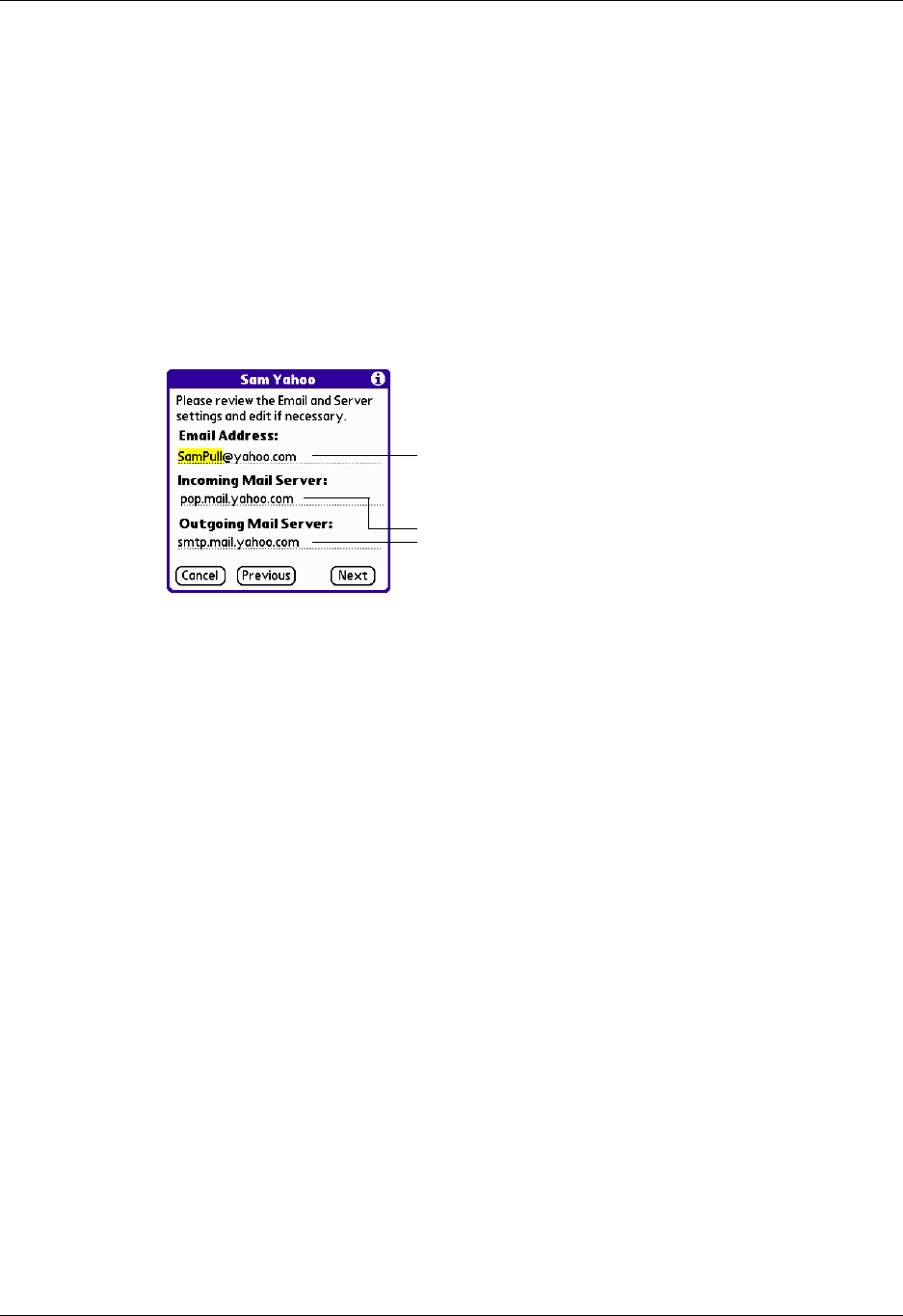
Chapter 17 Using Palm™ VersaMail™ Personal E-mail Software
168
Entering the name of the outgoing and incoming mail server
You need to verify your e-mail address for the account you are accessing, as well
as enter the name of the outgoing and incoming mail servers.
To enter mail server settings:
1. If you chose a preconfigured service from the Mail Services pick list on the
Account Setup screen, the e-mail address field is completed automatically
based on the username and mail service you entered. Check the address to
verify that it is correct, and edit it if necessary.
If you chose Other from the Mail Services pick list on the Account Setup screen,
enter the e-mail address for your account.
2. Enter the name of your incoming (POP) mail server, such as
pop.mail.yahoo.com.
If the VersaMail application knows the incoming mail server name based on the
mail service you selected, the correct server name is displayed.
3. Enter the name of your outgoing (SMTP) mail server, such as
smtp.mail.yahoo.com.
If the VersaMail application knows the outgoing mail server name based on the
mail service you selected, the correct server name is displayed.
4. Tap Nex t.
E-mail address will be filled in
automatically if you chose a
preconfigured mail service
Mail servers will be filled in
automatically if the VersaMail
application knows the names based
on the mail service you chose
Palm, Inc. Confidential

Setting up and managing e-mail accounts
169
5. Do one of the following:
– To accept these mail options and begin using the VersaMail application, tap
Done. This takes you to the Inbox of the account you set up. See “Getting,
sending, and managing e-mail” later in this chapter to get and send e-mail.
– To set up additional mail options, tap Next. Continue with the next set of
procedures.
Setting mail retrieval options for a POP or IMAP account
The next VersaMail Setup screen displays different options depending on whether
your mail service uses a POP or IMAP protocol.
To set mail retrieval server options for a POP or IMAP account:
1. (Optional) Select any of the following:
– Select Get unread mail ONLY to download only unread mail to your
handheld. If you don’t choose this option and you tap Get & Send, all of your
e-mail messages on your provider’s mail server are downloaded to your
Inbox, including messages you have already read. To get all mail (including
mail you have already read) and not just unread mail, deselect Get unread
mail ONLY.
– To delete messages on your provider’s mail server when they are deleted in
the VersaMail application, select the Delete messages on the server when
they are deleted in VersaMail check box.
– (POP account only) To get e-mail on your handheld but also leave it on the
server so you can view it later on your desktop, select the Leave mail on
server check box. For example, if you create an account to receive e-mail from
your Yahoo account and select this option, your old Yahoo e-mail is still
visible the next time you visit Yahoo.com to access your Yahoo e-mail Inbox.
– To limit the maximum size of an incoming e-mail message, enter the size in
kilobytes (KB) for Maximum Message Size. The maximum size of an
incoming message is 5KB by default, but you can enter a smaller size. The
maximum size of an incoming message is 5KB by default, but you can enter
Palm, Inc. Confidential
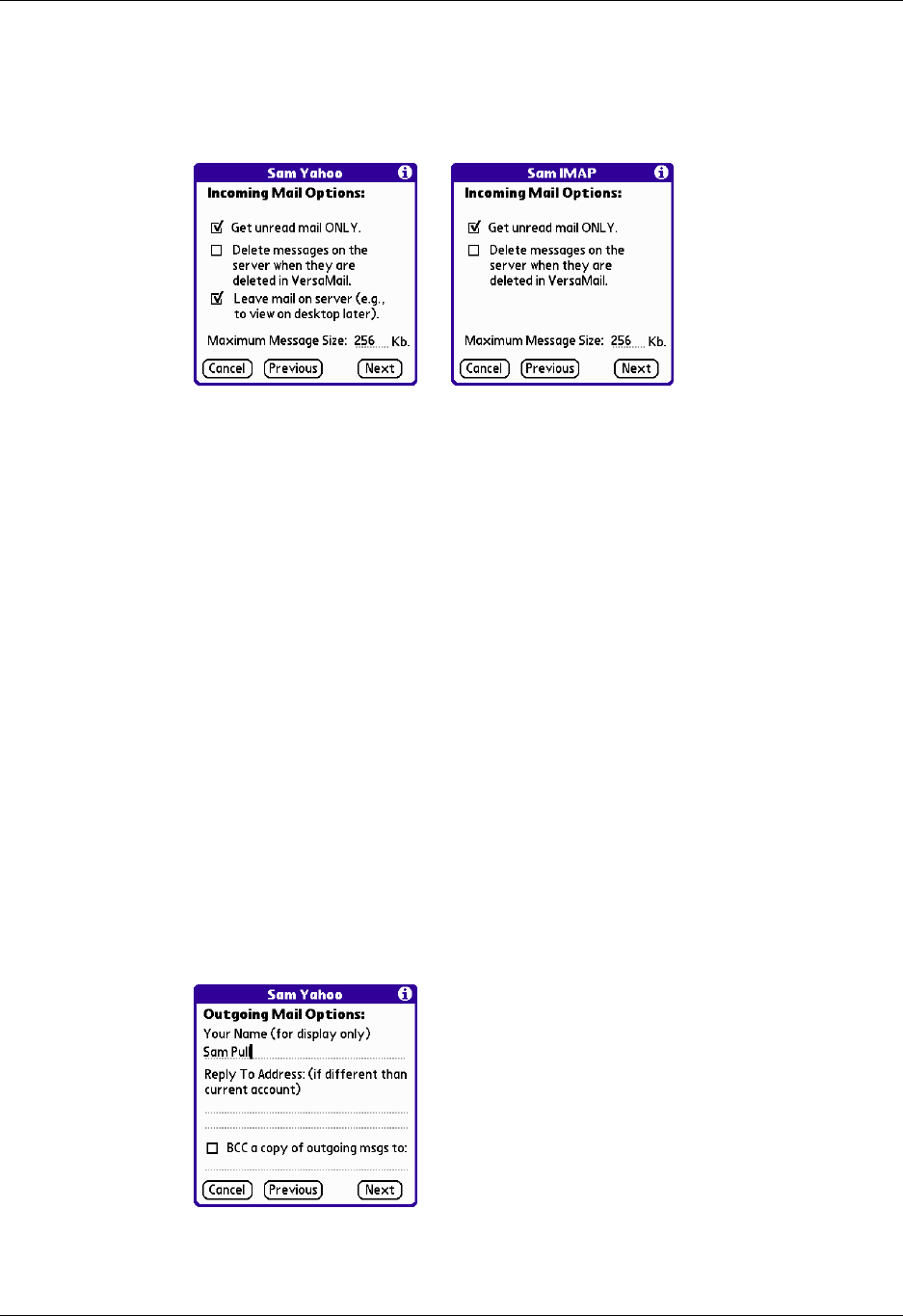
Chapter 17 Using Palm™ VersaMail™ Personal E-mail Software
170
a smaller size. The maximum message size that you can retrieve is 60KB for
the body text and 2MB total, including attachments.
2. Tap Next.
Setting outgoing mail options
Outgoing mail options are the same for POP and IMAP accounts.
To set outgoing mail options:
1. (Optional) Do any of the following:
–Display Name: Enter the name you want to appear on your outgoing
messages, such as “Joe Smith.”
–Reply To Address: Enter the e-mail address that you want recipients to see
and reply to on your e-mail messages, only if this is different from the e-mail
address from which you are sending the message. For example, if you are
sending a message from me@yahoo.com but you want recipients to reply to
me@earthlink.net, enter the reply-to address here. Reply To Address makes
it look as though the e-mail came from the address you entered.
–BCC: Select the BCC check box to send a blind copy of any e-mail message
you send to another e-mail address. The blind copy e-mail address is not
seen by the other recipients of the message. For example, if you want a copy
of all messages you send from your handheld to be sent to your corporate e-
mail account, enter that e-mail address.
2. Tap Nex t.
POP accounts IMAP accounts
Palm, Inc. Confidential

Setting up and managing e-mail accounts
171
Adding a signature
If you want, you can add a signature to each e-mail message you send. For
example, you can enter your name and telephone number so that it appears on
each message you send.
To add a personal signature:
1. Tap the Attach Signature to messages check box, and then enter the text of the
signature.
This signature is attached to all your outgoing e-mail.
2. Press Function + Enter , or tap Done.
Testing your new account
After you finish setting up a new e-mail account, the Account Setup screen is
displayed. Select the name of the account you just created and tap OK to go to the
account’s Inbox. You can test whether the e-mail account is set up and working
properly by tapping Get Mail. See “Getting e-mail by subject or getting the entire
message” later in this chapter for more information.
Creating a synchronize-only account
A synchronize-only e-mail account enables you to download, view, and manage
e-mail between the handheld and a desktop e-mail application, such as Microsoft
Outlook, by performing a HotSync operation by means of the cradle/cable. You
can’t send and receive messages wirelessly or with a modem for any account of this
type.
Palm, Inc. Confidential
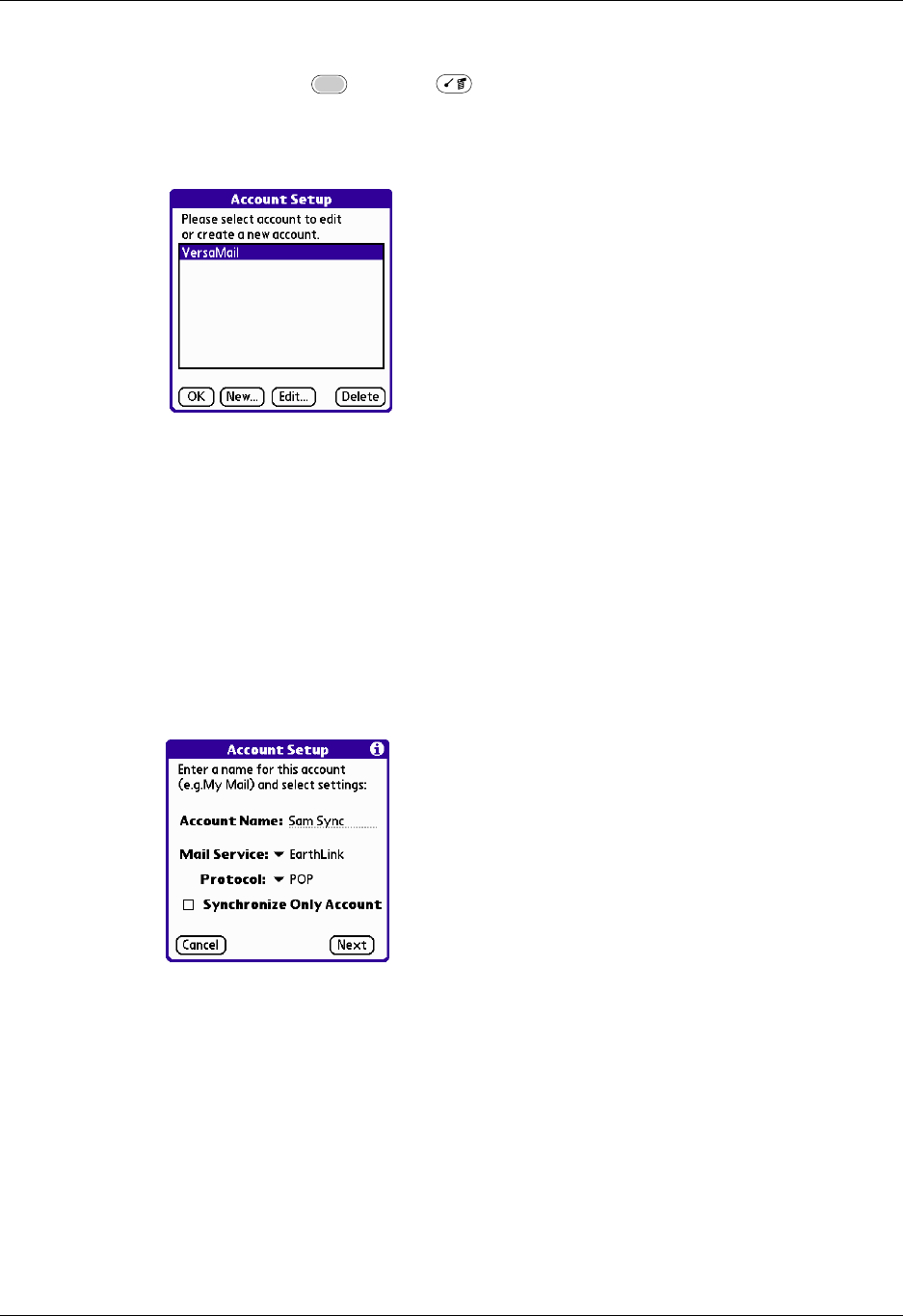
Chapter 17 Using Palm™ VersaMail™ Personal E-mail Software
172
To create a synchronize-only e-mail account:
1. Press Function + Menu , select Accounts, and then select Account
Setup.
2. Tap New.
3. Do the following:
–Account Name: Enter a descriptive name for this account, such as “My
Yahoo.”
–Mail Service: Tap the Mail Service pick list and select the provider to which
you are connecting. Select Other if your ISP is not listed.
–Protocol: Tap the Protocol pick list and select POP or IMAP. (Most mail
providers use the POP protocol.)
If the VersaMail application knows the protocol for the mail service you
selected, it displays the correct protocol.
Palm, Inc. Confidential
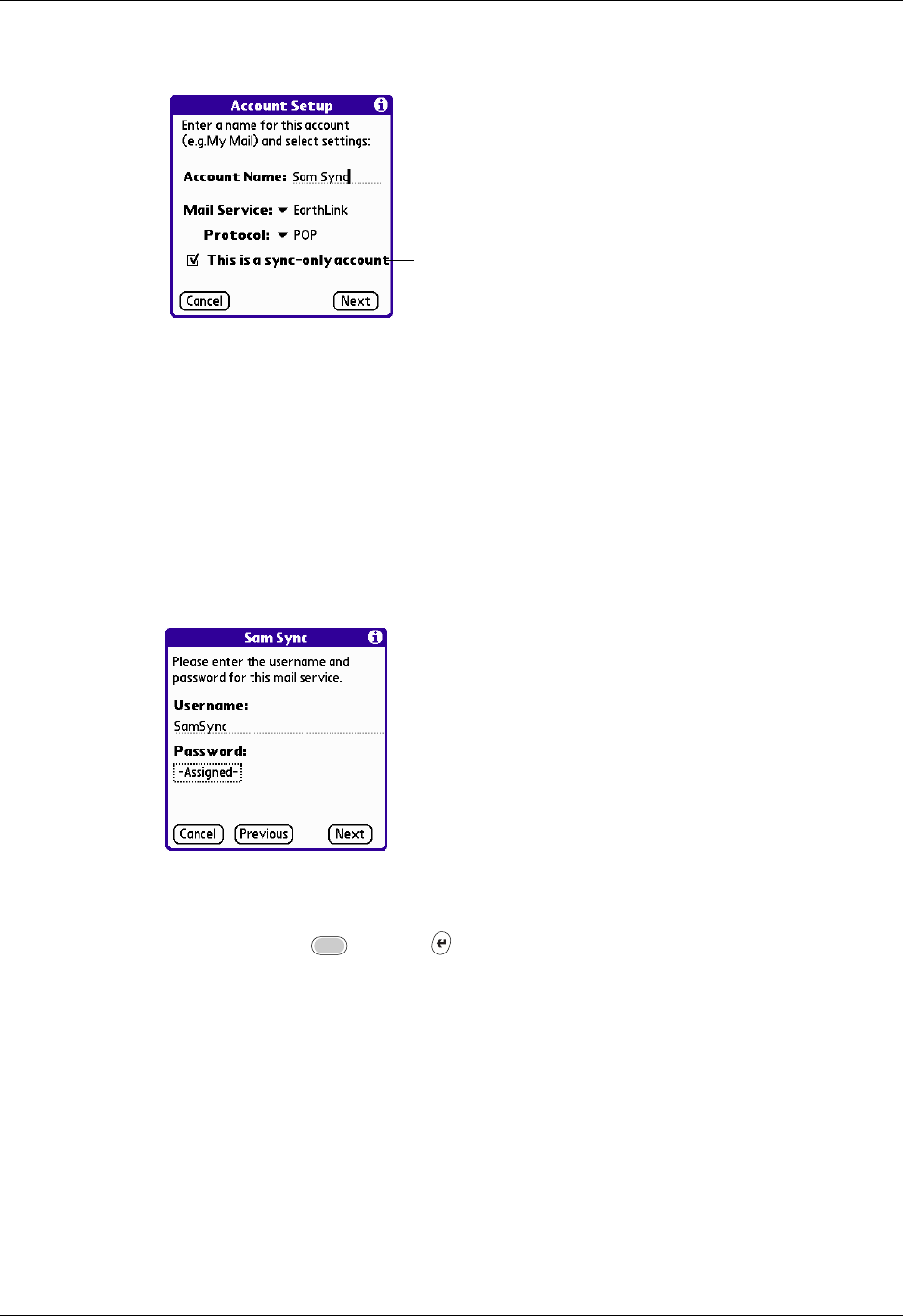
Setting up and managing e-mail accounts
173
4. On the same screen, select the Synchronize Only Account check box.
5. Tap Nex t.
Entering the account username and password
In the next part of the VersaMail Account Setup, you enter the username and
password for this account.
To enter the account username and password:
1. Enter the username you use to access your e-mail. This is generally the part of
your e-mail address appearing before the @ symbol; it is usually not your entire
e-mail address.
2. Tap the Password box, and then enter your password. The Password box
displays the word “Assigned” to indicate that a password has been entered.
3. Press Function + Enter , or tap OK.
4. Tap Nex t.
Select check box for a
synchronize-only account
Palm, Inc. Confidential
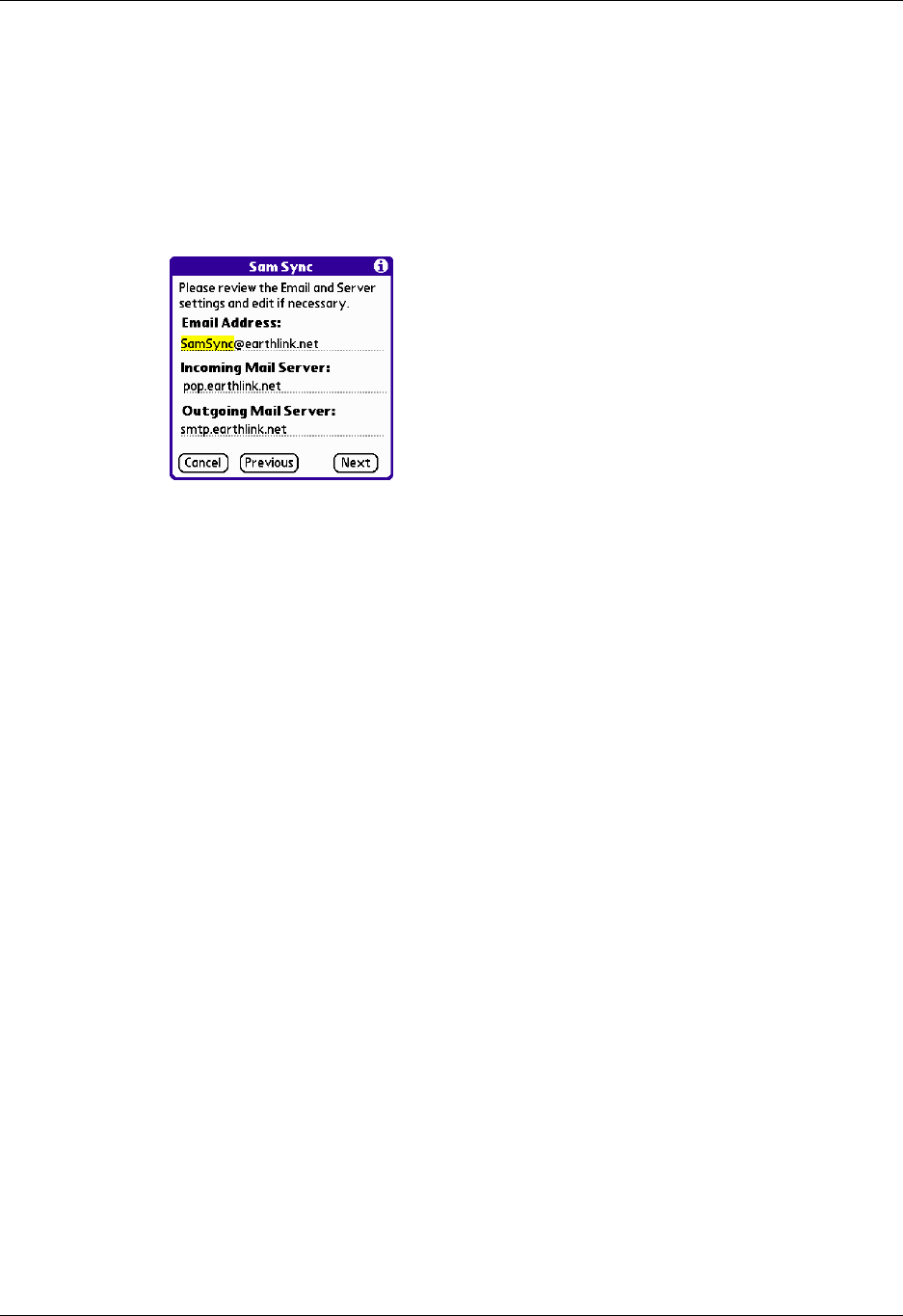
Chapter 17 Using Palm™ VersaMail™ Personal E-mail Software
174
Entering the name of the outgoing and incoming mail server
You need to enter your e-mail address for the account you are accessing as well as
the name of the outgoing and incoming mail servers.
To enter mail server settings:
1. Enter the e-mail address of the account you are accessing, such as
“examplename@yahoo.com.”
2. Enter the name of your incoming (POP) mail server, such as
pop.mail.yahoo.com.
If the VersaMail application knows the incoming mail server name based on the
mail service you selected, the correct server name is displayed.
3. Enter the name of your outgoing (SMTP) mail server, such as
smtp.mail.yahoo.com.
If the VersaMail application knows the outgoing mail server name based on the
mail service you selected, the correct server name is displayed.
4. Tap Nex t.
5. Do one of the following:
– To accept these mail options and begin using the VersaMail application, tap
Done. This takes you to the Inbox of the account you set up. See “Getting,
sending, and managing e-mail” later in this chapter to get and send e-mail.
– To set up additional mail options, tap Next. Continue with the next set of
procedures.
Palm, Inc. Confidential
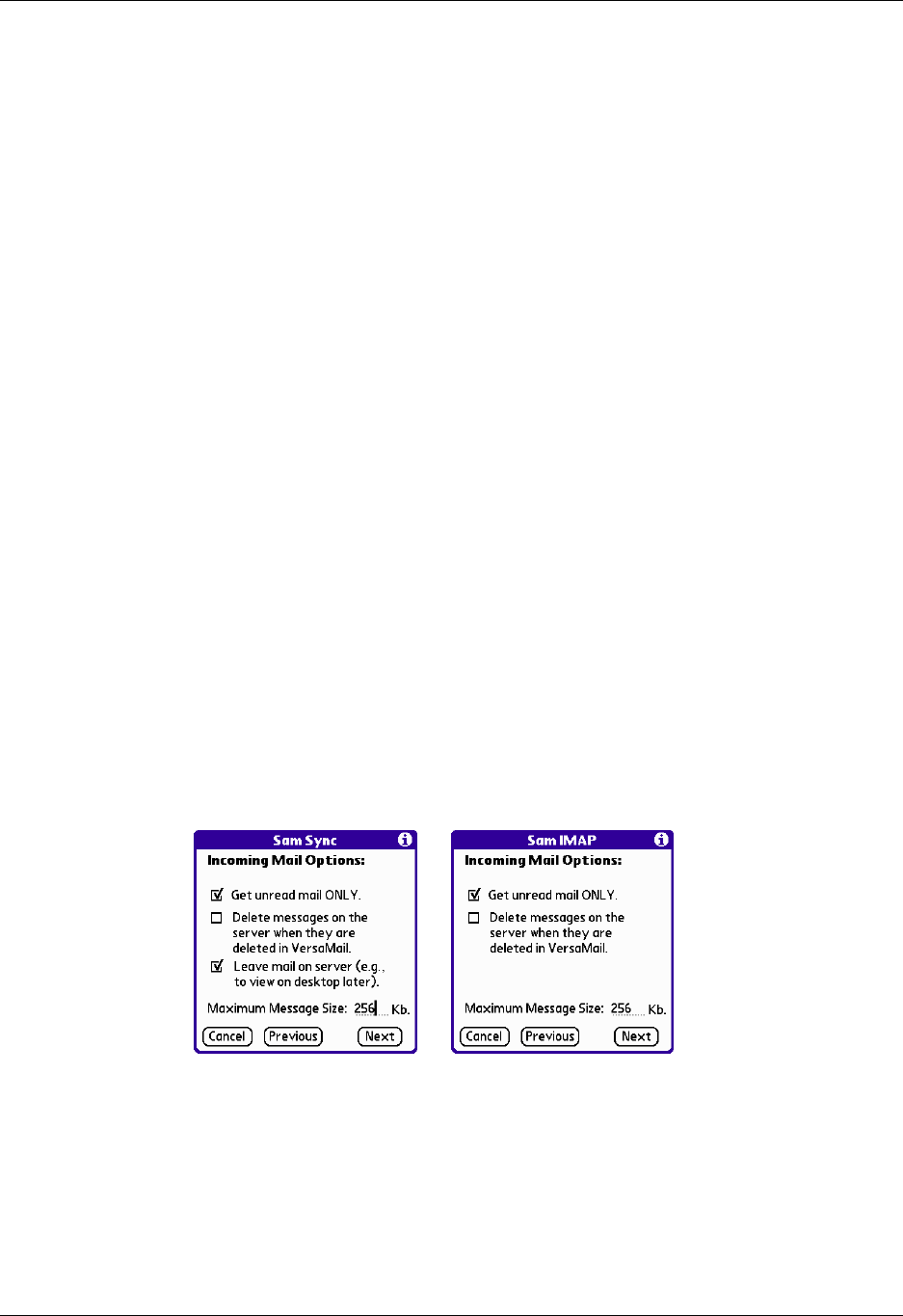
Setting up and managing e-mail accounts
175
Setting mail retrieval options for a POP or IMAP account
The next VersaMail Setup screen displays different options depending on whether
your mail service uses a POP or IMAP protocol.
To set mail retrieval server options for a POP or IMAP account:
1. (Optional) Select any of the following:
– Select Get unread mail ONLY to download only unread mail to your
handheld. If you don’t choose this option and you tap Get & Send, all your
e-mail messages on your provider’s mail server are downloaded to your
Inbox, including messages you have already read. To get all mail (including
mail you have already read) and not just unread mail, deselect Get unread
mail ONLY.
– To delete messages on your provider’s mail server when they are deleted in
the VersaMail application, select the Delete messages on the server when
they are deleted in VersaMail check box.
– (POP account only) To get e-mail on your handheld but also leave it on the
server so you can view it later on your desktop, select the Leave mail on
server check box. For example, if you create an account to receive e-mail from
your Yahoo account and select this option, your old Yahoo e-mail is still
visible the next time you visit Yahoo.com to access your Yahoo e-mail Inbox.
– To limit the maximum size of an incoming e-mail message, enter the size in
kilobytes (KB) for Maximum Message Size. The maximum size of an
incoming message is 5KB by default, but you can enter a smaller size. The
maximum size of an incoming message is 5KB by default, but you can enter
a smaller size. The maximum message size that you can retrieve is 60KB for
the body text and 2MB total, including attachments.
2. Tap Next.
POP accounts IMAP accounts
Palm, Inc. Confidential

Chapter 17 Using Palm™ VersaMail™ Personal E-mail Software
176
Setting outgoing mail options
Outgoing mail options are the same for POP and IMAP accounts.
To set outgoing mail options:
1. (Optional) Enter or select any of the following:
–Display Name: Enter the name you want to appear on your outgoing
messages, such as “Joe Smith.”
–Reply To Address: Enter the e-mail address that you want recipients to see
and reply to on your e-mail messages, only if this is different from the e-mail
address from which you are sending the message. For example, if you are
sending a message from “me@yahoo.com” but you want recipients to reply
to “me@earthlink.net,” enter the reply-to address here. Reply To Address
makes it look as though the e-mail came from the address you entered.
–BCC: Select the BCC check box to send a blind copy of any e-mail message
you send to another e-mail address. The blind copy e-mail address is not
seen by the other recipients of the message. For example, if you want a copy
of all messages you send from your handheld to be sent to your corporate e-
mail account, enter that e-mail address.
2. Tap Nex t.
Adding a signature
If you want, you can add a signature to each e-mail message you send. For
example, you can enter your name and telephone number so that it appears on
each message you send.
Palm, Inc. Confidential
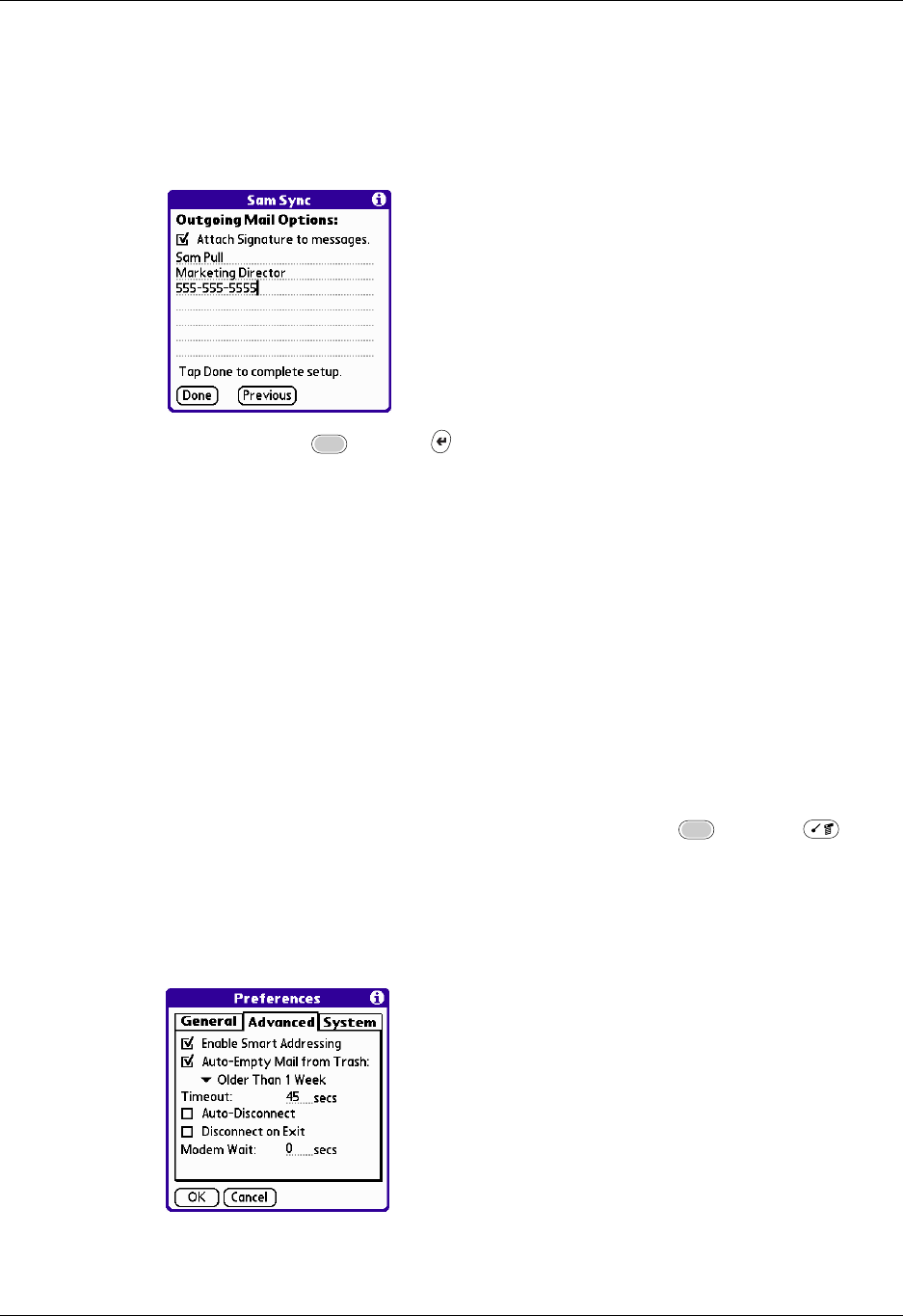
Setting up and managing e-mail accounts
177
To add a personal signature:
1. Tap the Attach Signature to messages check box, and then enter the text of the
signature.
This signature is attached to all your outgoing e-mail.
2. Press Function + Enter , or tap OK.
Configuring your synchronize-only account
After you finish setting up a synchronize-only e-mail account, you need to
configure this account on your desktop. See “Configuring an account in HotSync
Manager” later in this chapter for information. You will not be able to synchronize
e-mail between your handheld and your desktop until you configure the account
on your desktop.
Setting VersaMail connection preferences
You can set connection preferences for your e-mail accounts. These preferences
apply to all accounts you have set up in the VersaMail application.
To set account connection preferences:
1. In your Inbox or another folder screen, press Function + Menu .
2. Select Options.
3. Select Preferences.
4. Tap Advanced.
Palm, Inc. Confidential

Chapter 17 Using Palm™ VersaMail™ Personal E-mail Software
178
5. Select any of the following preferences:
Editing e-mail accounts
From time to time, you may need to edit information about one of the e-mail
accounts you set up.
To select the account to edit:
1. Press Function + Menu .
2. Select Accounts.
3. Select Account Setup.
Enable Smart
Addressing Types ahead and completes a recognized e-mail address. See
the procedure for creating new e-mail later in this chapter for
more information.
Auto-Empty Mail
from Trash Determines how often e-mail messages in the trash are
automatically deleted. See “Emptying the trash” later in this
chapter for more information.
Timeout Sets the number of seconds to try to connect before timing
out. If you are using an adapter with a mobile phone, this
value should be greater than 45 seconds.
To change, tap the Timeout field and enter a new value.
Auto-Disconnect Automatically disconnects your remote connections after
each command. Each command you perform initiates a new
call to your ISP. This setting is not recommended if you plan
to perform multiple e-mail transactions in a short amount of
time.
Disconnect on
Exit Disconnects from the network only after you leave the
VersaMail application. This feature is an alternative to Auto-
Disconnect. This option keeps your connection active while
you perform multiple transactions in the VersaMail
application, but automatically disconnects when you move
on to a different application on your handheld. If this option
is not selected, you must manually disconnect from your
ISP.
Modem Wait Displays the number of seconds that the modem uses to
initialize itself. If you have a modem, tap and enter a number
of seconds for the wait. The typical setting for a wireless
modem is 3, and the typical setting for most normal modems
is 0.
Palm, Inc. Confidential

Setting up and managing e-mail accounts
179
4. Tap the name of the account to edit, and then tap Edit.
To edit an account:
1. On the Account Setup screen, change any of the following:
–Account Name: Enter a descriptive name for this account, such as “My
Yahoo.”
–Mail Service: Tap the Mail Service pick list and select the provider to which
you are connecting. Select Other if your ISP is not listed.
–Protocol: Tap the Protocol pick list and select POP or IMAP. (Most mail
providers use the POP protocol.)
If the VersaMail application knows the protocol for the mail service you
selected, it displays the correct protocol.
2. Tap Nex t.
Changing the account username and password
In the next part of the VersaMail Account Setup, you can change the username
and/or password for this account.
Palm, Inc. Confidential

Chapter 17 Using Palm™ VersaMail™ Personal E-mail Software
180
To edit the account username and password:
1. (Optional) Enter a new username for accessing your e-mail. This is generally the
part of your e-mail address appearing before the @ symbol; it is usually not your
entire e-mail address.
2. (Optional) Tap the Password box, and then enter a new password. The
Password box displays the word “Assigned” to indicate that a password has
been entered.
3. Press Function + Enter , or tap OK.
4. Tap Nex t.
Editing the name of the outgoing and incoming mail server
If your e-mail address or the name of the outgoing and incoming mail servers has
changed or has been entered incorrectly, you can edit the address or server name.
To edit mail server settings:
1. (Optional) Enter a new e-mail address for the account you are accessing, such
as “examplename@yahoo.com.”
2. (Optional) Enter the new or correct name of your incoming (POP) mail server,
such as pop.mail.yahoo.com.
If the VersaMail application knows the incoming mail server name based on the
mail service you selected, the correct server name is displayed.
3. (Optional) Enter the new or correct name of your outgoing (SMTP) mail server,
such as smtp.mail.yahoo.com.
Palm, Inc. Confidential

Setting up and managing e-mail accounts
181
If the VersaMail application knows the outgoing mail server name based on the
mail service you selected, the correct server name is displayed.
4. Tap Nex t.
5. Do one of the following:
– To accept these mail options and begin using the VersaMail application, tap
Done. This takes you to the Inbox of the account you set up. See “Getting,
sending, and managing e-mail” later in this chapter to get and send e-mail.
– To edit additional mail options, tap Next. Continue with the next set of
procedures.
Editing mail retrieval options for a POP or IMAP account
The next VersaMail Setup screen displays different options depending on whether
your mail service uses a POP or IMAP protocol.
To set mail retrieval server options for a POP or IMAP account:
1. (Optional) Select any of the following:
– Select Get unread mail ONLY to download only unread mail to your
handheld. If you don’t choose this option and you tap Get & Send, all your
e-mail messages on your provider’s mail server are downloaded to your
Inbox, including messages you have already read. To get all mail (including
mail you have already read) and not just unread mail, deselect Get unread
mail ONLY.
– To delete messages on your provider’s mail server when they are deleted in
the VersaMail application, select the Delete messages on the server when
they are deleted in VersaMail check box.
– (POP account only) To get e-mail on your handheld but also leave it on the
server so you can view it later on your desktop, select the Leave mail on
server check box. For example, if you create an account to receive e-mail
from your Yahoo account and select this option, your old Yahoo e-mail is still
visible the next time you visit Yahoo.com to access your Yahoo e-mail Inbox.
Palm, Inc. Confidential

Chapter 17 Using Palm™ VersaMail™ Personal E-mail Software
182
– To limit the maximum size of an incoming e-mail message, enter the size in
kilobytes (KB) for Maximum Message Size. The maximum size of an
incoming message is 5KB by default, but you can enter a smaller size.
2. Tap Next.
Editing outgoing mail options
Outgoing mail options are the same for POP and IMAP accounts.
To set outgoing mail options:
1. (Optional) Do any of the following:
–Display Name: Enter the name you want to appear on your outgoing
messages, such as “Joe Smith.”
–Reply To Address: Enter the e-mail address that you want recipients to see
and reply to on your e-mail messages, only if this is different from the e-mail
address from which you are sending the message. For example, if you are
sending a message from me@yahoo.com but you want recipients to reply to
me@earthlink.net, enter the reply to address here. Reply To Address makes
it look as though the e-mail came from the address you enter.
–BCC: Select the BCC check box to send a blind copy of any e-mail message
you send to another e-mail address. The blind copy e-mail address is not
seen by the other recipients of the message. For example, if you want a copy
of all messages you send from your handheld to be sent to your corporate e-
mail account, enter that e-mail address.
2. Tap Nex t.
POP accounts IMAP accounts
Palm, Inc. Confidential
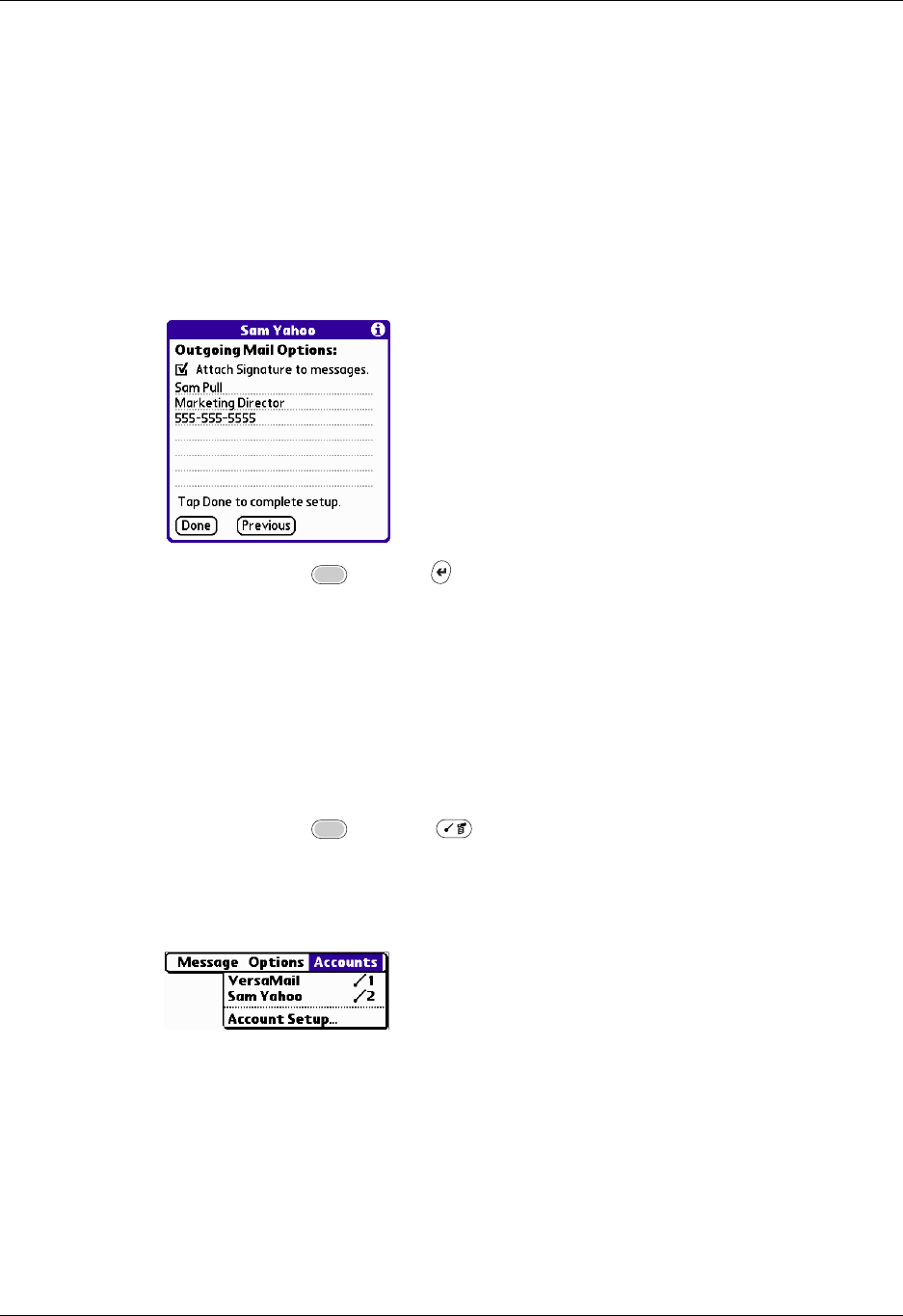
Setting up and managing e-mail accounts
183
Adding a signature
If you want, you can add a signature to each e-mail message you send. For
example, you can enter your name and telephone number so that it appears on
each message you send.
To add a personal signature:
1. Tap the Attach Signature to messages check box, and then enter the text of the
signature.
This signature is attached to all your outgoing e-mail.
2. Press Function + Enter , or tap OK.
Deleting an e-mail account
When you delete an account in the VersaMail application, the account is removed
from your handheld. The account still exists on the server. For example, deleting
your Yahoo account from the VersaMail application deletes only the account from
your handheld. Your e-mail account still exists at Yahoo.com.
To delete an account:
1. Press Function + Menu .
2. Select Accounts.
3. Select Account Setup.
Palm, Inc. Confidential

Chapter 17 Using Palm™ VersaMail™ Personal E-mail Software
184
4. Tap the name of the account you want to delete, and then tap Delete.
5. Tap Yes in the Delete Confirmation dialog box to delete the account and all
associated e-mail messages.
6. Press Function + Enter , or tap OK.
After you perform the next HotSync operation, the memory associated with an
account and its messages is released.
Selecting a different service for a given e-mail account
When you set up connections on your handheld (in the Connection Preferences
screen), you pair each connection with a network service (in the Network
Preferences screen) and then select one of these services to be the default for all
network activity (sending and receiving e-mail, surfing the Web, and so on) on
your handheld. By default, the VersaMail application uses this default service for
sending and receiving messages for all e-mail accounts you set up.
However, for any given e-mail account, you have the option of switching to a
different service for use with that account only. For example, the default service
you have selected for your handheld may be called My GPRS and use a GPRS
connection. You may also have set up an e-mail account called My Earthlink,
which runs on the My GPRS connection by default. However, if you travel into an
area that does not have GPRS coverage, you may want to switch your My Earthlink
account to the service called Earthlink GSM, which uses a GSM dial-up connection.
Palm, Inc. Confidential
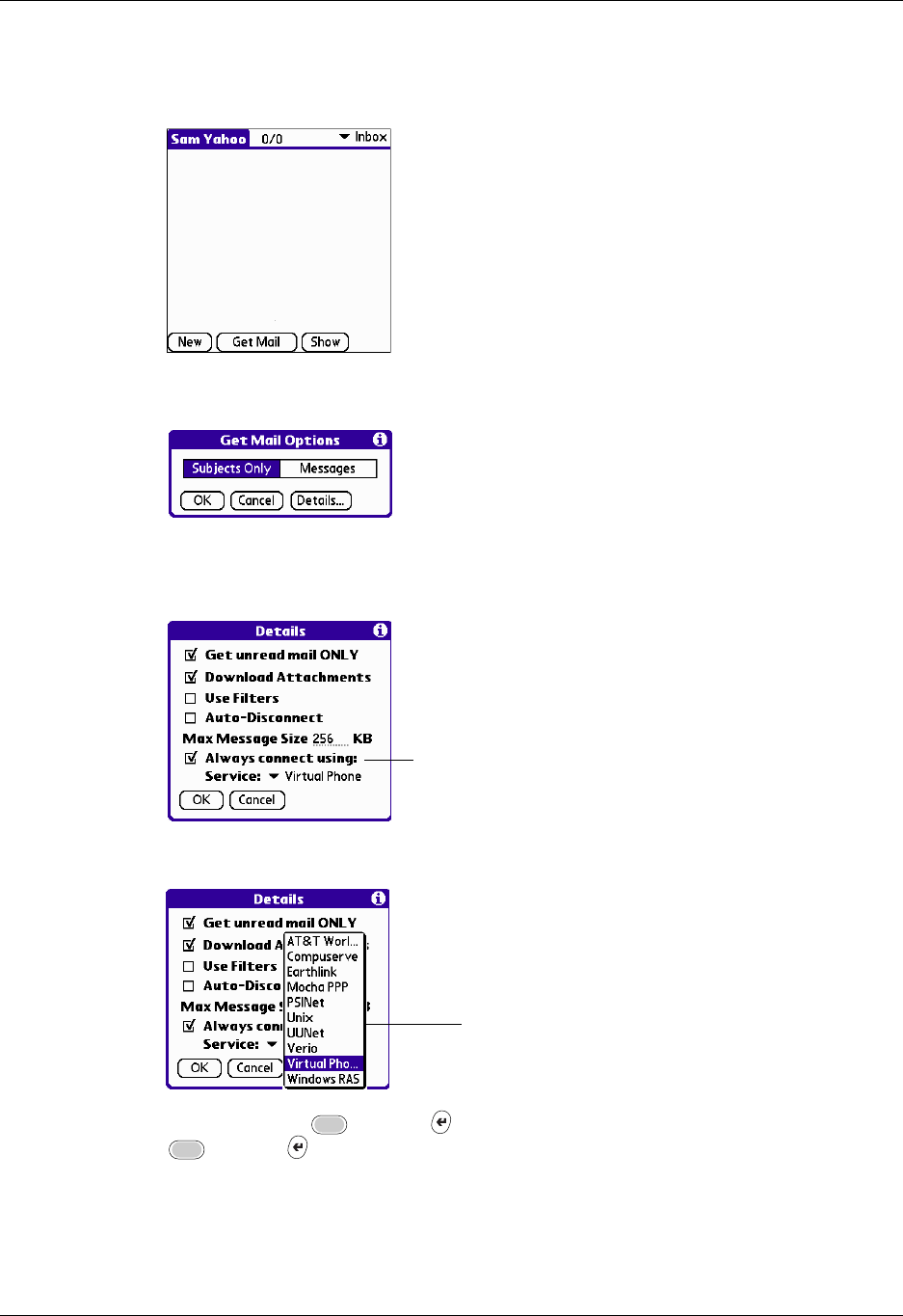
Setting up and managing e-mail accounts
185
To set up a service for a given e-mail account (different from the default service for your handheld):
1. From the Inbox of the account you want to switch, tap Get Mail.
2. Tap De tail s.
3. Tap the Always connect using check box. A pick list of available services
appears. The currently used connection is displayed by default.
4. Select the connection you want to switch to from the Service pick list.
5. Press Function + Enter (alternately, tap OK), and then press Function
+ Enter (or tap OK) again. If there is an existing service connection, it is
disconnected and the new connection is initiated. The VersaMail application
sends and checks for any new e-mail using the new connection.
Tap to change the service
connection for this e-mail account
only from your default handheld
service connection
Select a new service connection
for this e-mail account only
Palm, Inc. Confidential

Chapter 17 Using Palm™ VersaMail™ Personal E-mail Software
186
When you exit the VersaMail application, the new service disconnects. When you
reopen the application, the e-mail account you selected (My Earthlink in this
example) continues to connect using the new connection (Earthlink GSM in this
example) until you either select a new service or deselect the Always connect using
check box. If you deselect the Always connect using check box, the e-mail account
(My Earthlink) connects using the default handheld service (My GPRS in this
example).
The Always connect using check box changes the connection service for the
selected e-mail account only. You must follow the preceding procedure for each
e-mail account whose connection you want to switch from the default connection
on your handheld.
Getting, sending, and managing e-mail
Getting and sending e-mail on your handheld is easy and helps you keep your
business and personal life organized. You can get and send e-mail by simply
tapping one button on the handheld.
You can manage the messages in your e-mail accounts by moving messages
between folders, deleting old e-mail messages individually or in groups, and
marking messages as read or unread.
This section describes how to do the following:
■Get and send e-mail for your e-mail accounts
■View and send e-mail attachments, such as text or Microsoft Word documents,
wirelessly
Getting and reading e-mail
You can get e-mail subjects only—the message size, author, and subject—or you
can get entire messages immediately. If you choose to get message subjects only
and want to read a full message, you can get more of the message.
Choosing the e-mail account and displaying the Inbox
To view the e-mail in an account, you must switch to that account and then get the
e-mail. For example, if you want to collect and view the e-mail from your Yahoo
account, you switch to the account created to retrieve e-mail from your Yahoo
account.
To display an account and its Inbox:
1. In your Inbox or another folder screen, press Function + Menu .
2. Select Accounts.
Palm, Inc. Confidential